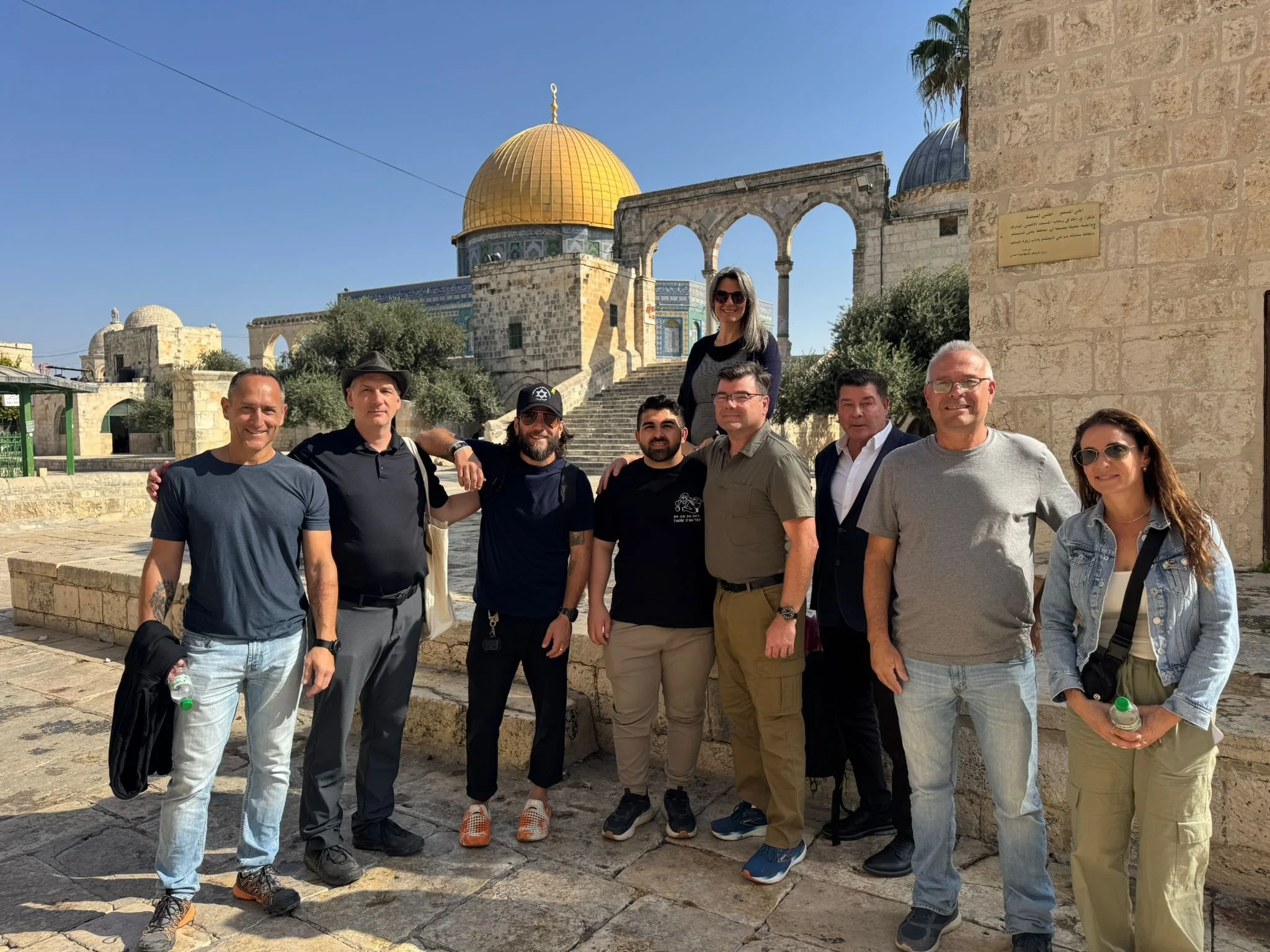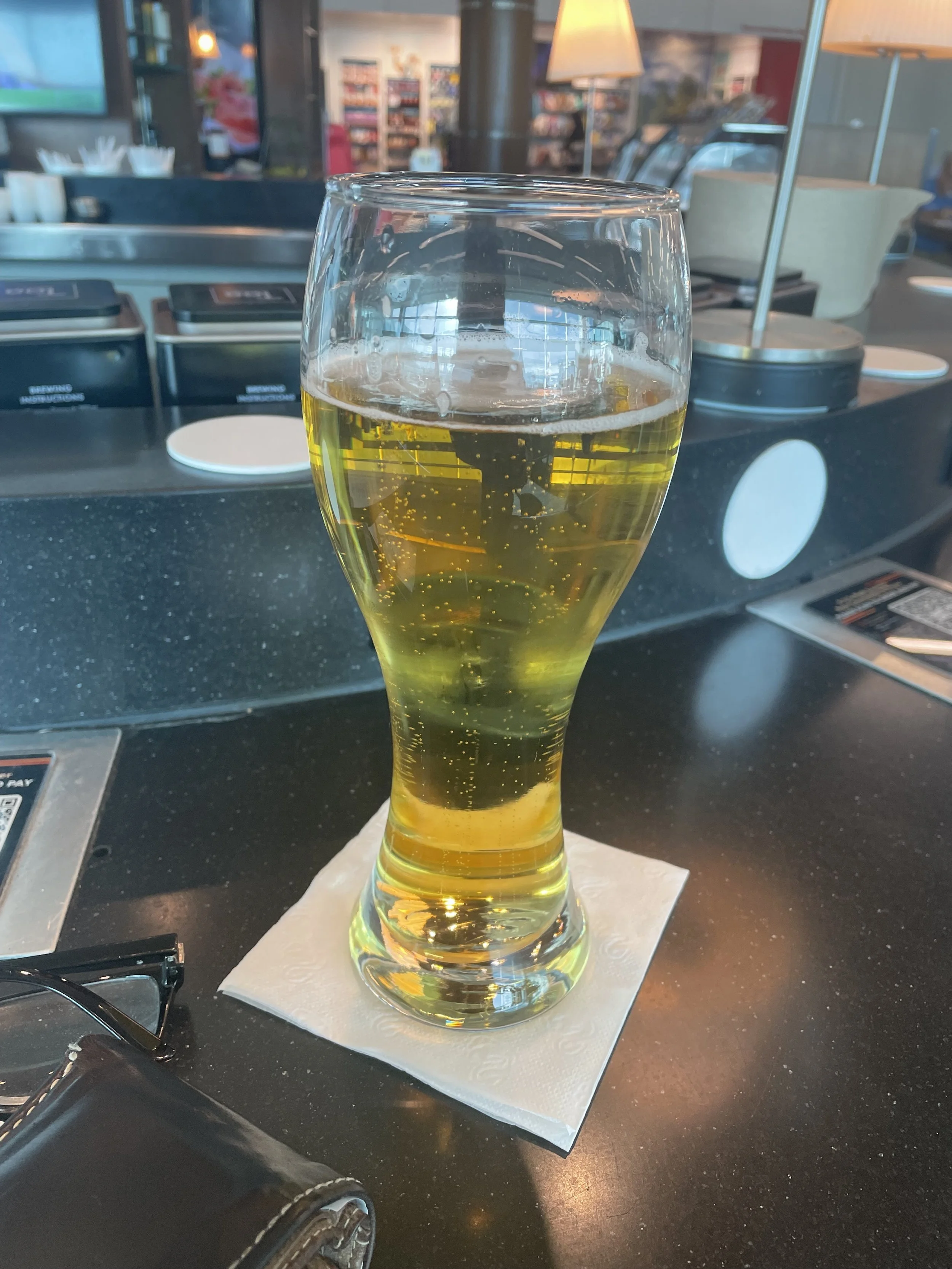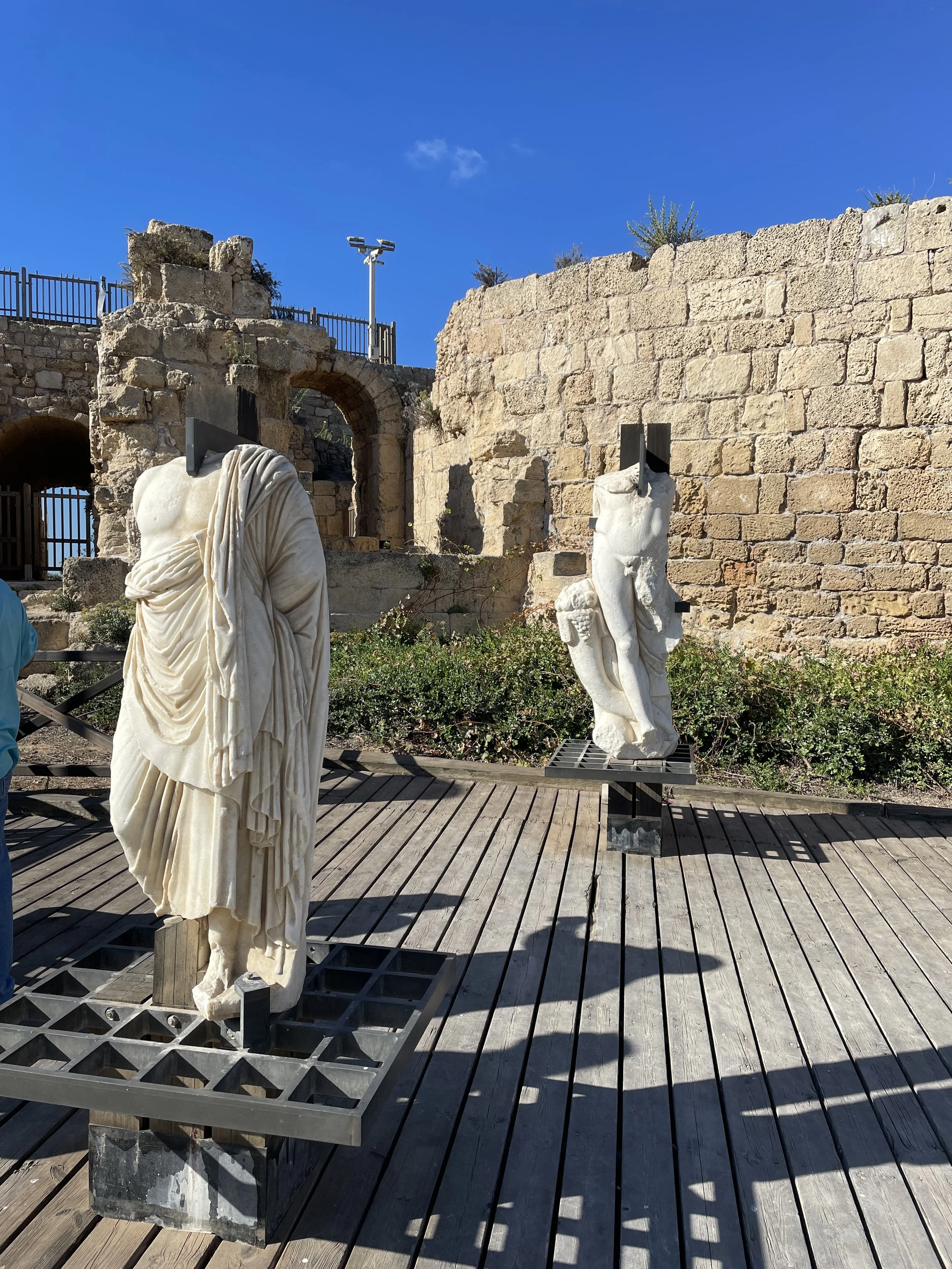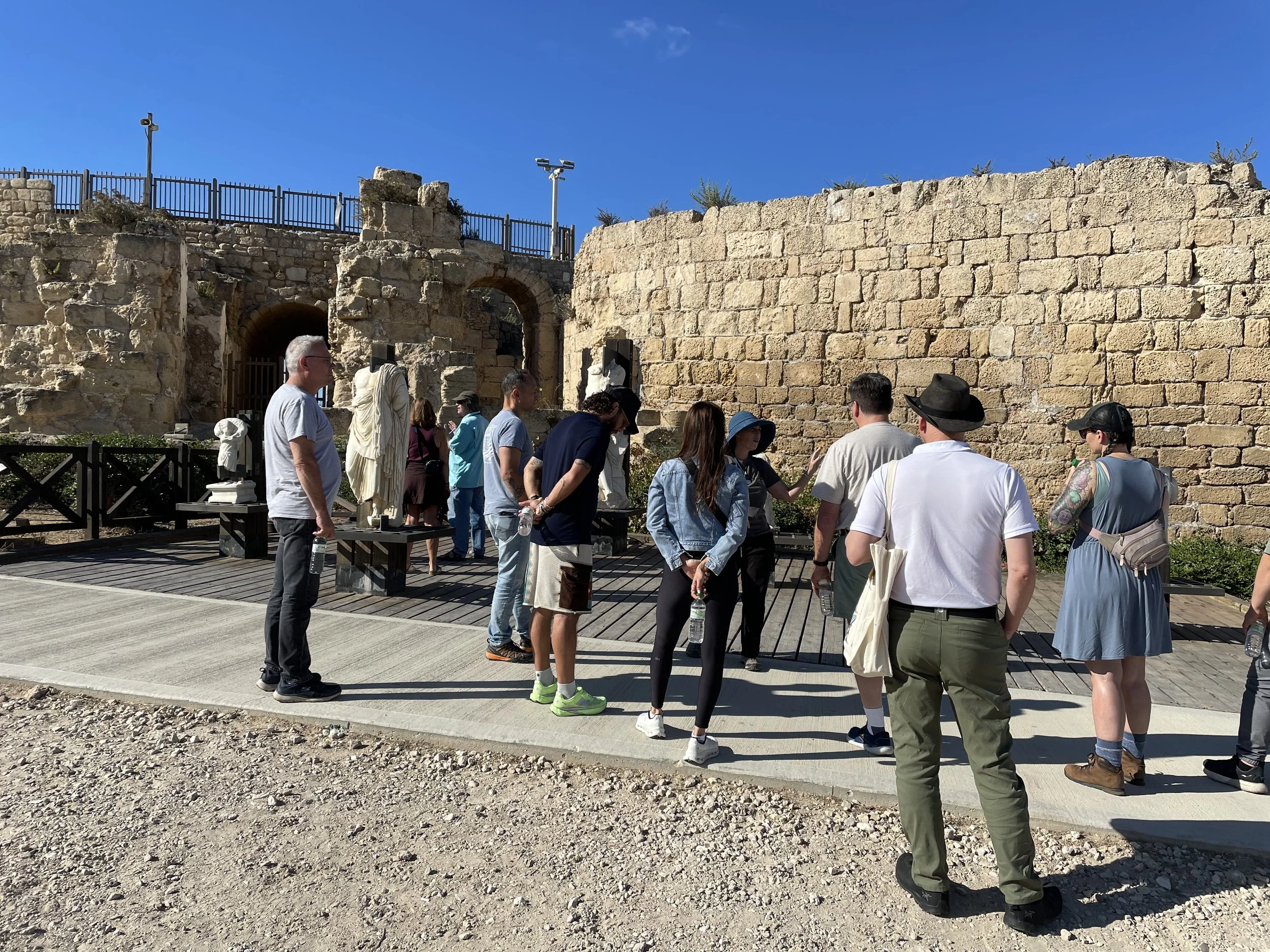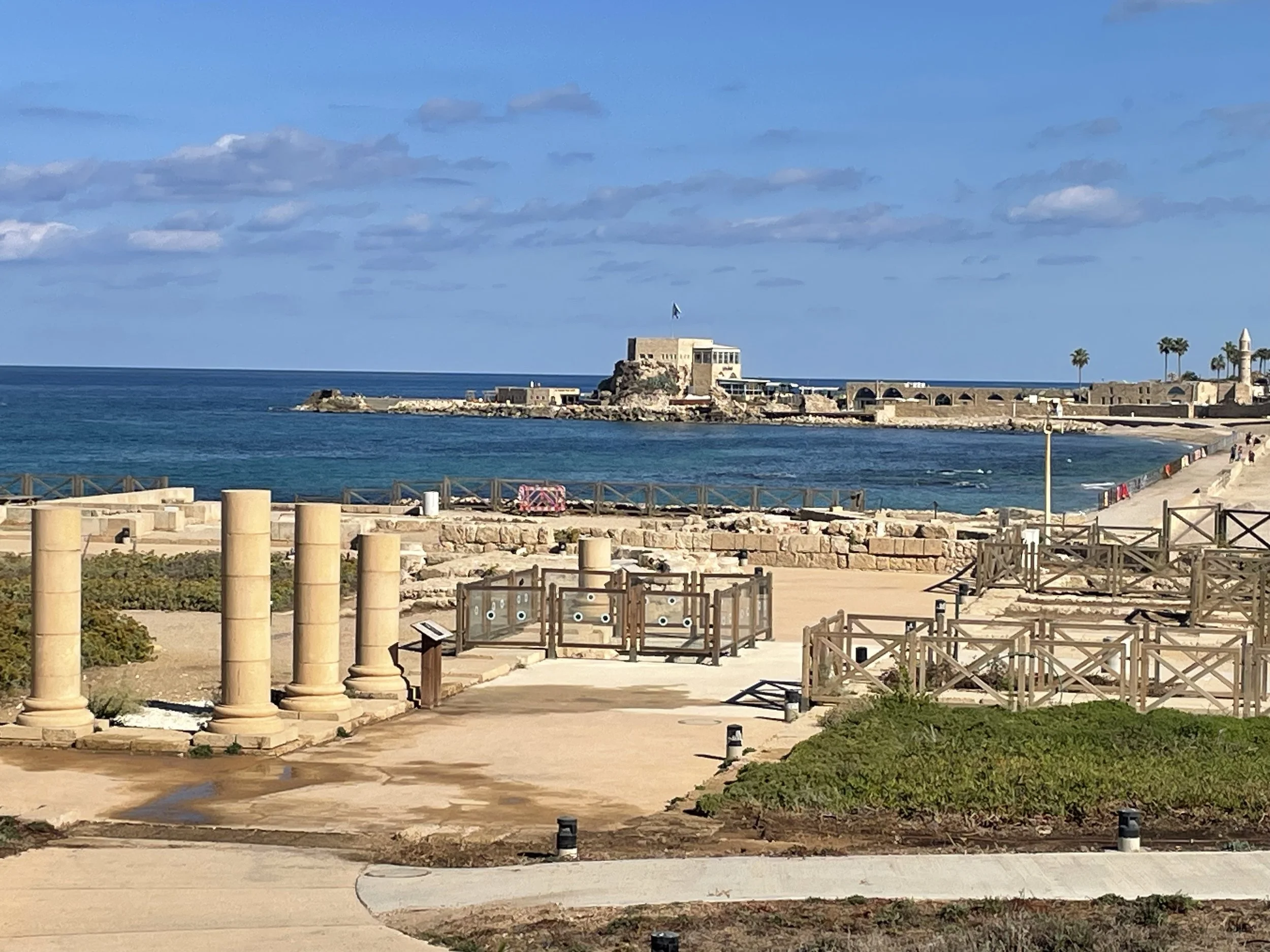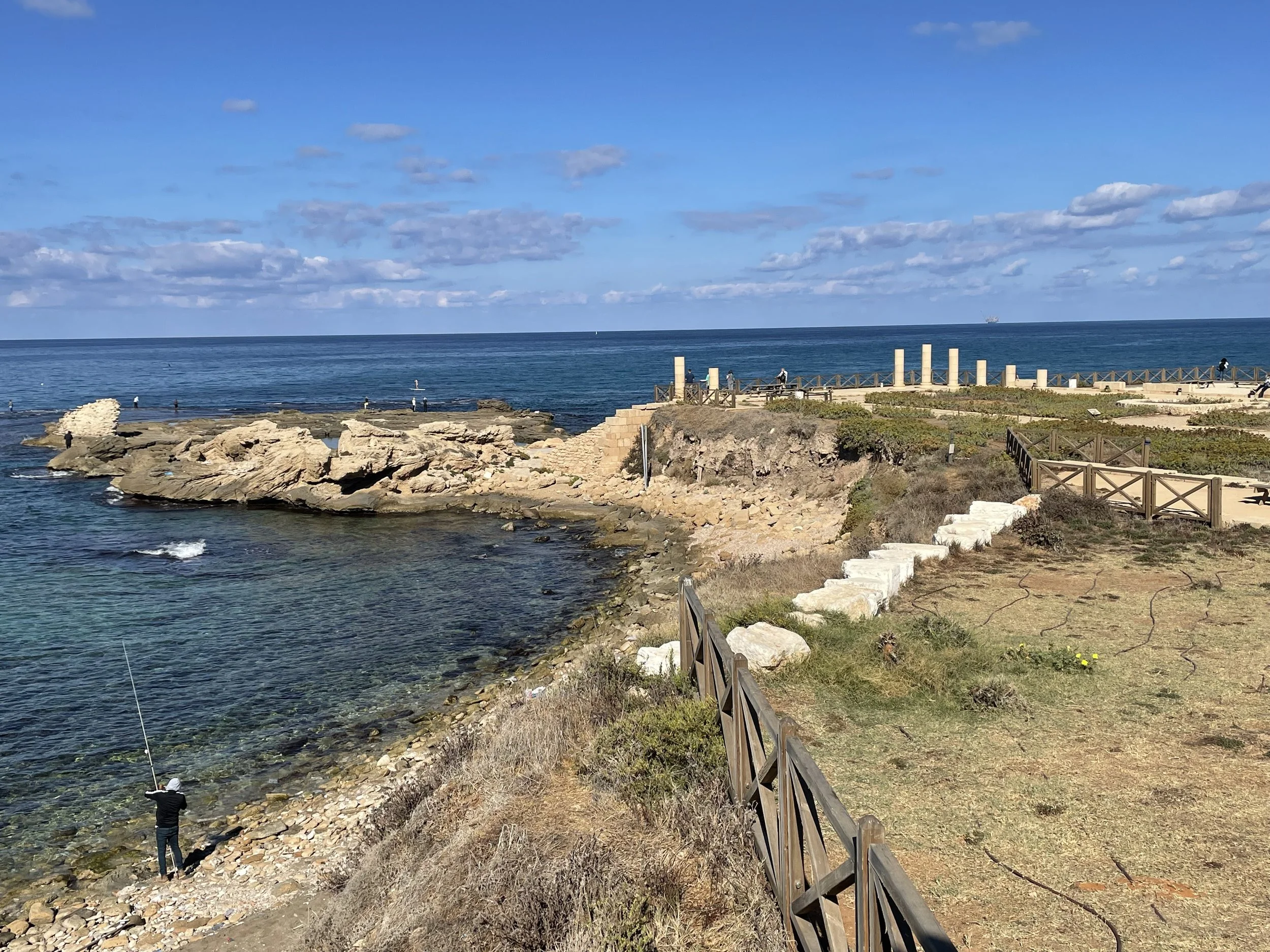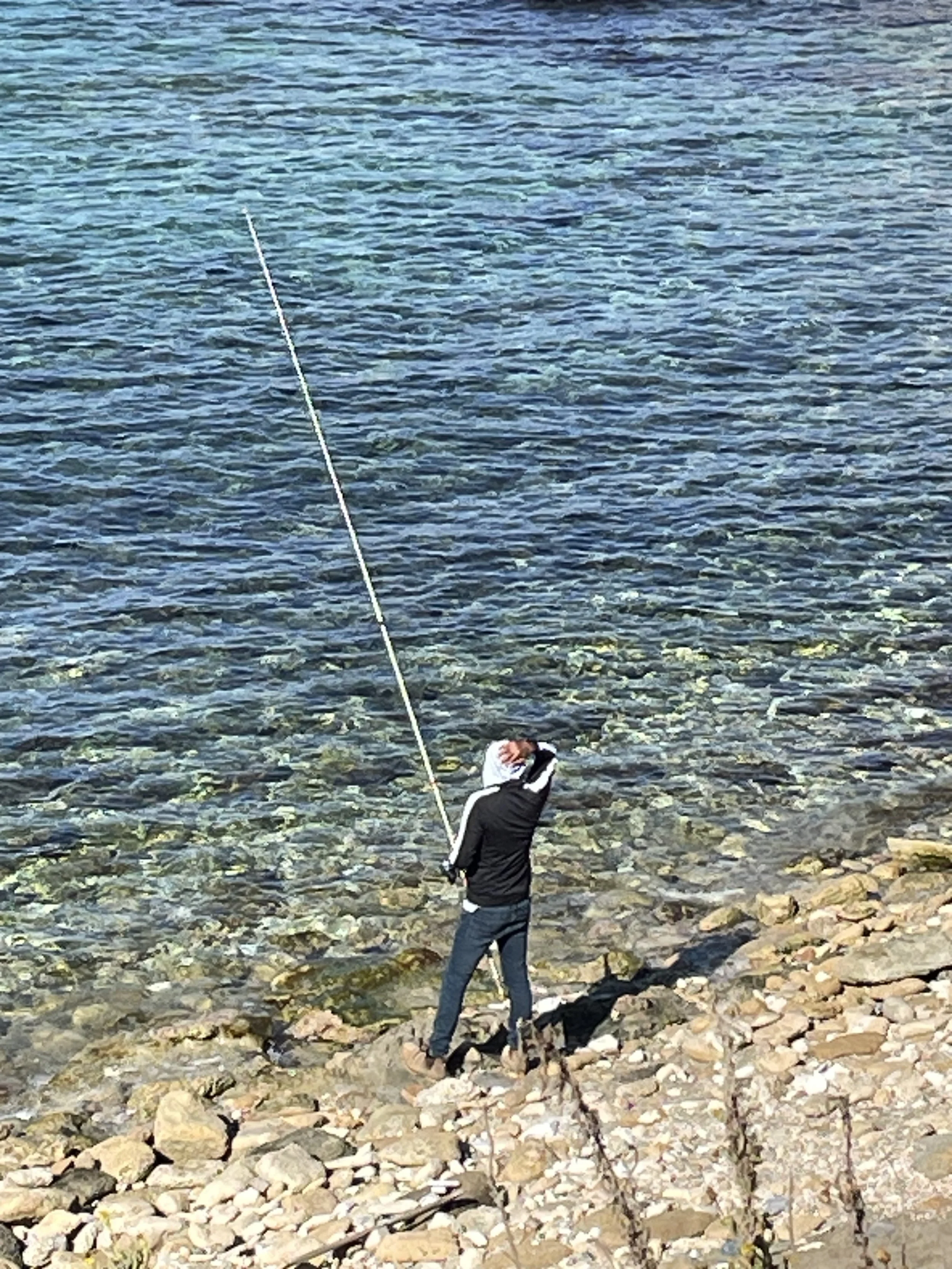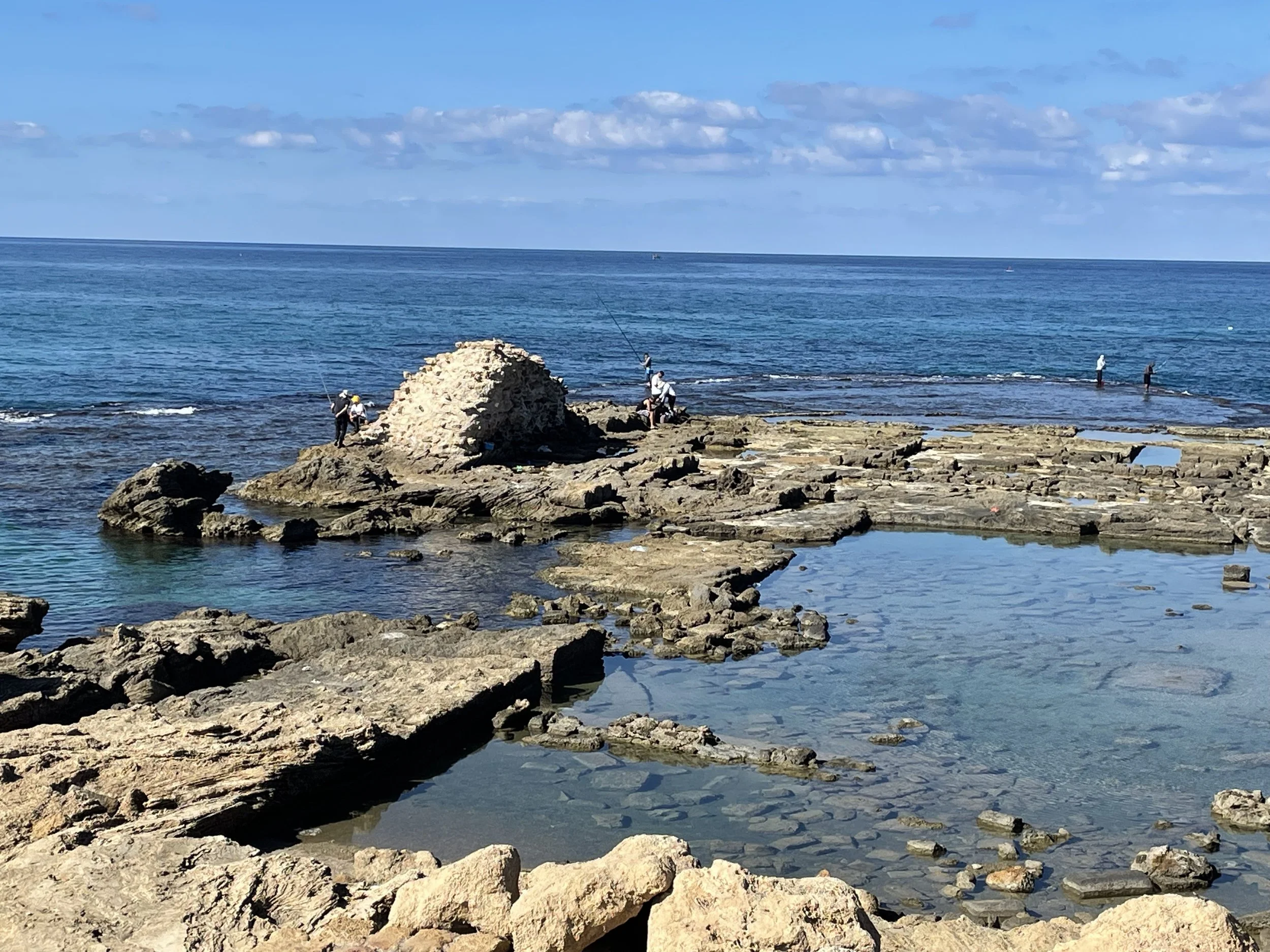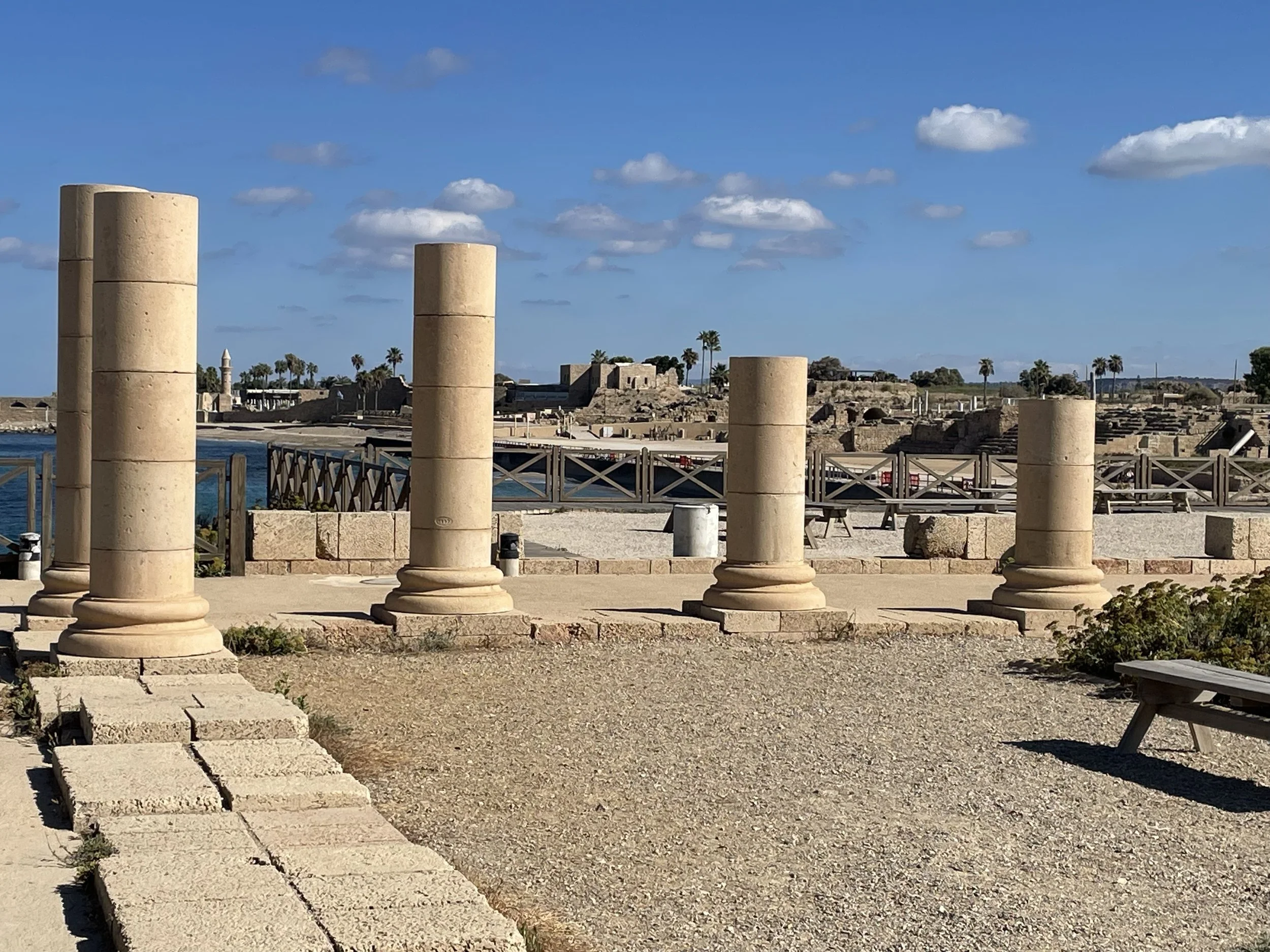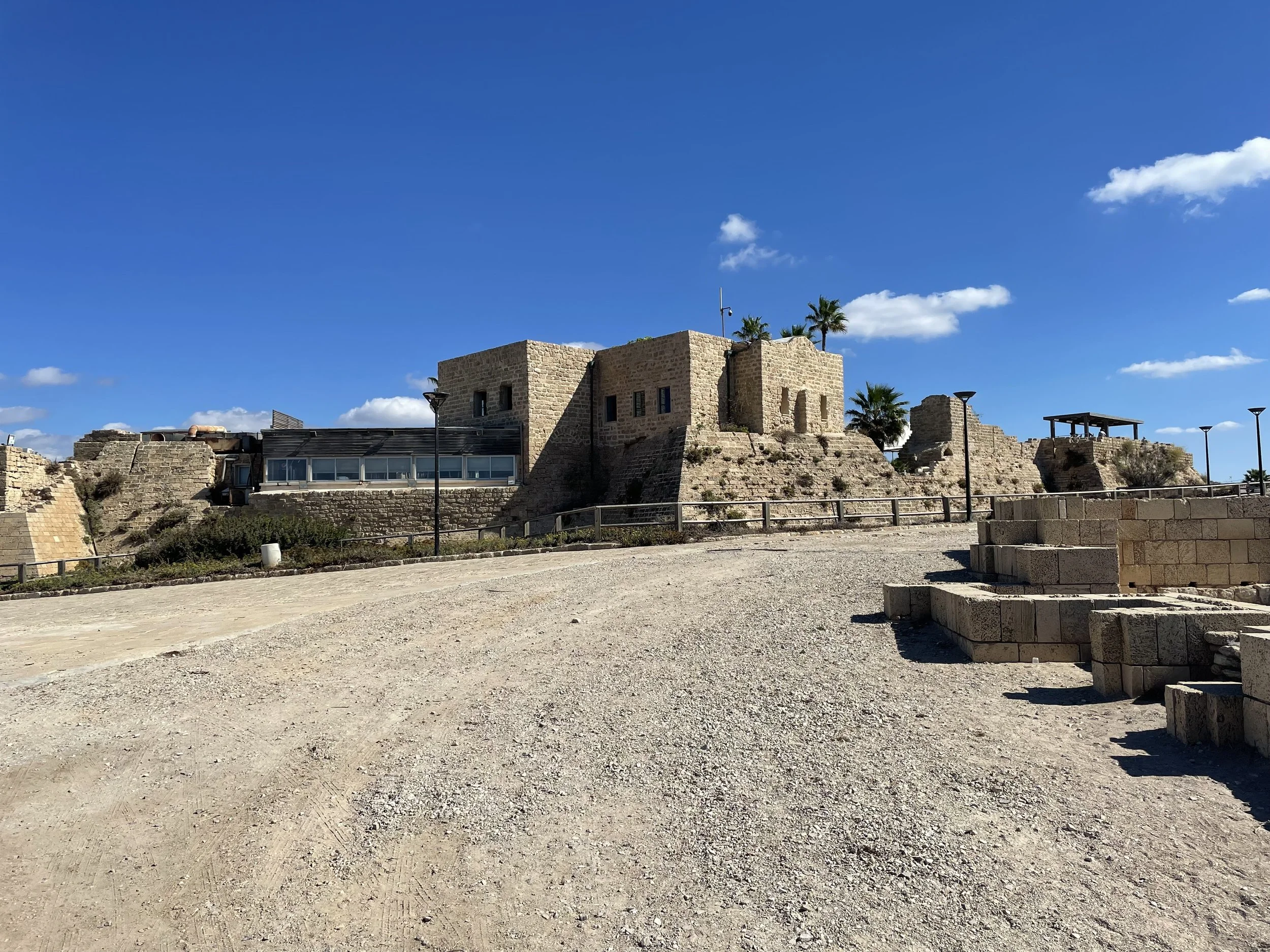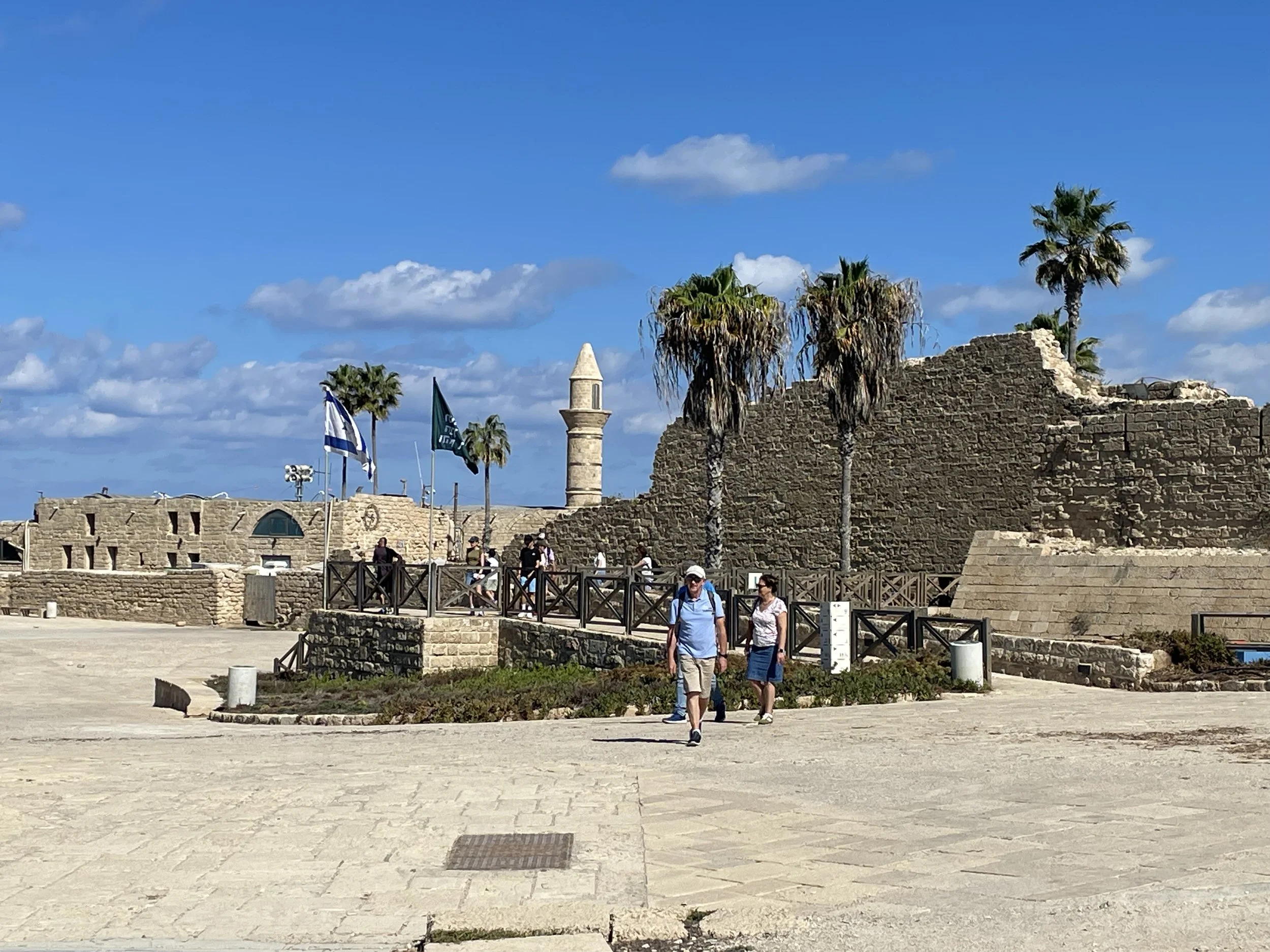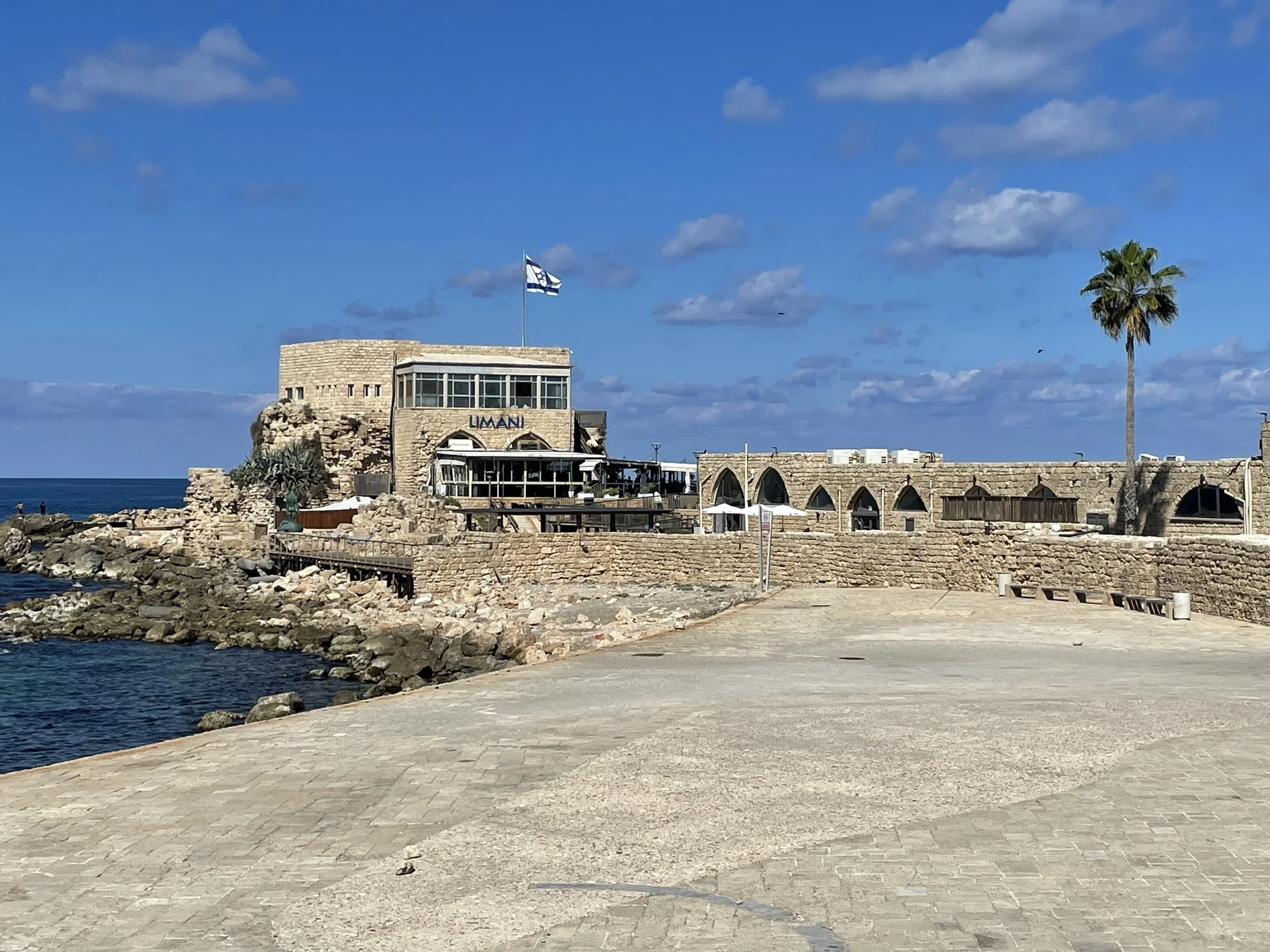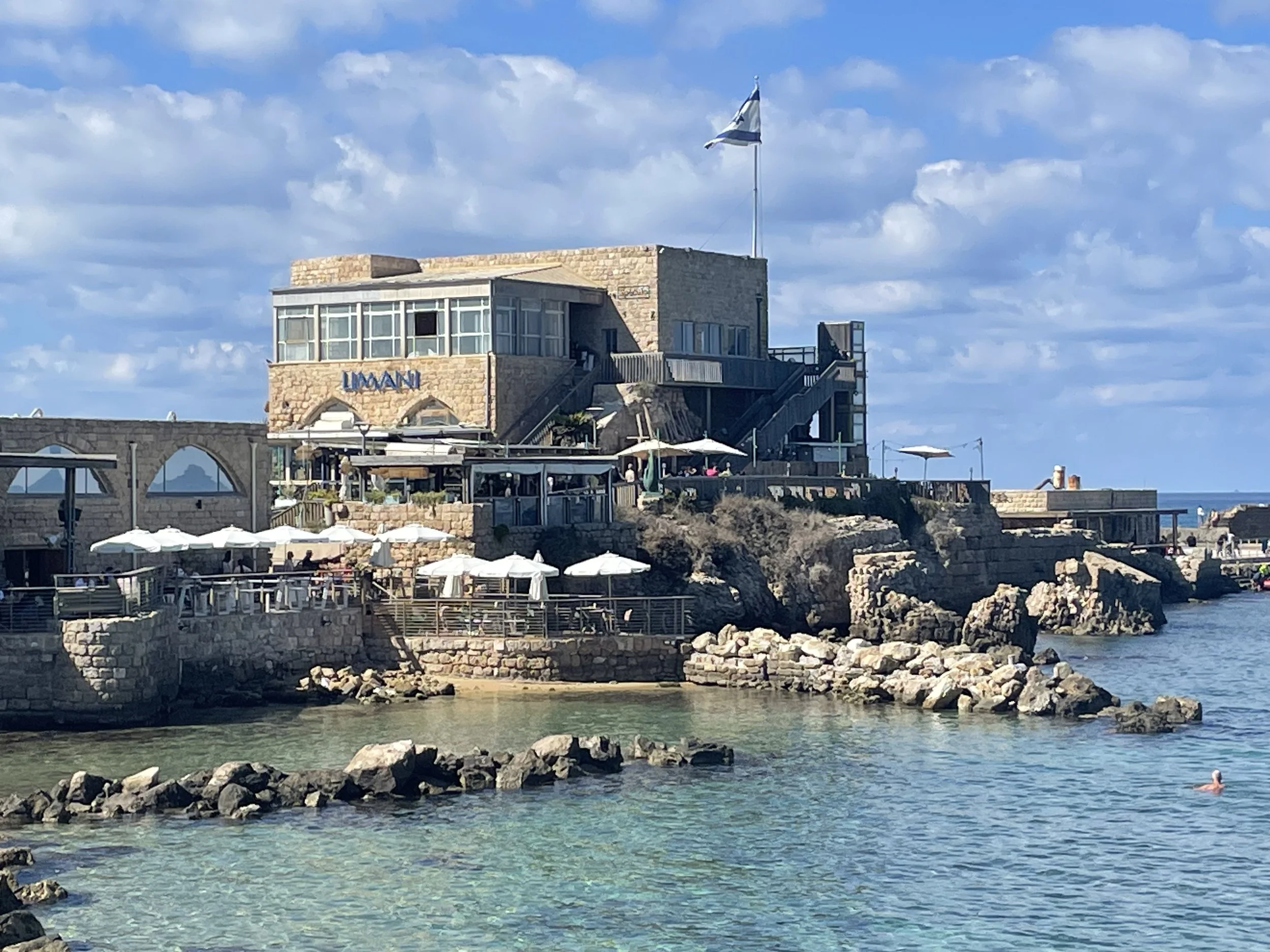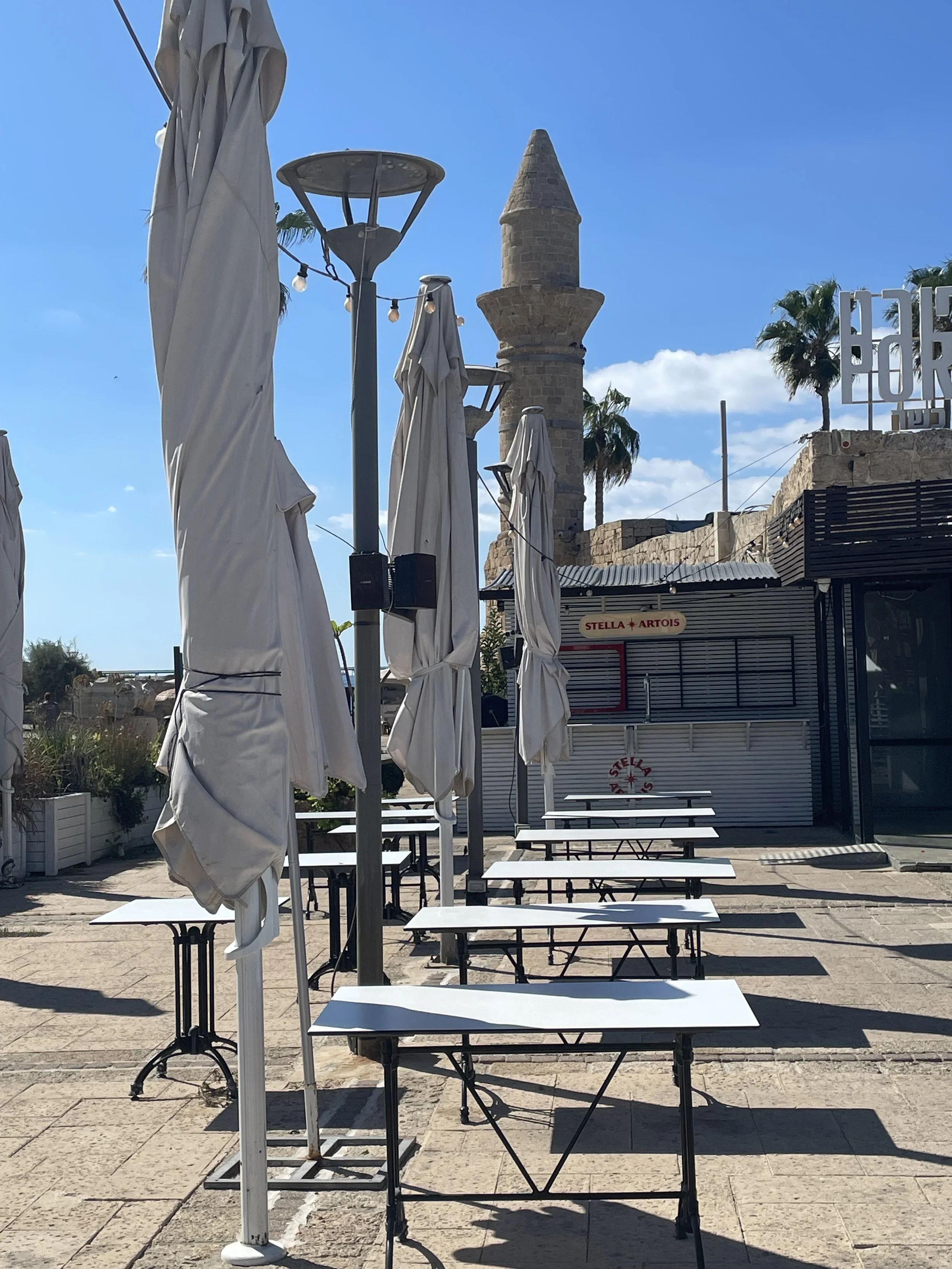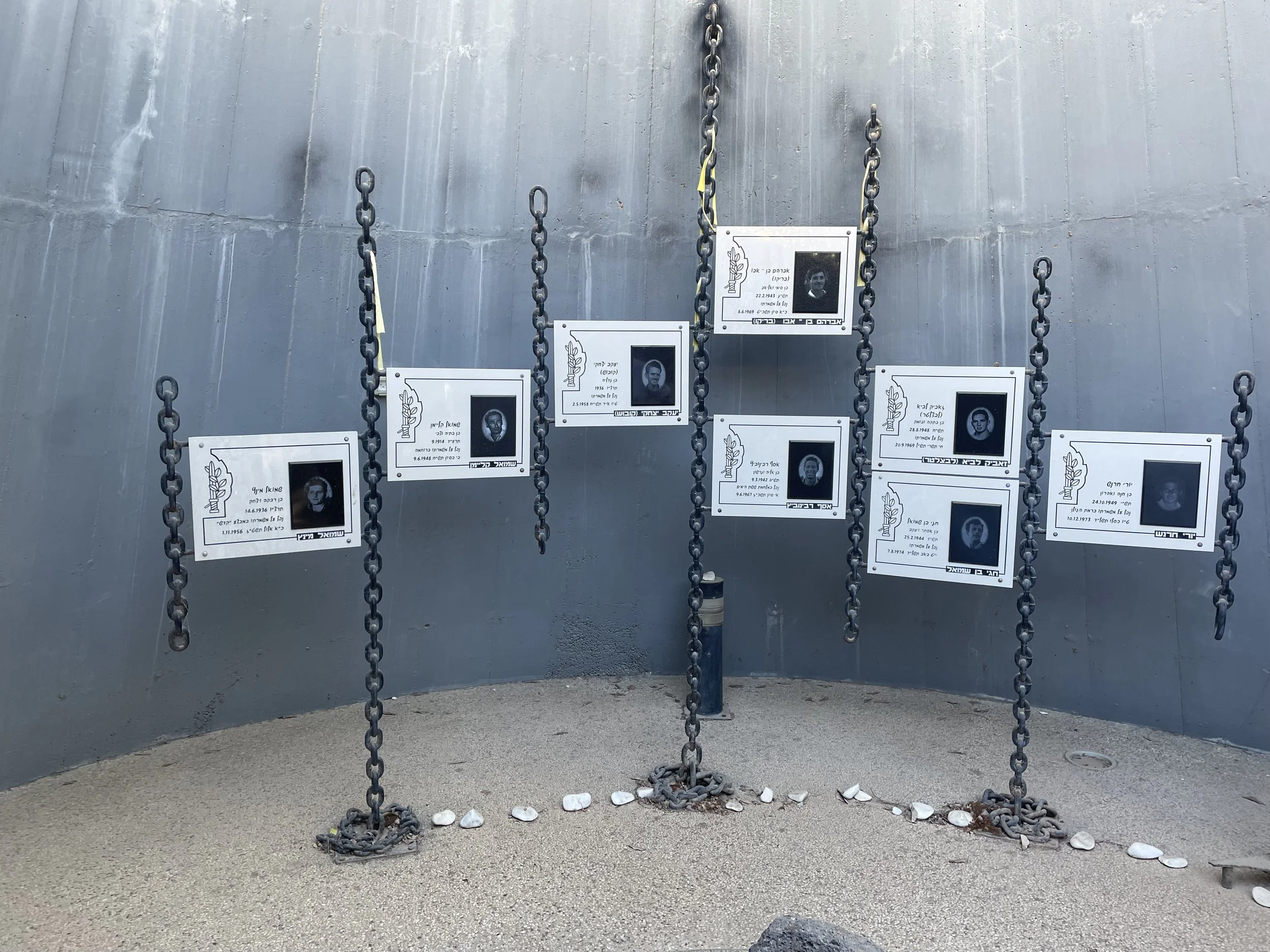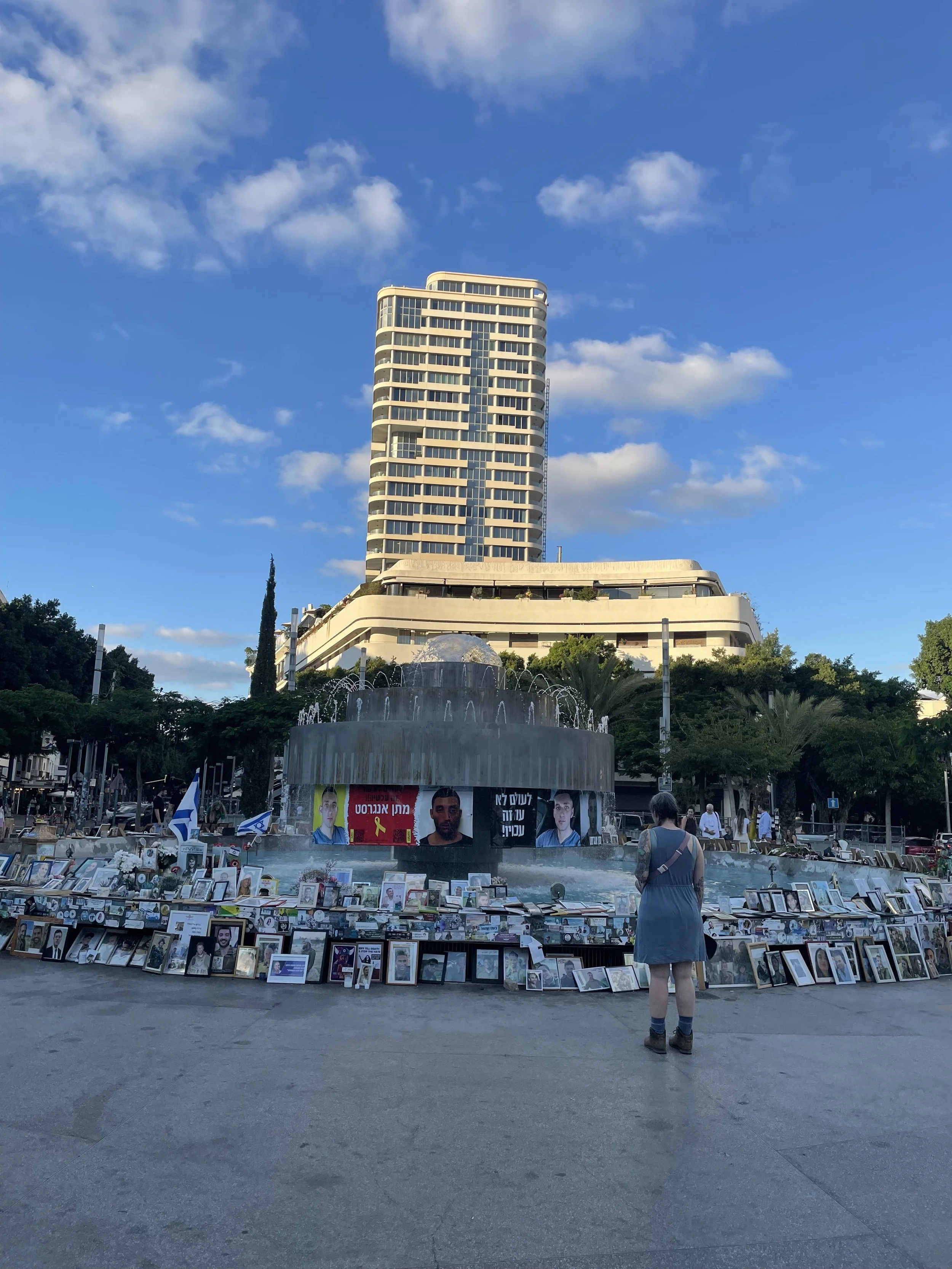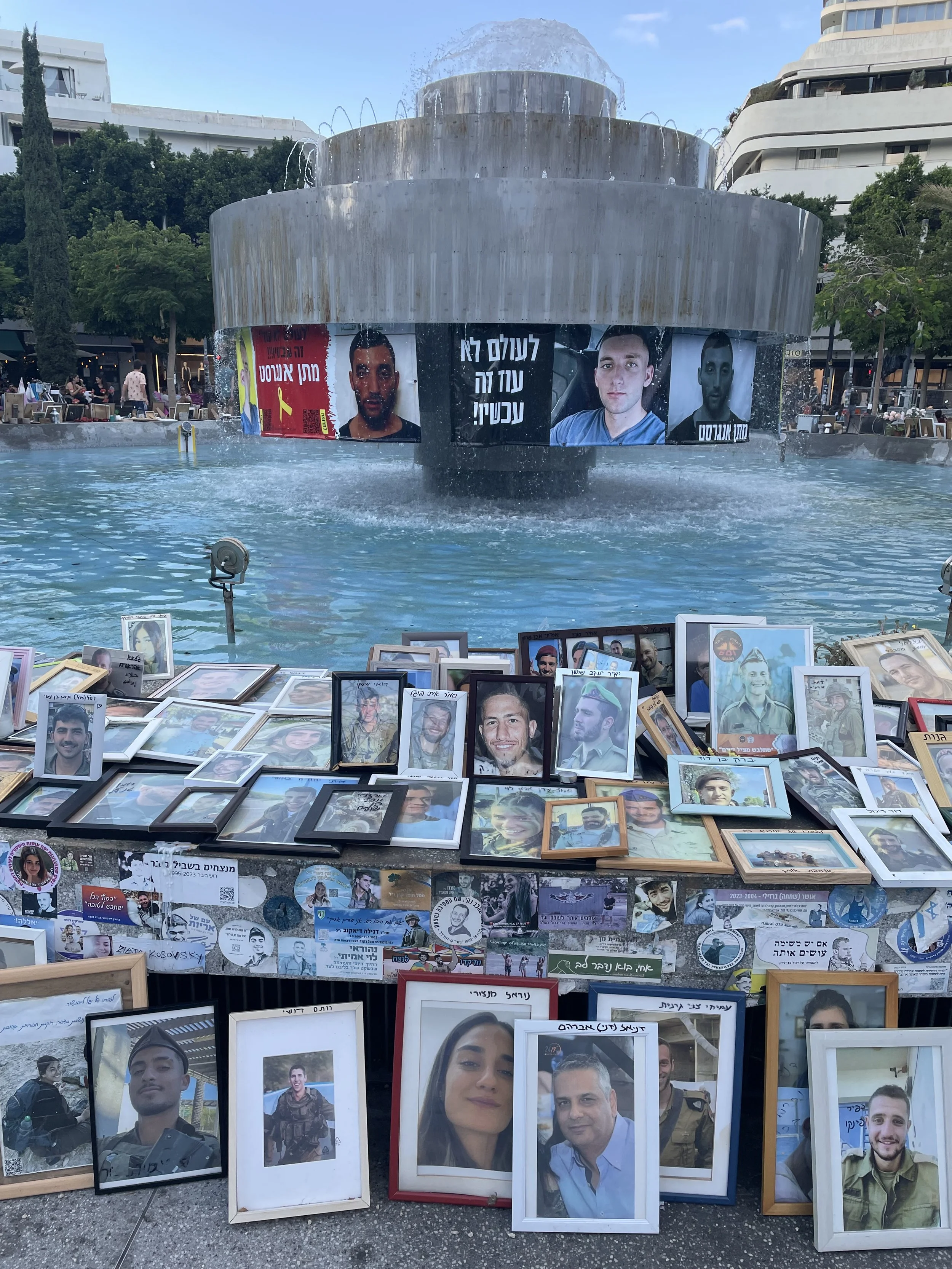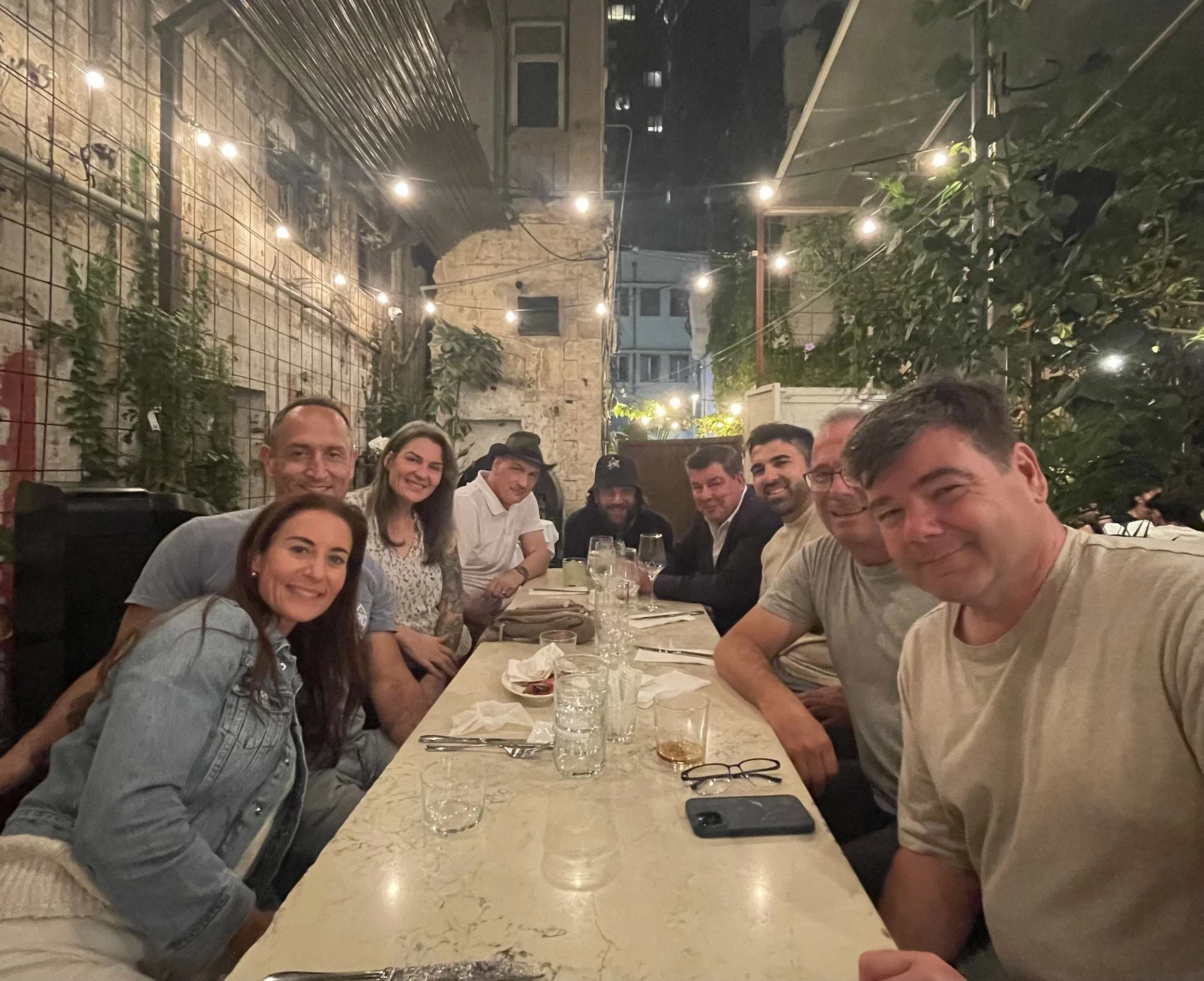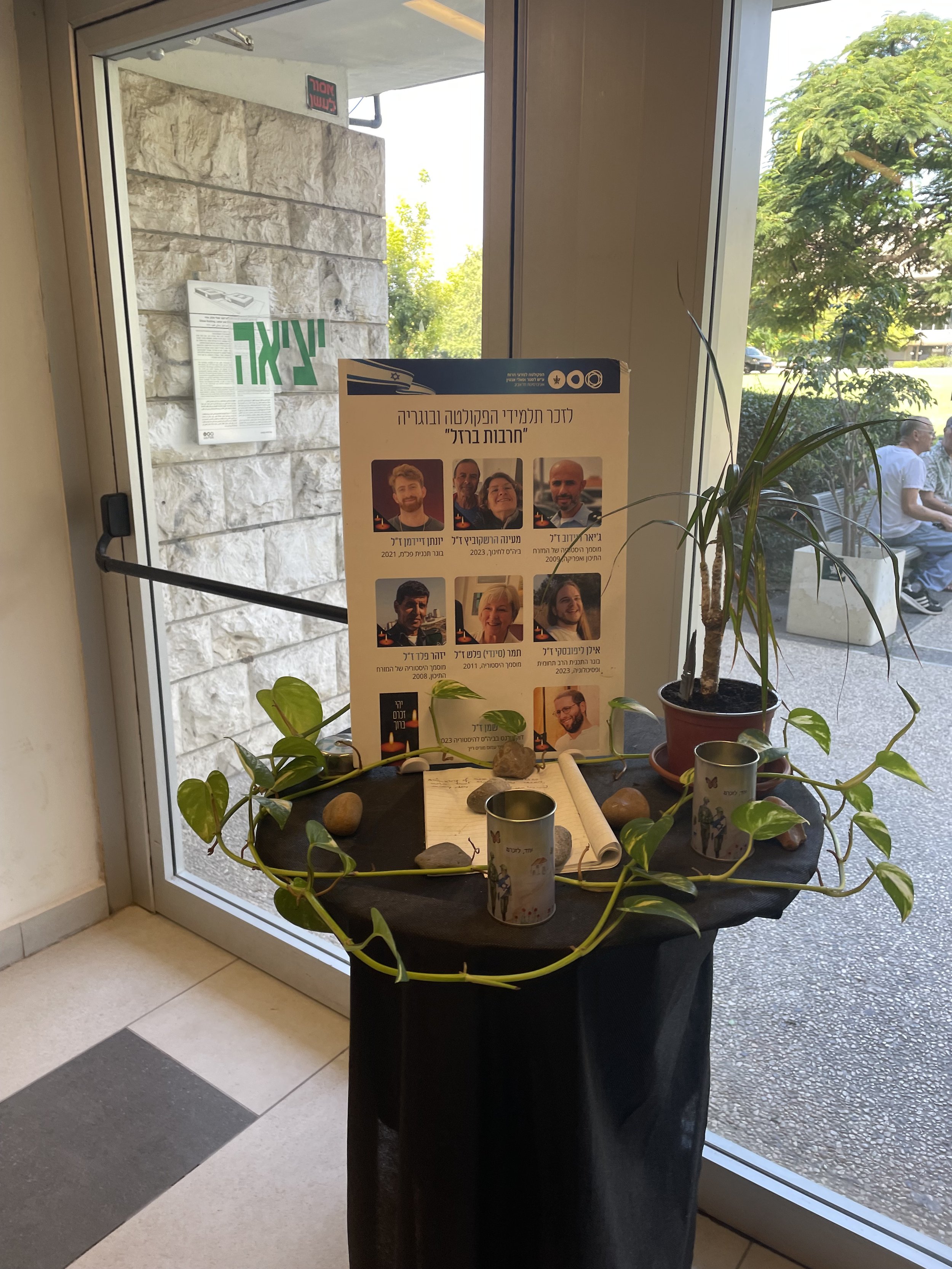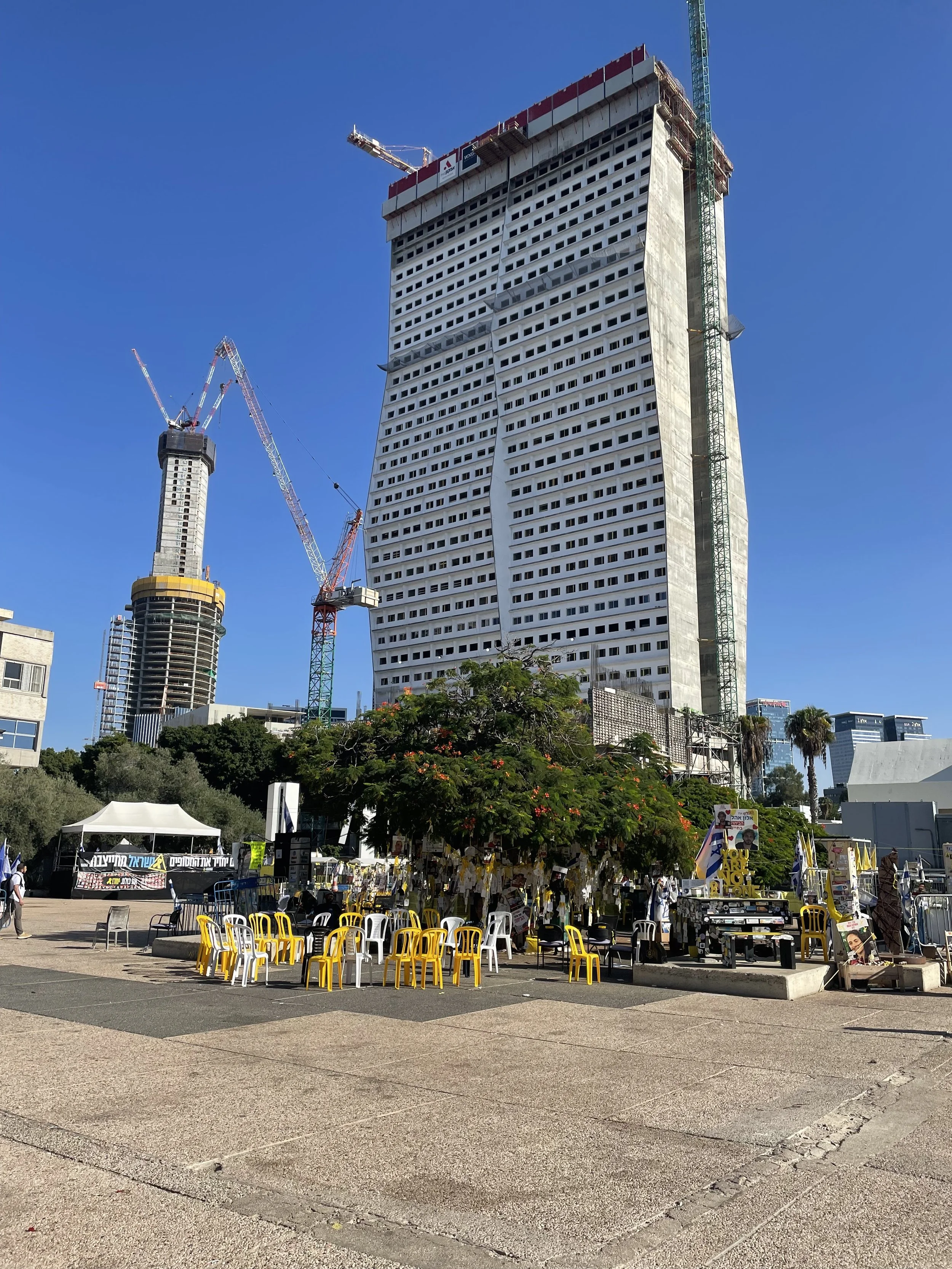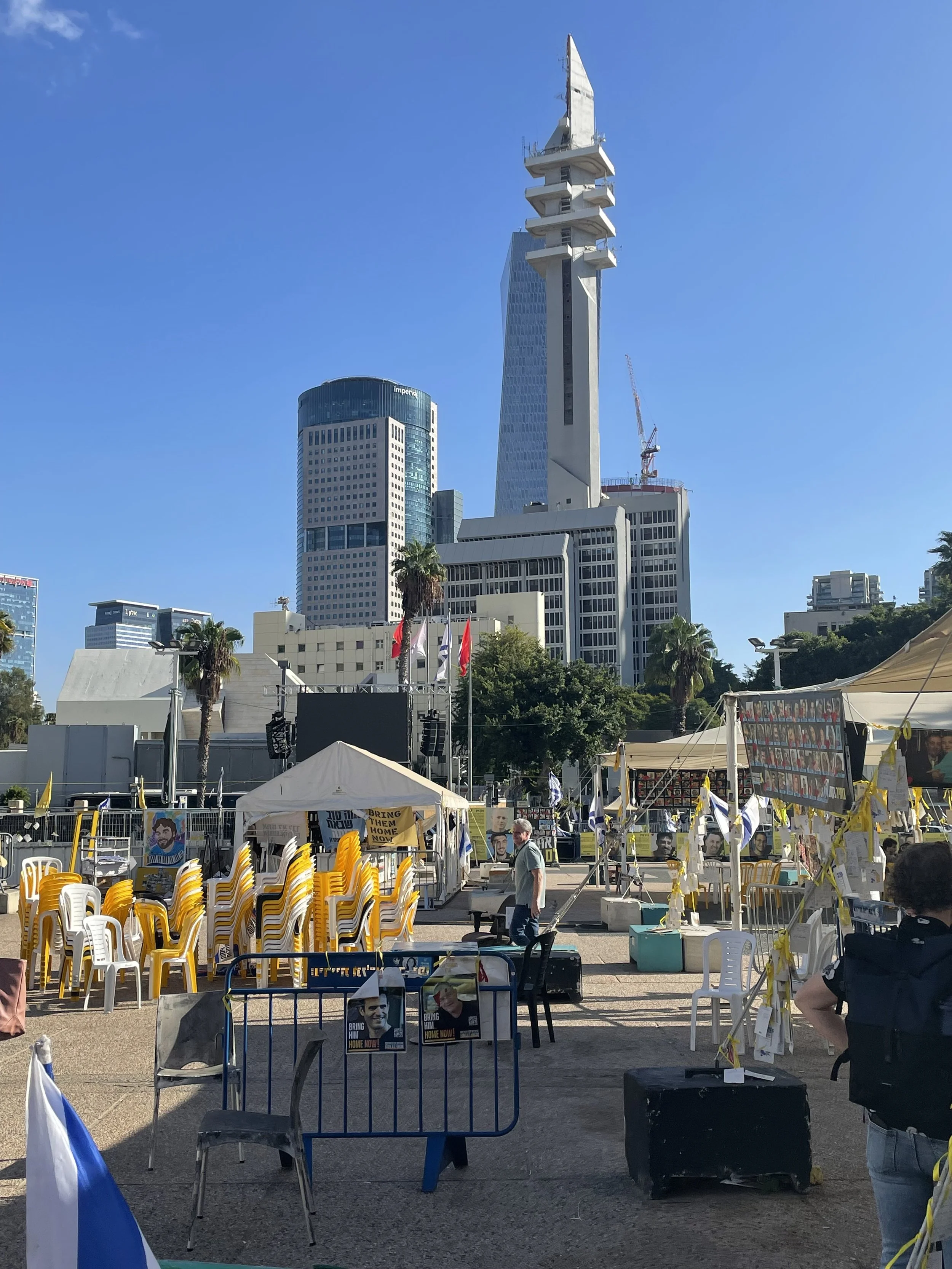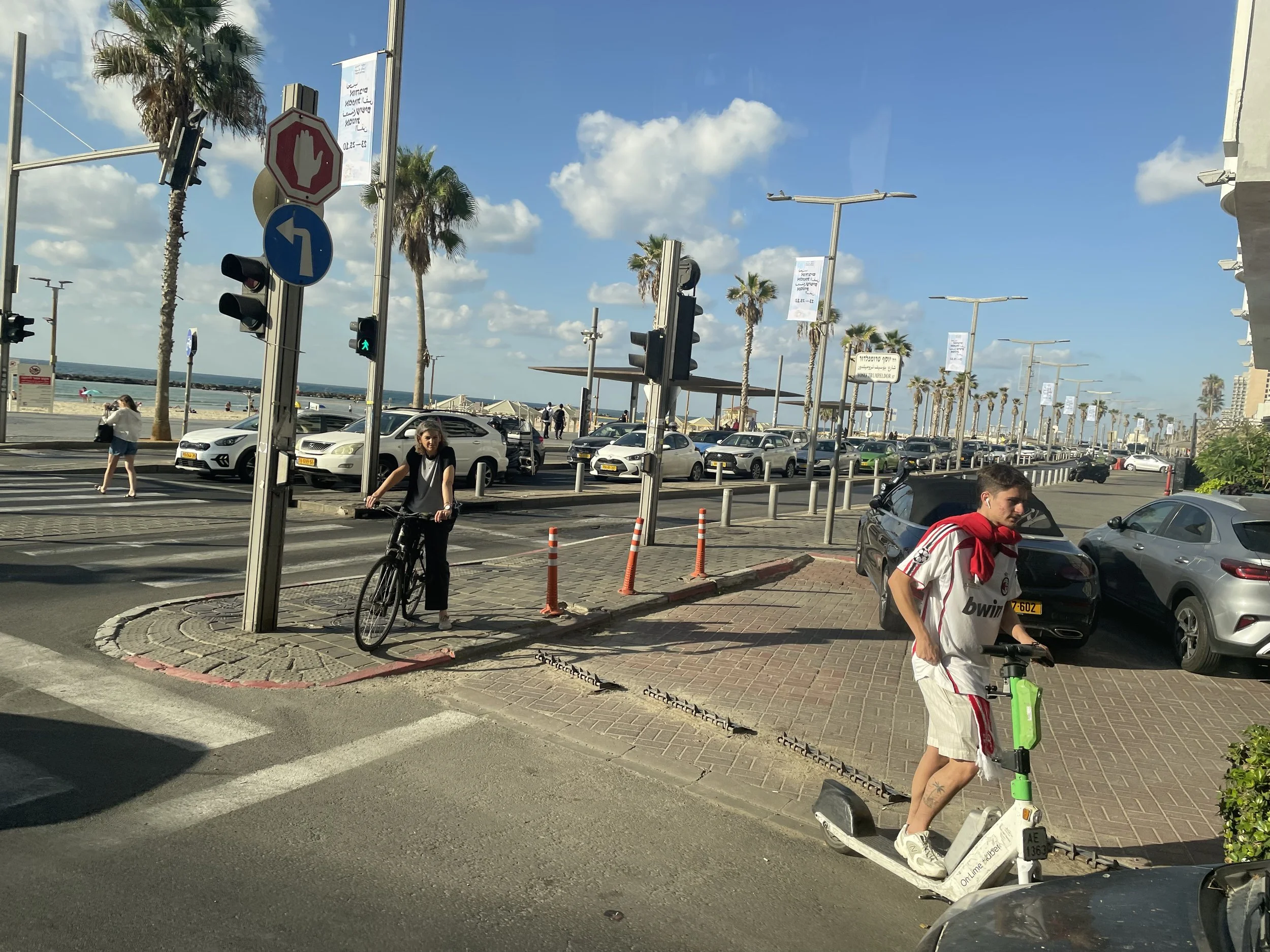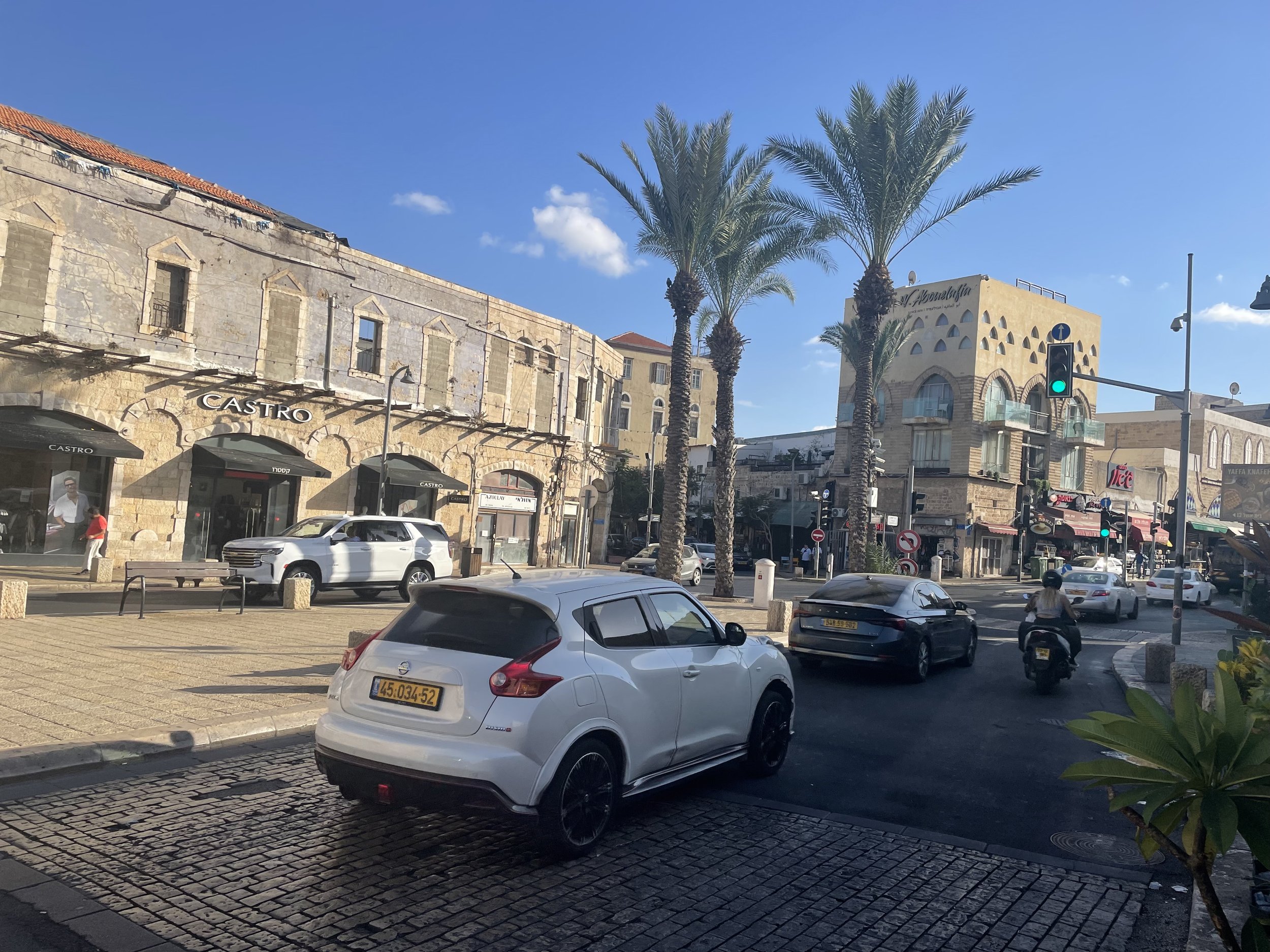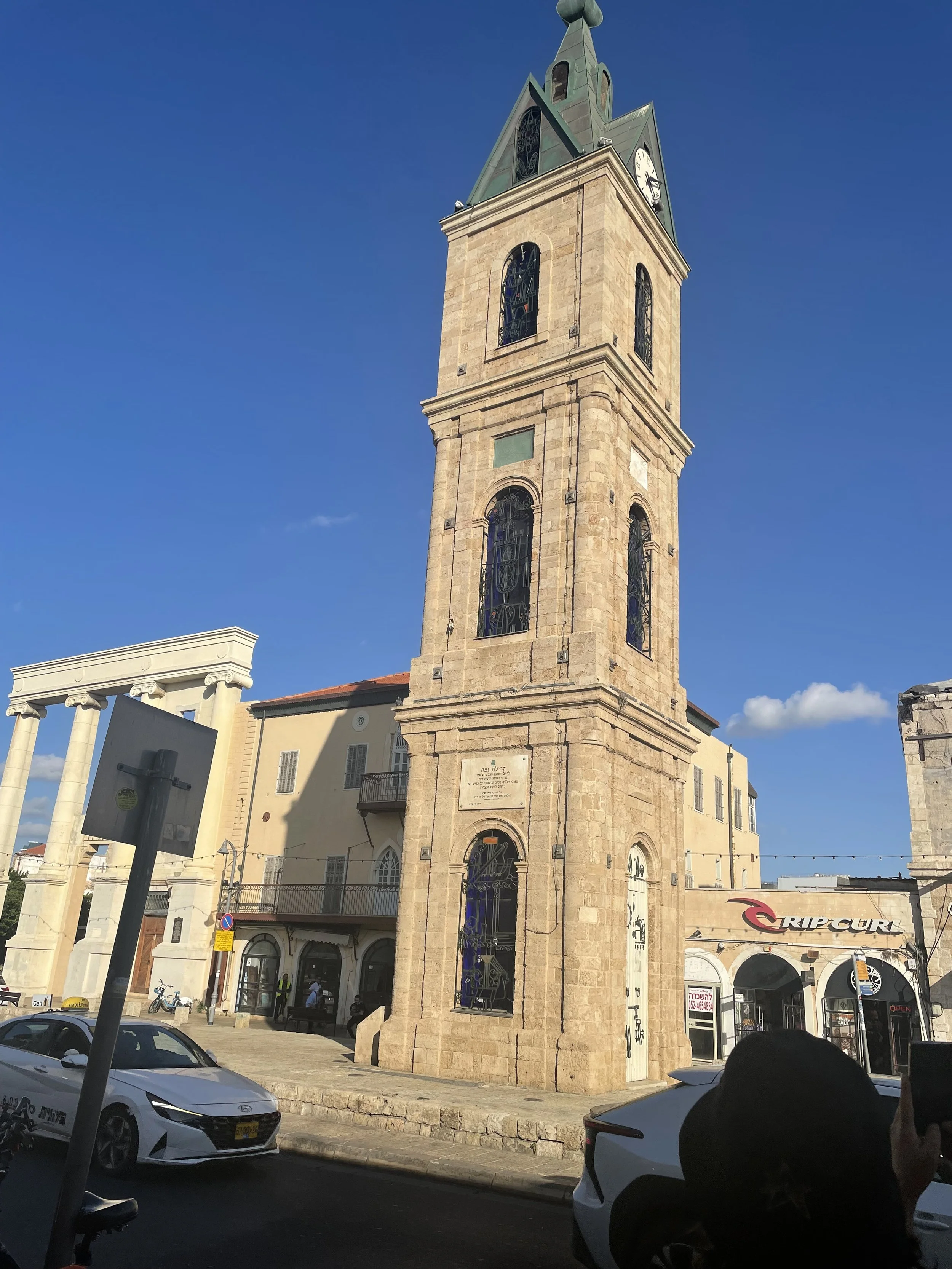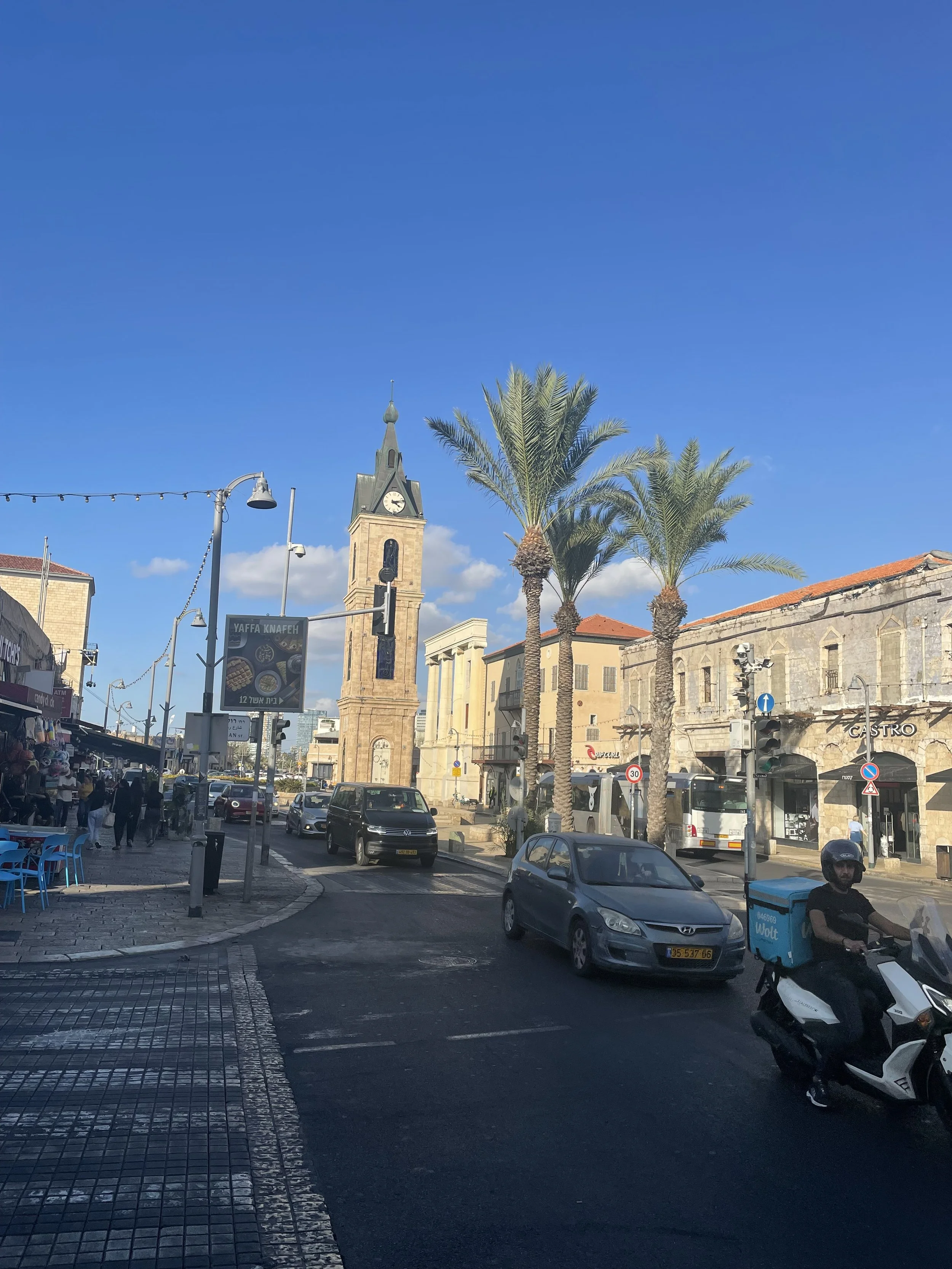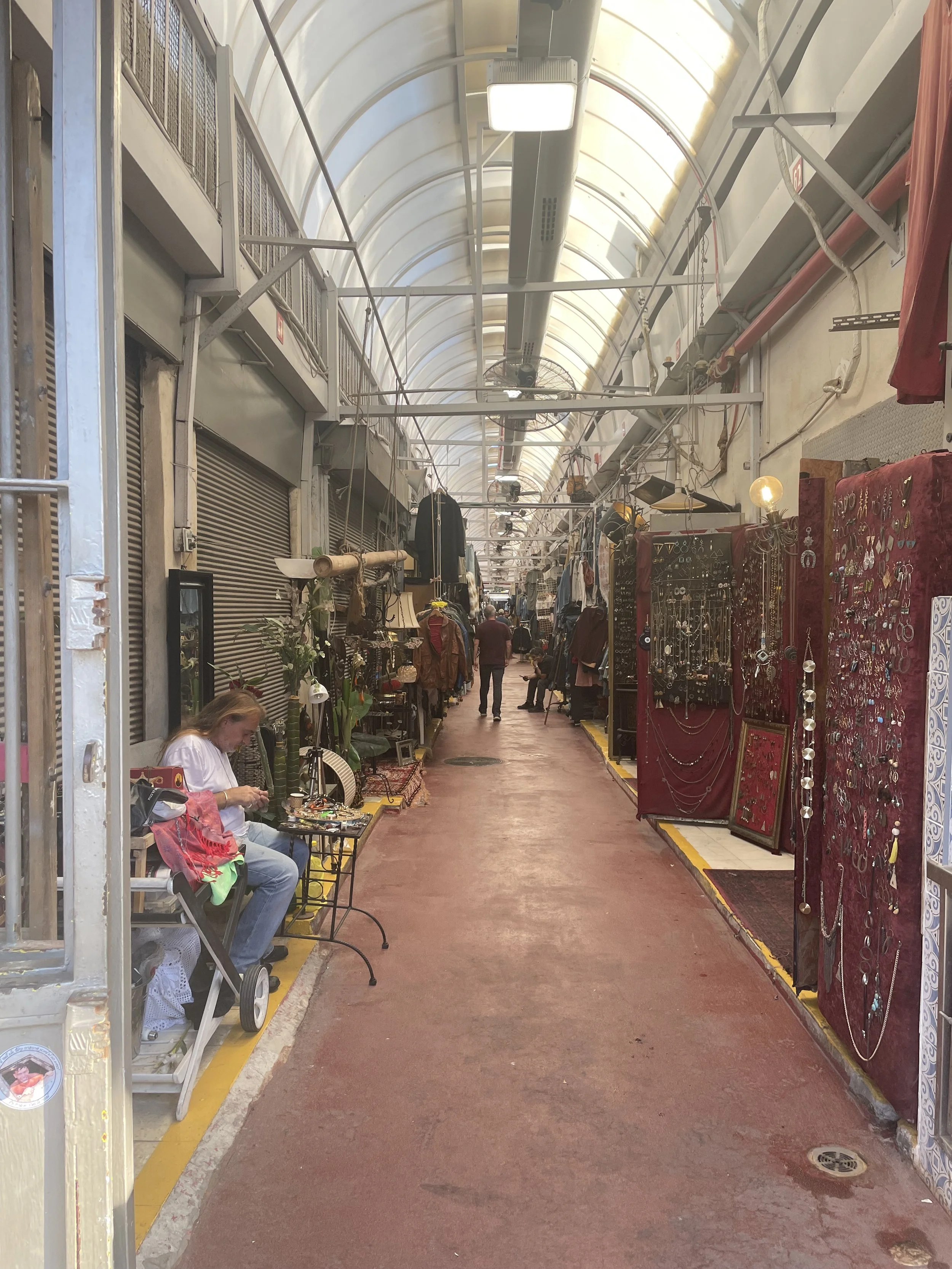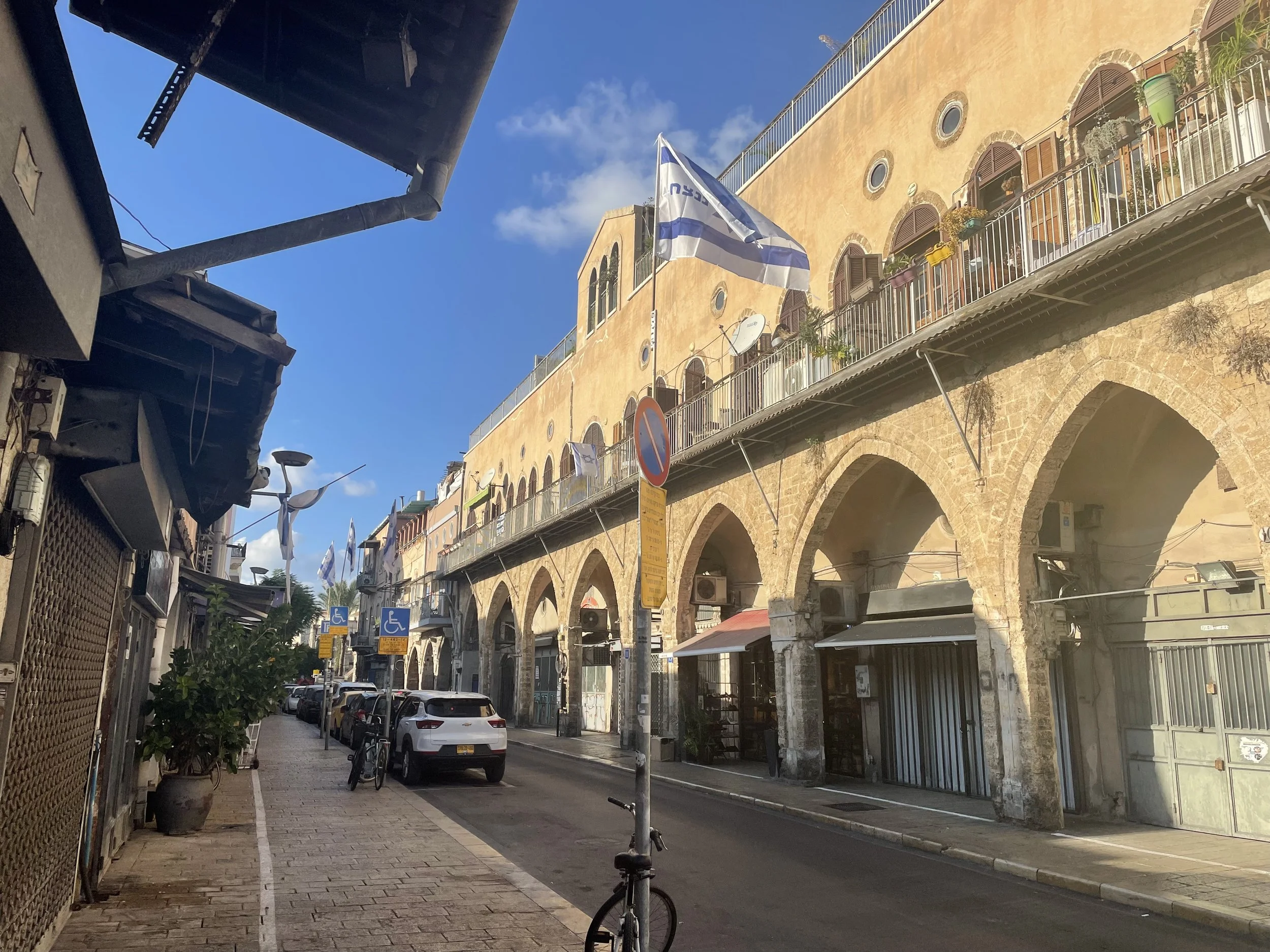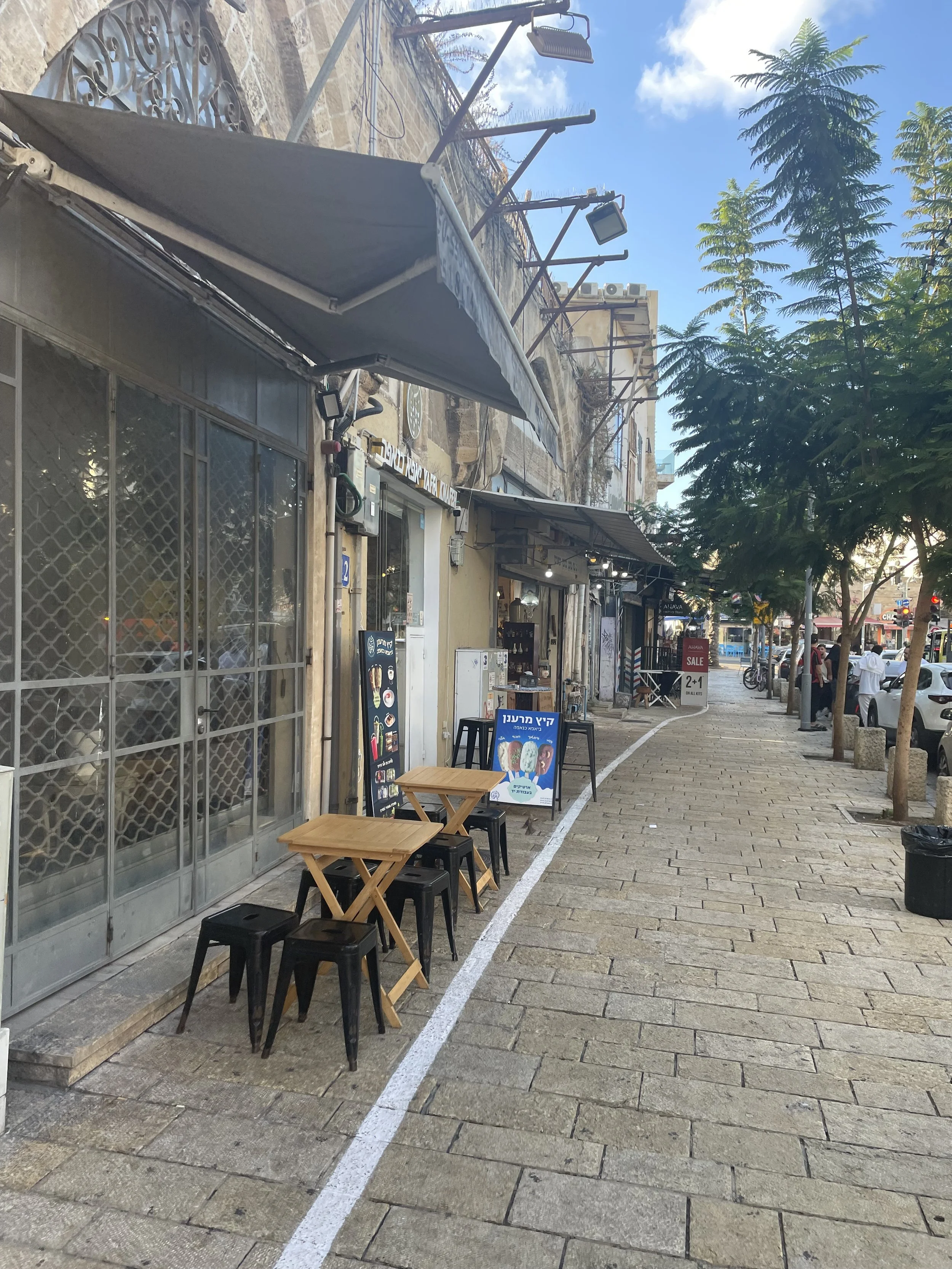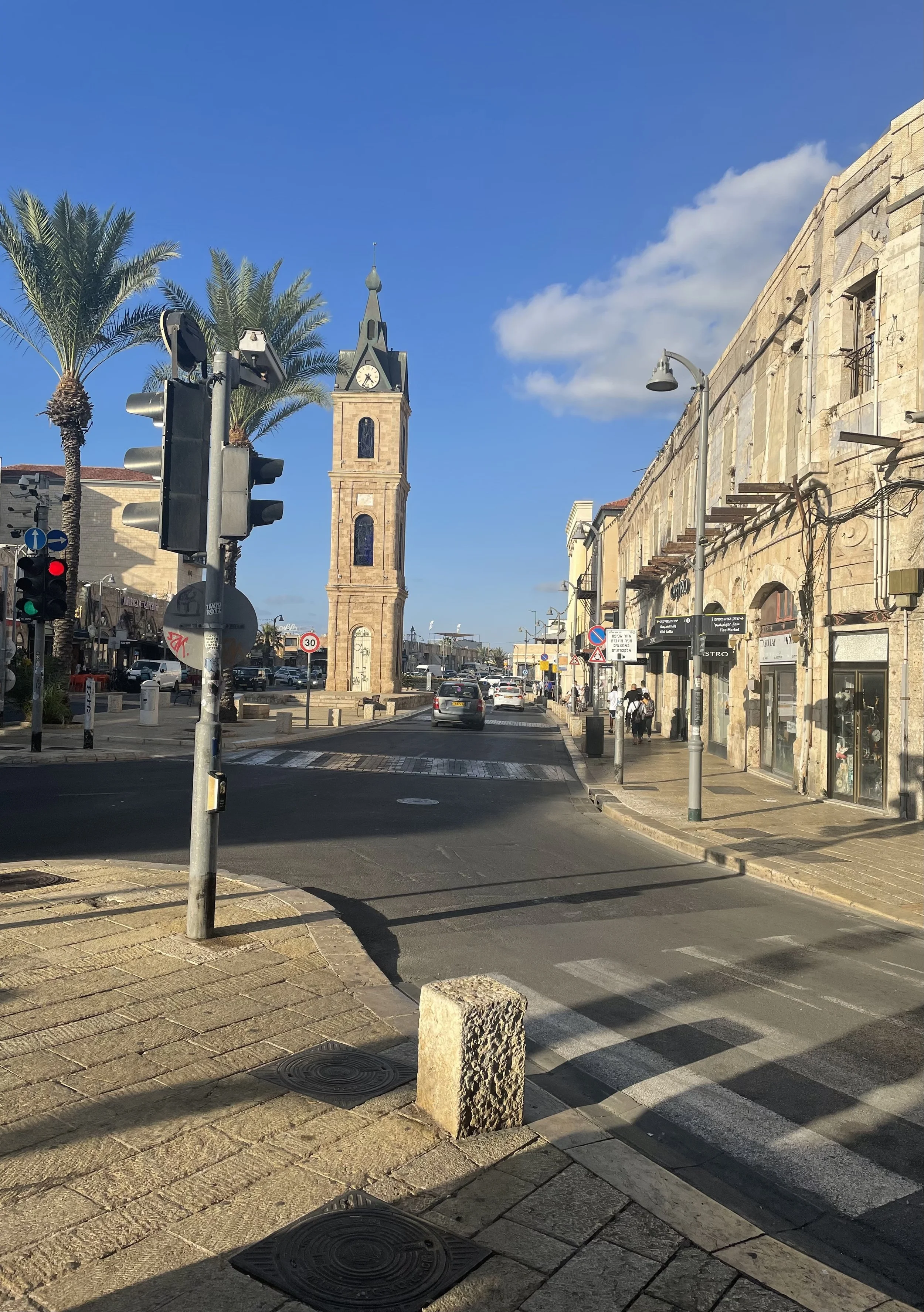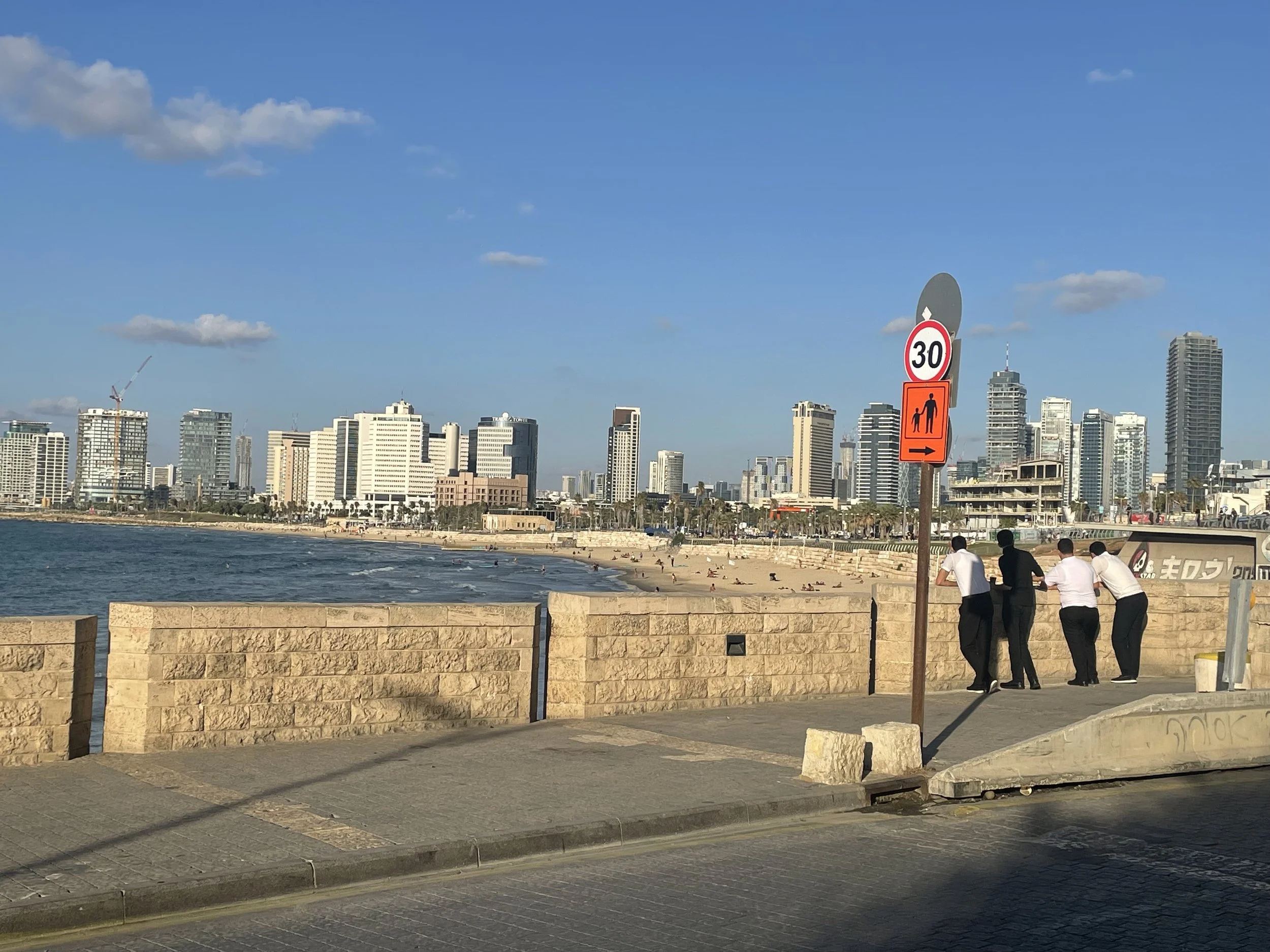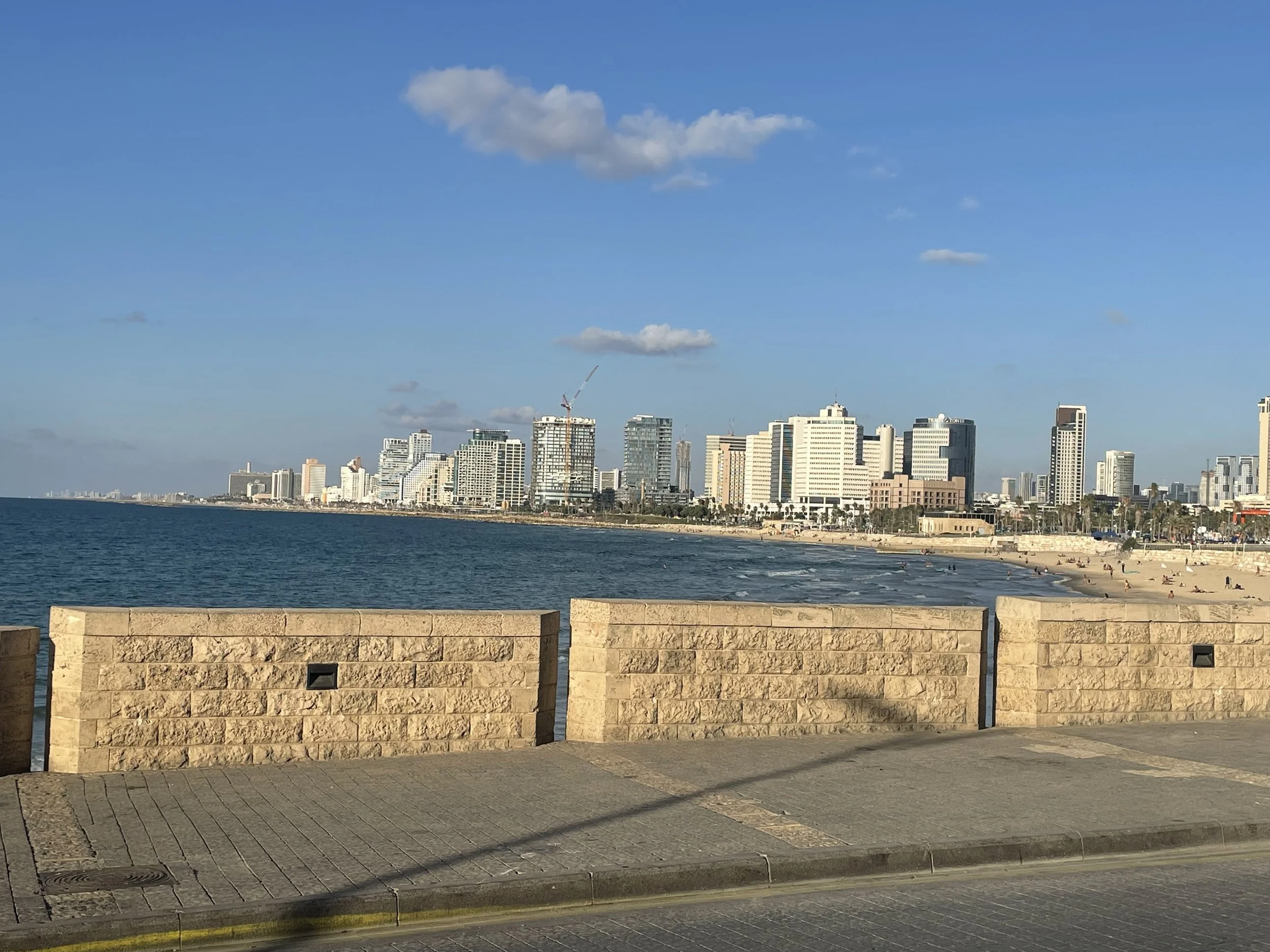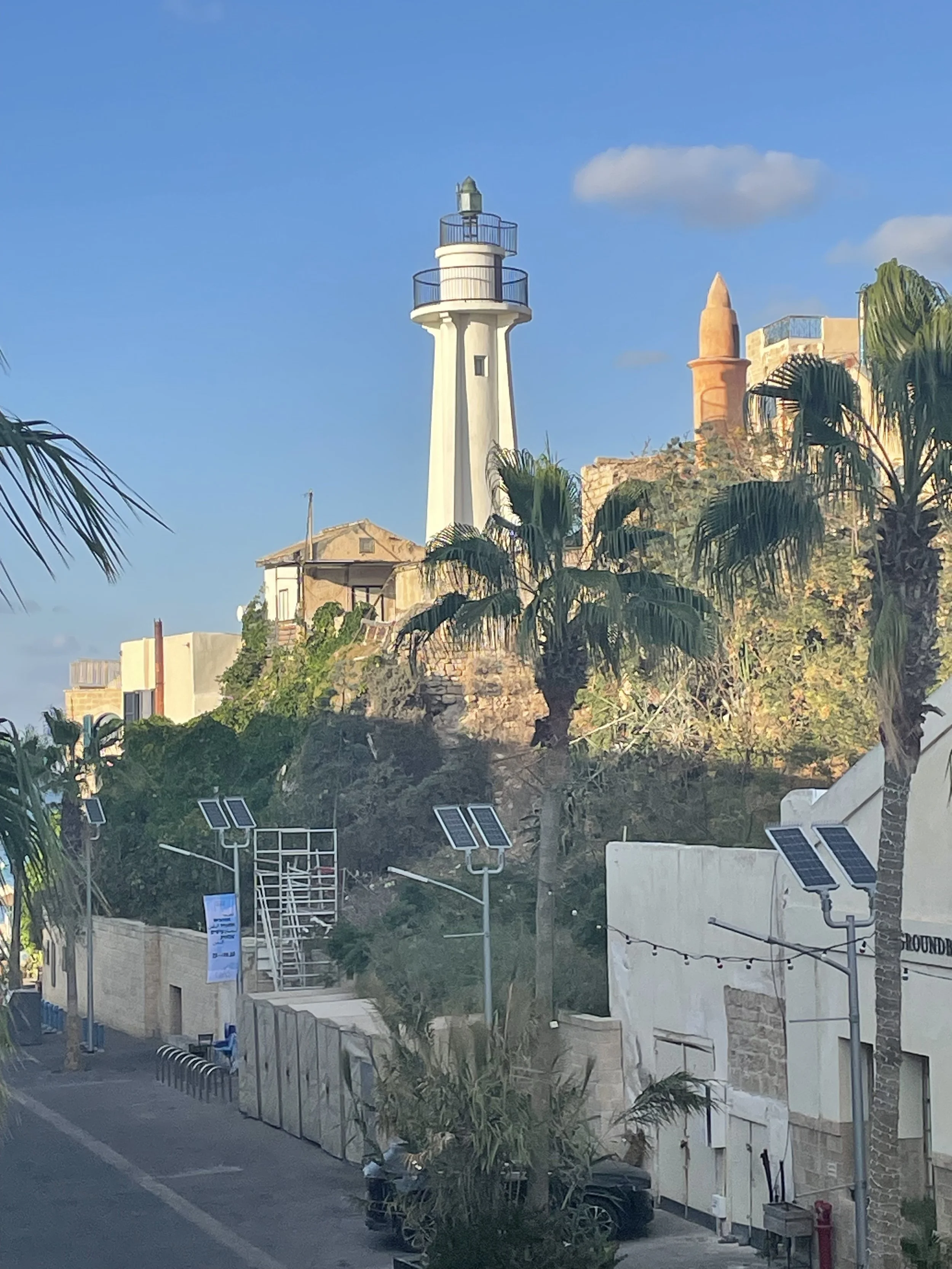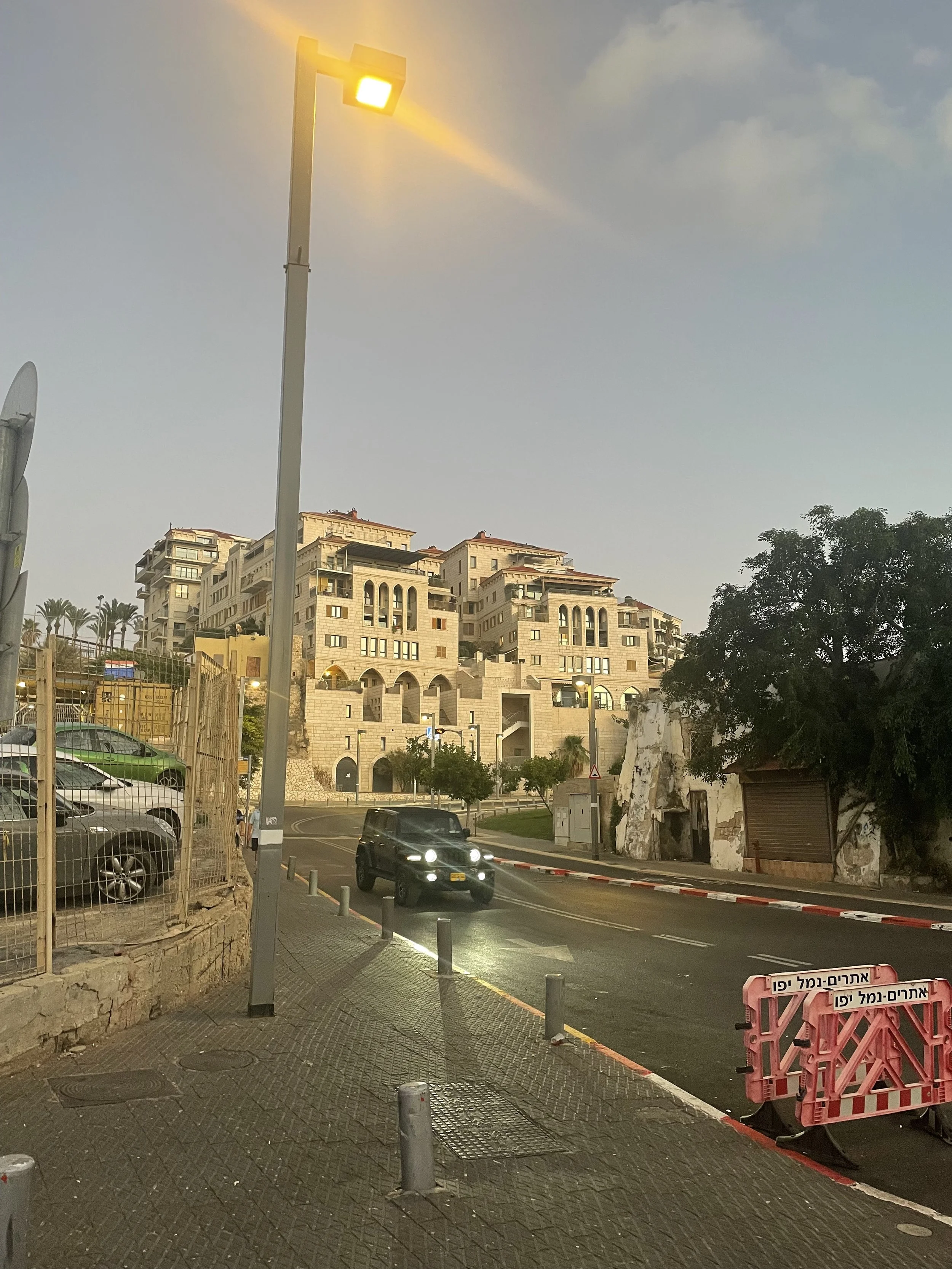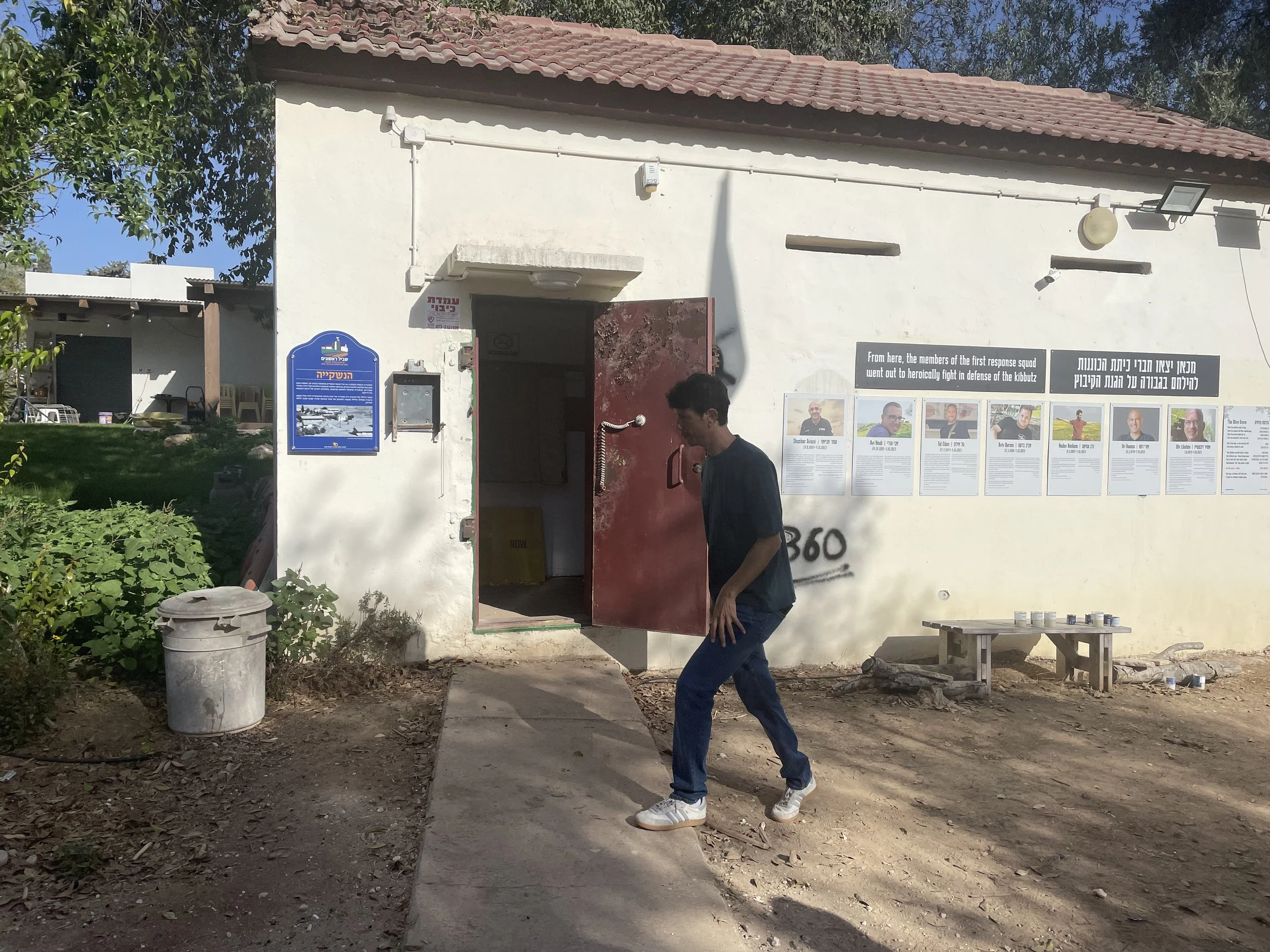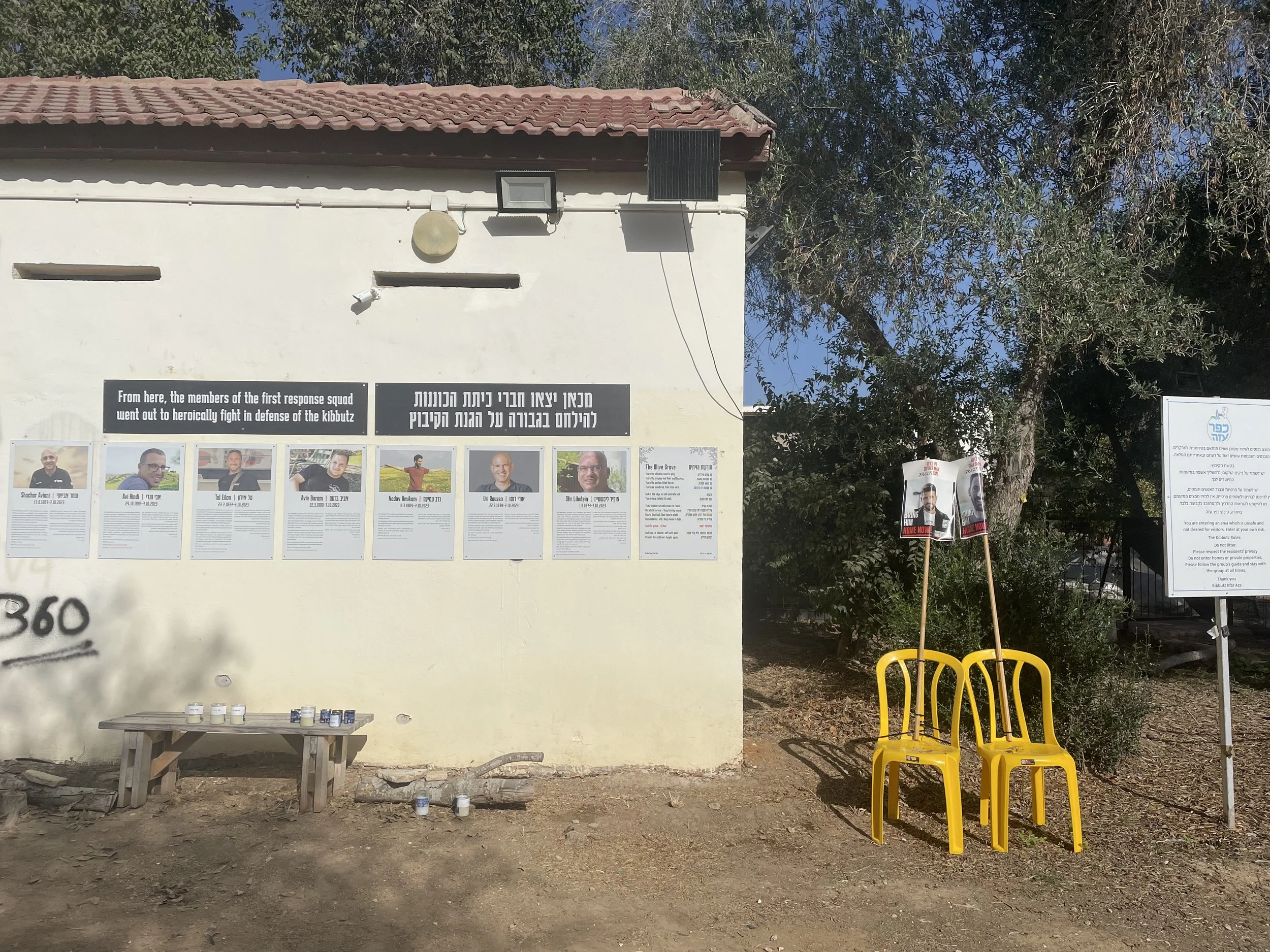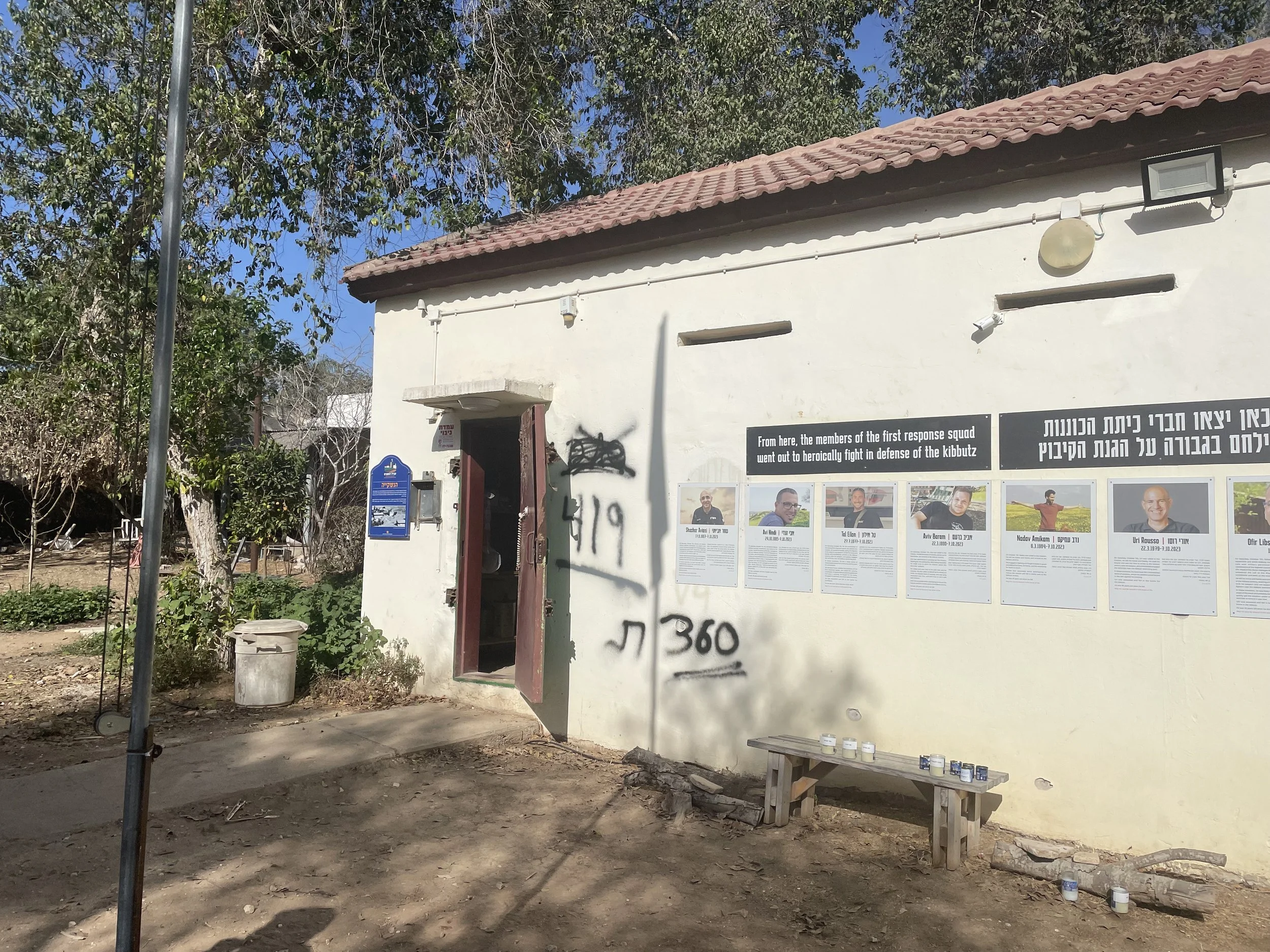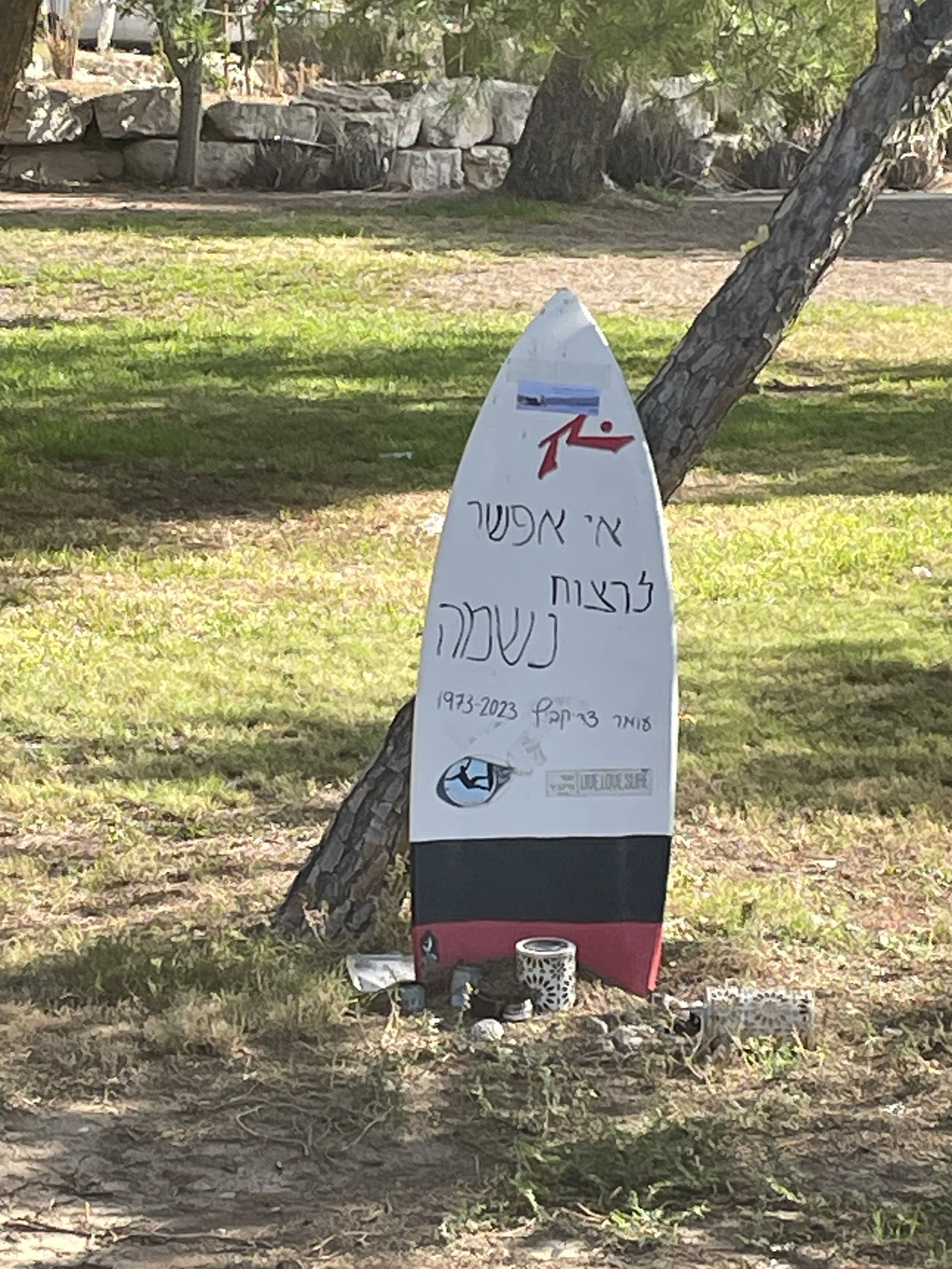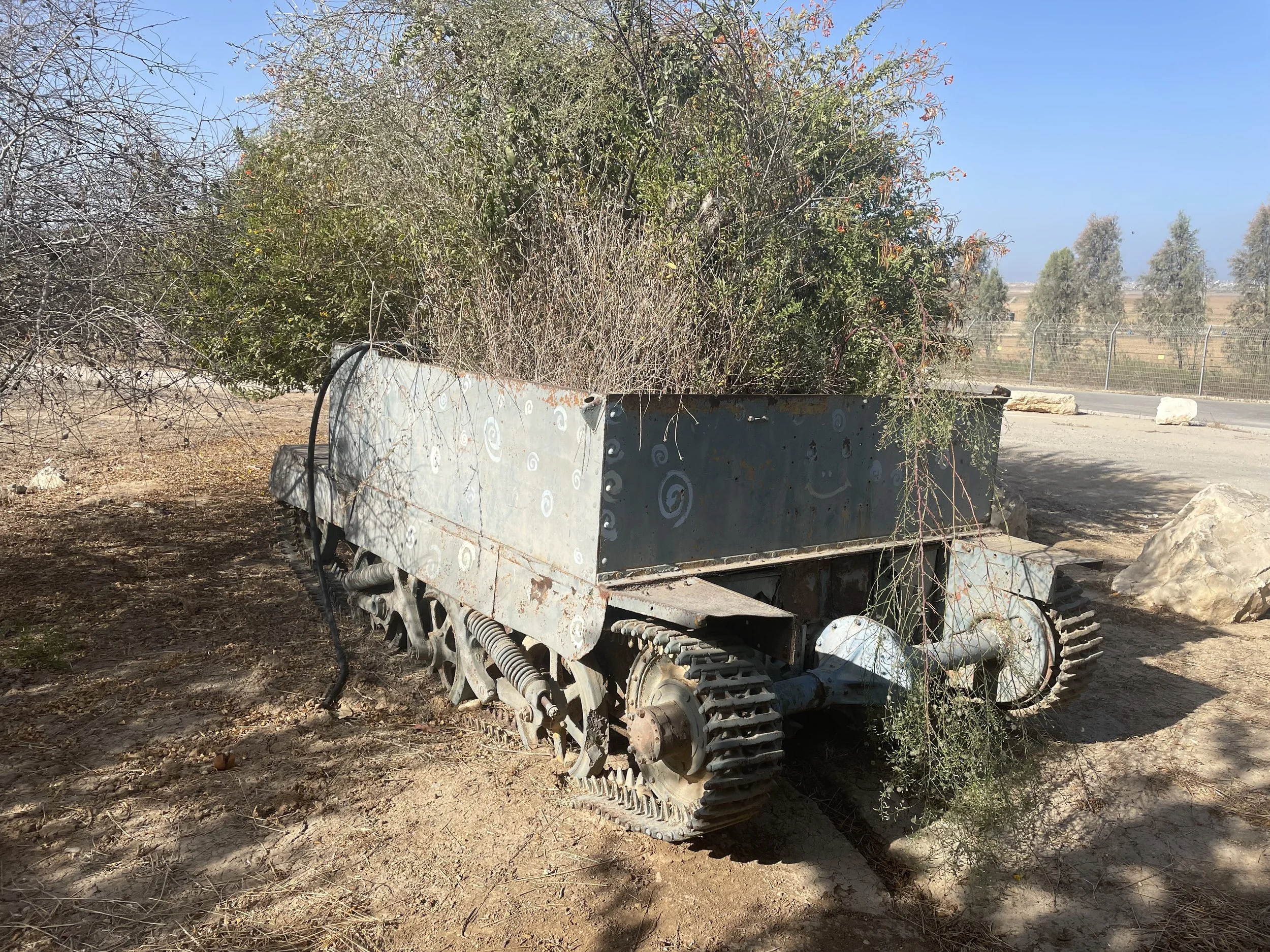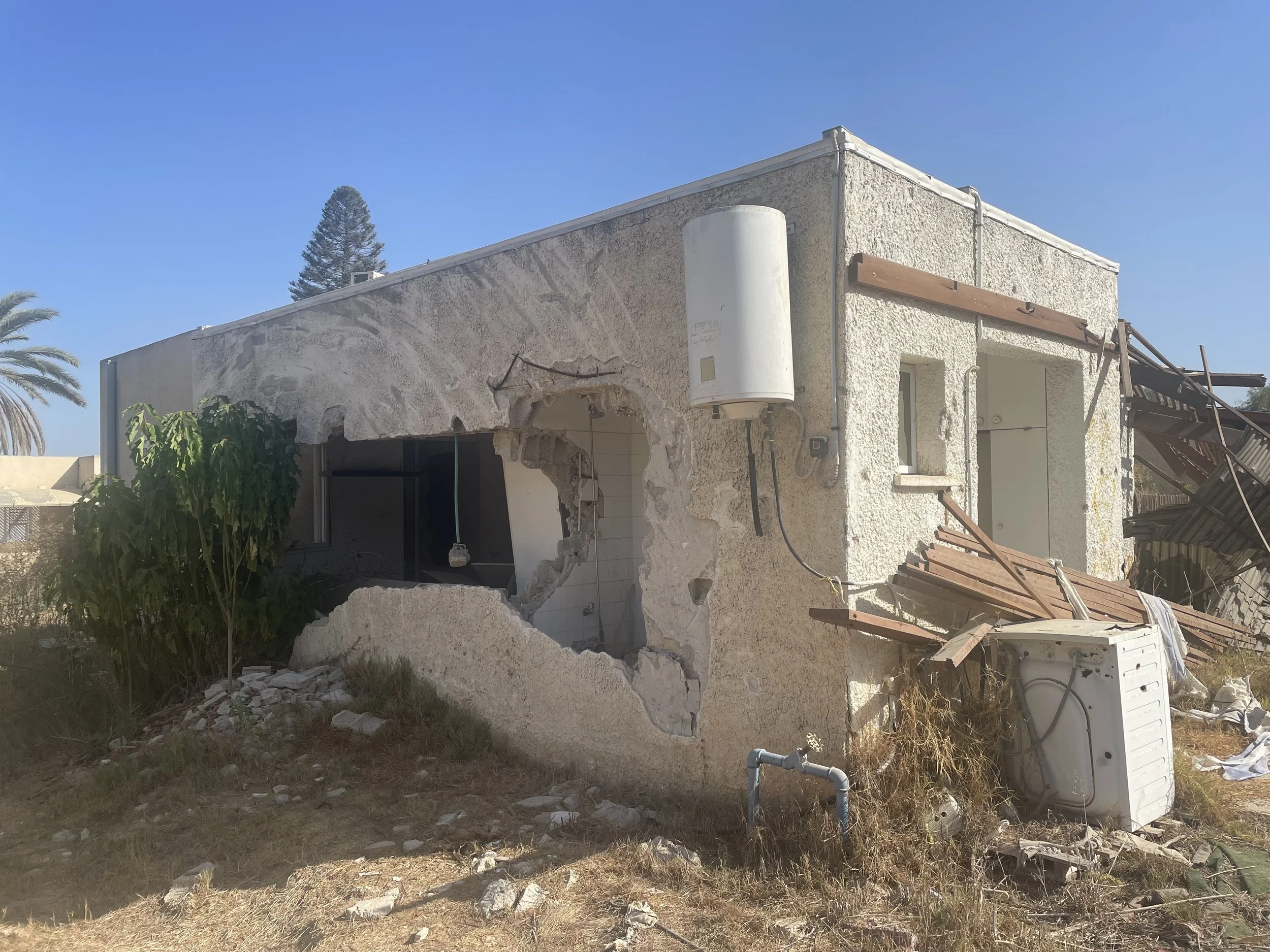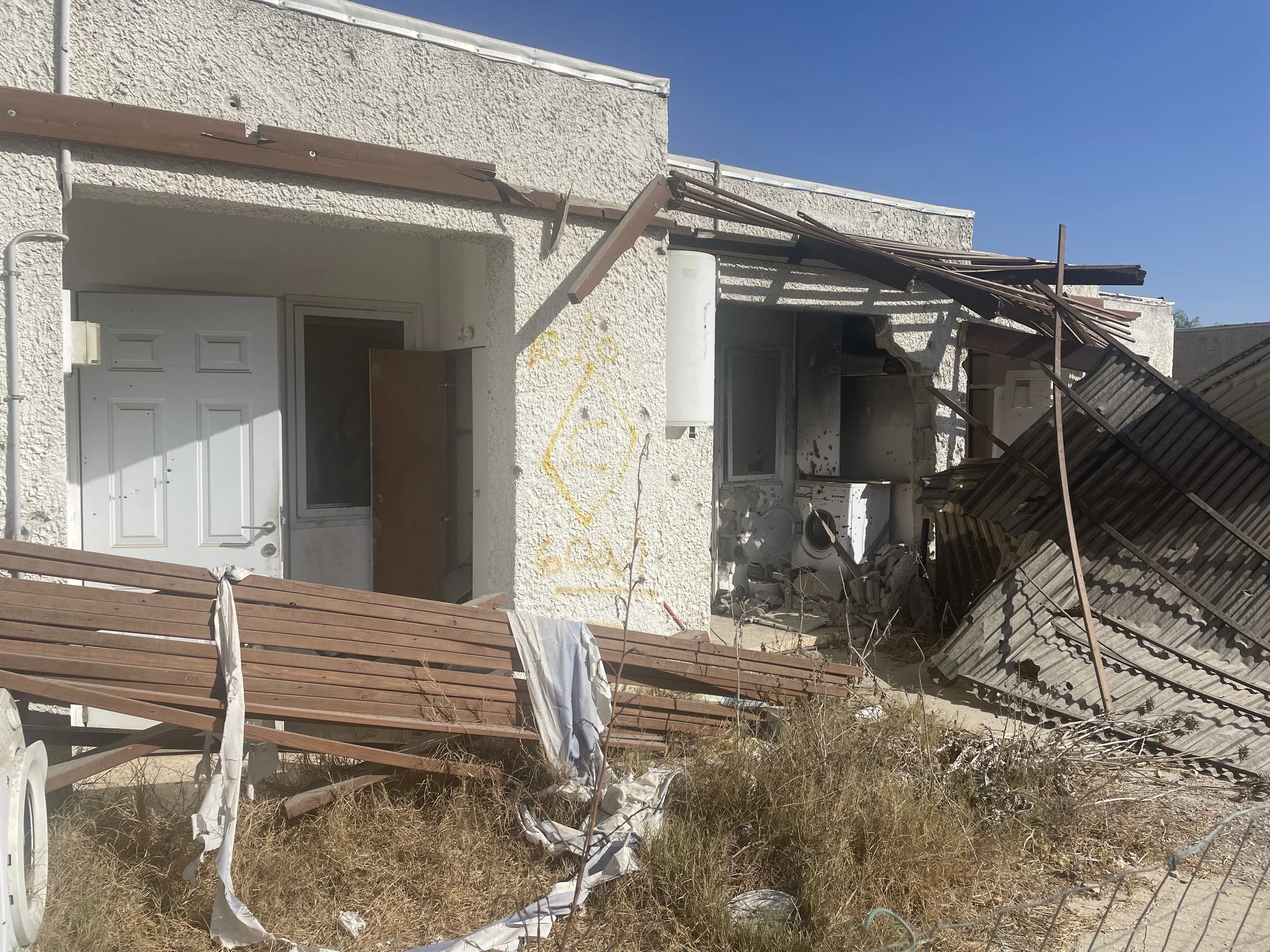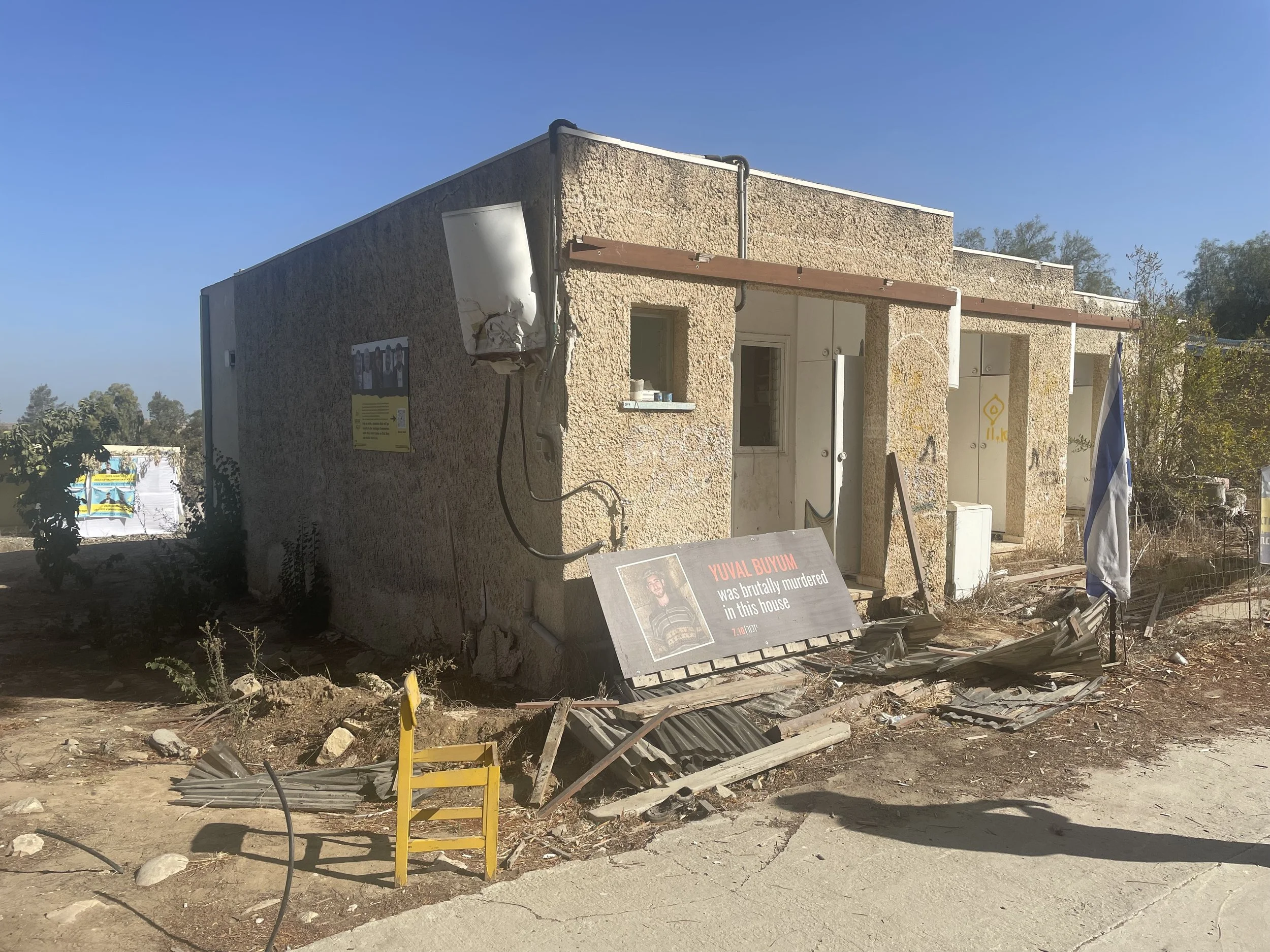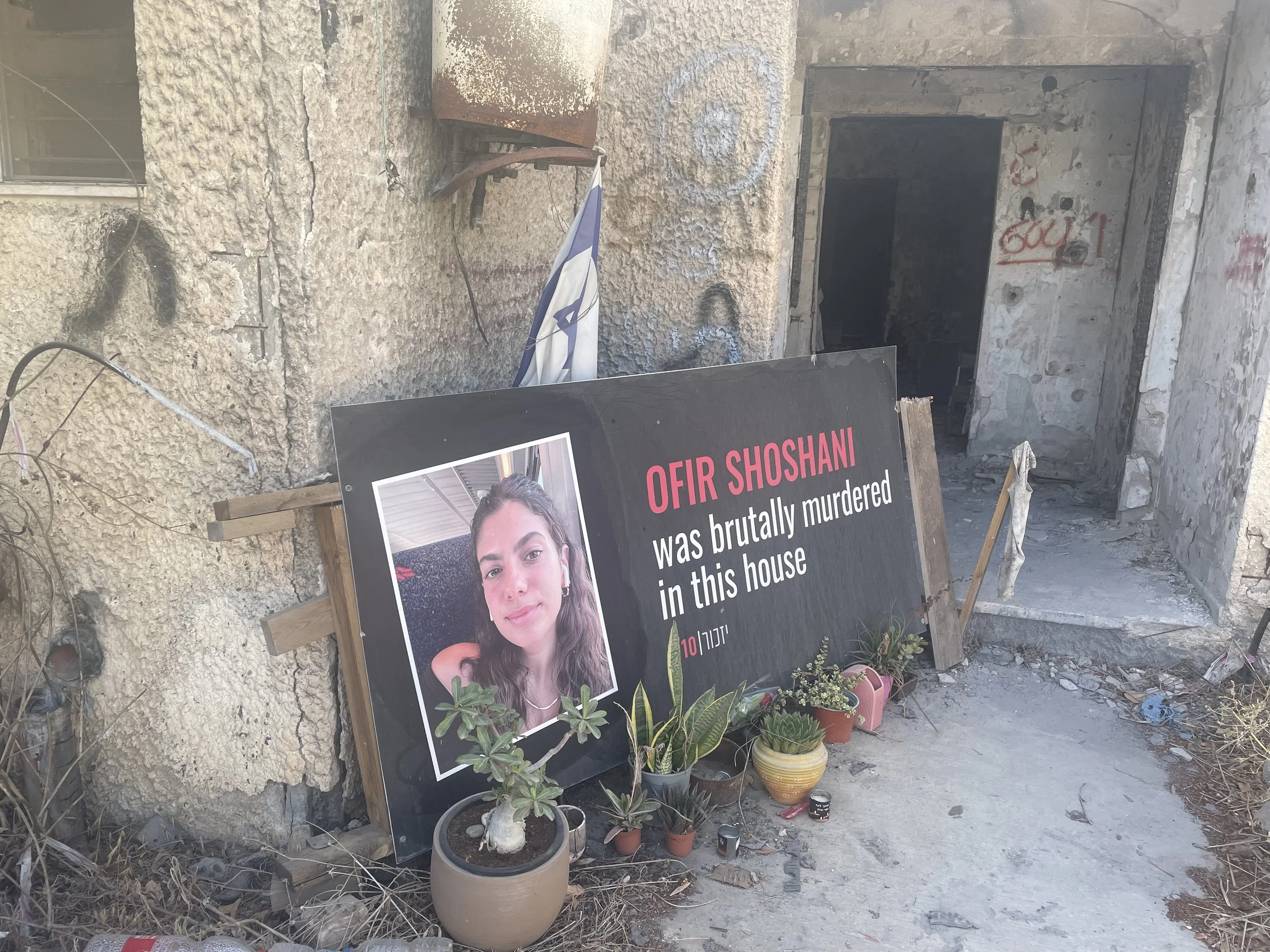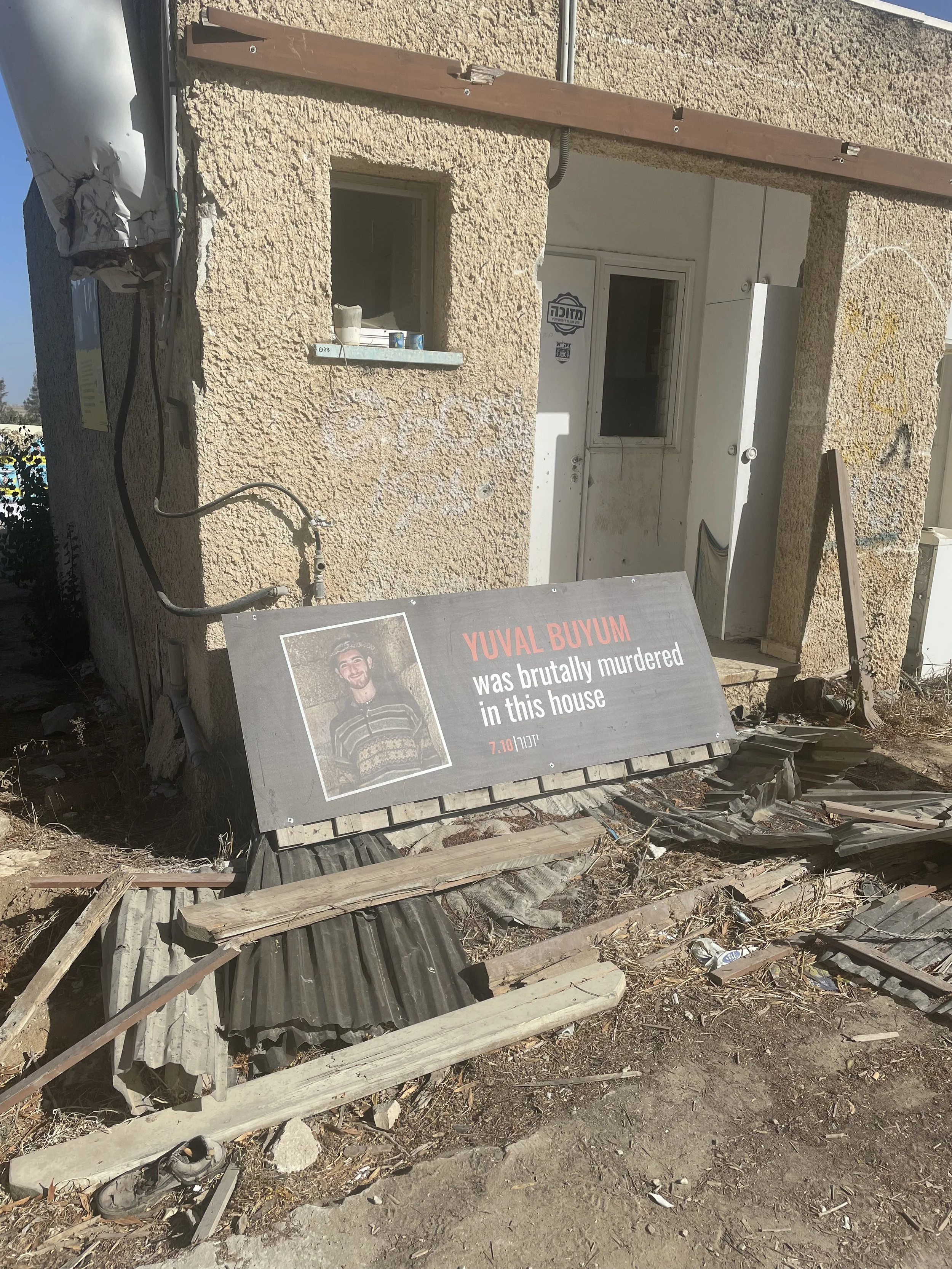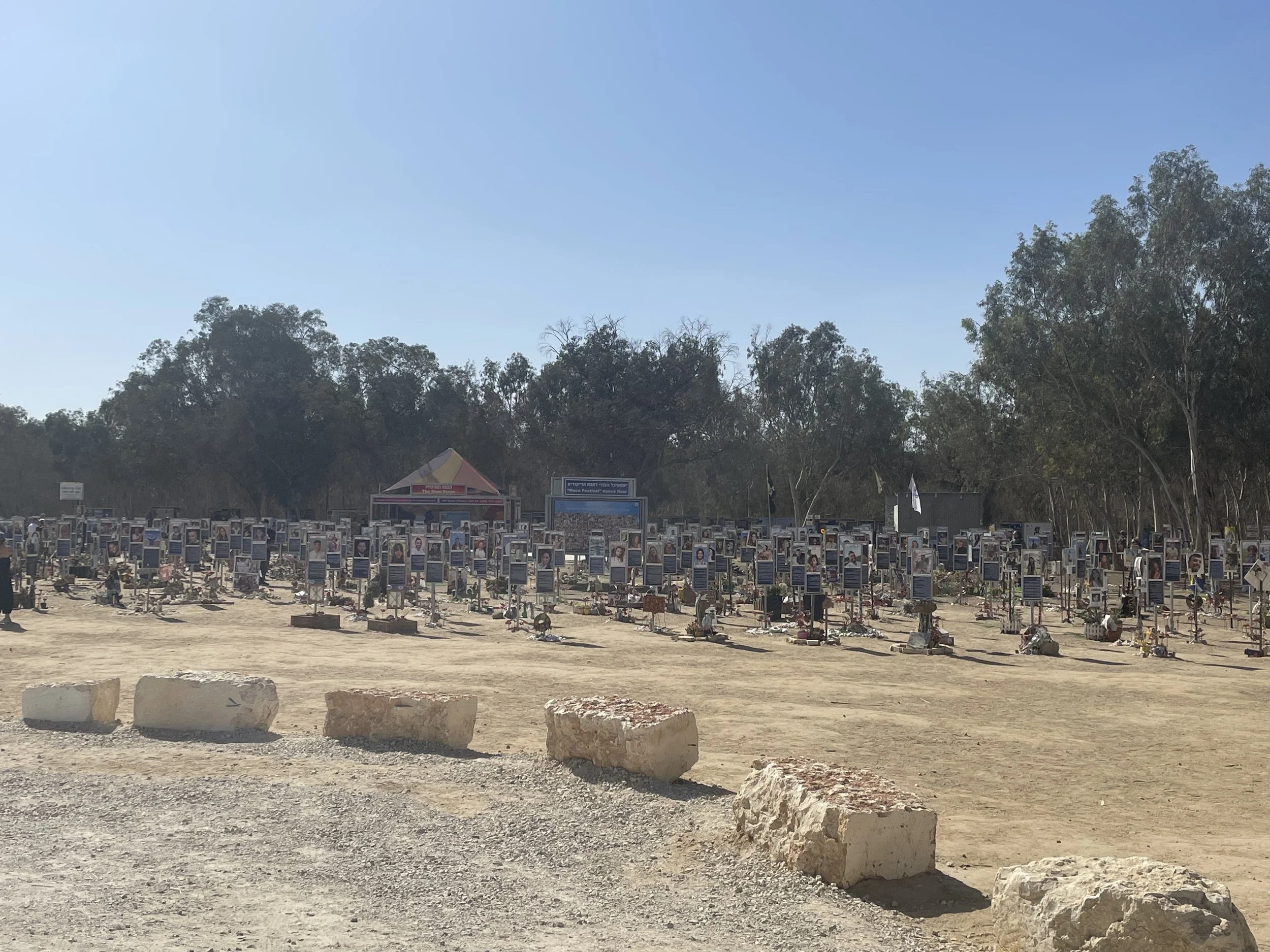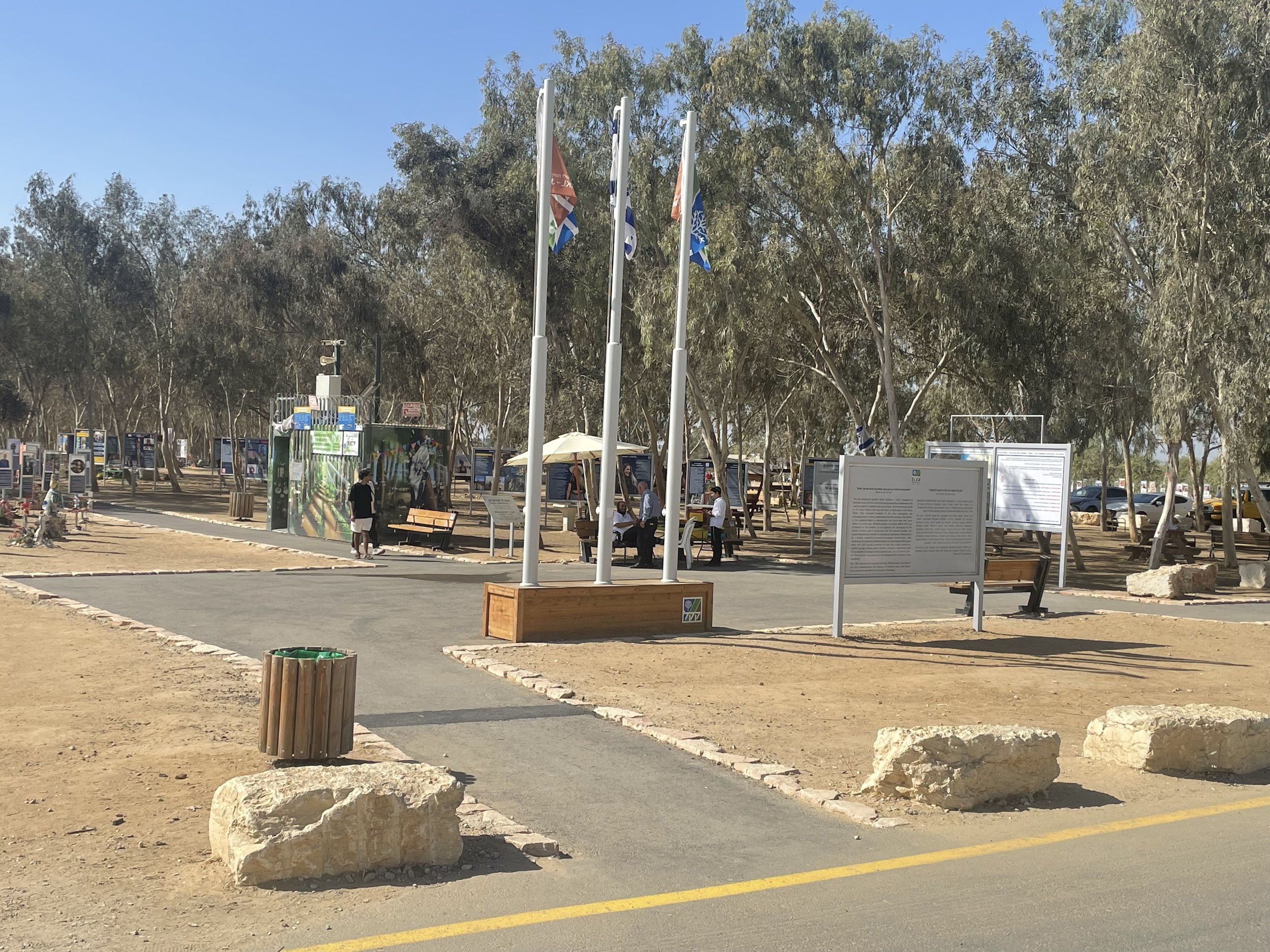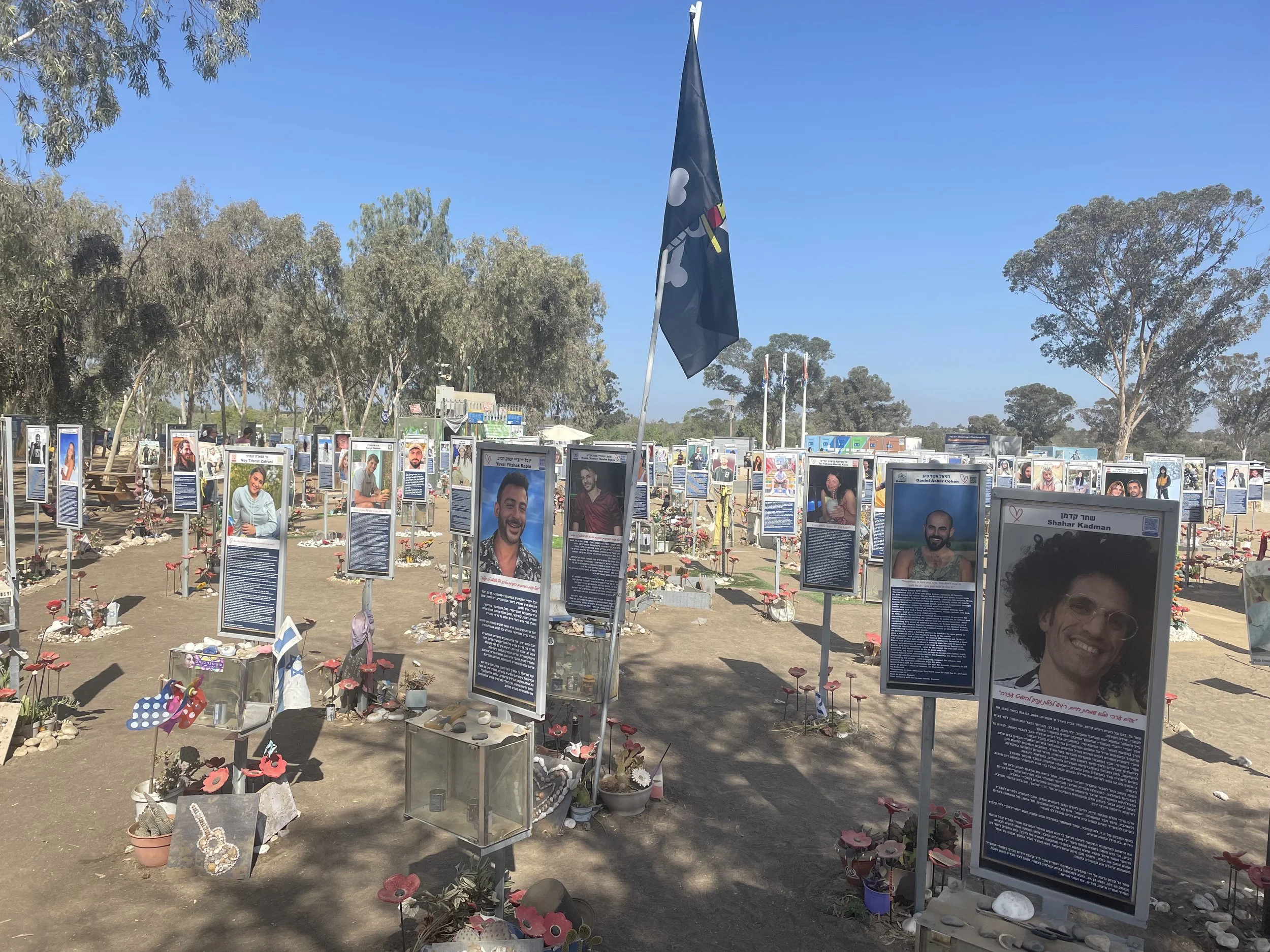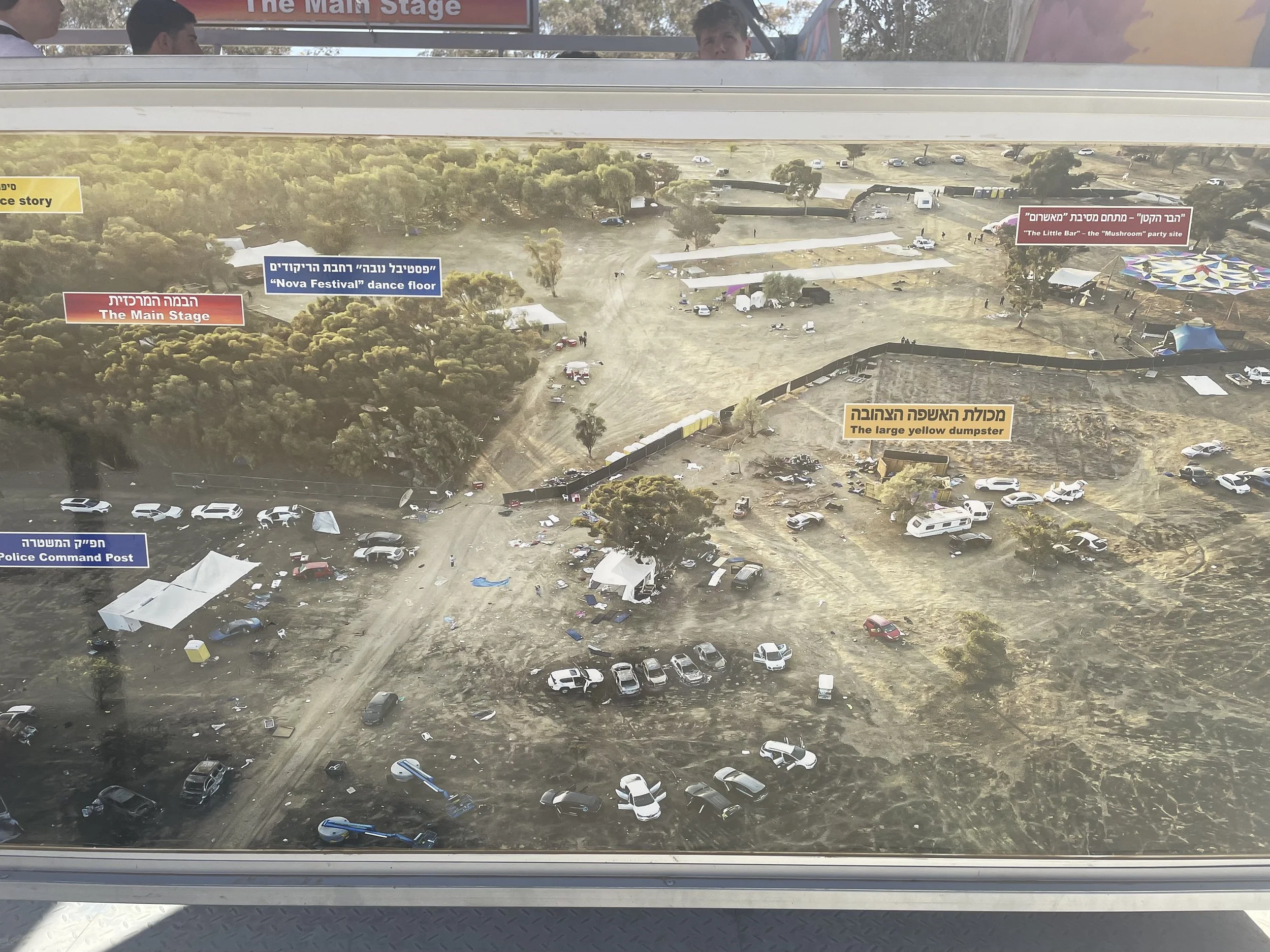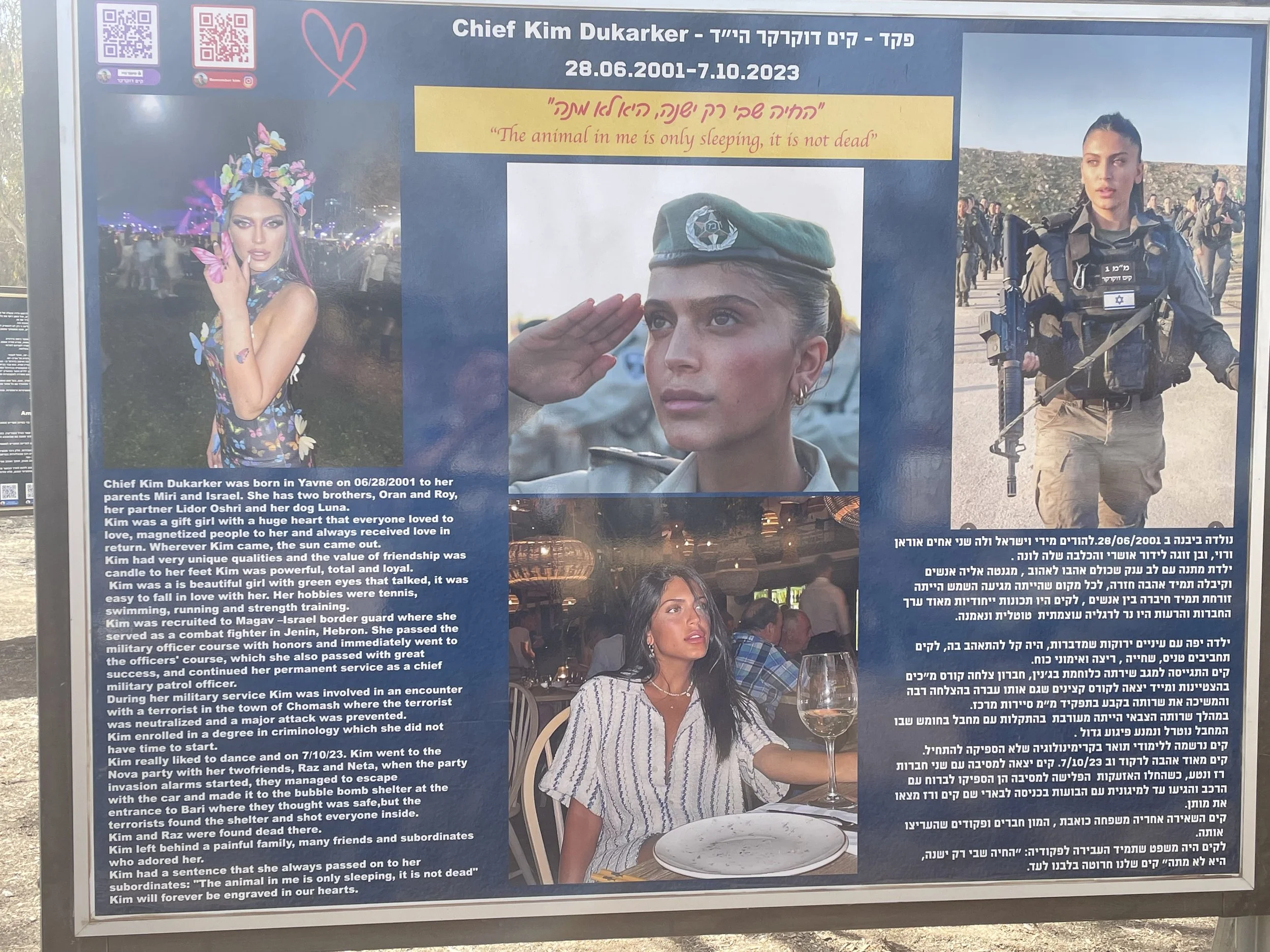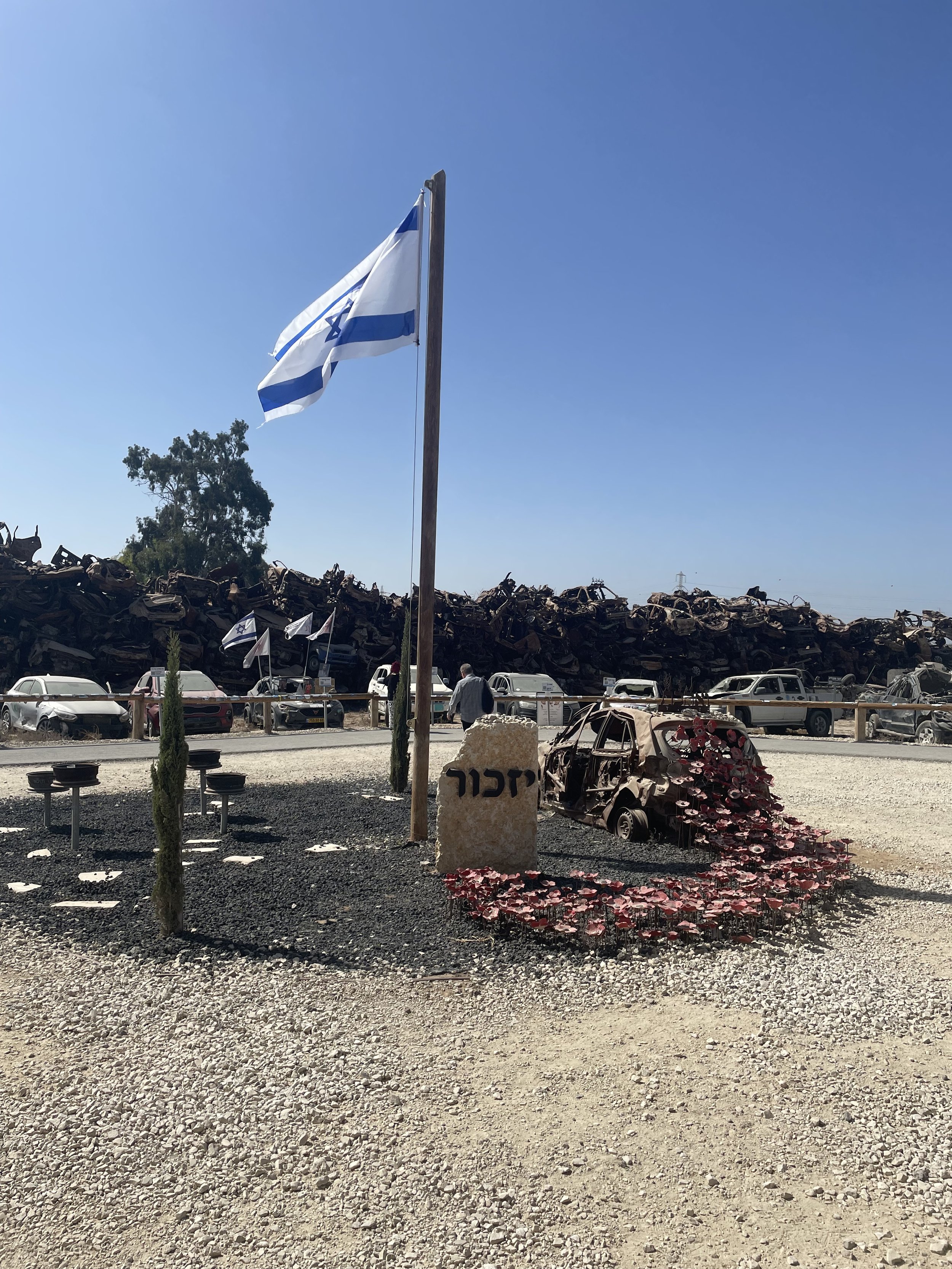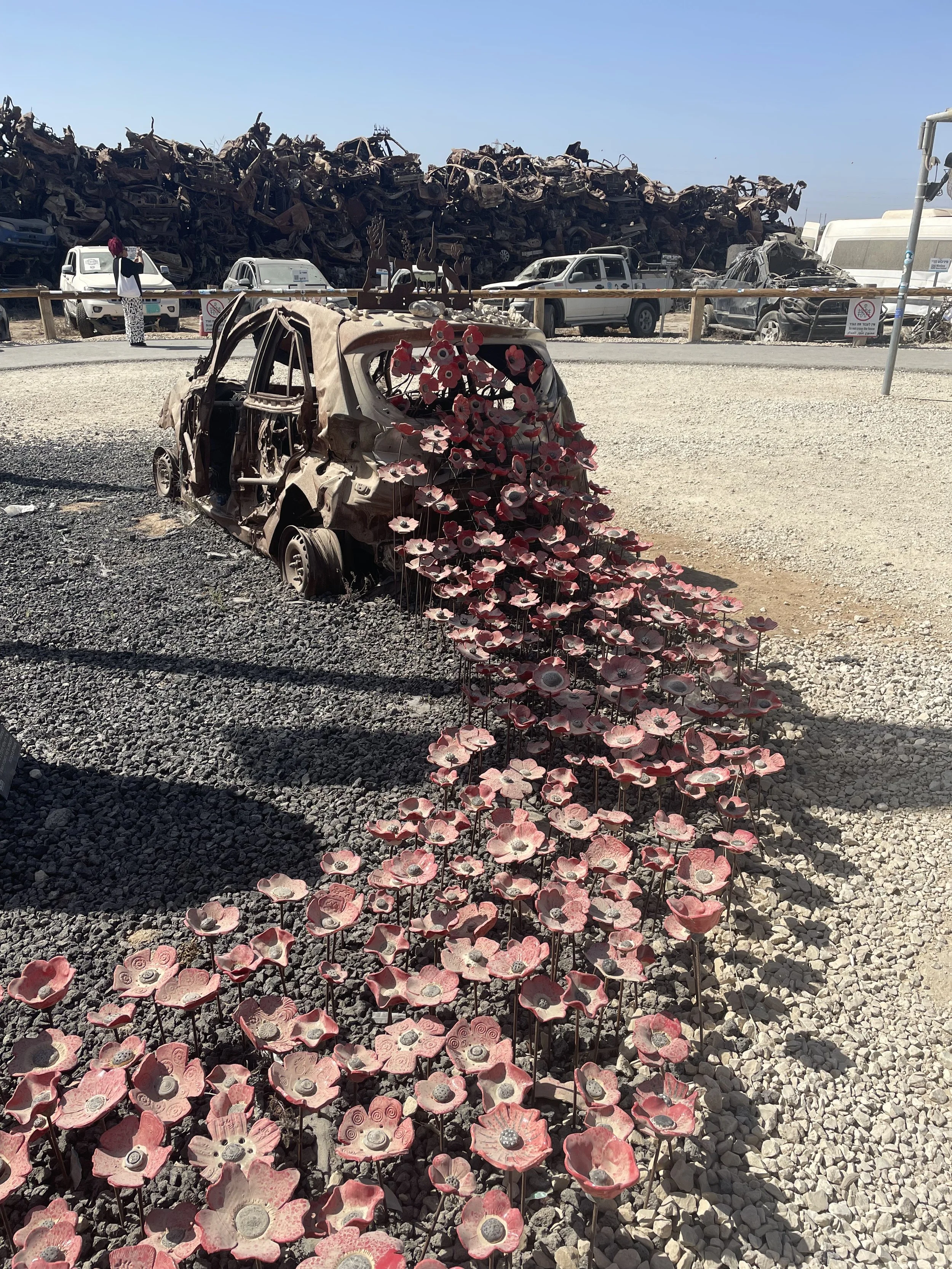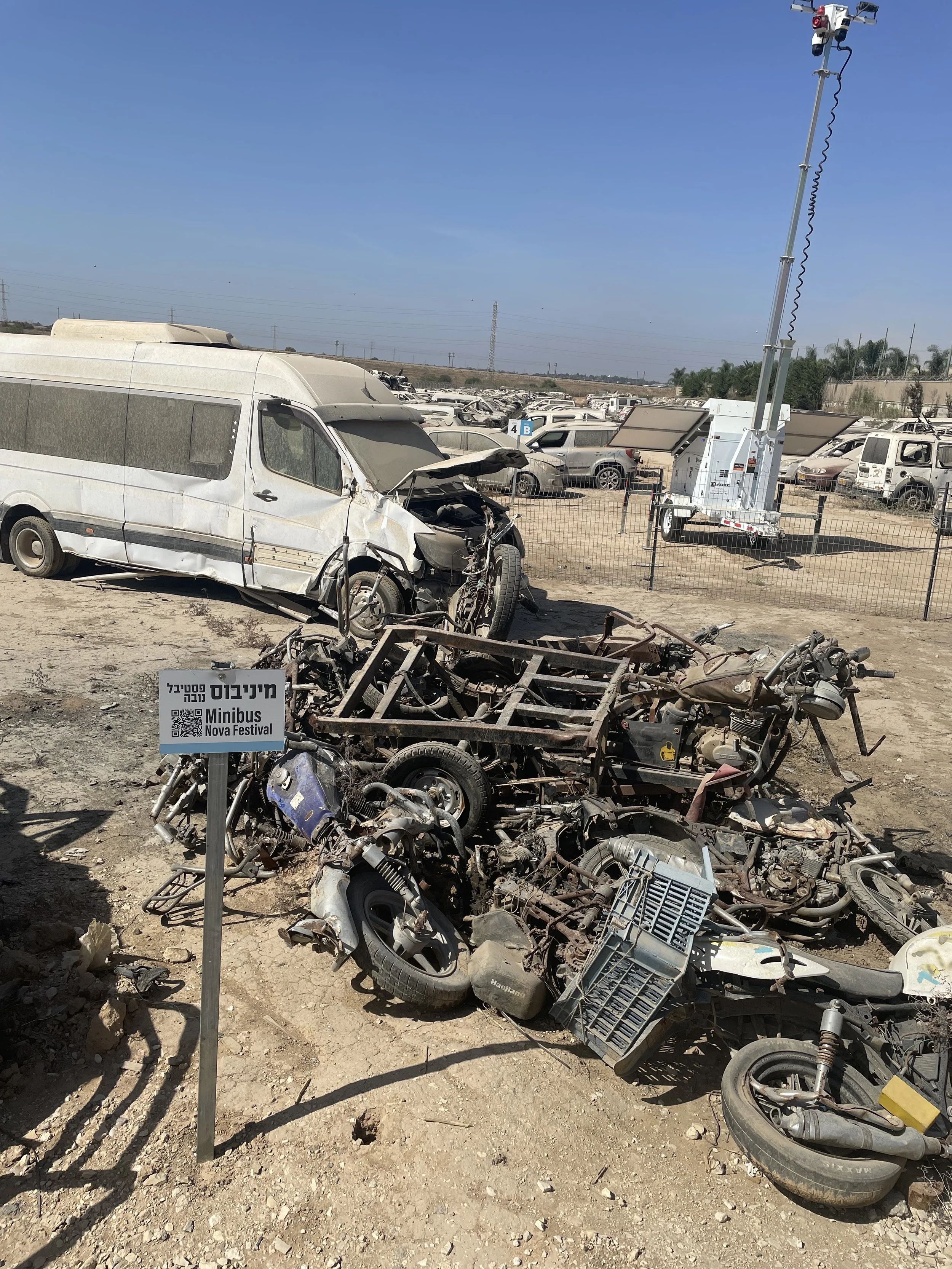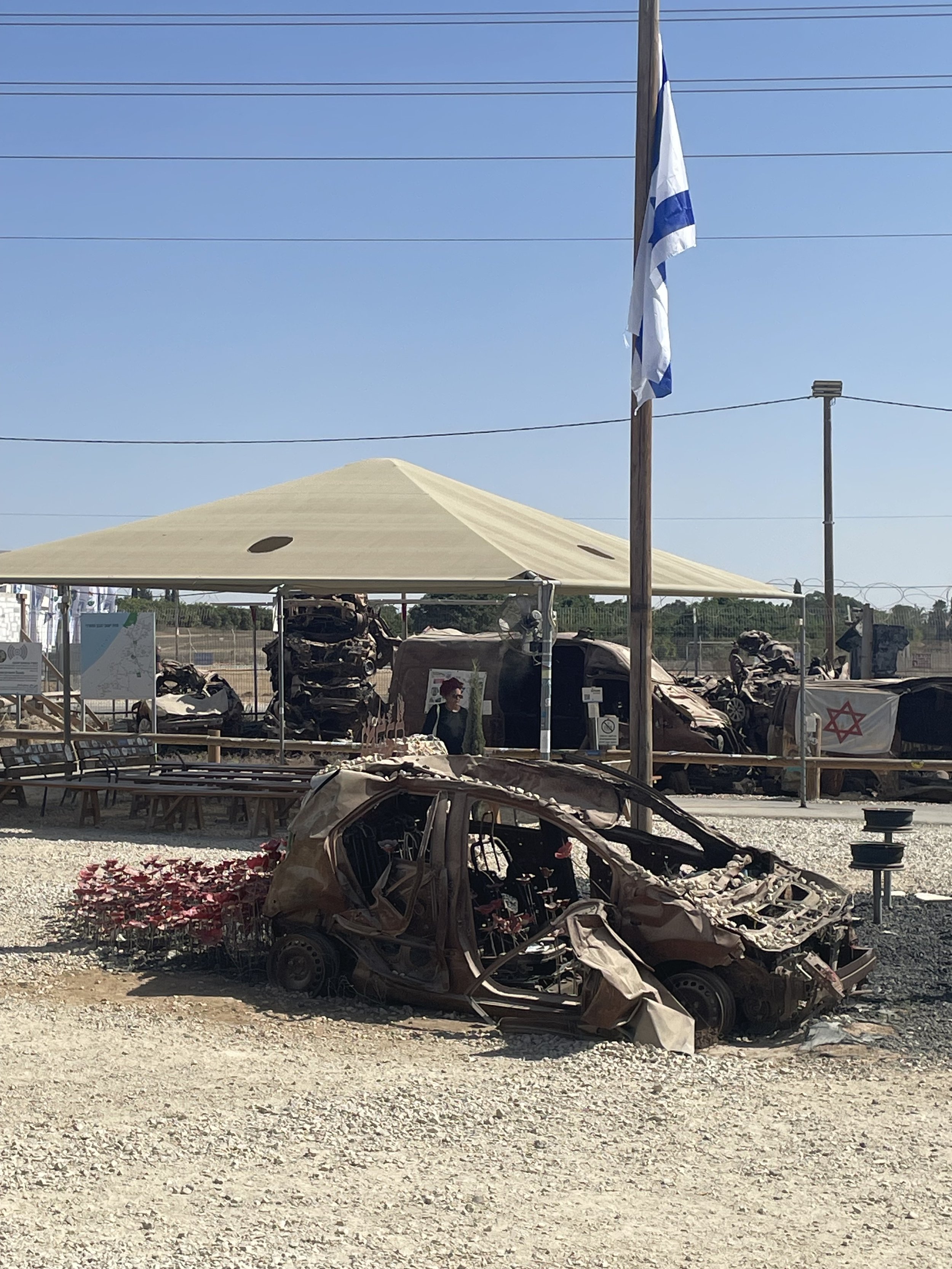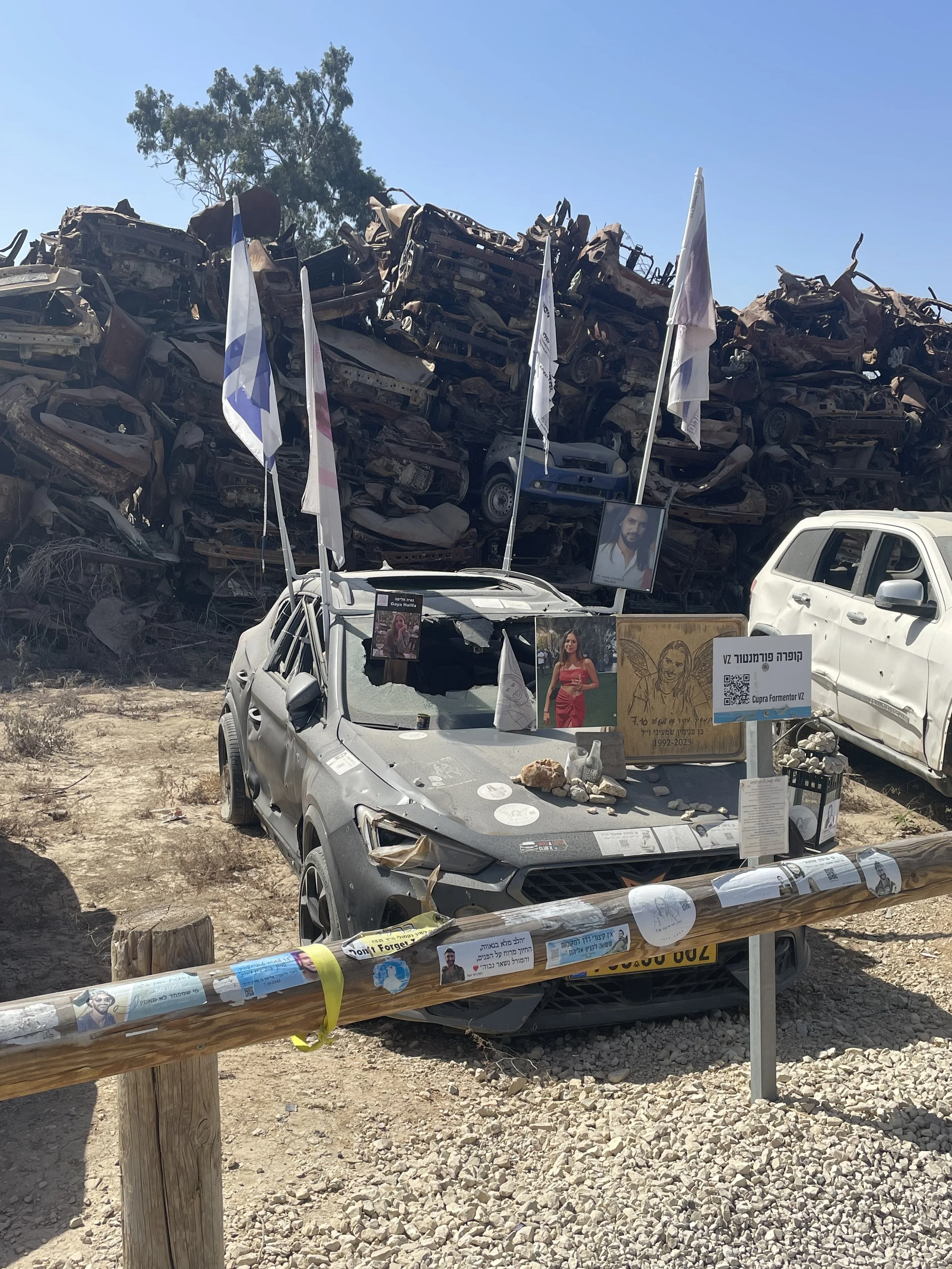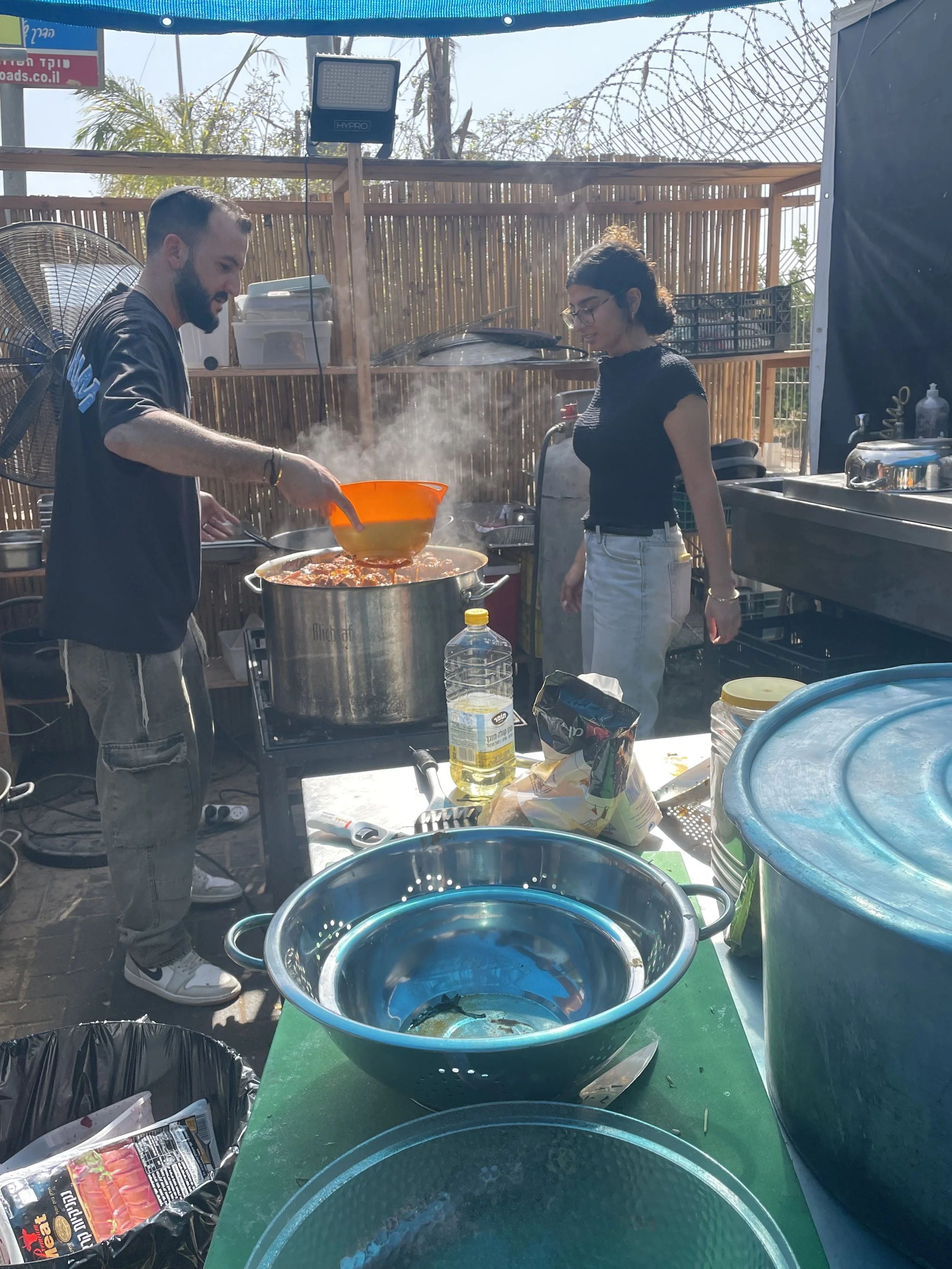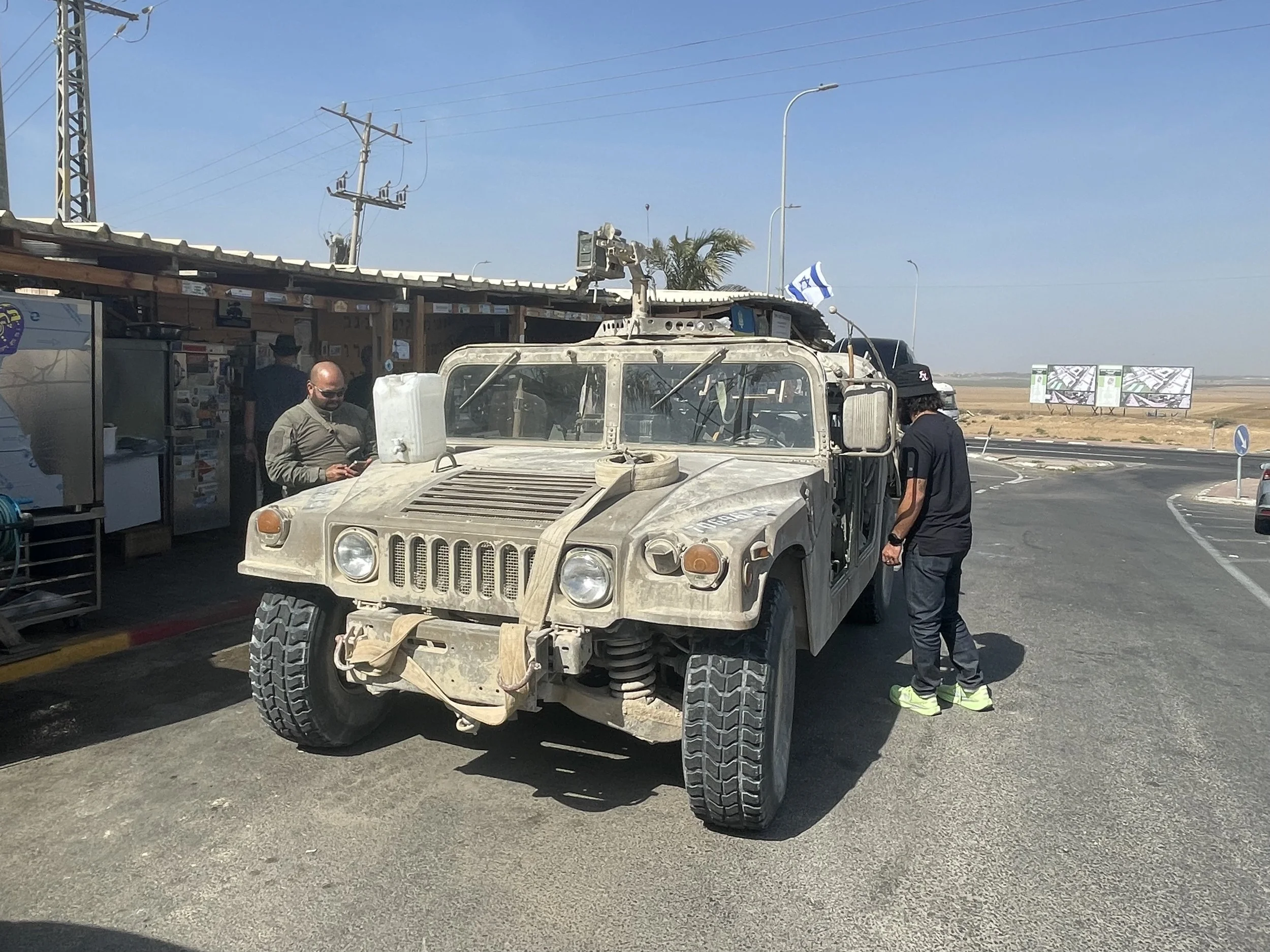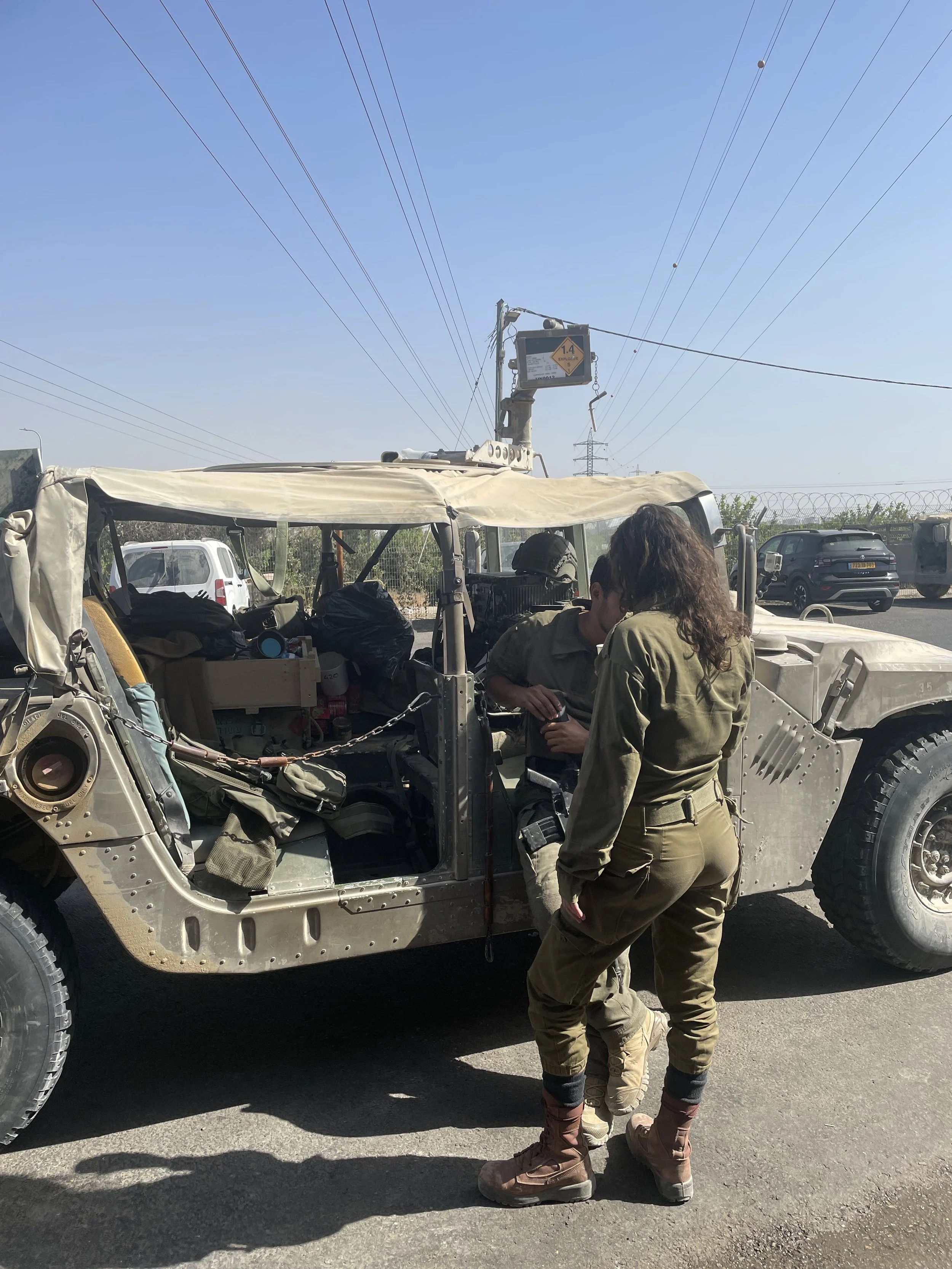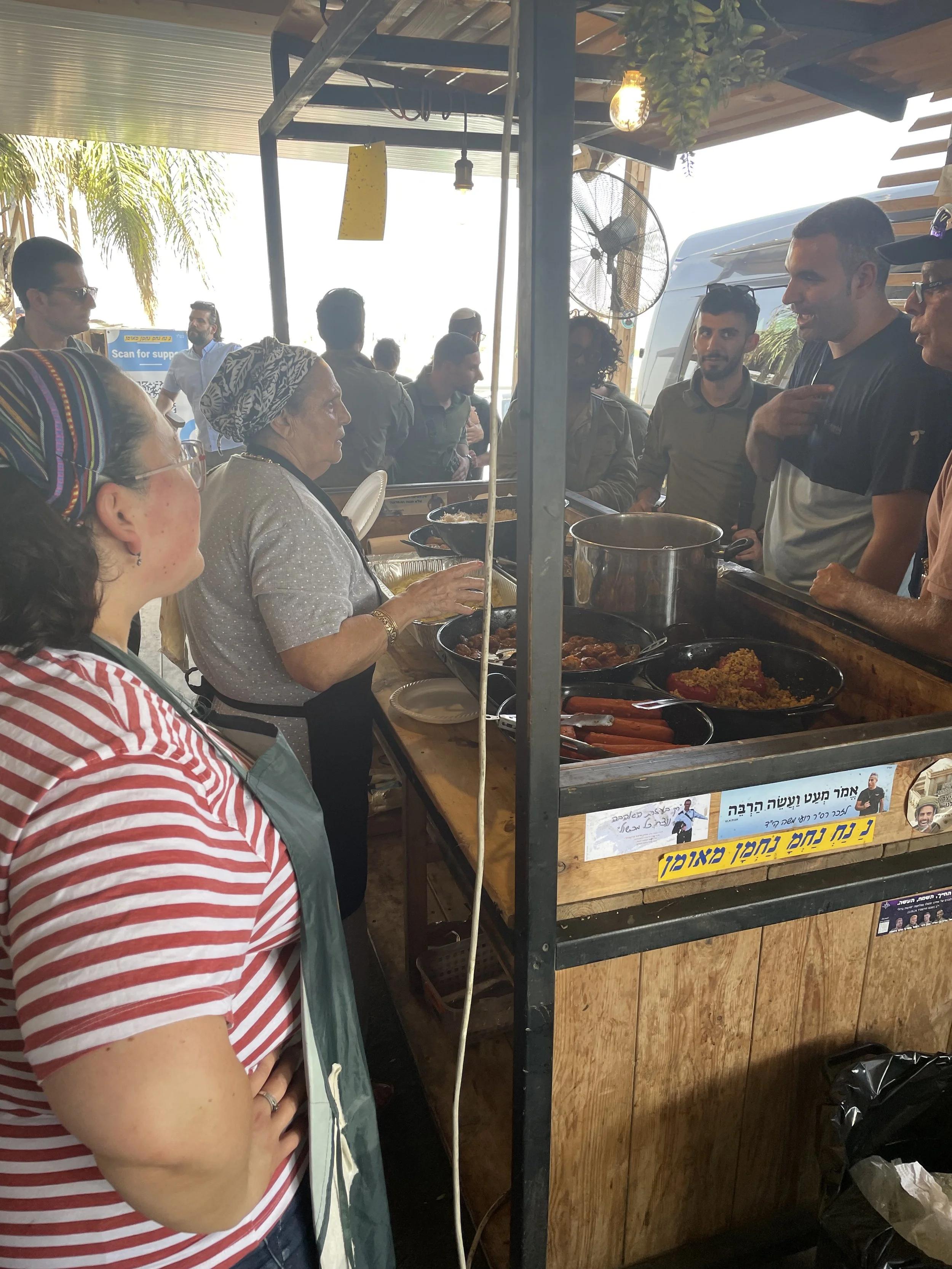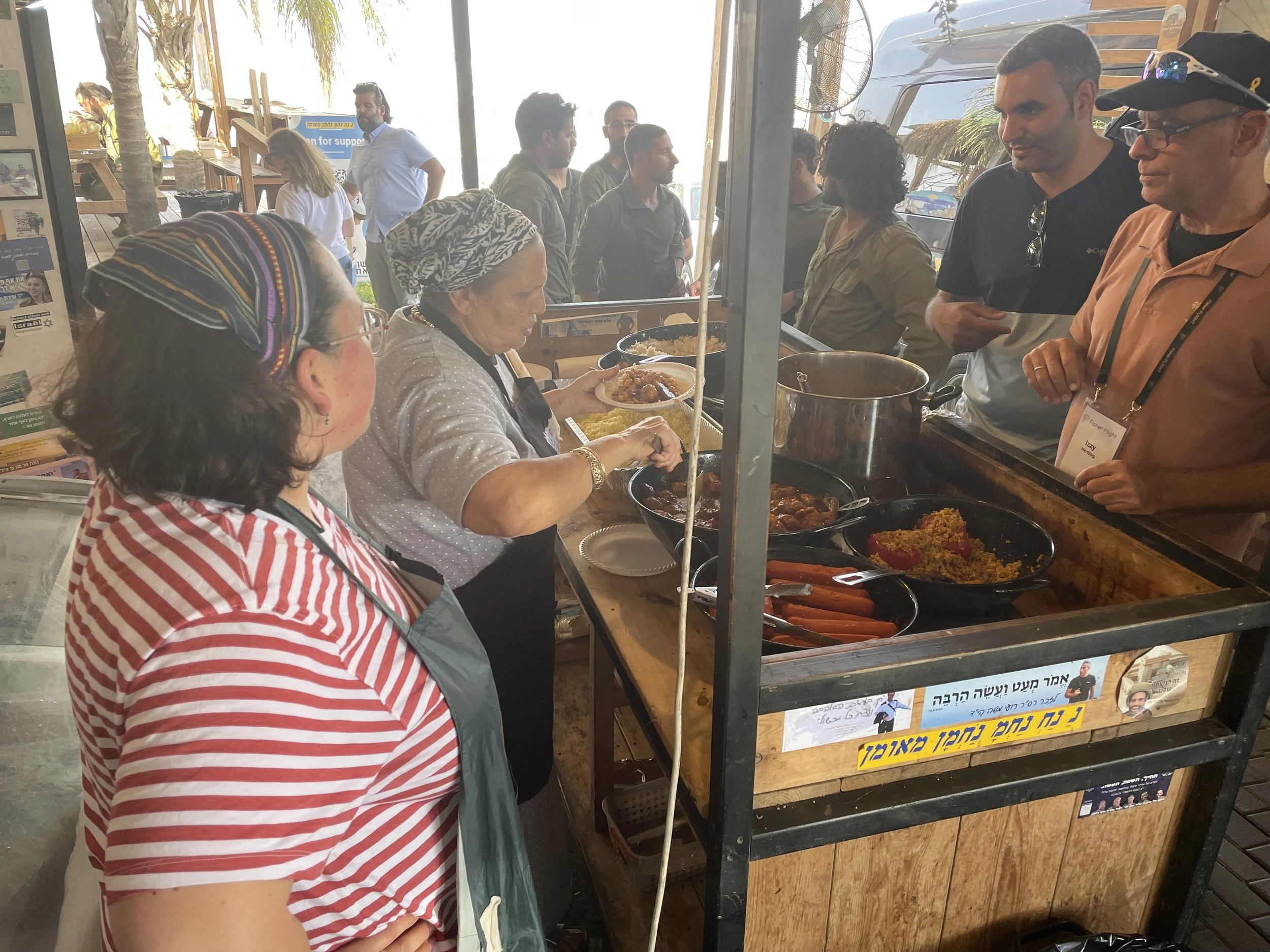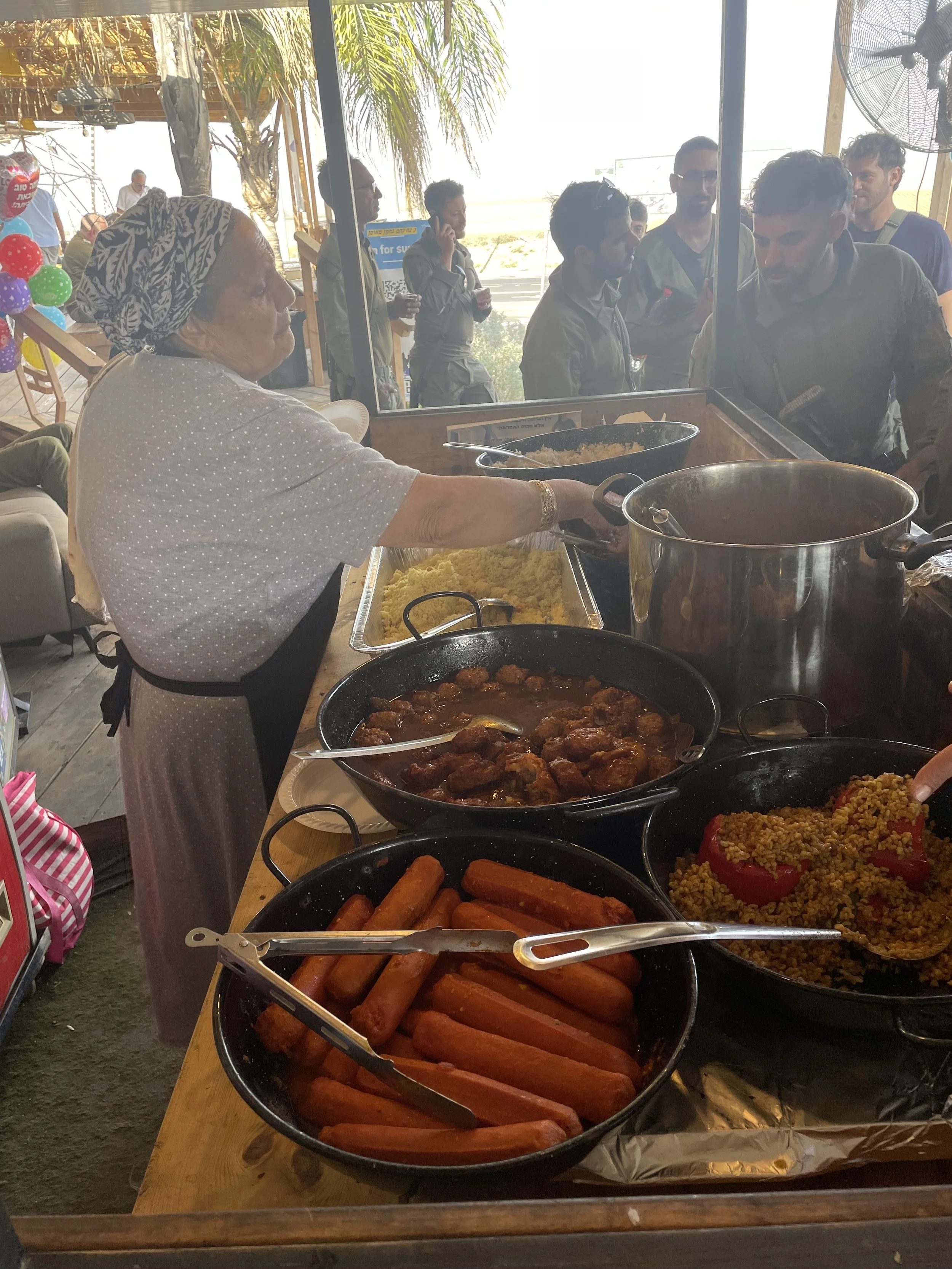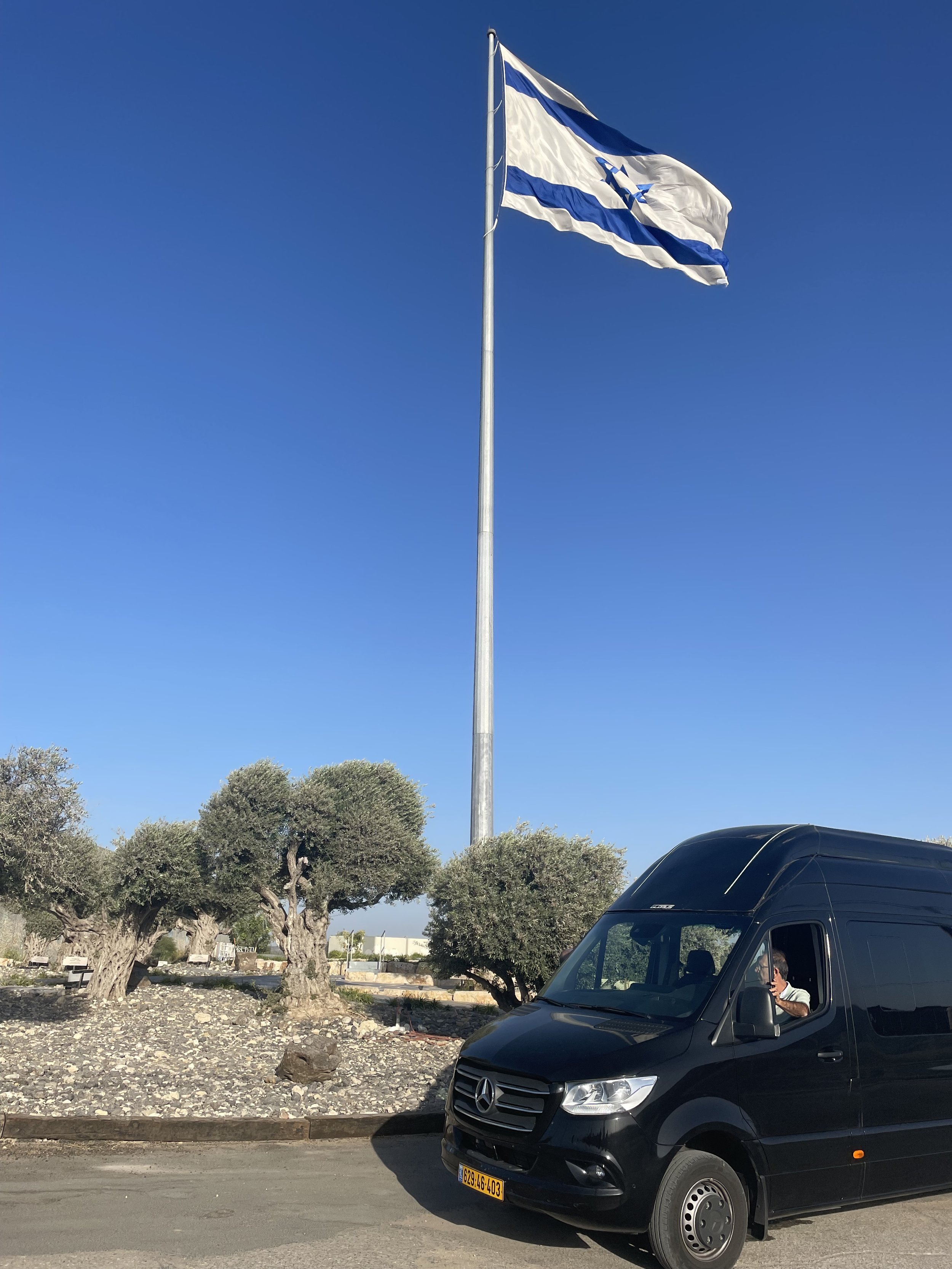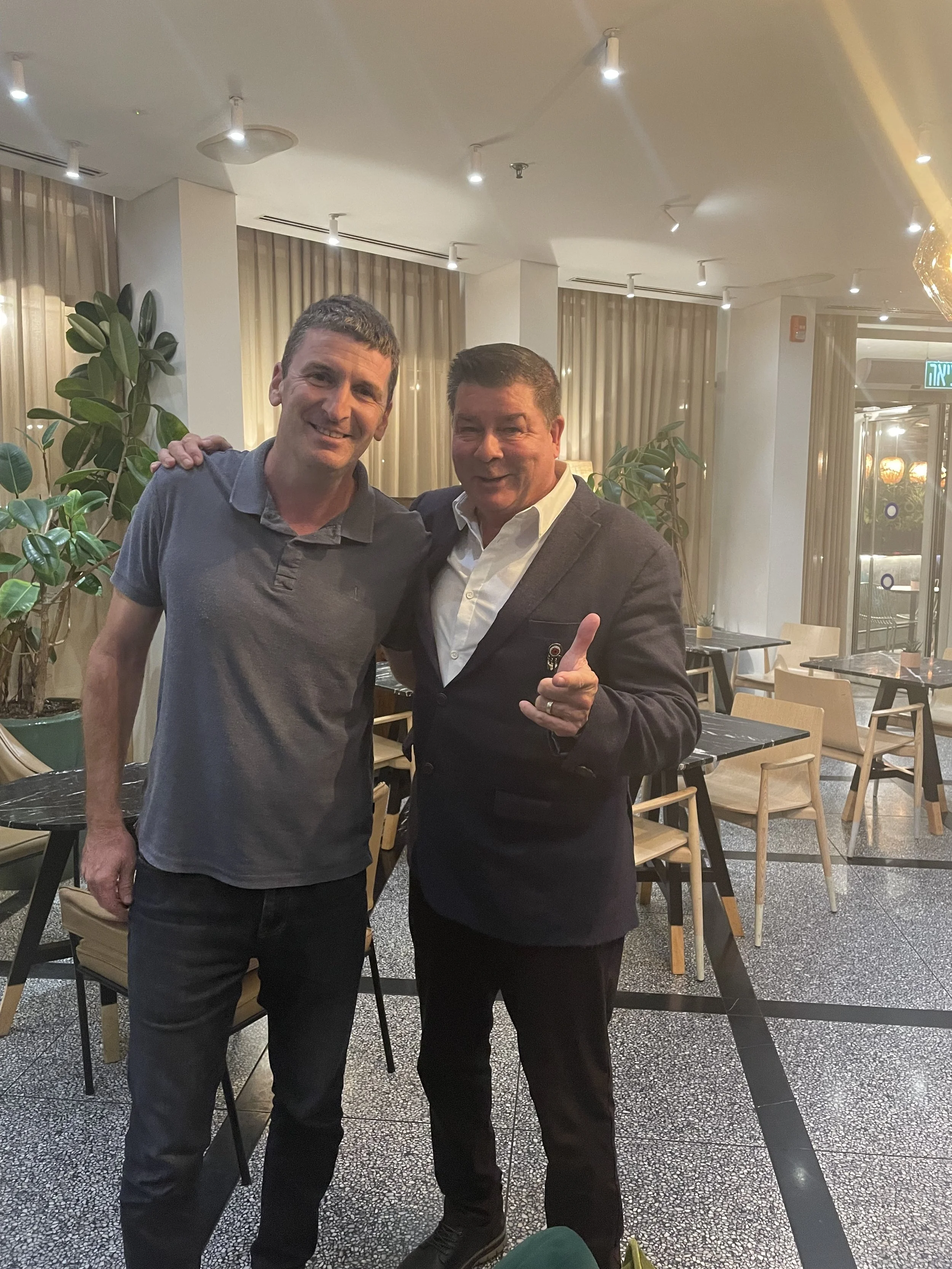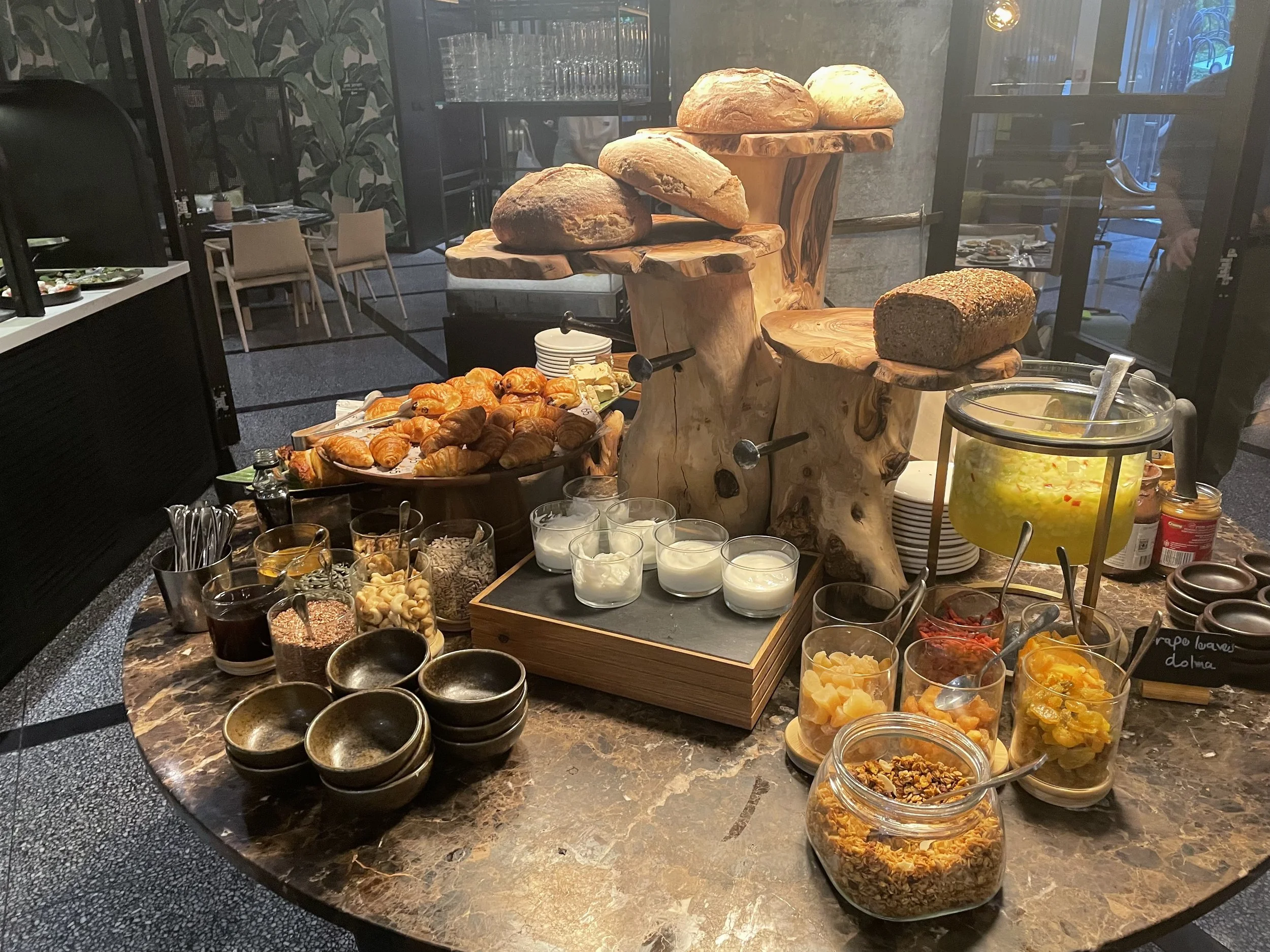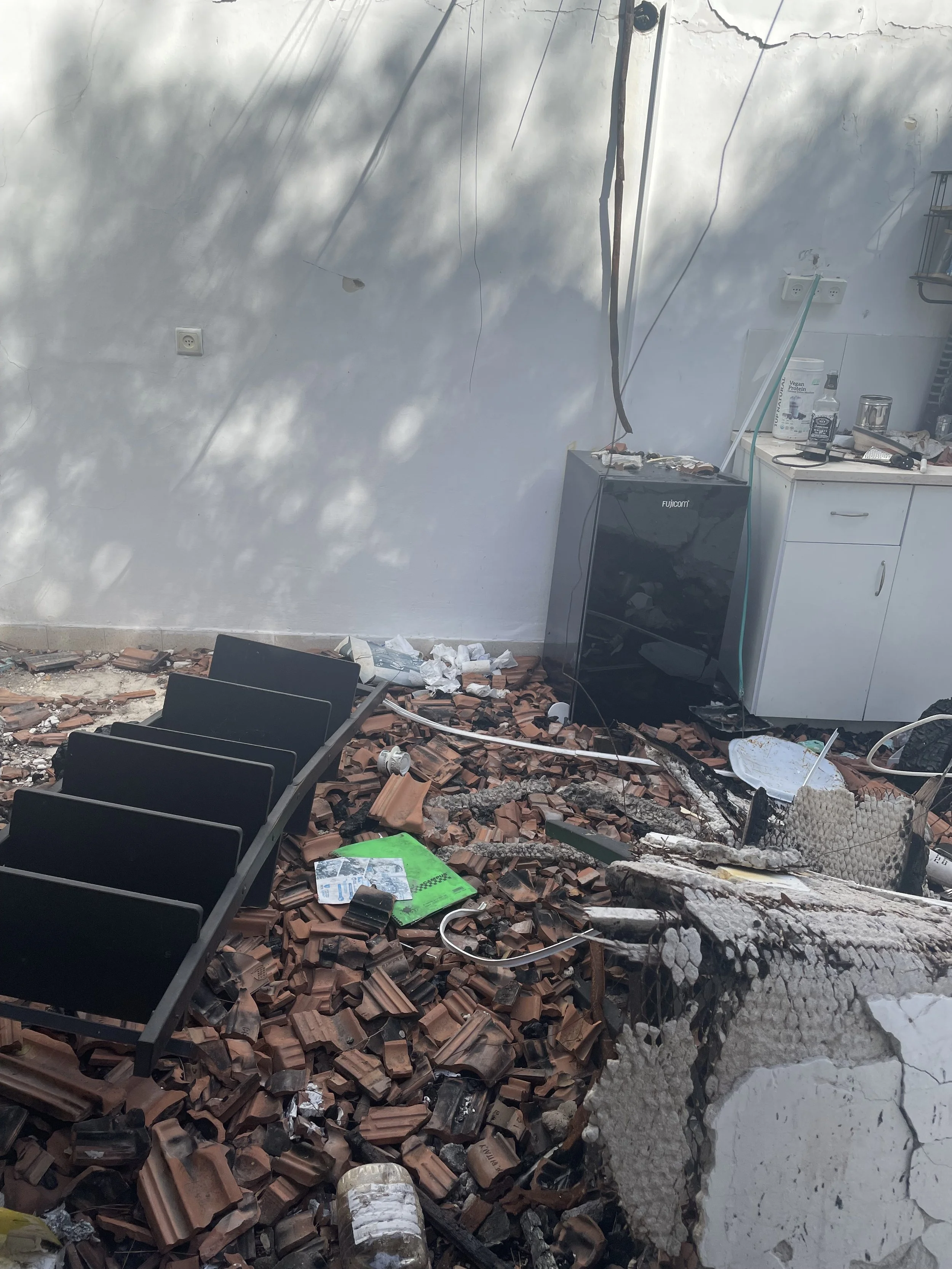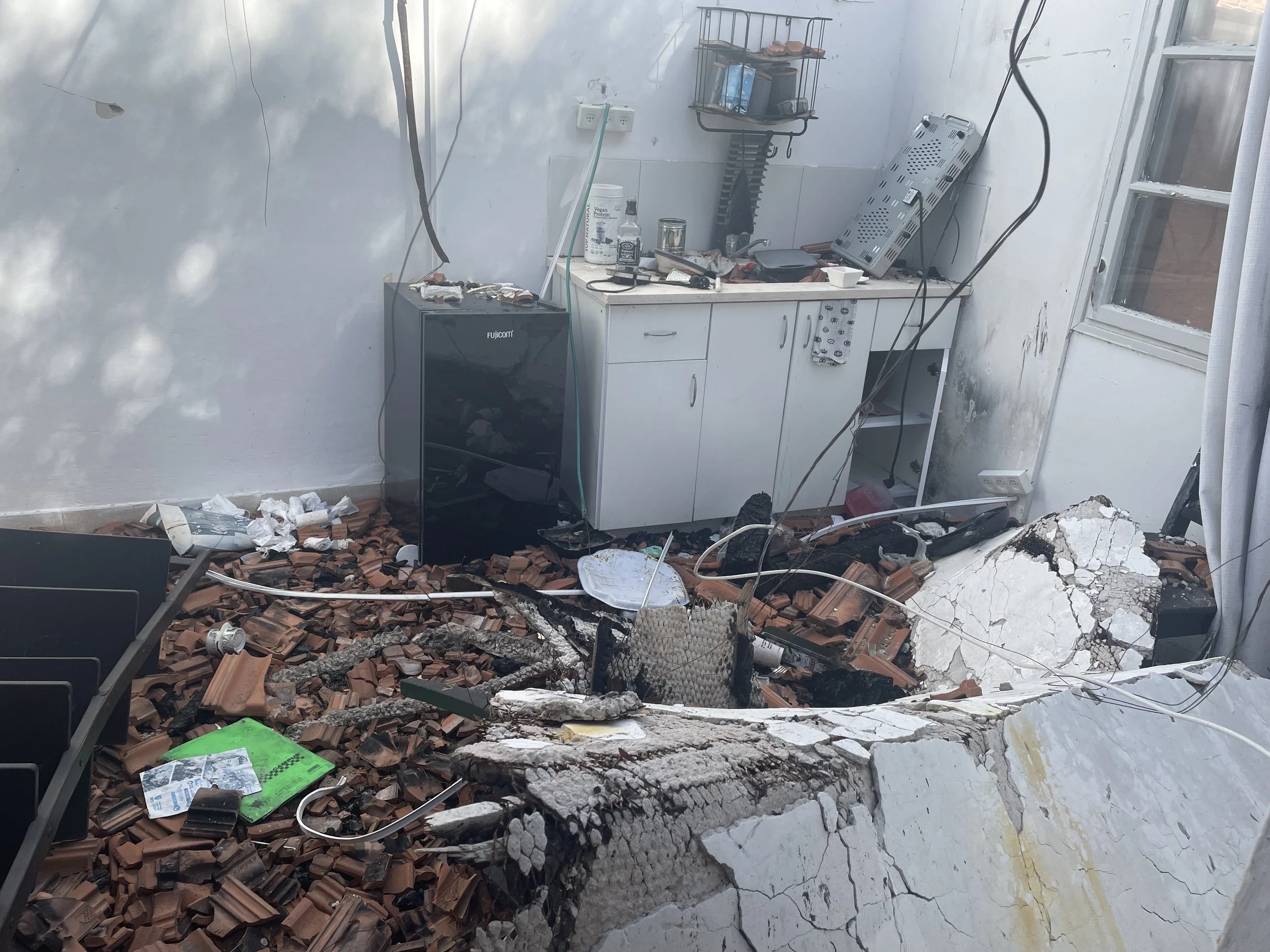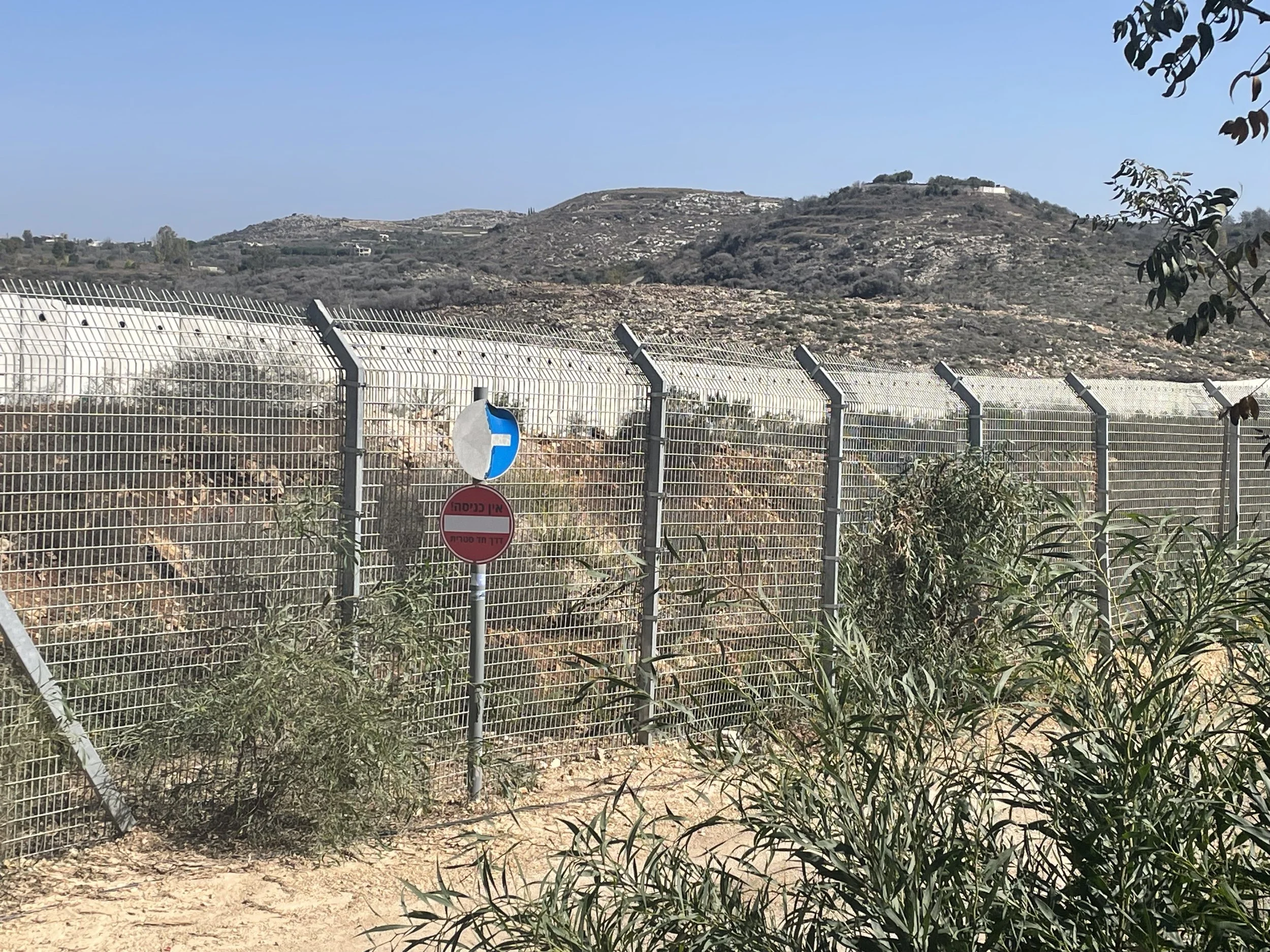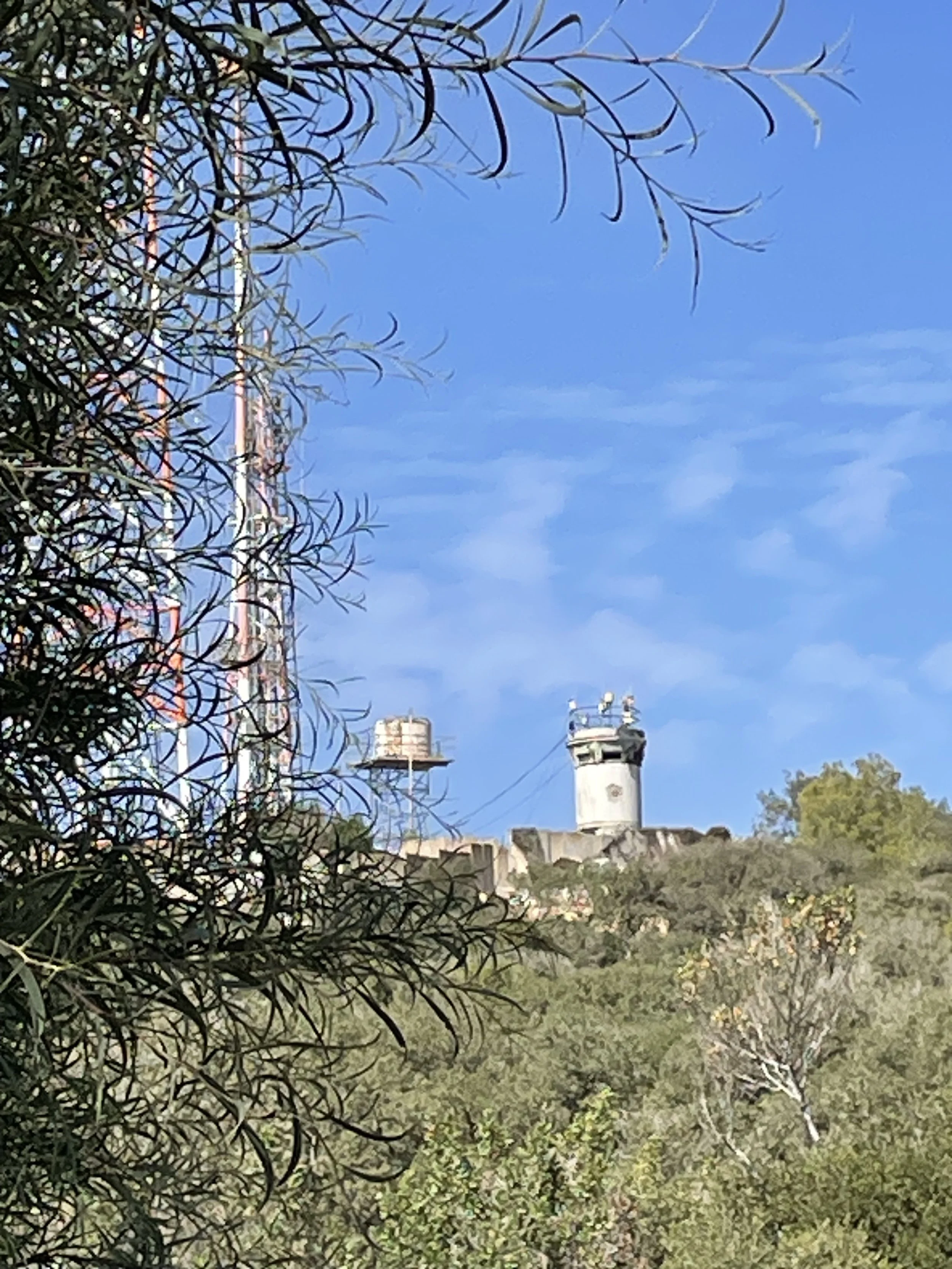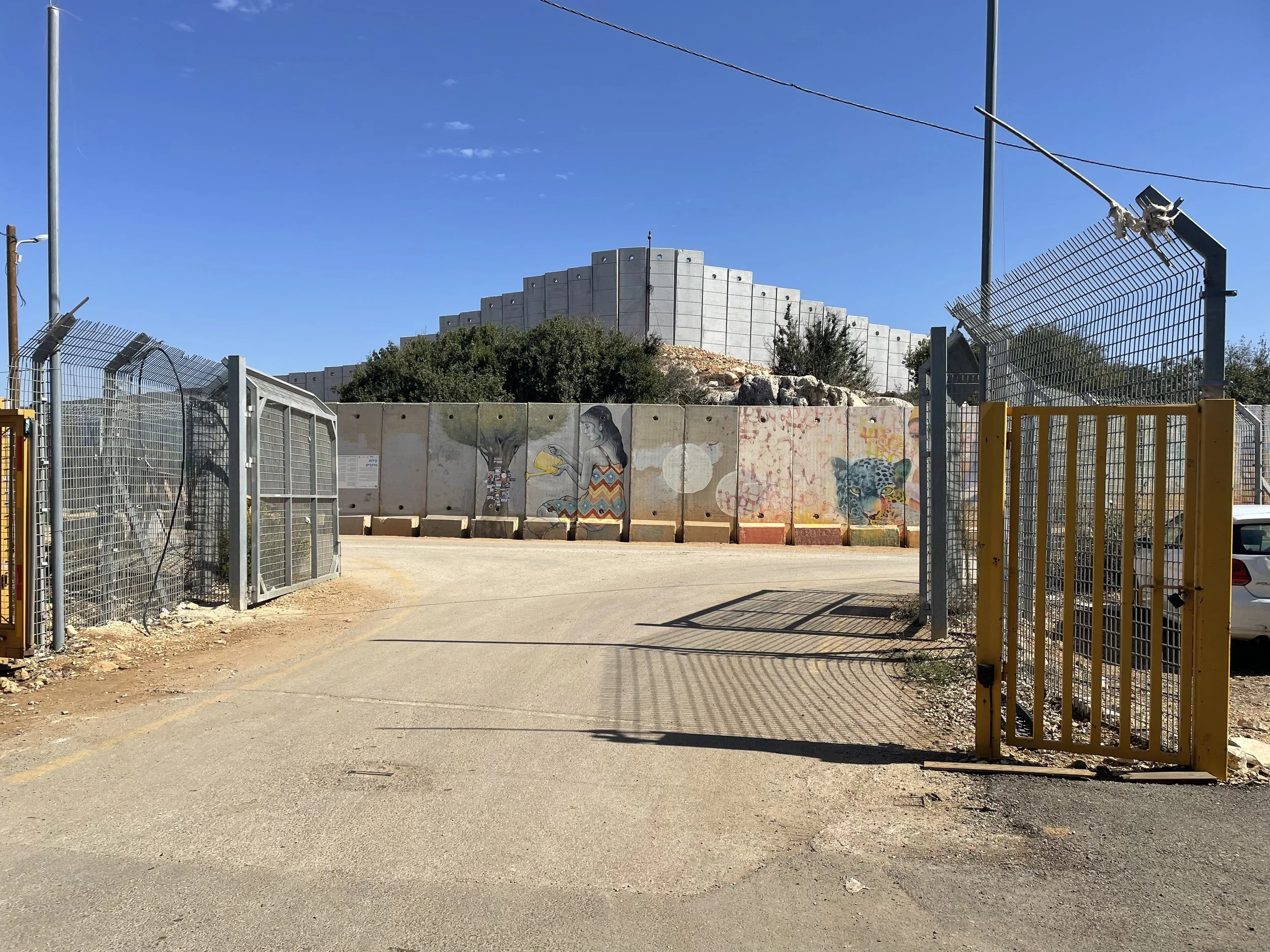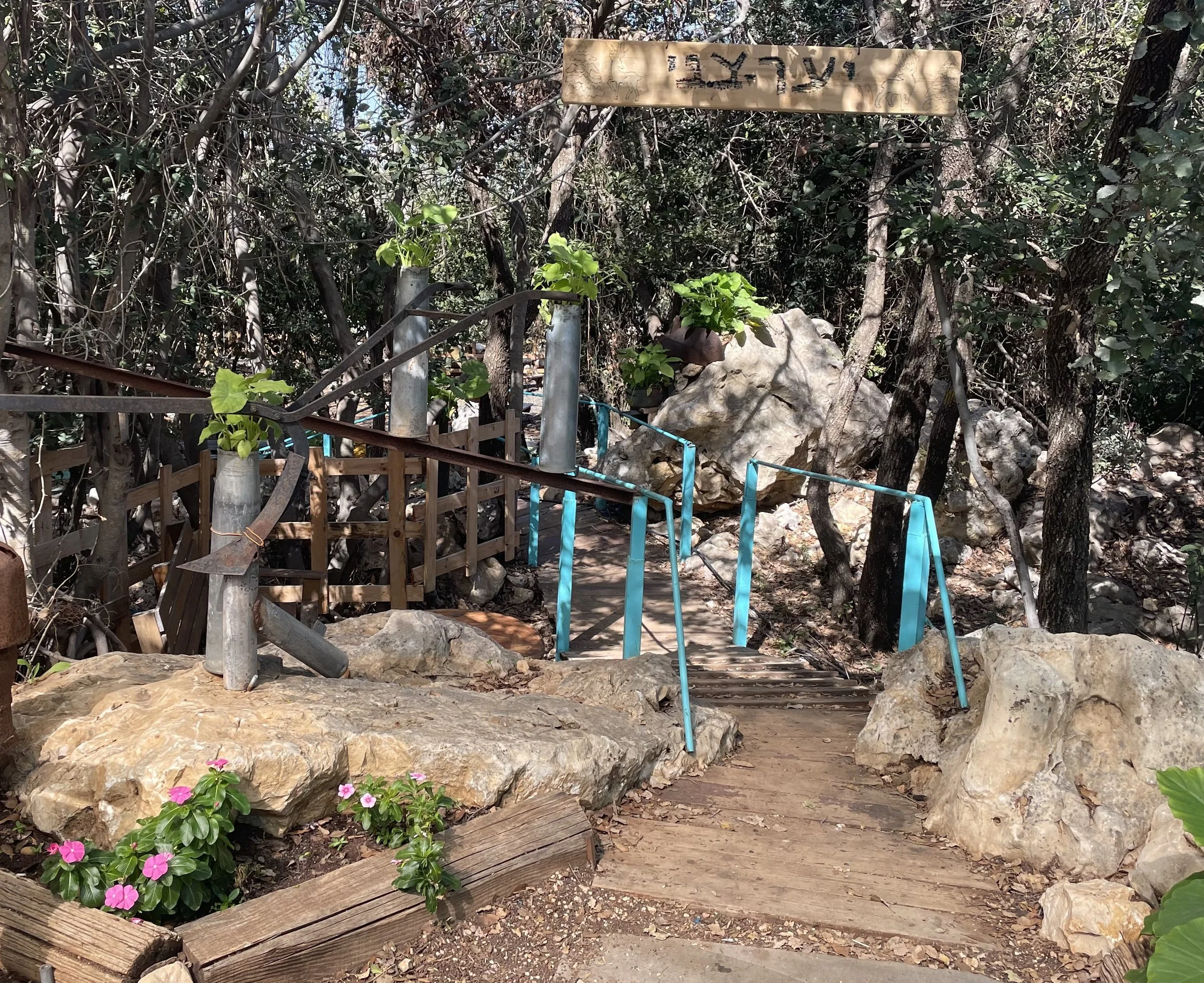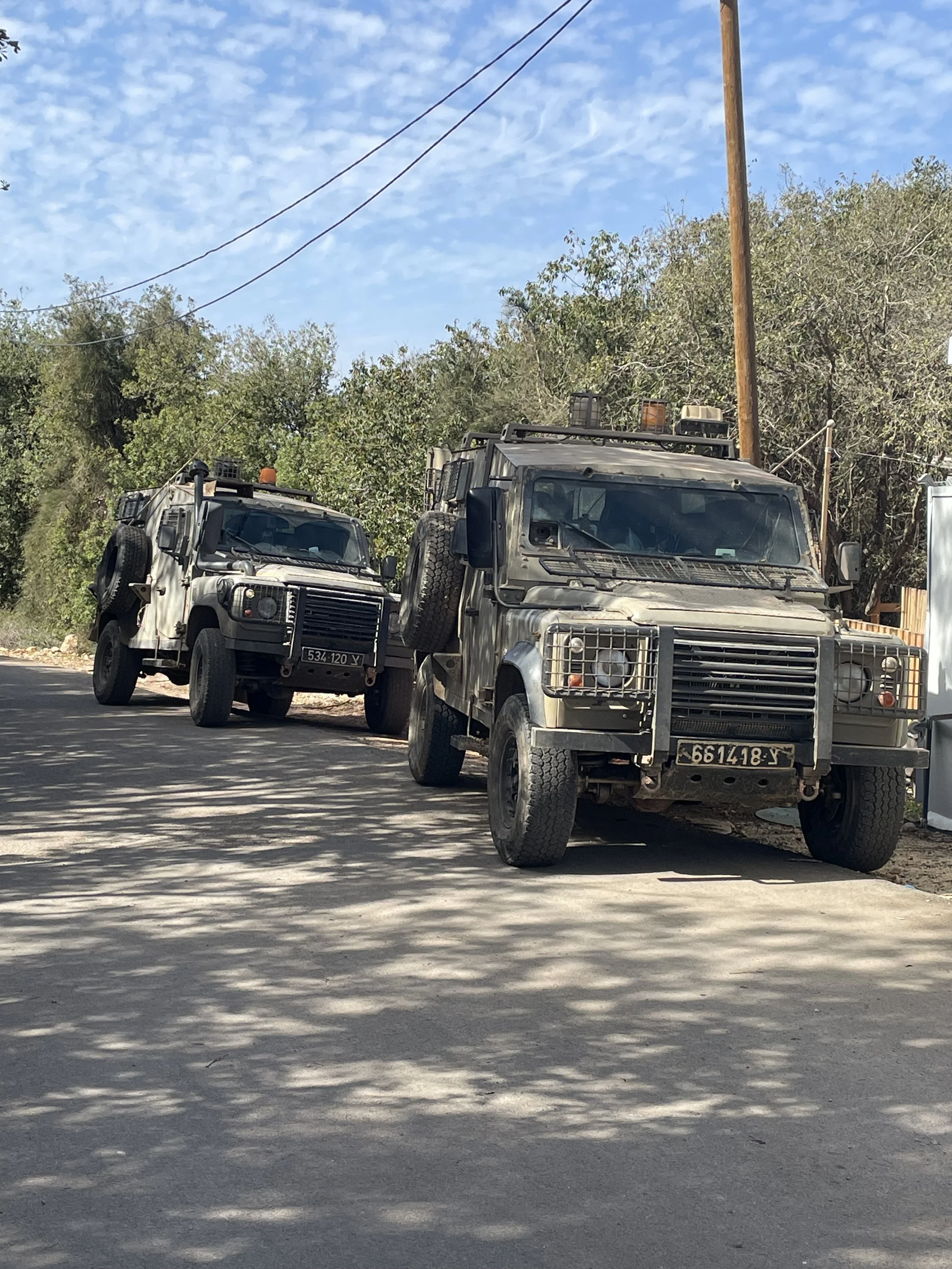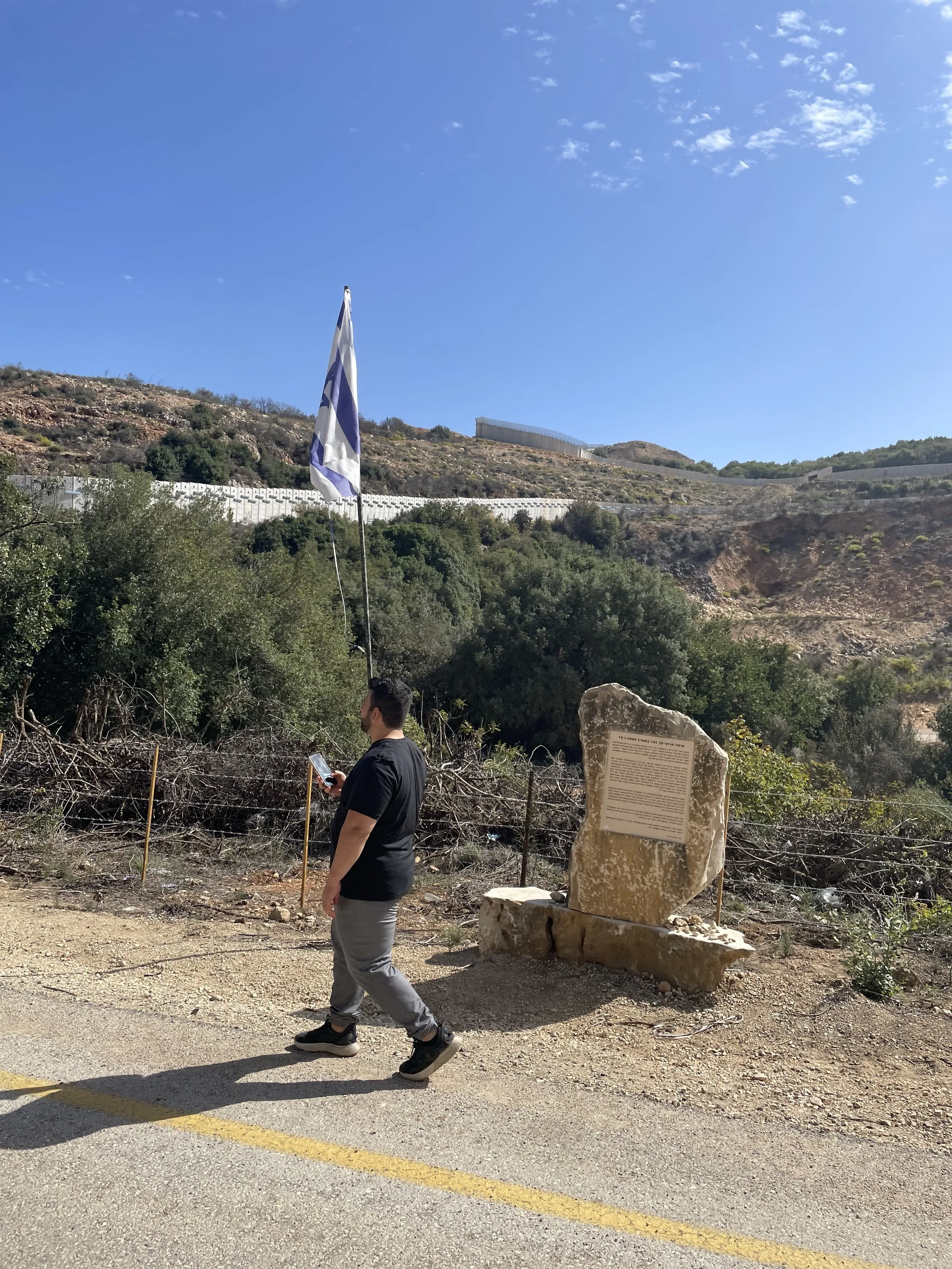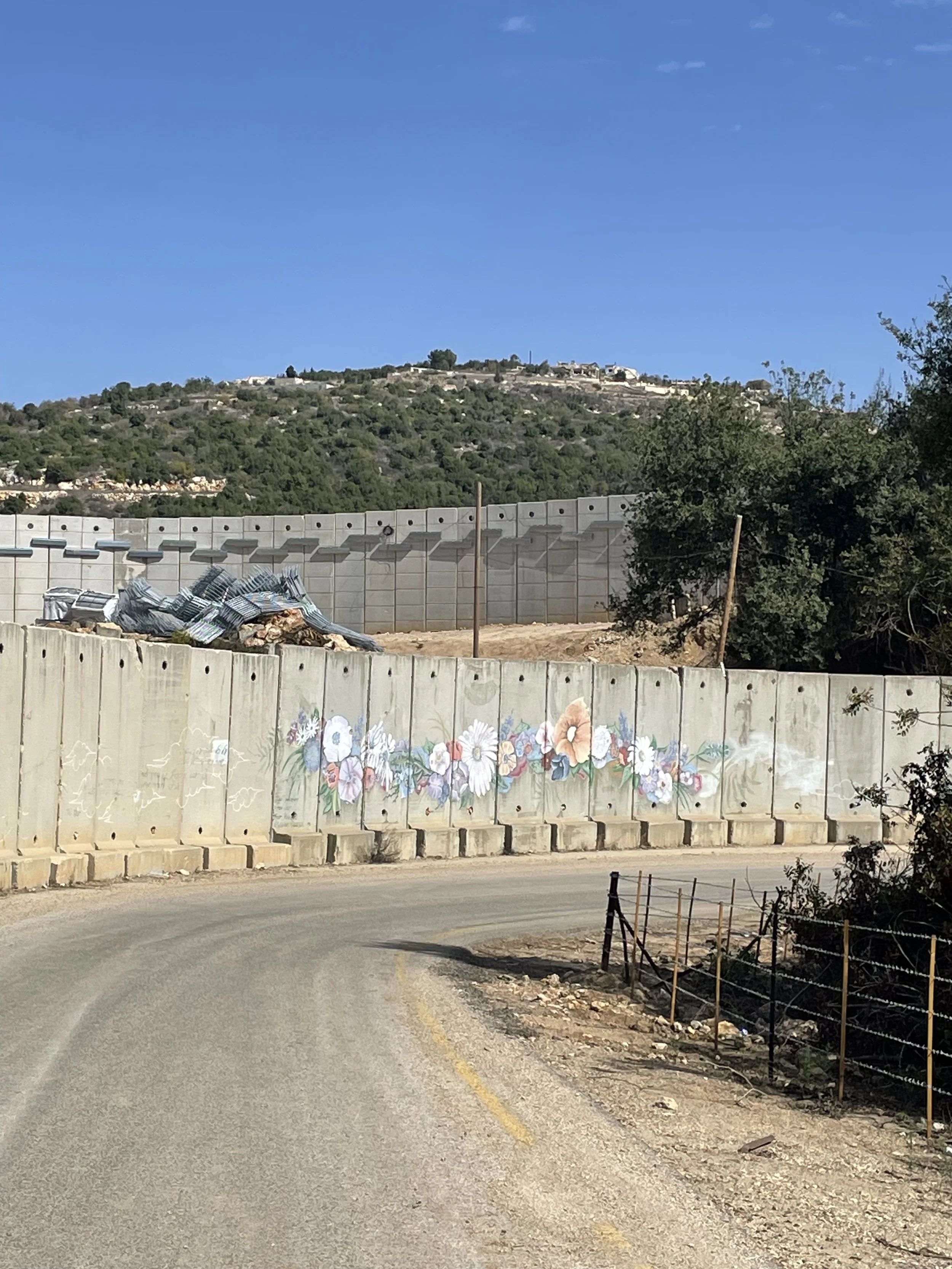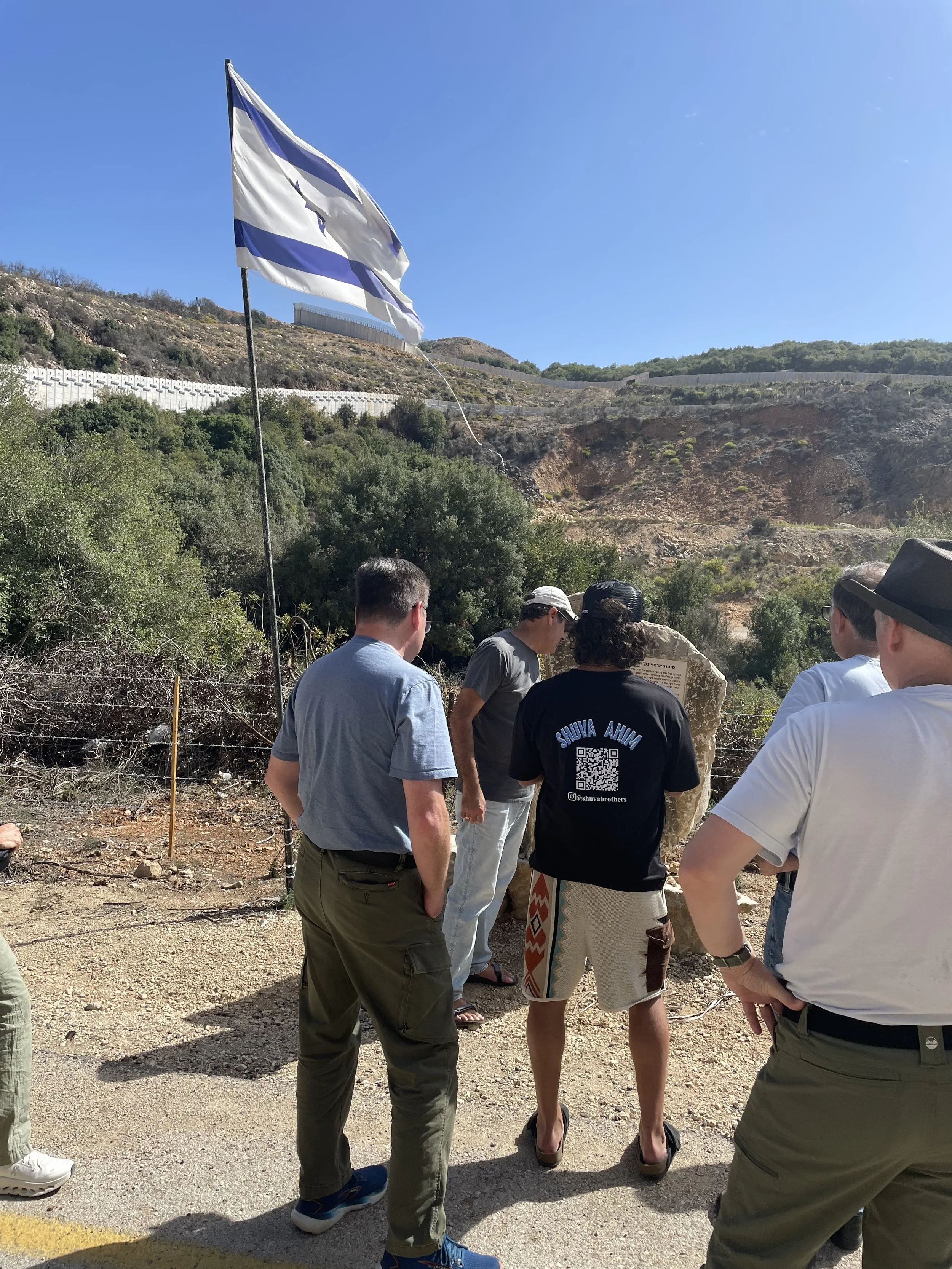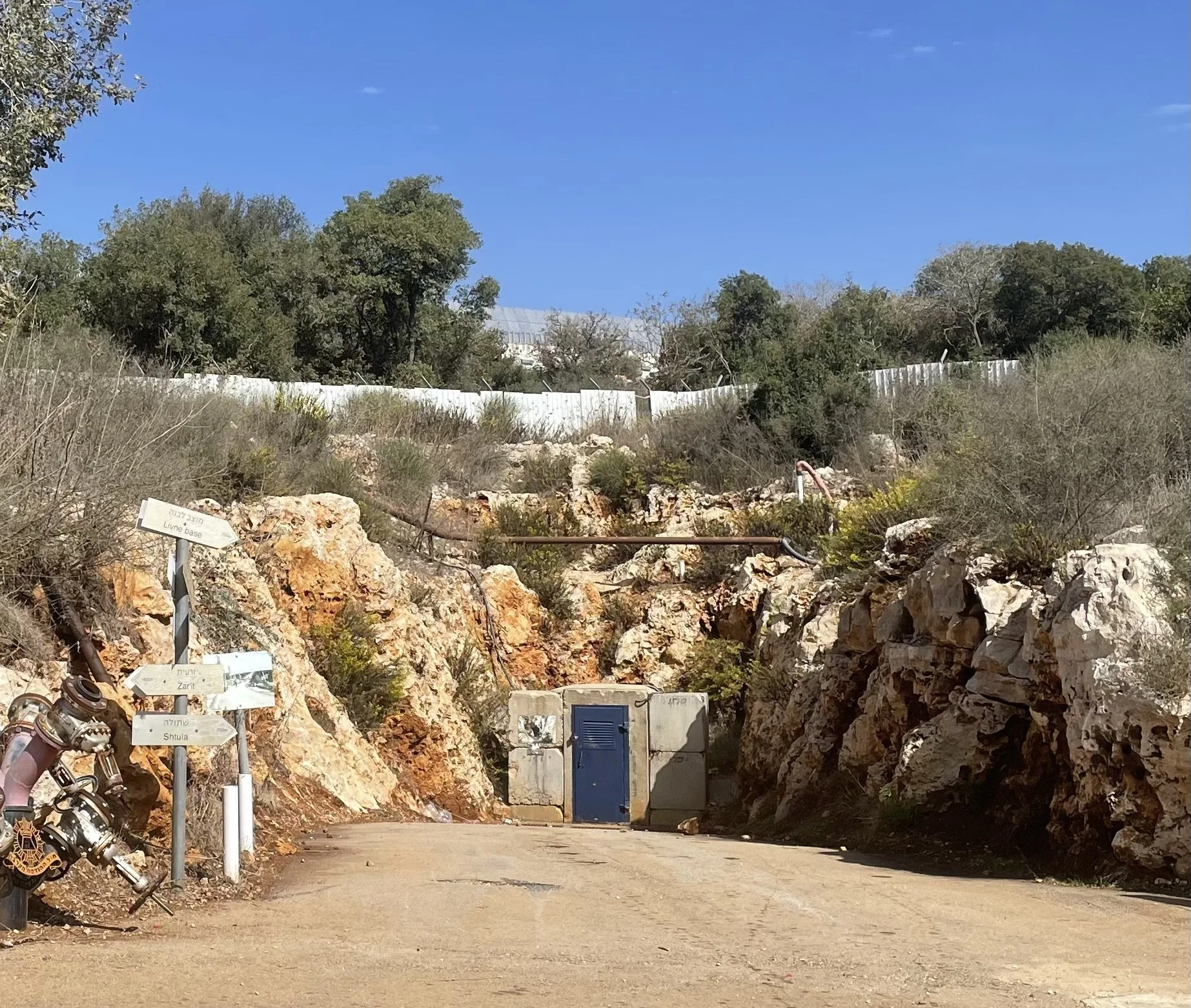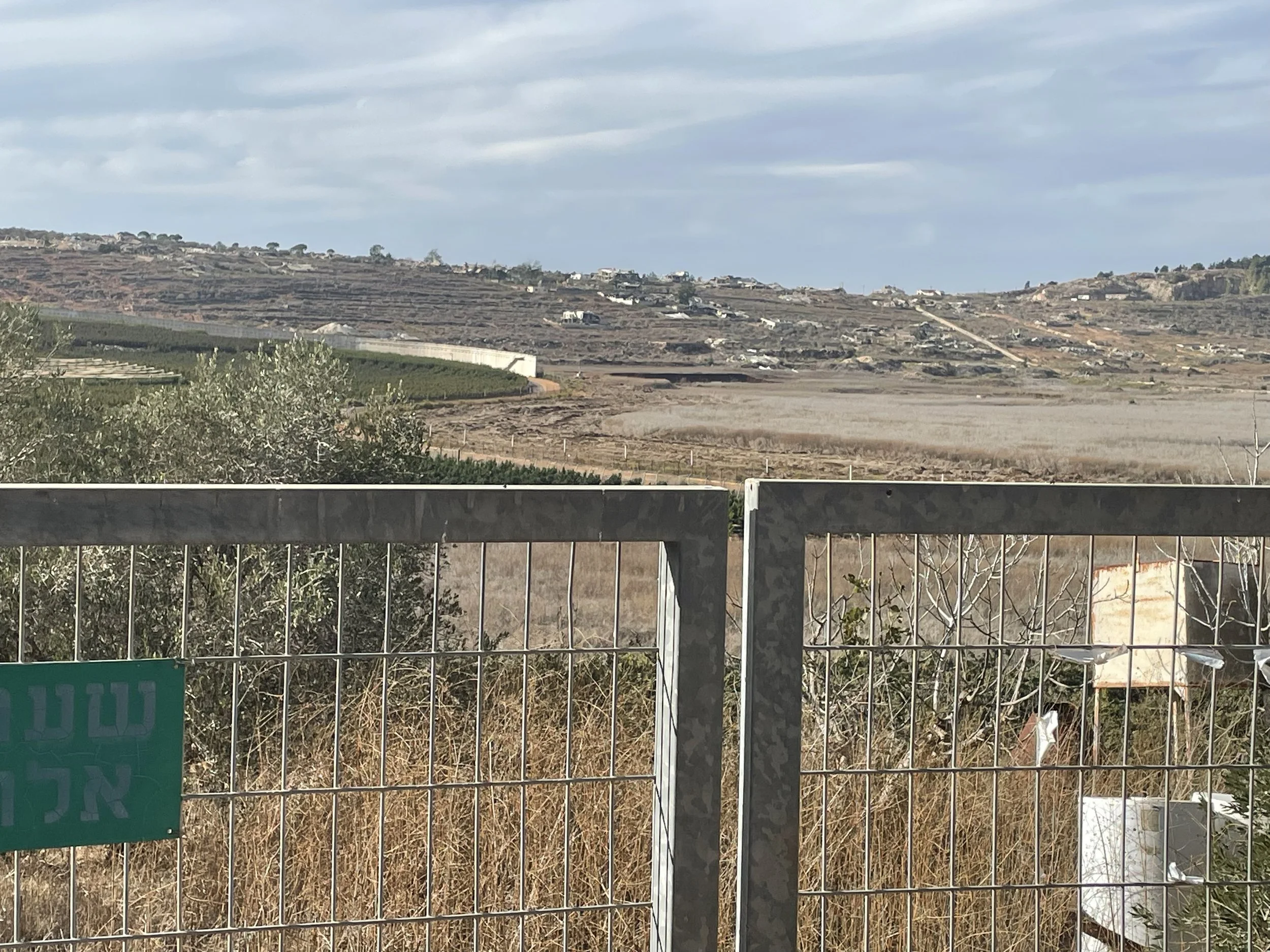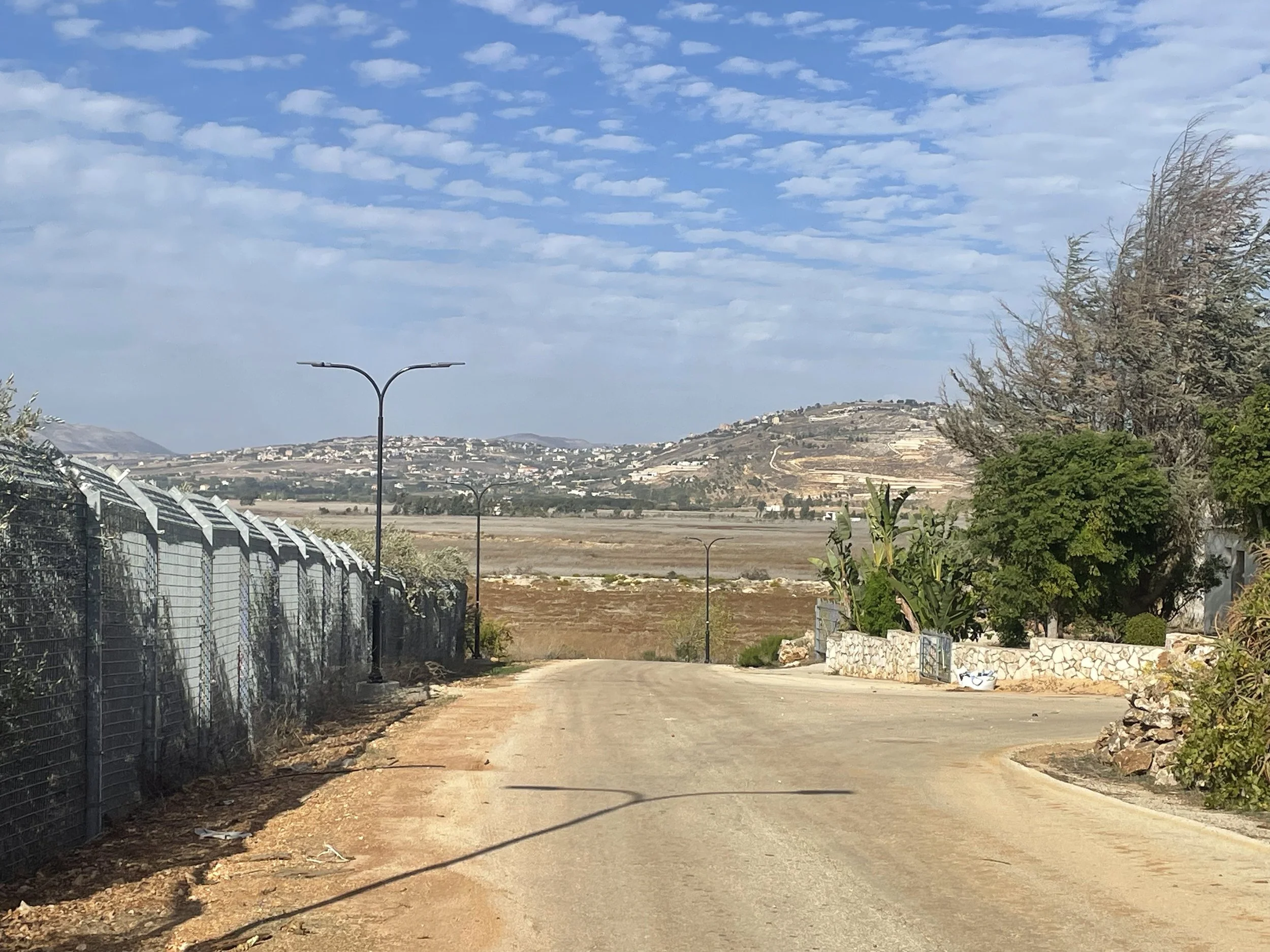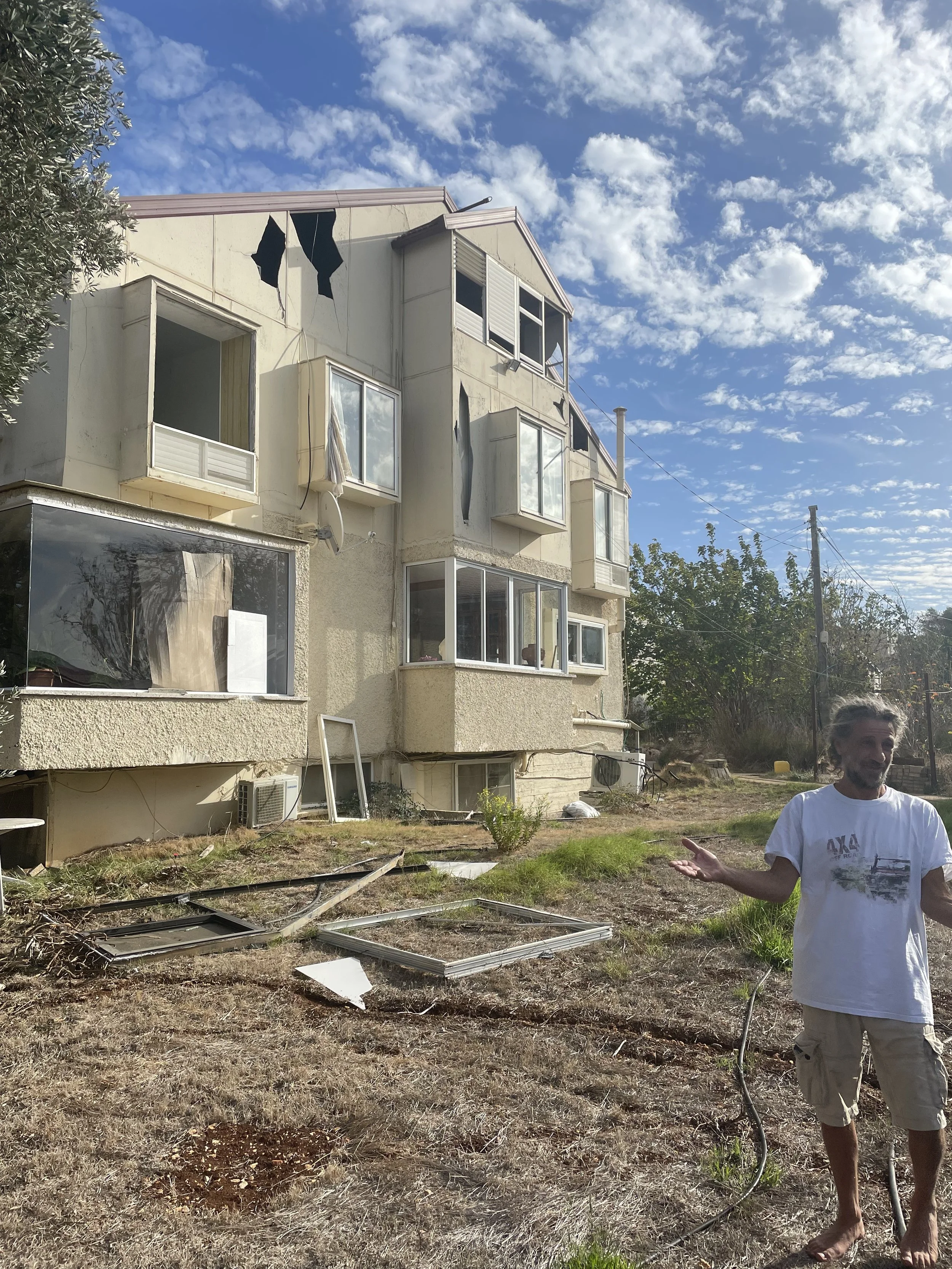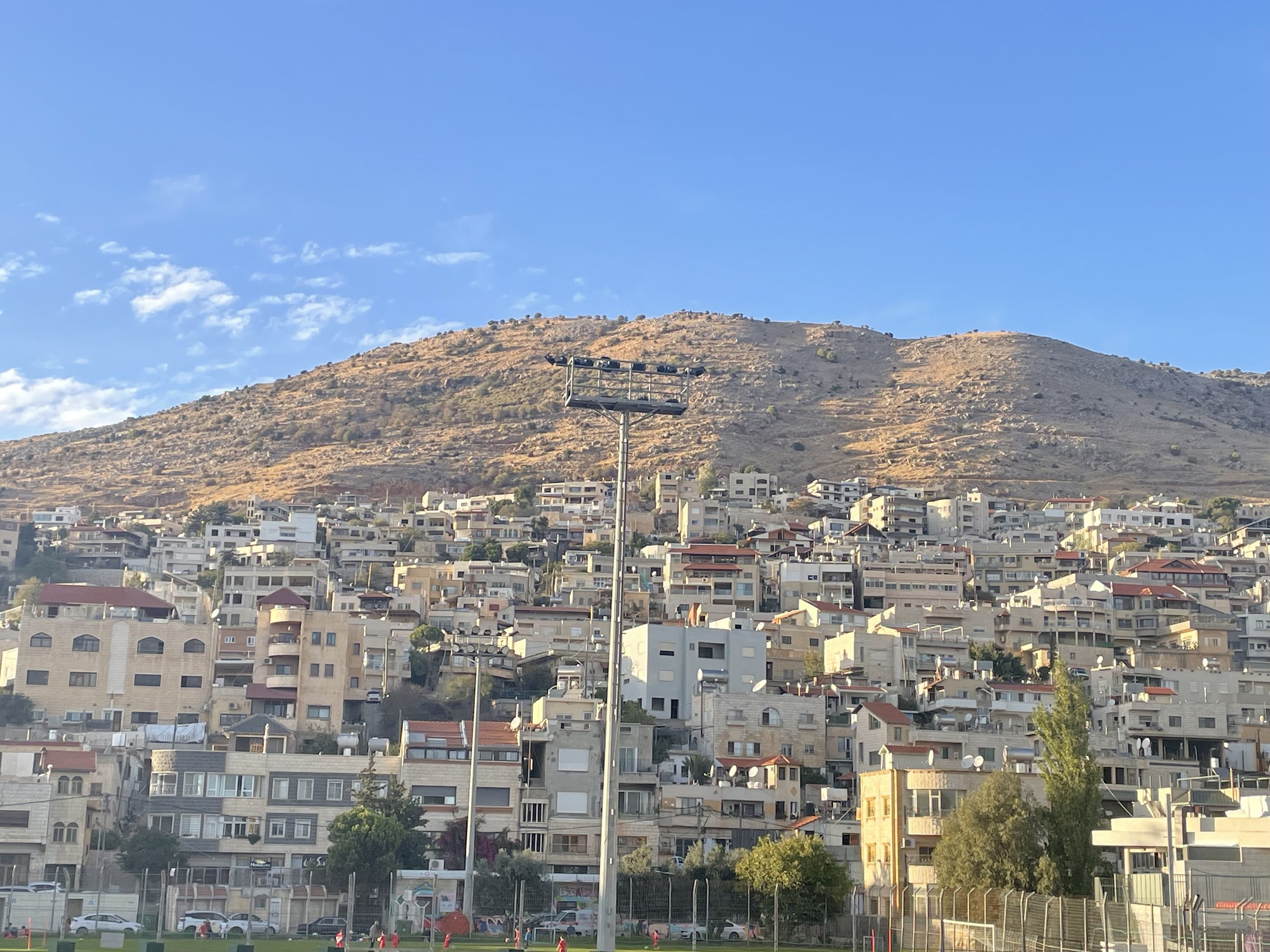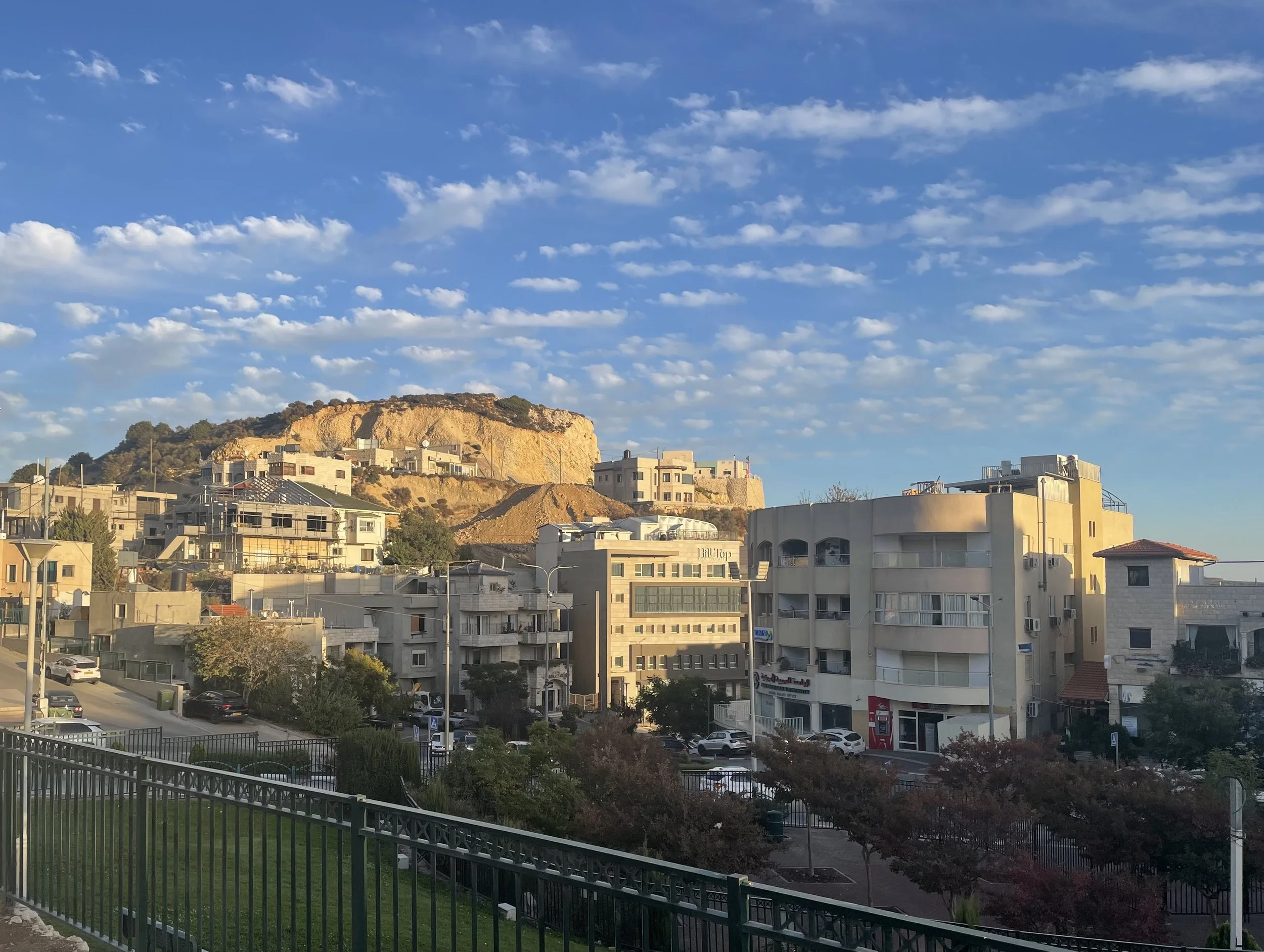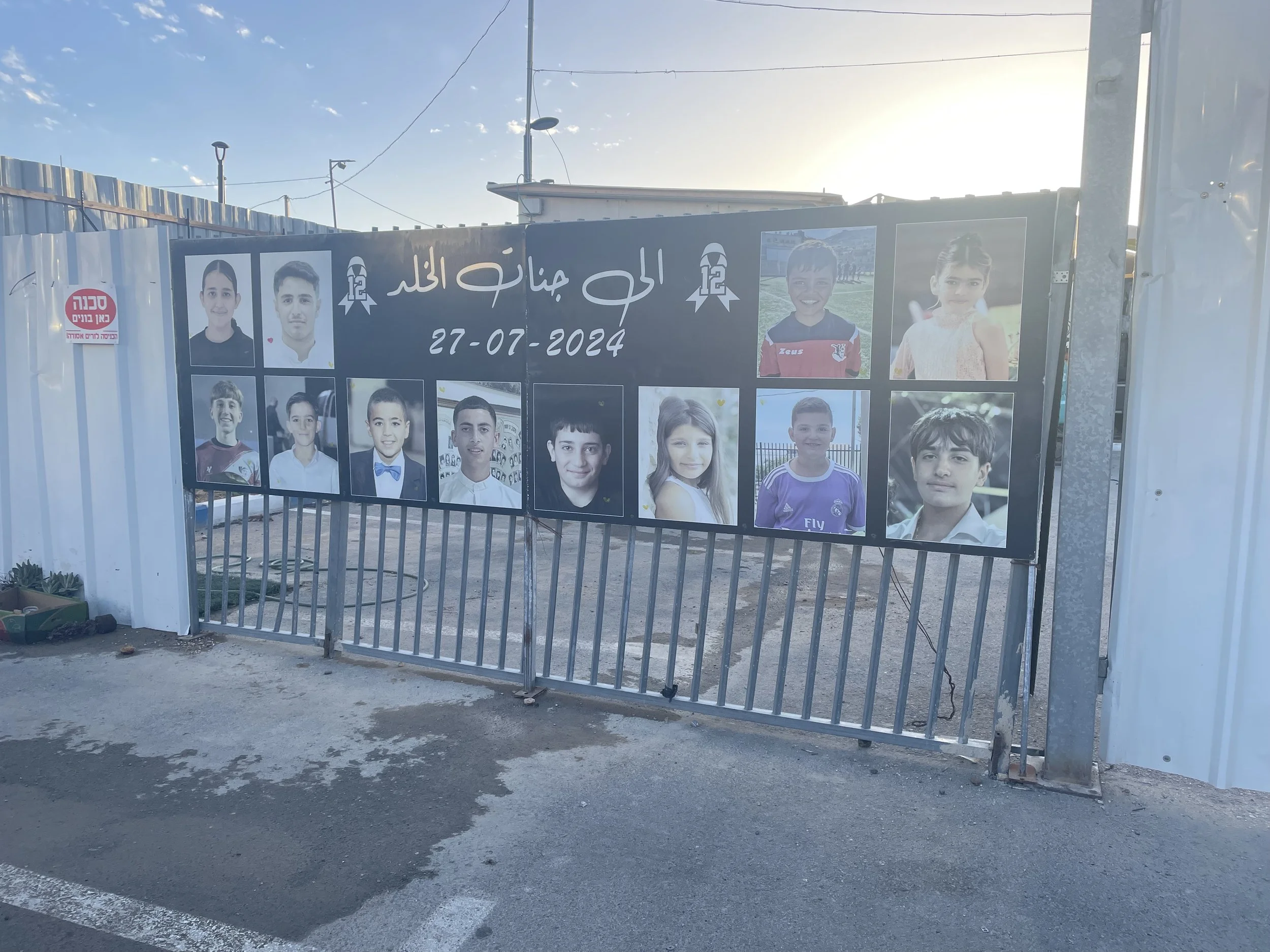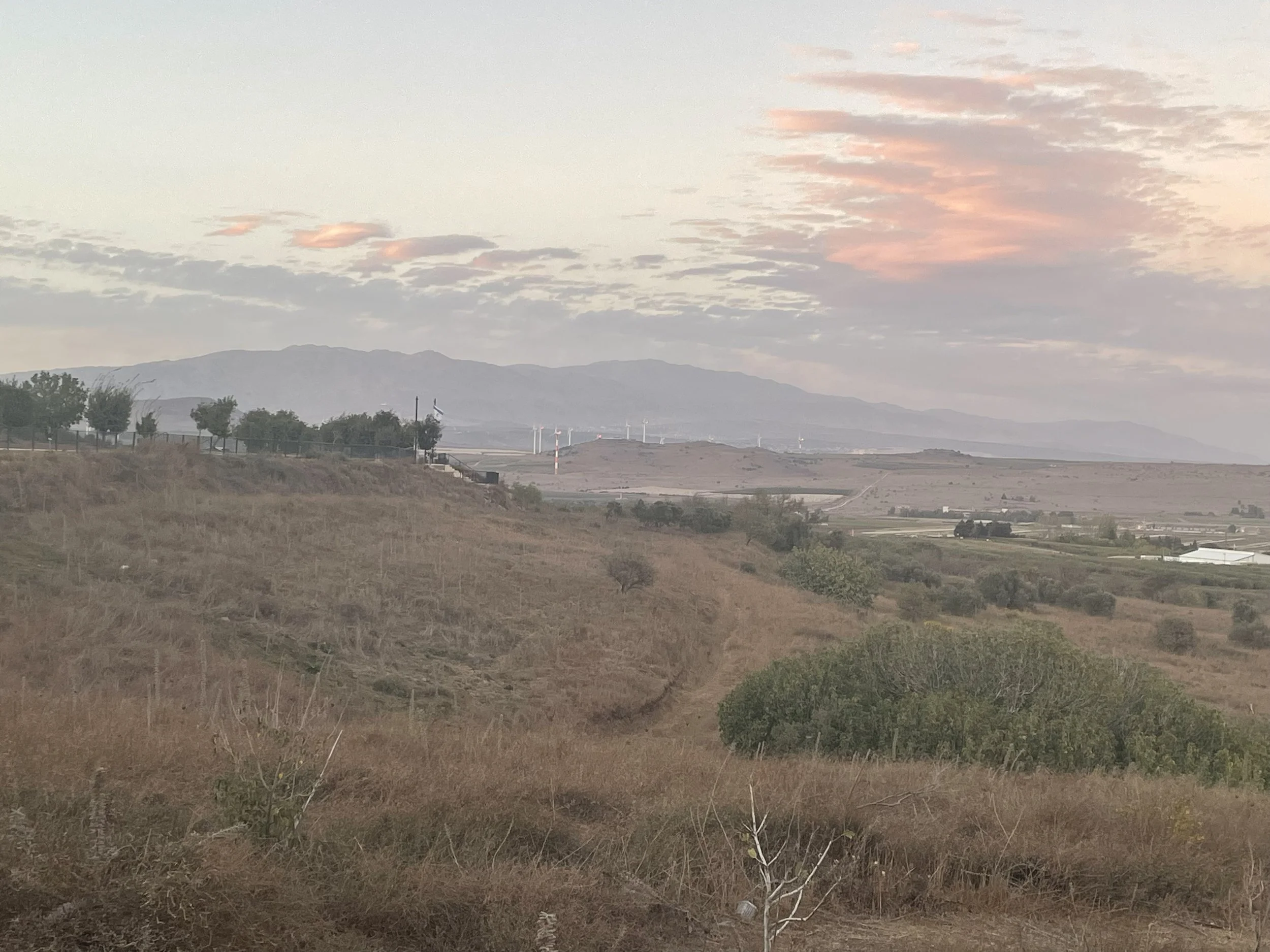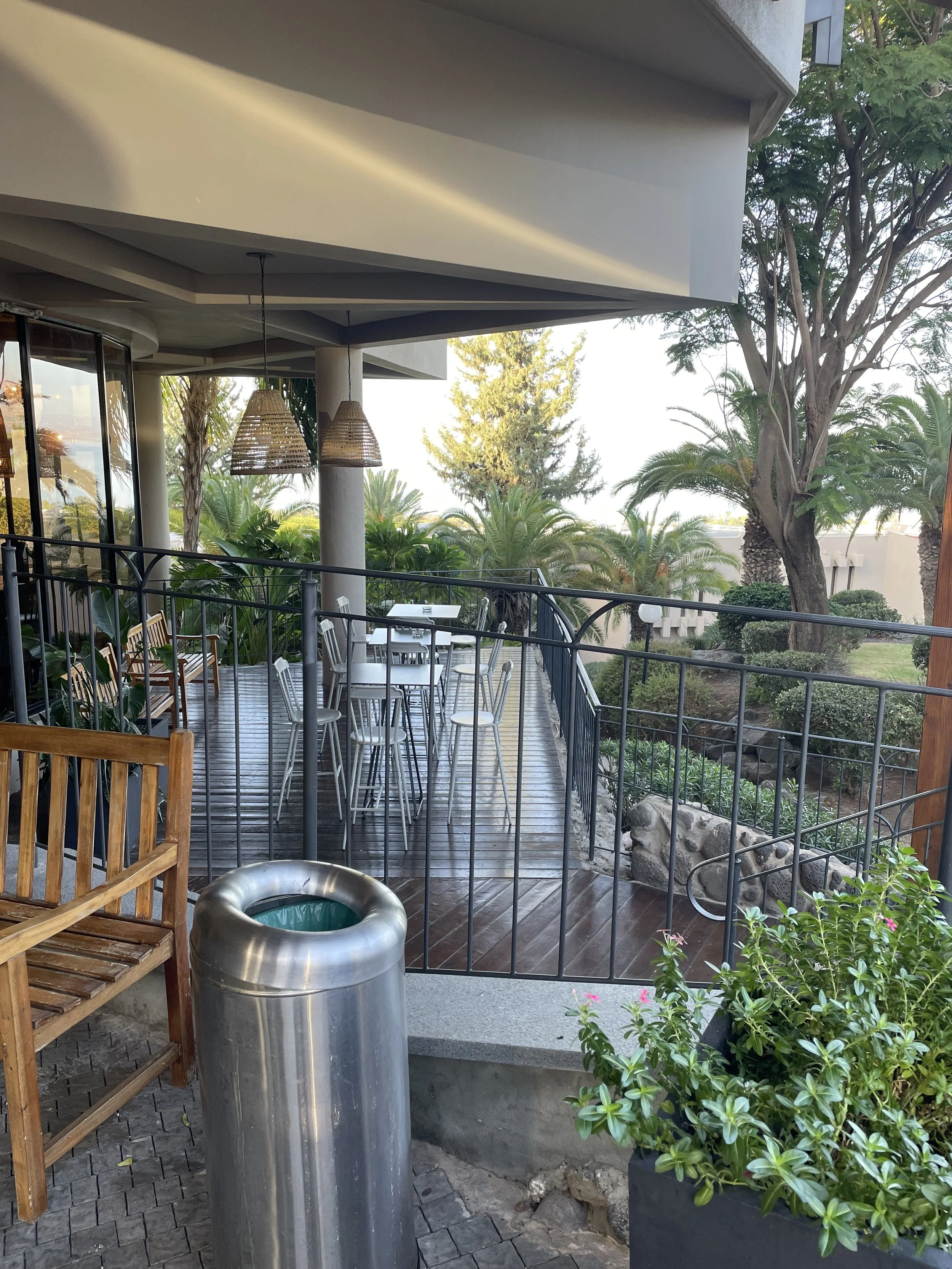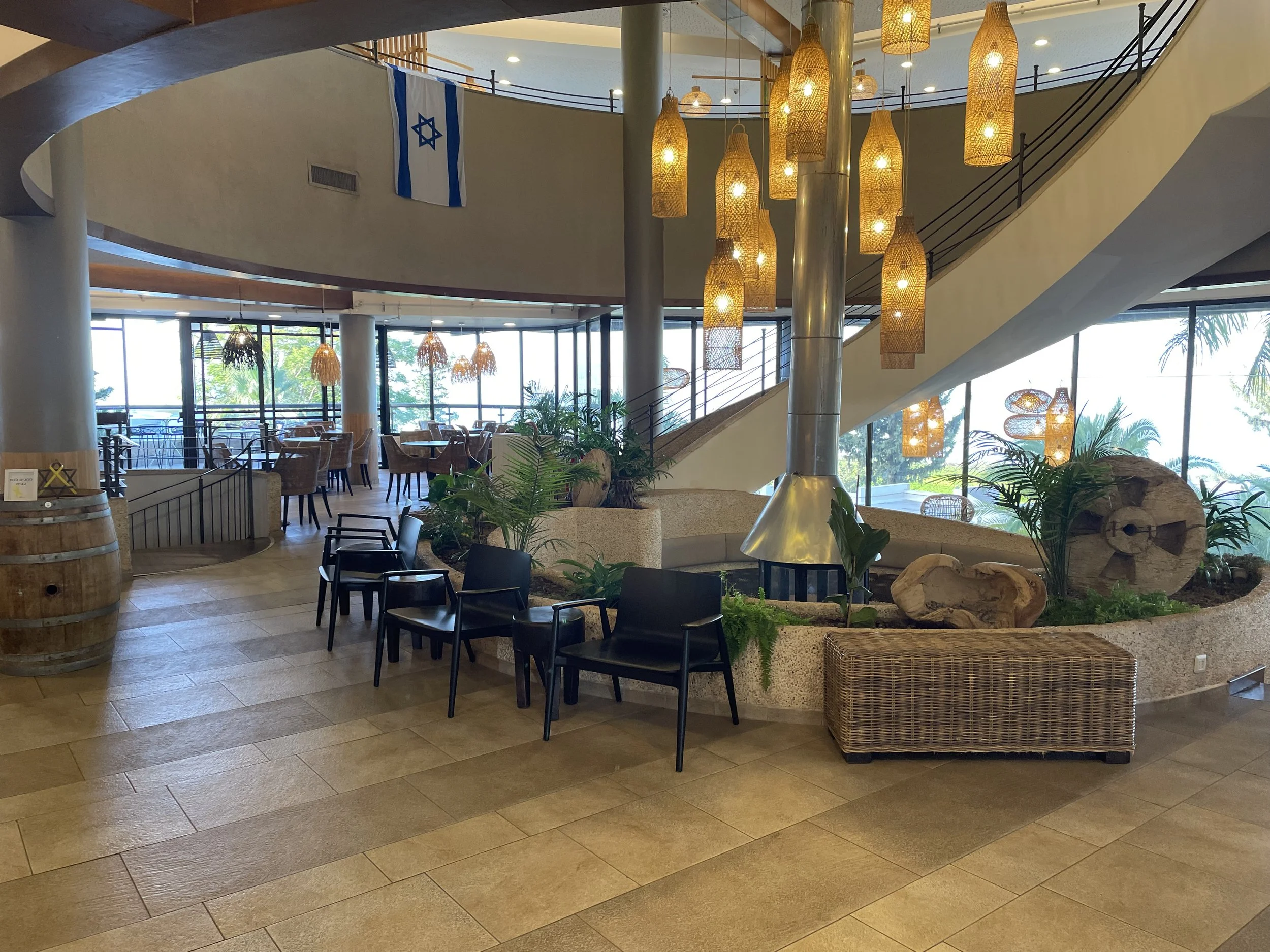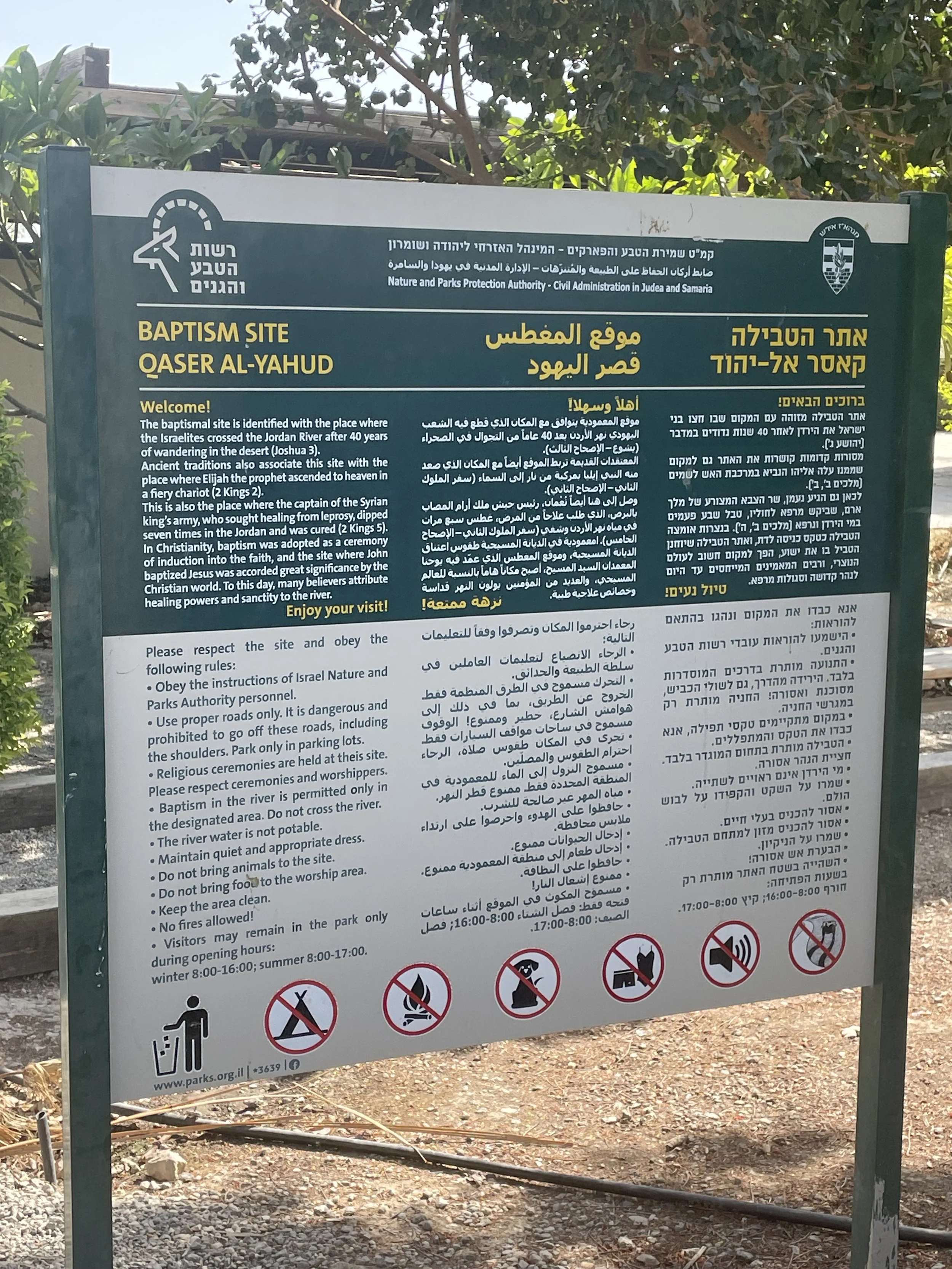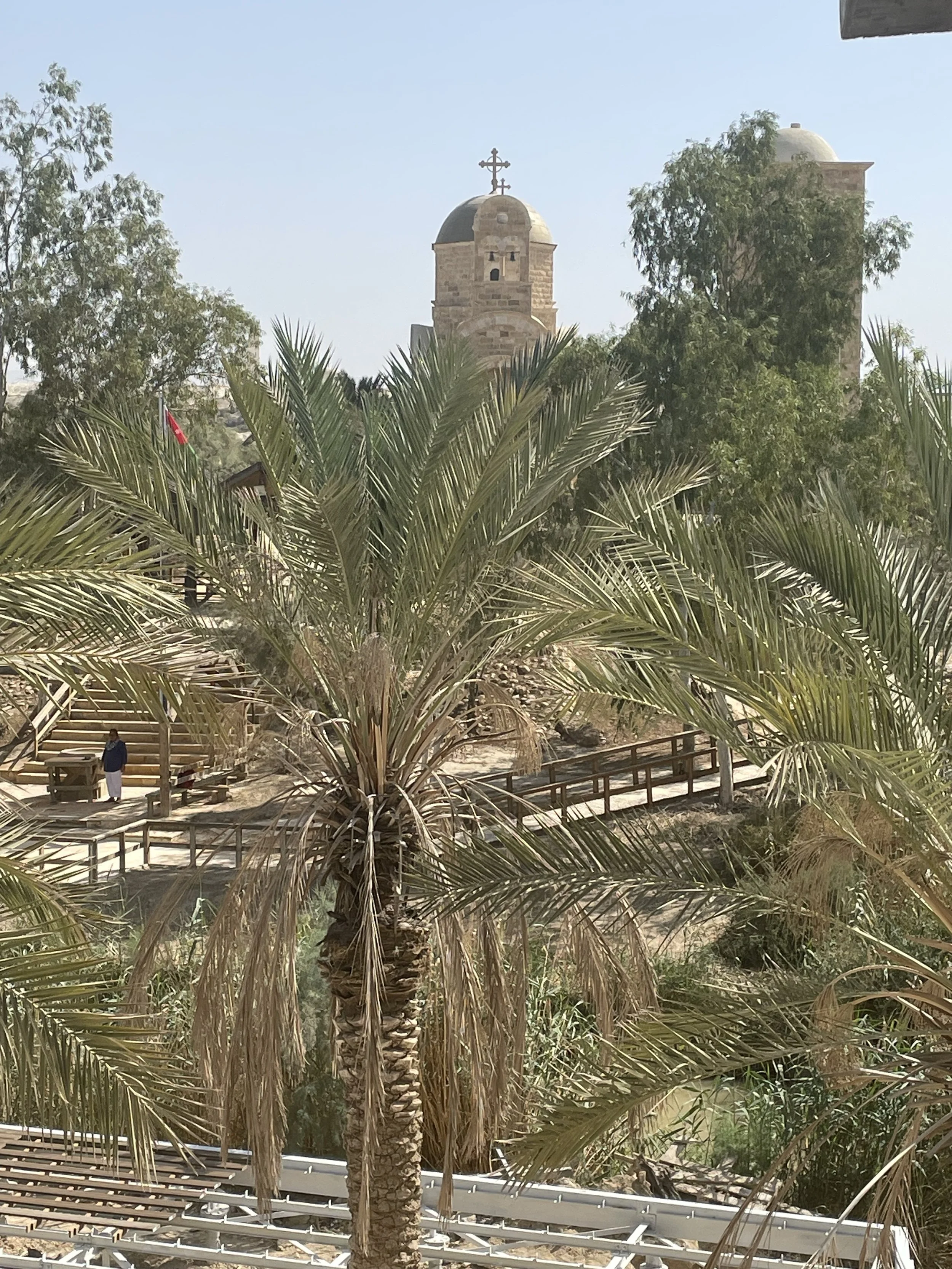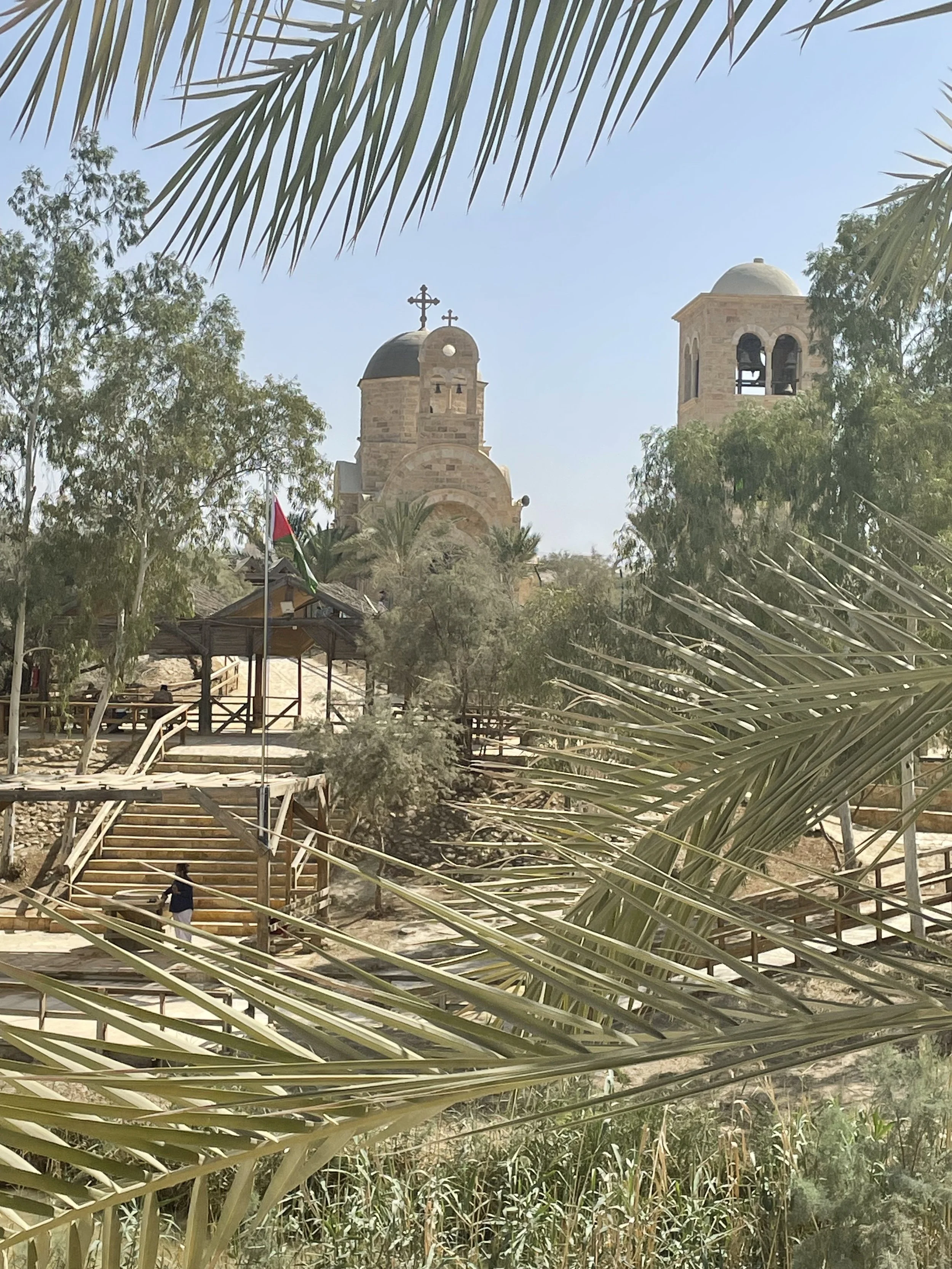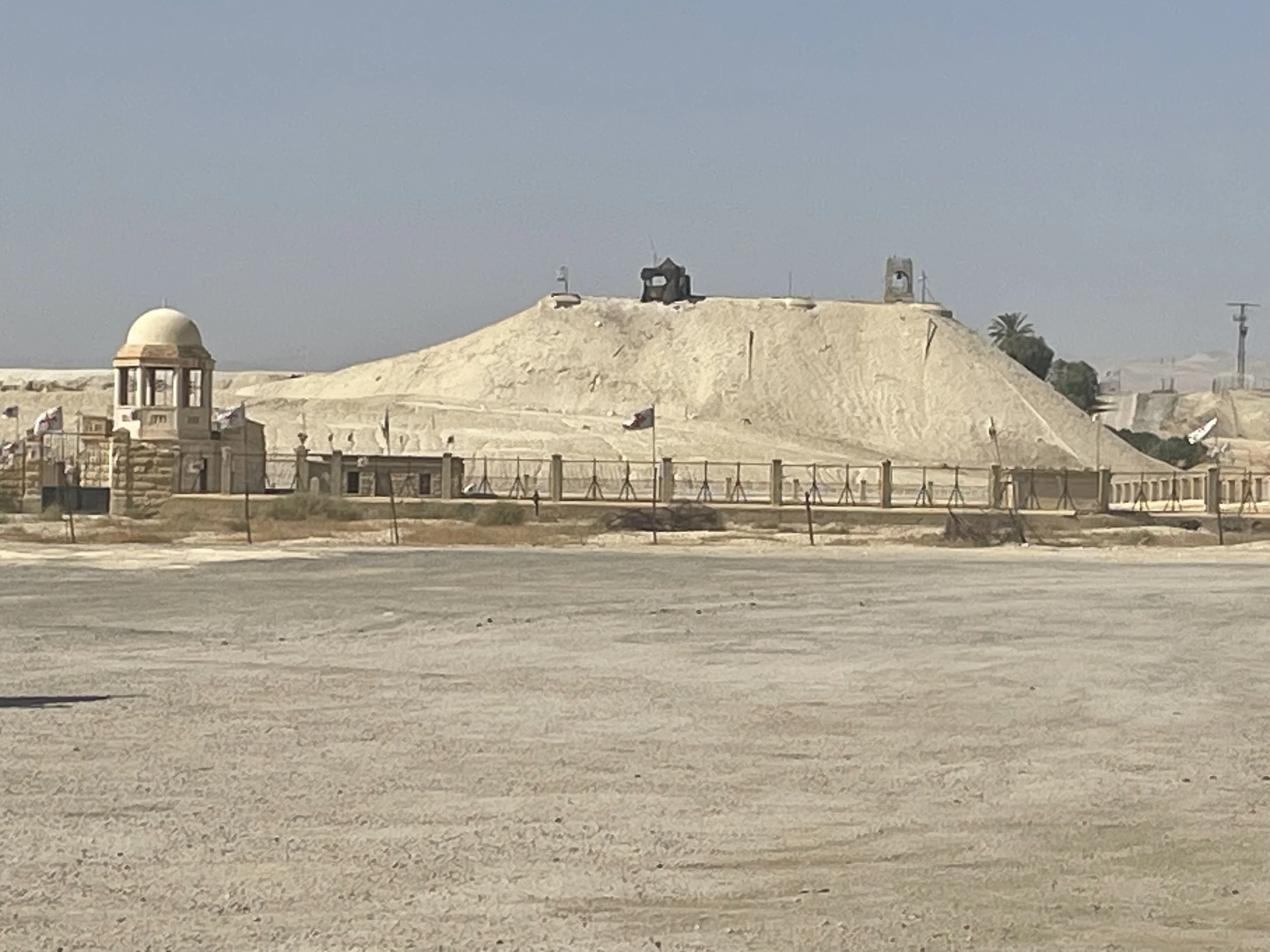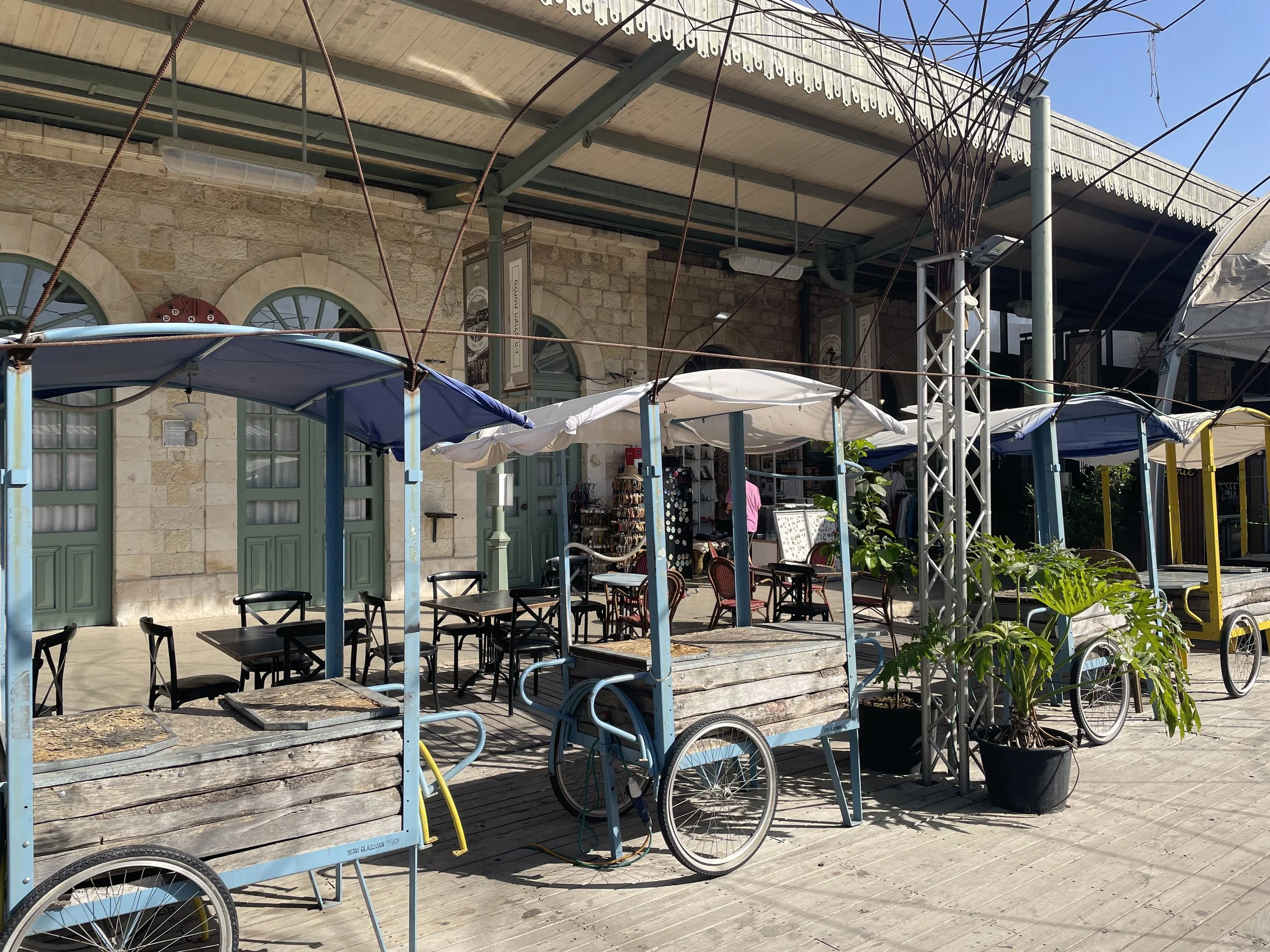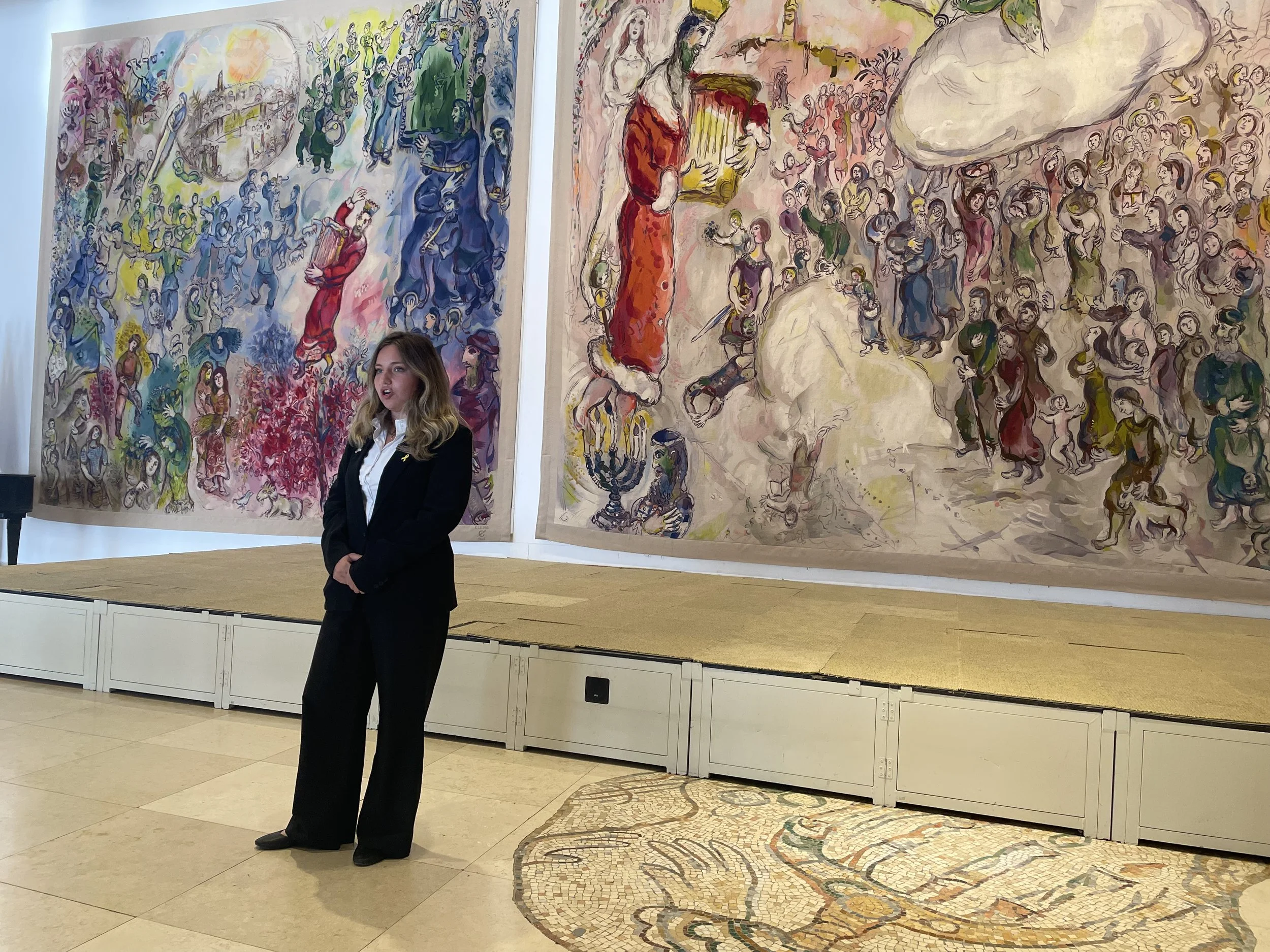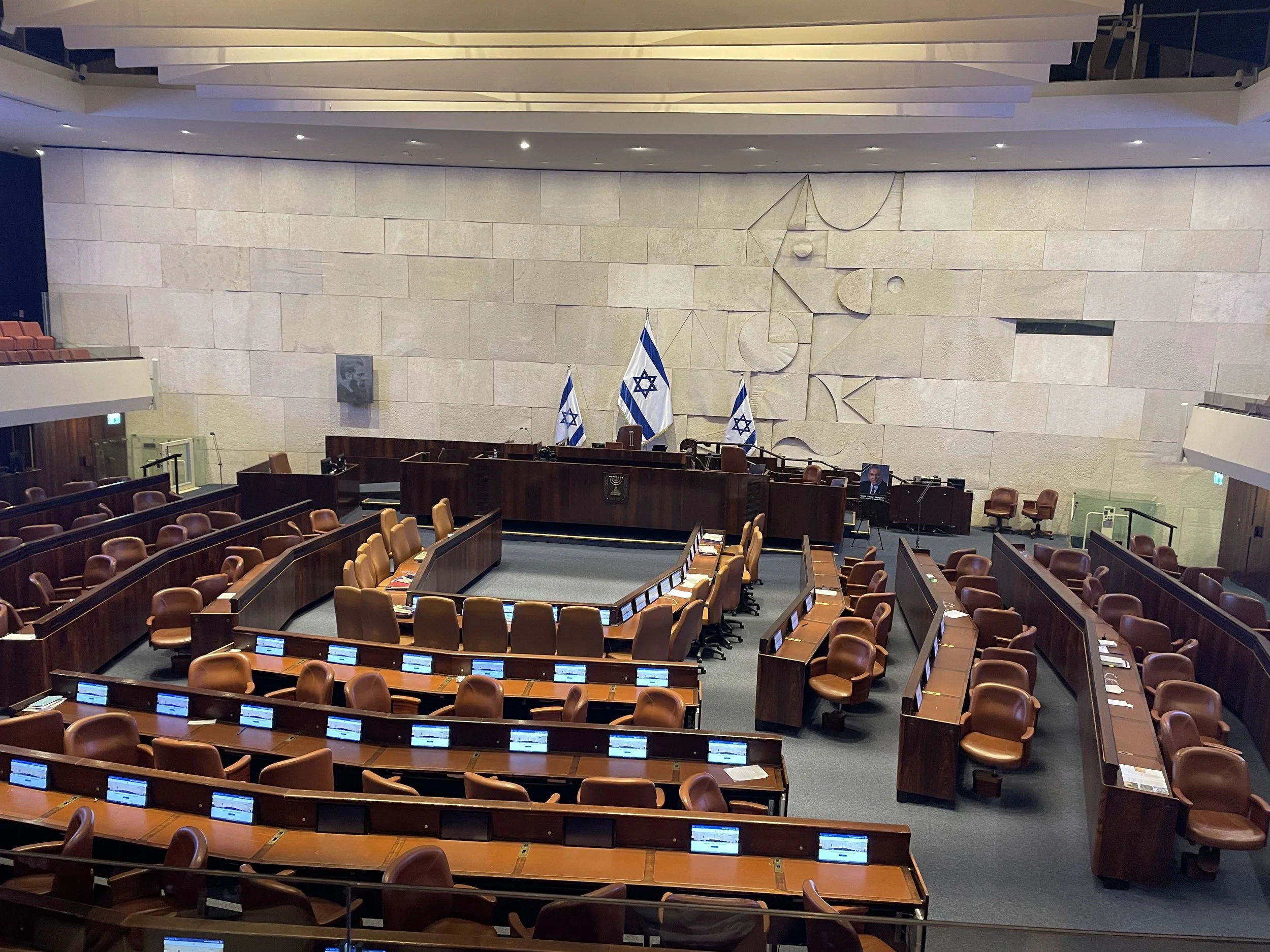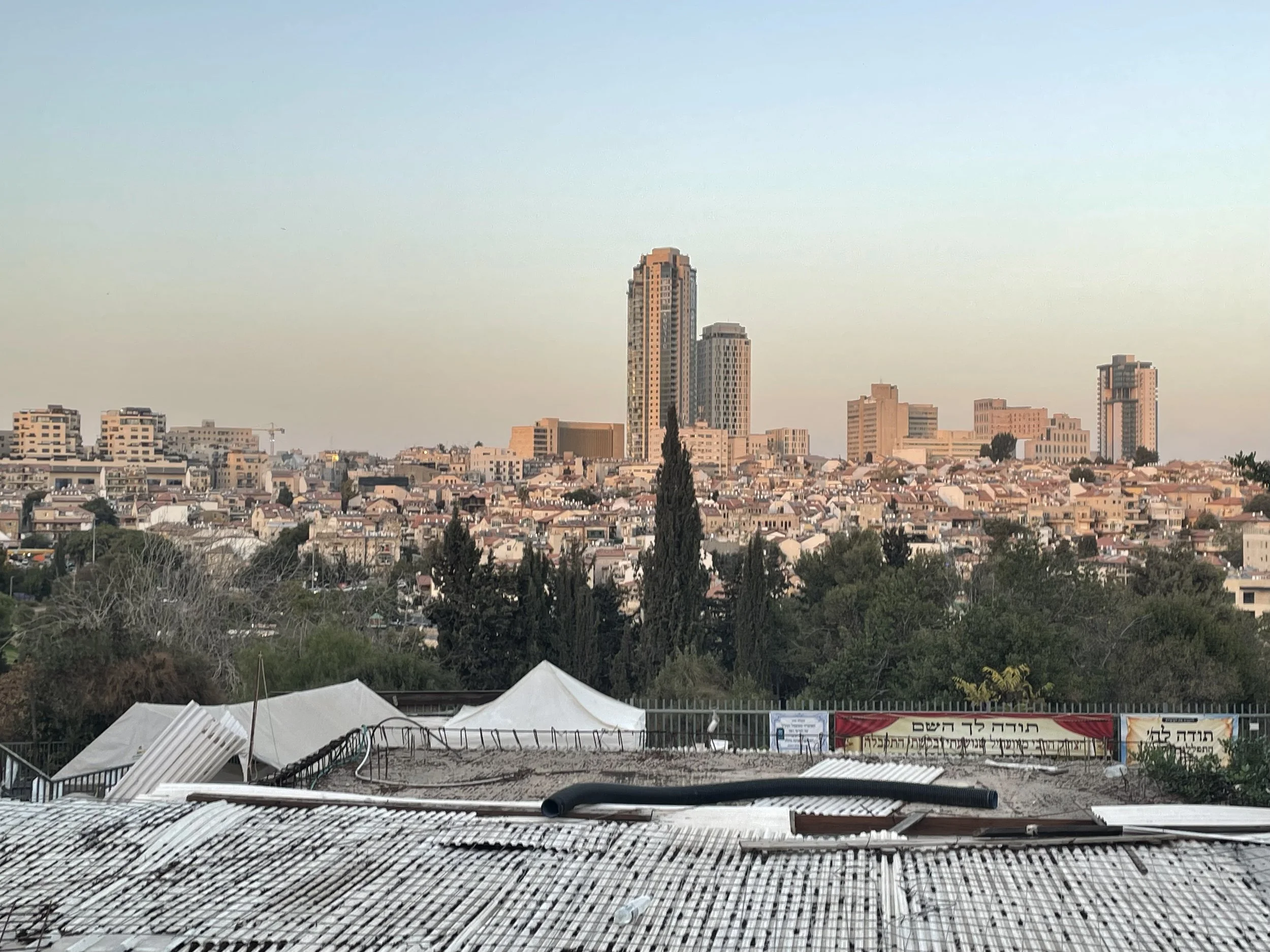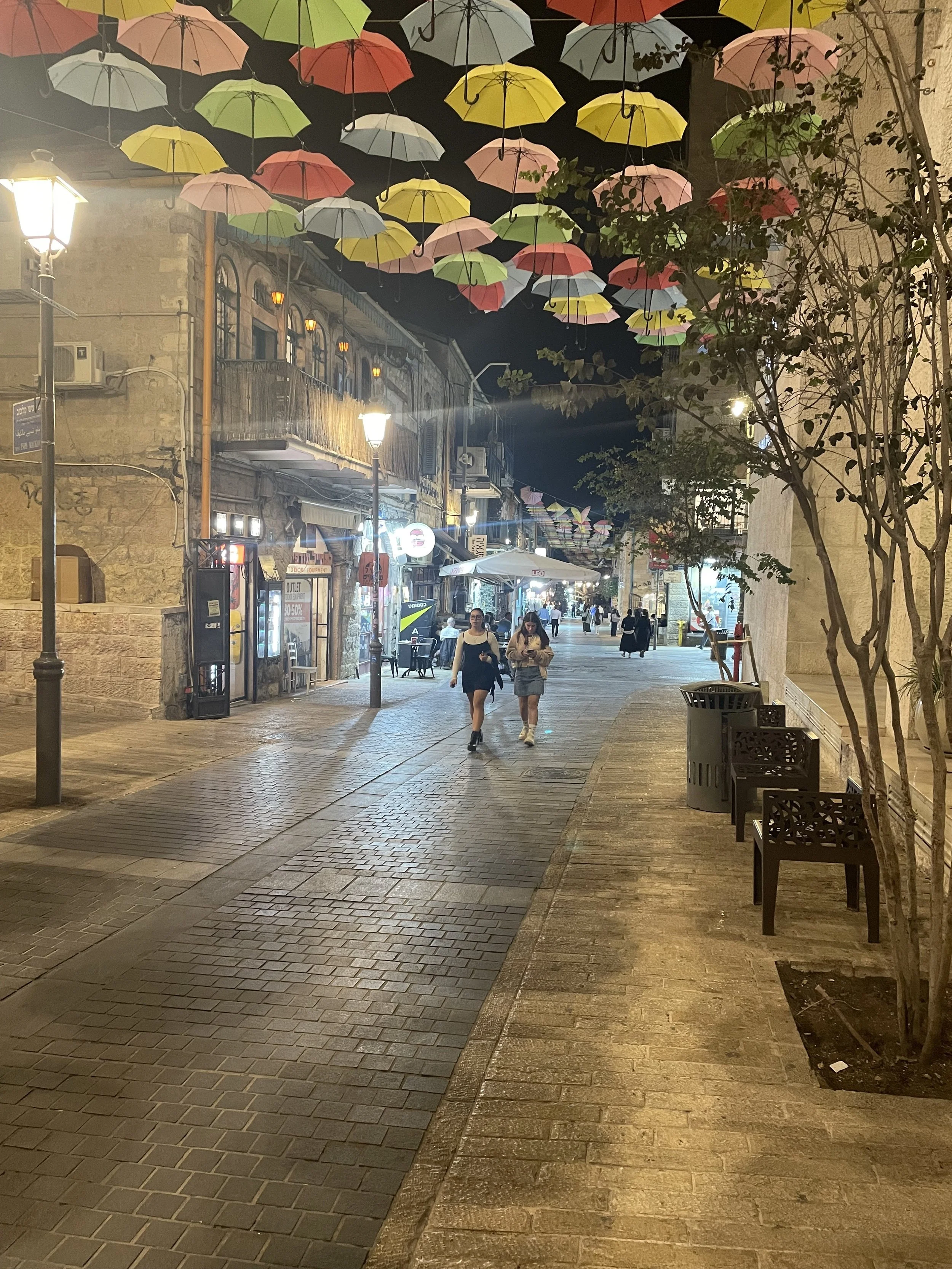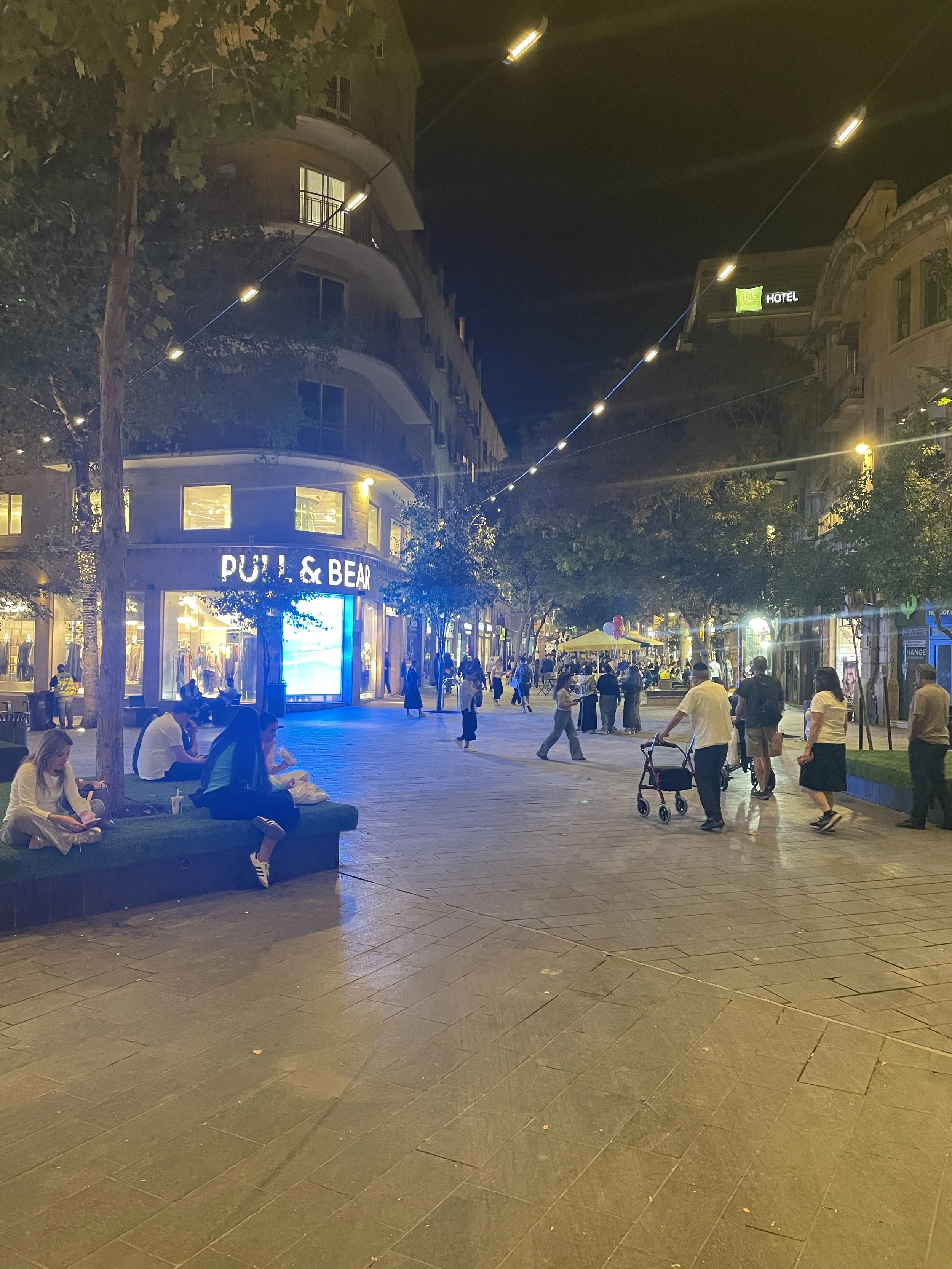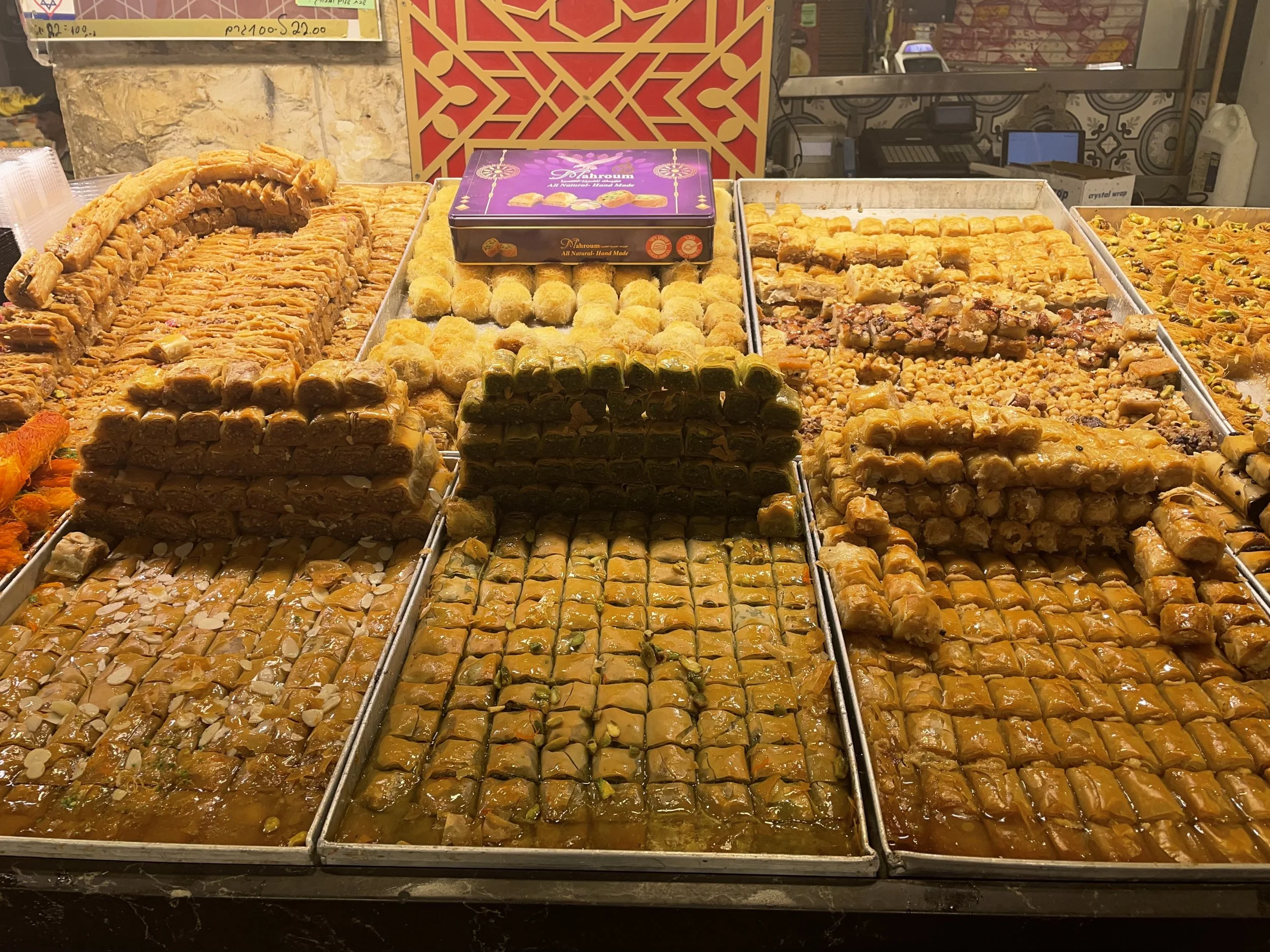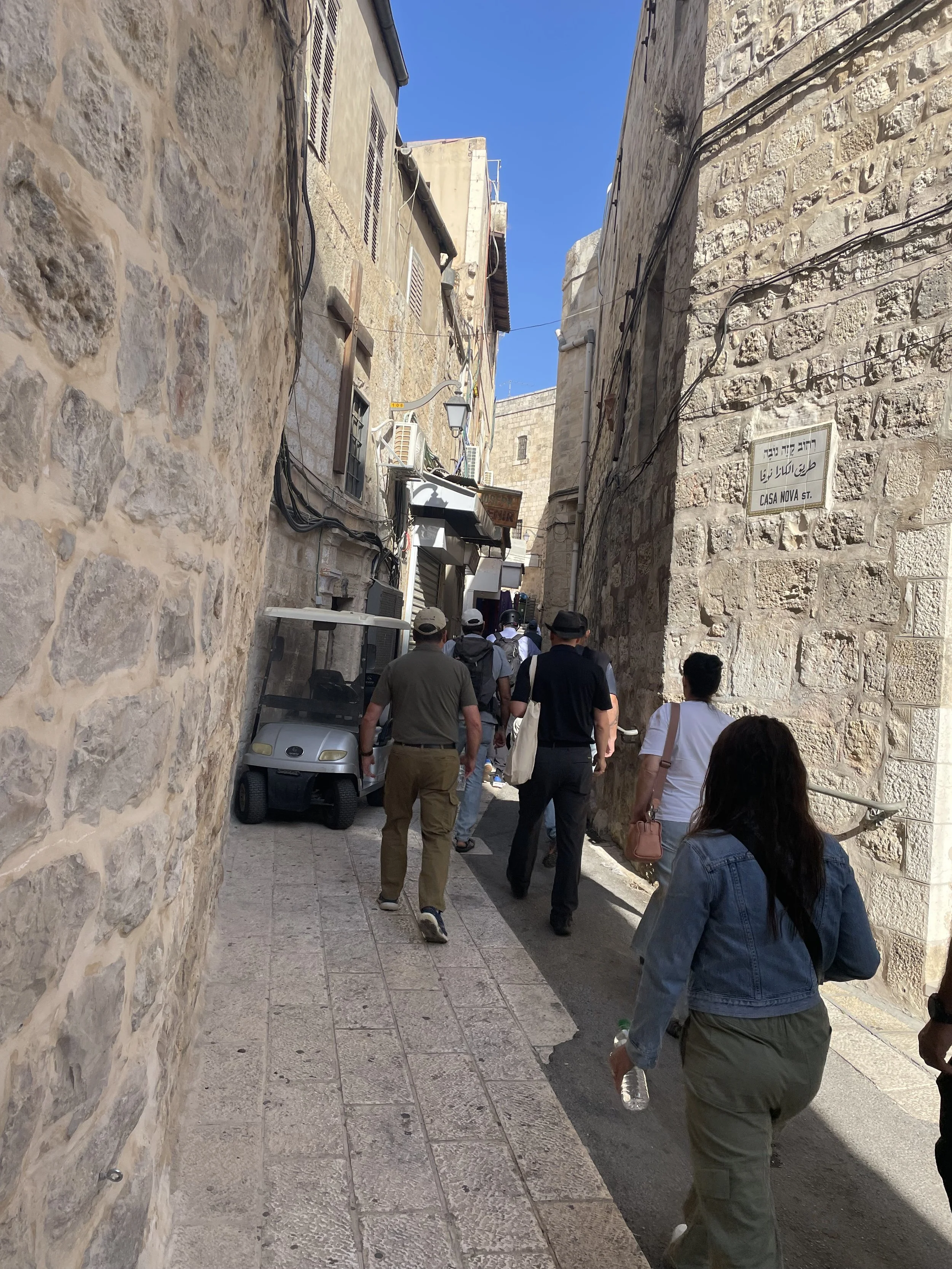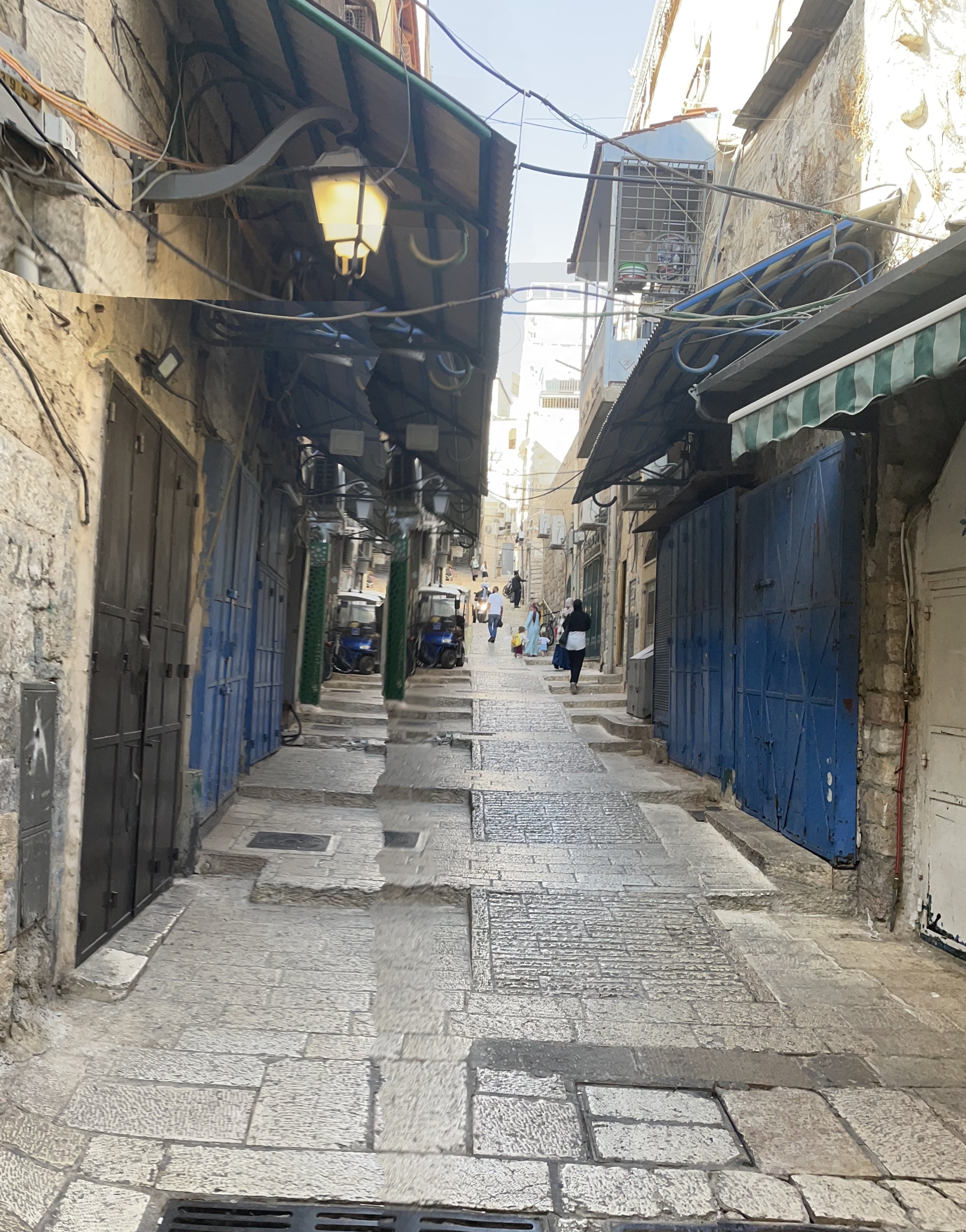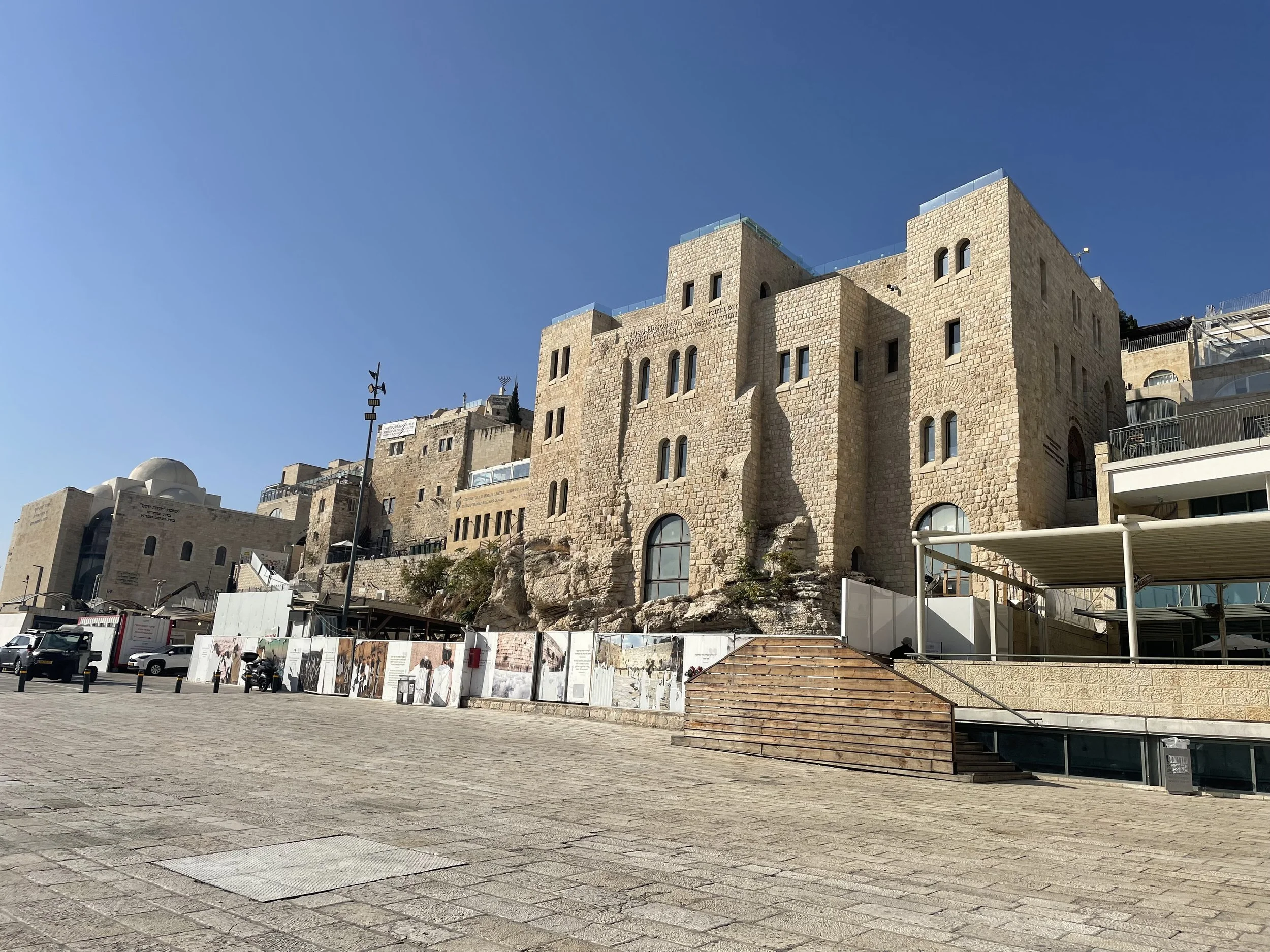By Scott Taylor
Introduction: From 17 - 24 October Esprit de Corps Publisher Scott Taylor embarked on a week-long introductory 'fact-finding' mission to Israel. The trip was organized and funded by the Toronto based Exigent Foundation and their intent was to provide the participants with the Israeli side of the current conflict. In a war as historically deep rooted and as complex as the ongoing strife in Israel, there is not one 'truth' but rather a multitude of 'truths' depending on the vantage point of the observer. As such the following observations are provided by the author as they were presented to him. It is by no means a complete, or balanced perspective of the conflict but rather one side -the Israeli side as they want it told to the world.
FRIDAY OCTOBER 17: Our Air France flight arrived at Tel Aviv International Airport around 15:00. We had departed Toronto Pearson the previous evening and connected through Charles de Gaulle in Paris. In total, our group consisted of 9 Canadians with some of the group arriving on a separate KLM fight via Amsterdam. Only one member of the group, a Kurdish-Canadian who was born in Iran, had any difficulty with Israeli border officials. After a lengthy three hour delay, some calls were made, assurances given and our colleague was eventually granted entry. It was a reminder of just how seriously the Israelis take their national security. For many of us the bus ride from the airport was our first glimpse of Tel Aviv's towering skyline of office and condo towers. US President Donald Trump had addressed the Knesset in Jerusalem just 4 days ahead of our arrival. Strategically placed on the main airport road was a towering eight storey high billboard with a giant poster of Trump and the words 'Thank You Mr. President."We checked into, a Boutique hotel on the famous Rothschild Boulevard (To put this into perspective, Independence Hall, where the Israeli Declaration of Independence was signed in 1948, is at number 16 Rothschild Boulevard). After stowing our luggage, the group walked to dinner along the bustling tree lined boulevard. This was the Jewish Shabbat (sabbath) evening, when most Israelis return home for a family meal, but in this popular corner of Tel Aviv the restaurants, and patios were still crowded. My first impression of Tel Aviv was that of a modern, vibrant European city as opposed to a major urban centre in the Middle East. We had reservations on the patio at the Radler Restaurant and the food was excellent. My meal was Tempura shrimp which, I only later learned that shellfish are not Kosher. I would further learn that Kosher does not permit mixing meat with dairy, so no meat toppings on pizza and no cheeseburgers for the week.
SATURDAY OCTOBER 18: Day one begins with a full buffet breakfast at Hotel with the group boarding the bus around 8:30 am. We head north out of Tel Aviv up the coast to Ceasaria. This popular tourist site is a great place to start the mission as it dates back some 2,000 years. The original city had been built by King Herod, who was appointed as King of the Jews by his Roman masters. Hence the name honours Herod's imperial Roman Emperor. Lavish would not begin to describe Herod's taste as the theatre, sports arenas, castle -complete with pool and elaborate bath houses were all adorned with the finest marble. Like a core sampling of Israel's history and fortunes, Ceasaria contains the ruins of all those who occupied the site over time. The Romans morphed into the Byzantines (Christians) who neglected Herod's former showcase before the Crusaders took and held this corner of the Middle East as a major logistical hub for two centuries. The Ottomans would rule it for the next 500 years, and the British spent just 30 years controlling it as part of the Palestine Mandate. Of course every new occupier spent time trying to erase all traces of the former occupants. The walking tour of Ceasaria lasted about two hours in the blistering heat (35 degrees) and involved a lot of stairs, particularly in the ancient theatre. We depart the site and head south, past Tel Aviv and Haifa almost to the northern end of the Gaza Strip. Here we turn inland and our destination is a Kibbutz. The host of our group luncheon is Canada's former Ambassador to Israel, Vivian Bacovici. We dine on rotisserie chicken from the BBQ and smoked salmon. On hand beer and wine is on offer. This particular Kibbutz is now a temporary refuge for many evacuees from the nearby Kfar Aza kibbutz which was hit hard on 7 October, 2023 in the Hamas mass terror attack. One of our guests is a survivor from Kfar Aza and he gives us a brief preview of what we will later hear and see when we will tour that damaged kibbutz. When asked what needs to happen to end the circle of violence he replied "we need to give the Gazan people hope." Which I found encouraging, coming from someone who had lost family and friends to the Hamas terror attack. Vivian Bacovici takes the time to show us a tribute on her Kibbutz to those from the settlement who have been killed in the fighting to date. We then return to Tel Aviv to Dizengoff Square which has a major grass roots memorial to the victims of 7 October attacks. Cafes and restaurants around the square are crowded on this bright sunny and warm evening. Group dinner that night is again down Rothschild Boulevard at the open air Europa Cafe. This time I opt for a beef tenderloin skewer and some white wine. Once again on the long walk back to hotel, it is evident that Tel Aviv has a lively nightlife for a largely youthful demographic. One general observation was that up until this juncture there was a noticeable absence of uniformed Israeli Defence Force (IDF) personnel on the streets. There were no checkpoints or military vehicles on the road even near the northern border of the Gaza Strip. At Ceasaria we had seen one reservist in civilian clothes sightseeing as a tourist but with his assault rifle slung over his shoulder. My first impression was that Israel did not have the feel of a nation mobilized and engaged in a bitter conflict.
SUNDAY OCTOBER 19: I arise early to catch up on work related correspondence and to enjoy another buffet breakfast at the hotel. Geoff with the Educational company joins our tour. Geoff is an American who served in the IDF and became an Israeli citizen. The group bus departs at 8:45 for the University of Israel University campus. As we transit rush hour traffic through Tel Aviv we see many young reservists and soldiers returning to their units via public transit. A professor of Iranian studies walks us through the complicated long standing historical relationship between Oran (Persia) and the Jews of Israel. This overview spans from the biblical Persian King Cyrus the Great who allowed the Jews to return to Israel to create a homeland in 539 BC to the recent, brief war between Iran and a US assisted Israel. The group then walked to IDF Public Affairs headquarters. As we were early in our arrival we used the time to grab a quick lunch. This was in hindsight opportune as upon our return to the IDF HQ we were given a detailed briefing on the actual events of 7 October 2023 Hamas terror attacks. Our primary point of contact was Joey, a 20 year old IDF volunteer soldier who hailed from Florida. He was a little nervous but he knew his material.The IDF had compiled all possible imagery from that fateful day which had been captured on body cams of the attackers and security cameras in the homes and the perimeters of the victims. These images amounted to an hour long raw snuff flick marathon wherein we watched over and over again as people were murdered in cold blood. In many cases the attacking Hamas terrorists were gleeful in their handiwork as they shot fathers in front of their sons, gunned down elderly Israelis in the street while chanting Allah u-Akbar. It was very difficult to watch the attackers cut through a lifeless IDF soldiers throat and eventually hold the decapitated head like a trophy. The sequence of footage was strung together to give the viewer multi views of the separate murders or in some cases abductions of the victims. There was also footage of the jubilant reaction of crowds of Gazan civilians when the attackers returned into the strip with battered hostages bundled into the back of their pick-up trucks. It was an incredibly disturbing and graphic video which drove home the scale of what had happened in those attacks. In total, 1,195 people were killed by the attacks: 736 Israeli civilians (including 38 children), 79 foreign nationals, and 379 members of the security forces. While attending the Nova music festival, 364 civilians were killed and many more wounded. Our briefing also included some of the wreckage of the ultra-light aircraft used by the Hamas terrorists in their initial attacks and some Virtual Reality headsets that put us into the Palestinian tunnels which had been discovered by the IDF during their two years of bitter fighting in the Gaza Strip. However, this info was all anti-climactic after being shown that horrific video footage. Our next stop was at what became known as hostage Square which is located directly across from the Ministry of Defence buildings. In the immediate wake of 7 October Israelis had gathered here on a constant basis to demand the return of the hostages and to mourn the loss of the victims. However, as the last living hostages had been released just days earlier as part of the President Trump brokered ceasefire between Hamas and the IDF, the square was largely deserted when we visited. There were still all sorts of tributes to the fallen, including a mock tunnel that enabled visitors to get a sense of what Israeli hostages would experience during their captivity in Gaza. Our final destination that day was to the port of Jaffa wherein we could browse the old bazaar and the outdoor cafes. It is in the old port that I-24 (Israel's 24 hour television news station) is located and we were given a guided tour of the studios. They broadcast a 24 hour news cycle in Arabic, English and French in recognition that information dissemination is a major part of modern warfare. Our group once again walks Rothschild boulevard to Restaurant Bicicletta. This is an incredible outdoor venue. I avoid the shellfish and opt for the fish and chips instead.
MONDAY OCTOBER 20: We arise early, and take advantage of the breakfast buffet. The group bus departs at 08:00 sharp and we head south out of Tel Aviv. Again we head past Haifa on the coast and as we approach Sderot we turn inland away from the nearby Gaza Strip. Our first stop is at the Kfar Aza Kibbutz and the same individual from Ambassador Bacovici's luncheon is to be our guide. What was immediately striking was that we were now walking the same ground wherein the day before we had watched video footage of people being brutally executed by gleeful Hamas attackers. The visuals were still fresh in my mind and that made the visit somewhat eerie. We were shown where the attackers had first arrived in the early morning hours of 7 October. This attack coincided with the end of the Jewish Sukkot holiday.
Sukkot is a major, week-long Jewish festival (also known as the "Festival of Booths" or "Harvest Festival") that is considered a time of great joy, focusing on giving thanks for the harvest and commemorating the temporary dwellings (sukkot) the Israelites lived in during their 40 years of wandering in the desert. The timing of the attack, on a major, joyous holiday when people were often celebrating in the streets and security forces may have been less vigilant, is believed to have been deliberately chosen by Hamas. We were shown the arsenal building which housed the weapons used by the Kibbutz's self defence force. Apparently the Hamas attackers were aware of the location of the arsenal and used a sniper to prevent defenders from arming themselves. A special tribute was attached to those members of the self defence force who died that day trying to protect their families. Throughout the ruins of the Kibbutz there were many placards identifying the victims and showing where they had fallen. There was also identifiers of those taken hostage that day. Twin brothers had been abducted and held by Hamas there was a celebratory tribute to them for the 28th birthday that they had marked in captivity before being released just days earlier as part of the ceasefire. As our tour concluded, other buses had arrived and our guide left us to start the next walking tour of this massacre site. It was clear that Israel wants its citizens (and foreign observers) to fully understand the horrors that unfolded that day and the personal impact it has had on the surviving victims. Our next stop was the Heim Nova music festival site where so many young Israelis had perished and been abducted. again, many of the videos we had watched had been taken at this site and it was a morbid endeavour to be walking the same ground. The site has also become something of a tourist attraction as it is a powerful shrine to the 364 civilians who perished here on 7 October. Every victim has a photo placard to commemorate their lives. As it was impossible to remember all of them, we were asked to select just one individual to remember. I selected Chief Kim Dukarker, a 22 year military policewoman. Again, it was difficult to not notice just how young these victims were. Just outside of the Nova Festival grounds was a concrete bomb shelter wherein many people fleeing the rocket attacks had taken shelter. Apparently some 30 Israelis had crammed in to seek shelter but when Hamas gunmen arrived it proved to be a death trap. Grenades were thrown in, and promptly thrown back out by the terrified occupants. However in the end all inside were killed or dragged into captivity. As people tried to flee the Hamas onslaught that day they drove down the only major roadway -route 232. It was on this stretch of highway that Hamas wreaked havoc. The hundreds of cars damaged and destroyed along route 232 have been gathered at a single point along with a number of the destroyed vehicles that were in use by the attackers. This site has also been turned into something of a shrine for the victims. One wreck is adorned with a trailing flow of poppies in memory of the victims. What was interesting is that a large number of IDF reservists were visiting this site, no doubt as a motivational reminder as to why they must remain vigilant. Tour guide Geoff had a number of anecdotes regarding several of the wrecked cars and trucks. In many of these tales there were acts of heroism performed by the drivers who risked their own lives that others may live. Geoff also pointed out that at Kibbutzim the head off the self defence forces always drove a white pick-up truck. Several of the damaged vehicles on display were in fact the white pick-up trucks used by Hamas in their attacks in order to lure Israeli civilians into a false sense of security. Our next stop was a soldiers' rest station just a 9 minute drive from the Gaza Strip border wall. This establishment is known as the Shuva Brothers and it was first set up as a volunteer aid station on October 8th the day after the Hamas attack. The site had become a mass casualty evacuation centre for the victims and of course the IDF were in the midst of a major counter insurgency operation. The idea was to distribute refreshments, meals and military kit to the hastily mobilized IDF reservists. Two years later this oasis from the war remains a bustling hub.Through international media publicity the Shuva Brothers have established for themselves a reputation as truly selfless supporters of the troops. Our group enjoys one of the best meals of the trip at this rest stop, with a local 80 year old farm woman treating us to rice and meatballs. Many of the IDF soldiers at Shuva Brothers rest stop had come from the fighting in the Gaza Strip. Some of them had borne witness to the hostage exchange which secured the ceasefire agreement. They eagerly shared video views from the frontlines. Before the drive back to Tel Aviv we visited an Israeli village just north of the Gaza Strip border wall. They too had been surprised on the morning of 7 October and forced to flee their homes. It is here that Joey, the IDF soldier joined our group for the return trip in the bus. He proved to be very knowledgeable about his adopted nation's history and dedicated to the Israeli cause. In researching our group he had realized that he had in fact watched the National Geographic episode of their Locked Up Abroad series which depicted my own hostage ordeal at the hands of Islamic extremists in Iraq in September 2004. This was a 'free' evening for the group and I had made arrangements to meet with a good friend and former Israeli military attache to Canada. Although he is an Air Force colonel in the IDF, I asked only after the safety and well being of his family whom we had gotten to know during their posting to Ottawa. Dinner was a hamburger with a side of calamari (no fries).
`
TUESDAY OCTOBER 21: We arise early as we must pack, eat breakfast and check out of the Hotel. The bus departs out of Tel Aviv headed north to the Lebanese border. We travel the coast road and pass the landmark power plant at Ceasaria. We are to visit two kibbutzim which suffered damage from Hiz Bollah rocket attacks from inside Lebanon. A common phrase that we hear is "People make borders'. and this is meant in tribute to the resolve of those inhabitants that risk their lives to continue living in these border villages and kibbutz which are in range of hostile fire. Following the 7 October Hamas attacks, Hiz Bollah in Lebanon had begun shelling Israeli targets. In September 2024, Israeli intelligence scored a major coup when they simultaneously detonated the pagers belonging to the majority of Hiz Bollah's leadership across Lebanon and Syria. this was dubbed Operation Grim Beeper. The IDF followed this with a full scale invasion of Southern Lebanon to clear a buffer zone. From the first kibbutz we could see beyond the large concrete border wall into Lebanon. The distant villages had been reduced to rubble and we were told that the IDF still maintains a limited presence in forward areas well inside Lebanese territory. This kibbutz also had a homemade armoured vehicle dating back to the 1947 war of Independence. A grim reminder of just how long this has been a frontline. At the second Kibbutz, the head of the self defence force arrives in a white pick-up truck to reinforce Geoff's input from the previous day. We are taken on a tour of the impressive concrete border wall which will soon be heightened with additional barbed wire. We visit a site just inside the border where an Israeli patrol had been ambushed and the bodies were removed into Lebanon. The whole area looks like a massive fortress or a gigantic penitentiary. We are shown the entrance to one elaborate tunnel which Hiz Bollah had used to penetrate this fortress and our security guide explains that they must constantly be vigilant to the creation of new tunnels. The Hiz Bollah will patiently toil for years to bring them to completion. We next drive east towards the Golan heights before driving north through the upper Galilee Valley to the town of Mitula. Here we see again the closeness of the northernmost urban centre of Israel to the Lebanese border. Our local contact explains that while he has returned following the fighting many of his neighbours have not. his own house has shell and rocket damage and he is slowly rebuilding his life here. In the distance are the rubbled remains of nearby Lebanese villages that were used to house Hiz Bollah militants. Again we are told that IDF patrols remain well forward of the actual border. Our giuide is himself a member of the local self defence force. He is determined to remain regardless of the danger . "People make borders.' Between his house and Lebanon is a wire fence and a few crude concrete bunkers. We then drive to a Druze village of Majdel Shams, also on the northern border. We are given a quick description of the Druze people as a mystical sect once affiliated with Islam. Their core belief is that there is a constant number of Druze on the planet: every time one is born another dies and likewise each death corresponds with a birth. They also believe in a form of reincarnation. The village is a picturesque mountain town, again within sight and within range of Lebanon. we visit the sports field that was the site of a rocket attack in September 2024 that left 12 local children dead. This was the trigger point that launched the full scale IDF invasion of southern Lebanon later that month. Enroute to our lodgings for the night, with the light fading, we look out over the Golan Heights into Syria. It was through this corridor that the IDF stopped the Syrian invaders in 1973's Yom Kippur War. It is believed that on this site was fought the 2nd largest tank battle in history. The Israelis were victorious. We check into a fabulous resort hotel which is a retreat-spa on the Sea of Galilee. Supper was a generous hot buffet complete with delicious local Israeli wines.
WEDNESDAY OCTOBER 22: We are once again up at the crack of dawn. We have just enough time to take in the luxurious surroundings at our resort, knowing we will have no time to actually enjoy them. We check out after breakfast and board the bus at 8:00 am. We briefly drive back north to the Golan Heights wherein we enter a former minefield. This had been the Syrian front lines from 1947 - 1967 and the area was pock marked with old bunkers and dugouts. Prior permission had not been obtained so our group was instructed to vacate the site. Instead of the drama of getting our briefing in a cleared minefield, guide Geoff gave us our 'Six Day War (1967) primer in the parking lot. One of his anecdotes involved an Israeli spy (Mossad) infiltrating the senior ranks of the Syrian high command. On the spy's instruction the Syrian Army planted fast growing eucalyptus trees around their bunkers to provide shade. Hence when hostilities opened, the IDF knew exactly where to target (i.e. the eucalyptus trees). As we roll south, the place names remain overwhelming. We are in Nazareth heading towards the Dead Sea enroute to Jerusalem,
It does not get much more biblical than that. We are driving parallel to the Jordanian border which while defined by fences and walls is far less imposing than the concrete structures at Gaza and the Lebanese border. At Qasar al-Yahud we stop to visit the famous Christian baptism site on the Jordan River. Here there is a large IDF outpost on the Israeli side but the actual border is simply a twelve metre expanse of muddy water. Christian pilgrims from both sides of the River enter the waters to receive their baptism from a cleric. The public restrooms here are incredible. The handicapped stall was the size of a New York condo and spotlessly clean. Our route to Jerusalem transits the territories of Samaria and Judea, otherwise known as the West Bank, or the Occupied territories. There are no check points of any sort and we witness no IDF presence on the roads. We pass Jericho with the edge of the Dead Sea visible in the distance. At the gates of Jerusalem there is a police checkpoint but everyone is simply waved through to keep traffic flowing. On the day we arrive, US Vice President J.D. Vance and US Secretary of State Marco Rubio are in the Holy City on their own visit. Their motorcades and escorts make traffic a nightmare for our driver. We have a lunch break at the former Jerusalem train station which has been converted into a large open air food court.
Our next stop is a tour of the Knesset (Israel's parliament). this was where US President Donald Trump had spoken only days earlier and where Egyptian President Anwar Sadat had announced peace in 1977. In other words a very notable landmark. Prior to our guided tour beginning the guy from the Shuva Brothers rest stop greets the group. He is at the Knesset on other business but it is a reminder of just what a small world we live in. We get a history lesson of the Knesset and a primer on the complex multi-party system of which it is composed. The need to make a coalition to form government (and stay in power) has resulted in 5 elections in just four years. The Knesset is very interactive and transparent right down to the public having real time access as to members' attendance and how they voted on issues. All very high tech. All committee meetings are live streamed and public. We get a 20 minute private briefing from Member of the Knesset Amit Halevi. He is a member of the Likud (ruling) Party and a member of the defence committee. He is a hard liner who stated after the ceasefire that the deal was "Humiliating. ...the nation should have bowed its head today and lowered the flag to half-mast" Halevi told the Times of Israel. He added that Israel should have announced "to Hamas and to the whole world that the Jewish people will not forget or forgive until the complete annihilation of the Neo-Nazis in Gaza and the restoration of Israeli control over this strip of our homeland." That concluded the formal tour for the day. We check into the Hotel and grab dinner in the central market.
THURSDAY OCTOBER 23: Our last day of the mission starts with a buffet breakfast in the rooftop restaurant of the Hotel. This provides us with a 360 degree view of the spectacular city of Jerusalem. We Check out and store our baggage with the front desk. This day will be a major walking tour of the Holy City. My colleague's fit bit clocked out at 24,000 steps by day's end and that was under sunny skies with a temperature hitting 35 degrees. We trudge to the old City. we cannot enter through the famous Jaffa Gate as security have cordoned it off for the visit of VP Vance and Rubio. We enter through the Damascus Gate and make our way through the narrow cobble stoned streets to the Temple Mount. This portion of the Old City is technically under Jordanian control. We pass through security and climb the ramp. The Golden Dome dominates the skyline and it is from here that the muslims believe Mohammad rose to heaven. There is also a huge Mosque on the Mount Temple site which is directly above the Western Wall. this of course is a Holy Jewish site wherein visors will pray before tucking a written message into cracks in the wall. This is believed to be a manner of commuting your message to God. Men and women have separate areas of the wall from which to worship. We backtrack from there to commence our walk along the Via Dolarosa. The Via Dolorosa is a processional route through the Old City that represents the path Jesus took on the way to his crucifixion. It is also known as the "Way of the Cross" and features 14 stations that mark significant moments from the Passion of Christ, beginning in the Muslim Quarter and ending at the Church of the Holy Sepulchre in the Christian Quarter. The route is a significant pilgrimage site for Christians. We end up at the Church of the Holy Sepulchre which houses Christ's elaborate tomb. We learn from the internet that J.D. Vance had in fact toured the same site just minutes before our arrival. We walk back to the Hotel where the group splits up for lunch. A shawarma at an outdoor cafe does the trick. Our last official mission task is a zoom call with a Palestinian Gazan who now resides in the West Bank. During the discussion he complains about the hardship of living life 'under occupation' by the IDF. This is challenged by members of our group who feel he does not take any responsibility for the actions of Hamas on 7 October 2023. Our 'Last Supper' in Jerusalem is back in the Old City at the Eucalyptus restaurant. The owner is a top chef and he has his own cook book. We dine on Israeli specialties paired with local wines. For all intent and purposes this marks the end of the tour. All that is left is the long trek home.
Remembering Canada’s Hong Kong veterans
The 80th anniversary of VJ Day honors Canada's Hong Kong veterans, who endured brutal conditions as PoWs after the 1941 Battle of Hong Kong. Many suffered lifelong disabilities. Despite decades of advocacy, compensation came late. Their courage and struggle for recognition highlight a powerful legacy of sacrifice and resilience.
MUSINGS OF AN OLD SALT: Down the RCN's Memory Lane
My dad and I visiting an RN ship in Halifax c. 1957
By Gerry Curry
So, I know I’m an 'old salt' and I’ve been 'out' of uniform for a very long time. I keep trying to understand the navy today, but frankly, I just don’t get it. It seems less Royal Canadian Navy and more the Army’s vision of what a navy should be.
I was born in 1949 to a serving naval officer. My dad served as a telegraphist in the RCN during the war, before receiving his Commission. He then served in a number of ships, most of which I remember visiting, including; the cruiser HMCS Quebec, a couple of Tribal class destroyers and a few Prestonian class frigates. He also served in HMCS Stadacona on Rear Admiral Roger Bidwell’s staff when he was Flag Officer Atlantic Coast. The admiral was a huge supporter of the Royal Canadian Sea Cadet programme and recognized my dad’s interest in youth programs. In 1957 my dad was drafted to the Area Office Sea Cadets, Maritime Area, and remained in that post for some time. First supervising the Sea Cadet program in Nova Scotia, then Newfoundland and finally Ontario. This required all of us in our family moving every summer, first to HMCS Acadia in Cape Breton then HMCS Cornwallis, along with other RCN personnel, to run the summer sea cadet programs. My dad retired in 1965.
My dad and I, Wardroom Christmas celebrations, HMCS
Penetang, 1954
All of that time, I was totally aware that I was in the 'navy family.' When you joined the navy, you served in the navy and you left or retired from the navy. It didn’t matter if you were serving aboard a ship or ashore, you were always deeply embedded within that family. Shore establishments were treated like ships. You never walked on a 'floor,' marched on a 'parade square,' or ate in a 'cafeteria.' It was always the 'deck,' 'parade deck' or 'mess/wardroom.' It was all about continuity. You wore a proper uniform whenever in the public eye and often you were inspected before proceeding ashore. Work dress was only worn aboard ship, and even then, only when you were doing 'dirty work.' The pride was palpable. You did occasionally come into contact with soldiers and air men/women, but they were definitely not within the family and somehow you always felt sorry for them.
When you signed up you joined the navy. When you started training you immediately started the transformation from a mere civilian to that glory of glories, a sailor. When I was very young you didn’t even join in a trade. You simply joined the navy. Aptitude tests were done during 'New Entry' training and you were assigned to a trade based on the results of the tests and the need (mostly the need I suspect) You eventually became a journeyman sailor. Only then did you go on to learn your trade. You might even go to sea for a wee bit before your trade course started.
The navy and its sailors were also directly responsible for a far greater range of activities back then. We were truly responsible for ourselves and our ships and facilities; we painted our own ships, and we did far more maintenance on our ships and other facilities. We had far, far fewer civilians on the payroll and even fewer civilian contractors doing our work for us. If the poop-hit-the-fan, we had a far greater number of real sailors in uniform, ready to answer the call.
One never forgot that you were in the navy family. Starting out you lived aboard your ship or in a naval accommodation block (never called a barracks). Living aboard ship helped you to truly integrate into your new family. The ties between a sailor, his shipmates and his ship usually went very deep indeed.
As you got older you might get married. When you did, there was Married Quarters. Apartments and homes were available for both officers and enlisted personnel. There were schools for the kids too. If your husband was away at sea, wives were surrounded by other members of the family. It didn’t matter if you were a serving sailor, a wife or a kid, you were all part of the family. Before universal health care we all went to the Naval Hospital for care. All of our shots, regular checkups and medication were looked after by the Naval Nursing Sisters at the Well Baby Clinic. I remember this with great fondness.
At thirteen I joined Sea Cadets and in 1965 six days after my sixteenth birthday, I joined the RCNR, in HMCS York. I served at sea for much of that time in HMCS Sussexvale, HMCS Mackenzie and HMCS Bonaventure. Unfortunately, when I finally joined the regular force there was no RCN to join. Instead I joined the unified Canadian Armed Forces (CAF), still in my old trade, and got shipped off to Canadian Forces Recruit School Cornwallis. What a huge shock. I had grown up visiting HMCS Cornwallis regularly and lived there for a spell. I couldn’t believe how dirty and poorly organized CFRS Cornwallis was compared to its previous naval life. And it was chock-o-block full of those 'other guys!' As such there was; no morning Divisions, no Saturday morning Ceremonial Divisions, and not even a band along with to march. I learned nothing worth learning there. I left confused and very sad. Entering the CAF in my old trade meant that I went straight to sea, helping to commission HMCS Preserver. If you were colour blind or didn’t look at the uniforms you might not notice too much of a difference, but already some of those 'other guys' were showing up and they were definitely not sailors (poor souls!). Going ashore it was very confusing. It was still 'Stadacona', but yet it somehow wasn’t. That 'CFB' designation made a huge difference, and there were even more of those 'other guys' around.
For good or bad, virtually all that I grew up with seems to be gone now, and with it I fear, is the sense of family.
Oh, we got our old uniforms back… sort of. The officers got their executive curl back, but we still wear army rank badges. To me, two chevrons is either a 'two badge ab' or a corporal, not a leading seaman.
A ship is not your home anymore. You can no longer live aboard, and you even have to pay for your meals in home port. I understand that sometimes they even close the galleys down and bring box lunches in. The 'base' is not a stone frigate anymore, Sailors and their families now live on 'civvy street.' To an 'old salt' like me it seems like the RCN is now just another branch of the civil service, and the government seems to be happy that is the case. And don’t get me started on the un-tailored, ill-fitting, grubby uniforms being worn in public by equally poorly groomed, often overweight, scruffy people, officers included.
As we used to say: 'different ship, different cap tally'. Of course today we’d have to explain what a cap tally was.
Editor's Note: 'Tally' is old Navy slang for 'Name', thus a 'Cap Tally' was the ribbon on a Sailors cap which was emblazoned with the wearer's ship's name.
1. My dad and I, Sea Cadet Bandsman Course, HMCS Cornwallis 1964. I’m Back row, 6th from the left. Dad front row 4th from left.
2. CFRS Cornwallis graduation June 1971. 3rd row on left.
3. At the tiller of a whaler under sail, HMCS York, Toronto, 1965.
4. Aboard a Japanese destroyer during the Centennial Fleet Review, HM Dockyard, Esquimalt, BC. I was RCNR serving aboard HMCS Mackenzie.
5. Formal portrait Humber College, circa 1970.
6. Today.
THE REAL BALLOT QUESTION IN THIS ELECTION: IT’S BIGGER THAN YOU THINK
By Jamie Baillie
For the first time in our country’s history, we face the very real prospect that we will be alone in the world, without strategic allies to share in our mutual defence. This will be a new and unsettling feeling for Canadians. Since Confederation, we have been a partner in the strongest defensive alliances in the world: the British Empire, NORAD/the USA, and NATO. The integrity of our national borders, including the Canadian North, has been protected and unquestioned from 1867 to 2025. That is about to change.
At recent Policy Insight Forum meetings at NATO headquarters and the European Commission offices in Brussels, I observed this shift firsthand. Two stark realities emerged: NATO and the EU are seriously preparing for a possible US withdrawal from NATO; and Canada is not assured a spot in a newly constituted Europe-only NATO. Far from it.
NATO membership is centred on the famous Article 5 commitment that “an attack on one is an attack on all” and that every member will come to the defence of the attacked nation, with armed force if necessary. We can not expect Europe to provide this kind of defence commitment to Canada.
Canada is sandwiched between Russia and the United States. The threat from Russia is real and obvious. Now we also face a new kind of threat from US President Donald Trump. He has made it clear that he does not consider Canada to be a “real country.” He calls our border “fake” and openly mocks our military capabilities. He has also called on Russia to “do whatever they want” with NATO countries that fall below the NATO 2% of GDP spending commitment. Canada is one of those countries.
As the western world reorders, Canada can no longer take the deterrent provided by NATO membership, or our continental defence partnership with the United States, for granted. We will be a strategic orphan. To survive intact, we will need a plan to take 100% responsibility for our own defence, security, and border integrity. That work begins now.
We are currently in the midst of a national election campaign unlike any we have seen before. The issues that seemed so urgent a few months ago: carbon tax, housing, cost of living, as important as they are, have faded into the background. Instead, we face a real existential threat to our national sovereignty and our ongoing existence as an independent nation
Political pundits say the big issue in this election is: Who can stand up to Trump? This oversimplifies our national dilemma. The real question we must answer is much bigger: Can Canada defend itself? And who has the best plan to assert our sovereignty and defend our country from all threats around the world?
As a country, we have proven our ability to stand up to aggression and defend Canadian values around the world. Now we must tap that same energy, drive, and investment to become a strong self-defending country on our own soil. We must learn to ensure the borders and sovereignty of the second largest country in the world. We may be responding to new external threats, but we are also taking the essential next steps in the maturation and development of Canada. This is the challenge of our generation. Together we have built a great country with a distinct culture and shared history. It is worth defending, all of it, and we must prepare to do it on our own.
Your kids and future generations of Canadians will thank you for getting this right.
Hon. Jamie Baillie, FCA is the Managing Director Atlantic for the Samuel Group of Companies, and an Industry Liaison for the non-profit Policy Insights Forum.
KEEPING HIS MEMORY ALIVE: MCpl Mark Isfeld and the 'Izzy' Dolls He Inspired
MCpl Mark Isfeld atop a M113 personnel carrier in Croatia circa April 1994
By Scott Taylor
Alda Gysen displays her Izzy dolls that were knitted by her daughter Michelle Deverll in 2025
A long and winding tale: In April 1994 I met MCpl Mark Isfeld in Croatia. He was there as a UN Peacekeeper and I was covering the war as a correspondent. The photograph I took of MCpl Isfeld became the Esprit de Corps cover of the May 1994 edition. Tragically, MCpl Isfeld was killed the following month in Croatia by a landmine (21 June, 1994). As a tribute to her son, Carol Isfeld began knitting what she termed 'Izzy Dolls'. Her intention was to have Canadian Peacekeepers distribute them to impoverished children in war torn countries. This soon became a nationwide effort as thousands of women began knitting their own versions of the Izzy dolls.
I had the honour to meet Brian and Carol Isfeld (Mark's parents) while researching a story for Readers Digest. Both have since passed. However the Izzy dolls continue. At my Mother-in-Law's residence her neighbour, Alda Gysen has a treasure trove of Izzy dolls that were knitted by her daughter Michelle Deverll. Kudos to all of those keeping alive the memory of MCpl Isfeld and by extension the service of those who serve as peacekeepers.
Transforming Lives: Bold Support for Canada’s Defence Community
(From left) Honorary Colonel Omar Abouzaher and Rick Campagna of BMO attend the 2024 Vimy Gala along with residents and administrators of Perley Health, a long-term care facility for seniors and many cherished Veterans in Ottawa. Rick serves on the Board of Directors of the Perley Health Foundation.
By Brenda Moring
BMO’s relationship with the Canadian military began within a year of its founding in 1817, when the bank began providing banking services to the Governor of Upper and Lower Canada to finance administrative and military life. Since 2008, BMO has been the Official Bank of the Canadian Defence Community, serving the banking needs of regular force personnel, reserves, recruits, military families, Veterans and retirees, as well as Department of National Defence and Staff of the Non-Public Funds civilian personnel, the Royal Canadian Mounted Police and the Canadian Coast Guard.
BMO’s commitment to the Canadian military is deeply rooted in the bank’s Purpose to Boldly Grow the Good in business and life. Across three pillars – customers, communities and colleagues – the bank is dedicated to enhancing the lives of military personnel, Veterans and their families and helping them make real financial progress.
BMO Branch Manager Kevin Cheung visits a local Reserve Unit in Vancouver to collect inspiring messages on yellow sashes to be hand-delivered to athletes from all nations during the Invictus Games in February. Colleagues, customers and partners are invited to share their words of encouragement and support
In Ottawa, this is evident by the tireless work of BMO Personal Banking Regional Vice Presidents Riccardo (Rick) Campagna and Omar Abouzaher, who advocate for military-ready programs and initiatives and strengthen cultural connections between organizations. Last April, Omar was named Honorary Colonel of the Governor General’s Foot Guard.
Annually, Rick and Omar represent BMO as presenting sponsor of the Canada Army Run. In December, they joined Lieutenant-General Michael Wright, Commander Canadian Army, to present a 2024 Canada Army Run donation cheque totalling $400,000 to Support Our Troops and Soldier On, building on BMO’s $100,000 multiyear gift to Support Our Troops.
Customers: Tailored Financial Solutions
More than 112,000 members of the Canadian Defence Community bank with BMO, facilitated by approximately 90 branches serving more than 33 military bases, wings and units across Canada. The Canadian Defence Community Banking (CDCB) program, designed to meet the unique needs of military members and their families, offers a range of benefits, including:
• No Monthly Fee Performance Chequing Account: This account helps military personnel save on banking fees and includes features like unlimited Interac e-Transfers and five non-BMO ATM withdrawals per month. In 2024, CDCB customers saved over $21 million in monthly banking fees.
Honorary Colonel Omar Abouzaher poses with members of the Governor General’s Foot Guards regiment at the Canada Army Run in September 2024. The Ceremonial band also performed on the grounds of Rideau Hall to encourage the runners. The Guards’ presence showcased their vital role in both ceremonial and operational capacities, demonstrating the ongoing commitment to excellence within the Canadian Army.
• Mortgage Flexibility: BMO offers flexibility to break mortgages without penalty for those posted through the Canadian Armed Forces Relocation Directive.
• BMO Support Our Troops Mastercard: A portion of every purchase made with this BMO credit card goes toward Canadian Forces Morale and Welfare Services programs, generating more than $1.1 million in donations to date.
These tailored banking solutions demonstrate BMO’s commitment to helping military families make real financial progress.
Communities: Strengthening Bonds
and Providing Support
BMO’s relationship with the Canadian Defence Community is a deep and holistic partnership. The bank actively supports initiatives aimed at improving the lives of military personnel and their families. Community support includes:
Invictus Games 2025: From February 8 to 16, BMO is proud to be an Official Gold Sponsor of the Invictus Games Vancouver Whistler 2025, bringing together wounded, injured and sick service personnel and Veterans from over 20 nations to compete in adaptive sports. Supported by leading organizations and approximately 1,600 volunteers from across the world, the Invictus Games celebrate the resilience and determination of all competitors who have overcome adversity and embraced the power of sport in their recovery journey.
Homes For Heroes Foundation: BMO recently announced a $1.5 million multiyear gift to the Homes For Heroes Foundation to accelerate the National Veterans’ Villages program, which helps homeless Veterans transition to independent civilian living by offering permanent housing, job opportunities and mental health support.
Support for Military Events: BMO sponsors events such as the Royal Canadian Air Force Run, Navy Bike Ride and Canada Army Run, fostering community spirit and raising funds for morale and welfare programs. In 2024, BMO sponsored the RCAF Centennial and air shows across the country.
Partnerships with Veteran Organizations: BMO collaborates with organizations like Canada Company, Wounded Warriors and True Patriot Love to support Veteran mental health and wellbeing. In 2022, BMO announced a $100,000 multiyear gift to the Perley Health Foundation to create the BMO Innovation Hub for frailty care research, collaboration and community engagement that transforms quality of life for Veterans and seniors.
Gayle Ramsay, Head, Everyday Banking, Segments and Customer Growth, BMO, summed it up well: “As the Official Bank of the Canadian Defence Community, BMO’s commitment to the military community is incredibly inspiring. By investing in community programs, BMO helps break down barriers and create inclusive environments where military families can thrive – supporting these organizations is the heart of BMO’s Purpose, to Boldly Grow the Good in business and life. In times of war and in times of peace, BMO stands by Veterans, who have sacrificed so much for the benefit of all.”
Colleagues: Fostering a Military-Ready Workplace
BMO Personal Banking Regional Vice President Omar Abouzaher, at right, became the Governor General’s Foot Guard’s Honorary Colonel at a Change of Appointment Ceremony in April 2024. Omar became acquainted with the regiment through the 150th Anniversary Campaign as the Guards were supporting the establishment of Veteran’s House Canada, a home for homeless Veterans in Ottawa.
Up the Guards.
BMO recognizes the valuable skills and experiences that military personnel bring to the civilian workforce. “The transition from military to civilian life can be challenging, but incredibly successful and rewarding. Those in service have had experiences requiring the critical thinking, dedication and leadership you need when responsible for people’s lives. BMO respects those skills and unique experiences and embraces the perspectives they bring,” said Major-General (Retired) David Fraser, Defence and Security Sector Advisor at BMO and Chair of The Council of Honorary Colonels of the Canadian Army.
The bank is committed to being a military-ready employer, offering various programs and benefits to support Veterans and reservists within the organization:
Veterans Advisory Council: The BMO Veterans Advisory Council Employee Resource Group serves as a supportive network for colleagues who are Veterans and reservists. This group plays a crucial role in fostering a sense of community and belonging within the bank.
Military Leave Top-Up: BMO provides a military leave top-up for employees who are reservists, ensuring they receive financial support while they are away for military training or service, along with up to 30 days of job-protected leave for employees with family members who are reservists.
Employment Opportunities: BMO maintains a military-ready hiring page at jobs.bmo.com and is one of the founding employment partners of the Military Spousal Employment Network.
Military Programming Through the Years
• 2008: BMO partners with Canadian Forces Morale and Welfare Services (CFMWS) to become the Official Bank of the Canadian Defence Community, launching a group banking program to meet the unique needs of military life.
• 2009: BMO establishes a commercial banking relationship with CFMWS and partners with the organization to offer the BMO Support Our Troops Mastercard.
• 2017: BMO introduces the No Monthly Fee Performance Chequing Account for military personnel, helping them save on banking fees.
• 2021: BMO launches a Business Banking program supporting military entrepreneurship.
• 2021: BMO announces donations to three organizations dedicated to the physical, mental and financial well being of Veterans: Last Post Fund, Veterans’ House Canada and Wounded Warriors Canada.
• 2023: BMO reaches a milestone of serving over 100,000 military-connected customers through the CDCB program.
As a long-time supporter of the Canadian Armed Forces and Veterans, BMO announced a $1.5 million donation to the Homes For Heroes Foundation at The Royal Canadian Military Institute in Toronto. This partnership is inspired by BMO’s Purpose to Boldly Grow the Good in business and life and supports our commitment to a more inclusive society by expanding the social services and housing that help Veterans successfully transition back to civilian life.
• 2023: BMO expands its benefits for military personnel, including a military leave top-up for reservists and job-protected leave for reservists’ family members.
• 2024: BMO announces a $1.5 million multiyear gift to the Homes For Heroes Foundation to provide housing and social services to homeless Veterans.
• 2024: BMO becomes an Official Gold Sponsor of the Invictus Games Vancouver Whistler 2025, supporting service members and Veterans through adaptive sports.
Discussion Paper: Addressing the Need for Equity Among Veterans
Prepared by: James P. Hutton, rmc, CD, BSc, MSc, MBA Commander (retired)
Director, Veterans with Cancer Inc. website: www.VeteransWithCancer.com email: Veteran@VeteransWithCancer.com
This Discussion Paper was developed by Veterans with Cancer Inc. (VwC) in collaboration with veterans who were exposed to various environmental hazards during their service. It documents cancer cases among veterans from a diverse range of occupations and locations, including military bases both at home and abroad, soldiers in the field, sailors at sea, and airmen and airwomen stationed worldwide.
Executive Summary
This discussion paper highlights the disparity in the treatment of cancer-related claims between U.S. and Canadian veterans, advocating for equitable changes to the Canadian claims process. The U.S. PACT Act offers expedited claims for veterans suffering from cancer linked to toxic exposures, eliminating the need for extensive medical evidence. In contrast, Canadian veterans face a more complicated and prolonged process, burdened by traditional injury claim procedures and inconsistent interpretations of regulations like paragraph 50(g) of the Veterans Well-Being Regulation. As a result, cancer claims often experience delays and unfair denials. For example, one veteran, in 2015, was denied his claim for Prostate Cancer as a result of exposure to Carbon Tetrachloride (CTC). The denial was based on the fact that a Medical Advisor, in 2013, could not find research identifying CTC as a carcinogen, in spite of the fact that the International Agency for Research on Cancer (IARC) identified Carbon Tetrachloride as an agent that possibly causes cancer in humans in 1999. Since then, both VAC and VRAB have approved claims for veterans with identical conditions and exposures.
This paper proposes two primary options to address this issue:
Amend the Veterans Well-Being Act to include presumptive exposures to carcinogens and automatic awards, similar to the U.S. PACT Act. This solution would provide a permanent fix but may require a lengthy legislative process.
Clarify the interpretation of paragraph 50(g) to ensure consistent and fair application, enabling quicker approval for veterans exposed to environmental hazards, without the need for additional medical opinions. This option could be implemented swiftly through an Executive Directive, although it may be subject to future changes.
The proposed solution is a combination of both options — VAC immediately issuing an Executive Directive while VwC continues its pursuit of legislative changes to the Veterans Well Being Act. The Paper provides proposed wording for a potential Executive Directive in Annex A.
This approach would expedite the claims process, reduce backlogs, and align Canadian veterans with their American counterparts, ensuring they receive the support they deserve.
Ultimately, the goal is to provide Canadian veterans with cancer the same level of recognition, benefits, and expedited processes as U.S. veterans, ensuring fairness, consistency, and justice for all who have served.
Introduction:
Cancer is often a terminal illness that can progress despite treatment or tumor removal, making it imperative to have an expedited evaluation process for cancer-related claims. The U.S. PACT Act addresses this need by establishing a list of hundreds of presumptive conditions linked to toxic exposures such as burn pits, Agent Orange, and other carcinogens. Under the PACT Act, veterans only need to provide their military service records to establish a connection between their service and the condition, eliminating the need for extensive medical evidence to prove causality1.
In contrast, Canadian veterans with cancer face a far more prolonged and complicated process. Claims for cancer are burdened by traditional injury claim procedures, making processing time significantly longer2. Until recently, Canadian veterans were required to obtain a letter from their oncologists linking cancer to military service—an almost impossible task, as few oncologists specialize in cancer research.
For example, one of our members has been navigating the process for three years. Their claim spent the first two years under evaluation at Veterans Affairs Canada (VAC) before being denied. It then spent another seven months at the Bureau of Pensions Advocates (BPA) before being heard by Veterans Review and Appeal Board (VRAB) where the veteran was granted a five-fifths award in August 2024. Despite this, the veteran’s file is still under assessment review with VAC at this time. Other veterans report similar experiences, highlighting the need for an expedited process for those with cancer.
This raises the question: should Canada simply adopt the presumptive conditions of the American PACT Act to speed up the claims process? Or, are there other ways to level the playing field for Canadian veterans with cancer and provide them with similar expedited processes and benefits?
Background:
The distinction between chemical injuries and traditional physical injuries is important. For instance, if a veteran loses an arm in combat, the cause-and-effect relationship between the injury and military service is clear. However, if a veteran is exposed to a carcinogenic chemical and develops cancer 20 years later, establishing a link between the exposure and the disease becomes far more complex. Unlike battlefield injuries, which are rare and often have no civilian counterparts, delayed chemical injuries have multiple potential causes, many of which are common in the general population. This complexity likely explains why the U.S. PACT Act includes hundreds of presumptive conditions, facilitating faster claims processing by providing automatic awards to veterans who develop one of these conditions due to exposure to known environmental hazards.
Discussion:
Recent research comparing the U.S. PACT Act with the Canadian Veterans Well-Being Act reveals there are potential areas for improvement in the Canadian legislation.
One potential solution would be to amend the Veterans Well-Being Act to include the comprehensive list of presumptive conditions found in the PACT Act, automatically approving claims for veterans with these conditions. This would streamline the evaluation process, allowing for a more efficient focus on determining the appropriate compensation based on the veteran's condition and the cancer's impact on their quality of life.
However, an alternative solution could be to clarify the broad language of paragraph 50(g) of the Veterans Well-Being Regulations (SOR/2006-50)3. This paragraph allows for the presumption that a condition is service-related if a veteran was exposed to an environmental hazard during their duties, and it is reasonable to assume that the exposure caused the condition. On its face, this provision could address cancer claims without the need for a specific list of presumptive conditions.
An objective observer might wonder: if paragraph 50(g) is already broad, why does it not provide the same consideration as the PACT Act? After all, Canadian legislation appears superior in that it does not limit claims to a set list of conditions as required by the PACT Act. The American veteran however needs to prove that they have at least one of the presumptive conditions listed in the Act and were exposed to an environmental hazard as defined by the Act.
The problem, however, lies not in the legislation itself but in interpreting a certain subjective phrase in paragraph 50(g). Specifically, the subjective phrase “reasonably caused the injury” has been inconsistently interpreted by VAC staff and VRAB panels. As a result, veterans have been required to provide additional evidence, such as a medical opinion linking their cancer to their military service — something few oncologists can fulfill.
For example, in a 2015 VRAB decision (100002226018)4, a veteran’s claim for prostate cancer resulting from exposure to carbon tetrachloride was denied, despite strong evidence that the substance is a carcinogen5. The panel placed greater weight on the fact that a Medical Advisor, in 2013, could not find research stating that carbon tetrachloride could cause cancer, in spite of the International Agency for Research on Cancer (IARC) identifying carbon tetrachloride as possibly causing cancer in humans in 1999.
Since then, both VRAB and VAC have granted entitlement for nearly identical cases involving prostate cancer from exposure to carbon tetrachloride. This is a good example of the inconsistency in interpretating when it comes to the subjective phrase “reasonably caused the injury”.
The Options
The key issue is the inequity in the treatment of cancer claims between Canadian and American veterans. We have outlined two potential options to address this:
1. Amend the Veterans Well-Being Act to include presumptive exposures and automatic awards of the PACT Act, and
2. Clarify and provide guidance on interpreting the subjective phrase, “reasonably caused the injury”, in paragraph 50(g) to ensure consistent and equitable application of this subjective phrase and automatic approval for veterans who qualify. An example of how this phase could be consistently interpreted is provided in Annex A.
Option #1 – Amend the Legislation
Advantages:
Amending the legislation would ensure that Canadian veterans receive equal treatment to their American counterparts. This would be a permanent solution that would be difficult to reverse in the future. Furthermore, this permanent solution would reduce the backlog of claims, speeding up the evaluation process for all veterans.
Disadvantages:
Amending the Veterans Well-Being Act is a lengthy and complicated process. Given that we have a minority government, there is uncertainty over when such amendments might be enacted. The proposed legislative change could take more than two years, potentially delaying critical benefits for veterans.
Option #2 – Clarification and Guidance on 50(g)
Advantages:
This solution could be implemented quickly—potentially within a few weeks. An Executive Directive could provide clear guidance on interpreting the subjective phrase, “reasonably caused the injury”, in paragraph 50(g), ensuring consistent and fair decisions. Also, the Directive should automatically send the files of veterans who qualify to the assessment phase to determine the appropriate award. This would streamline the claims process in that veterans would only need to prove their exposure to the recognized environmental hazard. In doing so, this would help clear backlogs and expedite the process for all veterans.
Disadvantages:
Executive Directives are temporary and can be revoked or altered at any time, potentially eroding the benefits for veterans over time. Additionally, future personnel changes could lead to inconsistent application of the Directive, undermining its effectiveness in the long term.
Proposed Solution
We propose implementing both options to provide immediate relief to Canadian veterans with cancer while eventually enshrining these benefits in legislation. By pursuing legislative amendments alongside issuing an Executive Directive, Canadian veterans will receive the same consideration and benefits as their American counterparts while reducing the backlog of claims and expediting the process for all veterans.
Conclusions
Veterans with Cancer Inc. will continue engaging with Members of Parliament to encourage the Standing Committee on Veterans Affairs to consider necessary changes to the Veterans Well-Being Act. If successful, this will align Canadian veterans with American veterans who face similar environmental hazards.
In addition, we urge the VAC to issue an Executive Directive providing a clear interpretation of the subjective phrase, “reasonably caused their injury” and automatically approve claims for veterans with cancer who meet the exposure criteria.
To assist VAC, we have provided suggested language along with a persuasive argument supporting the need for such a Directive in Annex A. This action will not only clarify the interpretation of paragraph 50(g) but also streamline the process for cancer-related claims, ultimately accelerating the overall claims process for all veterans.
Most importantly through these actions, Canadian veterans will finally receive the support and recognition they have long needed.
References:
1. The Veterans Affairs Insider vaclaimsinsider.com.
2. Telecon with VAC Service Delivery Associate Jordan January 2024
3. Veterans Well-Being Regulations – paragraph 50(g)
4. VRAB Decision 100005425172 dated August 30, 2024
5. International Agency for Research on Cancer – Agent Classifications
A Fair and Objective Interpretation of:
“reasonably caused the injury”
A review of VRAB decisions involving cancer found that this subjective phase has been interpreted differently from time to time. It’s important to note that VAC decisions are not publicly available so our research was limited to VRAB decisions which are all posted on CanLII. However, we are sure that a review of VAC decisions will yield the same conclusion.
Proposed Objective Interpretation
We believe that the phrase “that might reasonably have caused the injury” in paragraph 50(g) of the Regulation should be interpreted as follows:
The Supporting Argument
The subjective phrase “reasonably have caused” has been inconsistently interpreted over the years, in the context of determining whether a veteran’s exposure to a chemical agent might have led to cancer. For adjudicators at Veterans Affairs Canada (VAC) or panels of the Veterans Review and Appeal Board (VRAB), this lack of clarity has often resulted in unfair outcomes for veterans, particularly those who were exposed to hazardous environments such as burn pits, or chemical agents recognized by credible cancer research organizations.
Subjectivity Leads to Inconsistent and Unfair Outcomes
The term “reasonably” inherently invites subjective judgment. Each adjudicator or panel may have differing opinions about what is reasonable, influenced by their perspectives, knowledge, or biases. This variability creates an inconsistent standard for determining whether a veteran's cancer is service-related. Veterans with similar exposures and diagnoses can receive drastically different outcomes depending on who is interpreting their case.
For example, one adjudicator might require near-definitive scientific proof of causation to determine that an exposure “reasonably caused” a veteran's cancer, while another might find a credible association between the exposure and cancer sufficient. This inconsistency erodes trust in the system and denies benefits to veterans who should otherwise qualify.
The Existing System Harms Vulnerable Veterans
Veterans are already at a disadvantage due to the burden of proving the connection between their service and their illness. The subjective interpretation of “reasonably have caused” exacerbates this disadvantage, leaving many veterans to navigate complex medical and legal arguments without sufficient resources. Presumptive standards eliminate this barrier, ensuring that veterans receive the benefits they deserve without undue hardship.
A Clear and Consistent Solution
Interpreting “reasonably have caused” to include presumptive standards based on exposure to burn pits or recognized carcinogens creates a clear, consistent, and fair framework. It removes the guesswork from adjudication and ensures that veterans exposed to known hazards are treated equitably. By adopting this approach, VAC and VRAB can fulfill their moral and legal obligation to those who have served.
In conclusion, the subjective nature of the phrase “reasonably have caused” has led to unfair and inconsistent outcomes for veterans. Incorporating presumptive standards for exposures to burn pits or recognized carcinogens ensures fairness, consistency, and justice for all veterans who have sacrificed for their country.
NCVA’s action plan for veterans legislative reform, 2024-25
By Brian Forbes, Chair of the National Council of Veteran Associations and Chair of The War Amps Executive Committee
Upon evaluation of the past year, the National Council of Veteran Associations in Canada (NCVA) and our 68 member associations continue to have significant concerns with respect to veterans legislation, regulations and policies. Our Legislative Program for 2024-25 underlines the essential steps required of the Government and Veterans Affairs Canada (VAC) to rectify the ongoing inequity and injustice impacting disabled veterans and their families.
We remain hopeful that the appointment of the Honourable Ginette Petitpas Taylor as the new Minister of Veterans Affairs/Associate Minister of National Defence will indeed invigorate momentum for the required veterans legislative reform as enunciated in our NCVA Legislative Program.
We have commended the Minister for convening the National Stakeholder Summit in Montreal in March 2024 – the first summit in more than five years – and have expressed our appreciation for her level of personal engagement throughout the summit and in the year since her appointment.
In general, we felt the summit was valuable in identifying several outstanding concerns and issues that are still impacting veterans and their families and that will necessitate, in our view, the reevaluation of VAC legislation, regulations and policies.
Certainly, the briefings through various panels and presentations from community support groups, non-profit organizations, and individual partners who work within the veteran population provided valuable insight from a unique perspective on major topics of concern to the veterans’ community.
It must be noted, however, that notwithstanding statements of good intention, in our judgment the one element of the national summit that could have been improved upon was the need for a more substantive and fulsome response from VAC in relation to the measures to be adopted to meet these identified gaps and shortfalls in veterans’ benefits and wellness programs.
Consequently, we have made clear to the Minister that we are looking forward to continuing our dialogue with her and her senior officials on the actual implementation of a number of the initiatives discussed at the summit as well as the recommendations contained in our substantive NCVA Legislative Program.
Clearly, the test of the new Minister will be whether she is able to achieve legislative reform for veterans and their families. In effect, the “proof will be in the pudding” as to whether she is successful in convincing her colleagues in the federal cabinet as to the requisite need for legislative change to improve the lives of veterans and their families
With the pending election certainly in the next year, it is incumbent on NCVA and the veterans’ community to monitor the position of all federal leaders to ascertain which party is prepared to stand up for veterans.
In this context, NCVA continues to take the position that there is much to do to improve veterans legislation so as to address the financial and wellness requirements of Canada’s veterans’ community. This is particularly so with respect to the Pension for Life (PFL) provisions originally announced in December 2017 and formally implemented on April 1, 2019.
In our considered opinion, this PFL policy fails to satisfy the Prime Minister’s initial commitment in 2015, in response to the Equitas lawsuit, to address the inadequacies and deficiencies in the New Veterans Charter/Veterans Well-being Act (NVC/VWA) and continues to ignore the “elephant in the room” that has overshadowed this entire discussion.
As stated in our many submissions to VAC and Parliament, the Government has not met veterans’ expectations with regard to the fundamental mandated commitment to “re-establish lifelong pensions” under the Charter to ensure that a comparable level of financial security is provided to all disabled veterans and their families over their life course, regardless of where or when they were injured. This financial disparity between the Pension Act and NVC/VWA compensation was fully validated by the Parliamentary Budget Officer’s report issued on February 21, 2019, which clearly underlined this long-standing discrimination.
Notwithstanding the Prime Minister’s initial and ongoing protestations as to the ability of his government to finance appropriate veterans’ benefits and programs, one must ask the fundamental question: What has happened to the millions of dollars saved by VAC with the passing of tens of thousands of traditional veterans and early peacekeepers over recent years?
In this context of comparing the positions of the individual federal parties, it is important to well remember that, during the Conservative government of Prime Minister Stephen Harper, substantial cuts were made in veterans’ programs for the purposes of decreasing the federal deficit by closing departmental district offices and dramatically cutting back staff, to the detriment of veterans and their families. It will be of significant interest whether the new Conservative Party leader, Pierre Poilievre, will prioritize veterans issues in the coming year prior to the anticipated election in the fall of 2025.
NCVA and veterans at large will be closely scrutinizing the election platforms of all federal leaders to determine which party is prepared to make a substantial commitment to addressing the shortfalls and inequities that continue to exist in veterans legislation. In this regard, it must be remembered that there are hundreds of thousands of veterans in Canada today and, when family, friends and supporters are considered, this number of potential voters is not without significance.
If the “one veteran – one standard” philosophy advocated by VAC has any meaning, it is essential that the Liberal government and the opposition parties seize the moment and satisfy the financial needs of Canadian veterans and their dependants. In so doing, Parliament would finally be recognizing that the long-standing social covenant between the Canadian people and the veterans’ community demands nothing less.
Our 2024-2025 NCVA Legislative Agenda sets forth our “plan of action” for VAC, including the following fundamental NCVA recommendations with respect to major topics of concern:
1. Our essential proposition that veterans legislation should equate to a “one veteran – one standard” approach. We have strongly recommended that the best parts of the Pension Act and the New Veterans Charter/Veterans Well-being Act (NVC/VWA) should be utilized to produce a comprehensive compensation/pension and wellness model for all disabled veterans, regardless of where or when they were injured.
NCVA takes the position that VAC, working together with relevant ministerial advisory groups and other veteran stakeholders, should think “outside the box” by jointly striving to create an overall program model that would treat all veterans with parallel disabilities in the same manner as to the application of benefits and wellness policies. This would thereby result in the elimination of artificial cut‑off dates that arbitrarily distinguish veterans based on whether they were injured before or after 2006.
2. NCVA continues to have a fundamental concern as to whether the Department of National Defence (DND) Service Income Security Insurance Plan (SISIP) policy for service-related disabilities should be continued at all, or whether it should be replaced by parallel VAC programs due to the multiple restrictive standards that exist not only with the SISIP long-term disability (LTD) program but also with the SISIP VOC-REHAB program. These negative distinctions are fully delineated in our NCVA legislative report.
One of the priority recommendations of NCVA, the Ministerial Policy Advisory Group (MPAG), the Standing Committee on Veterans Affairs (ACVA), and the Office of the Veterans Ombud (OVO) for many years has been to suggest the insurance culture needs to be removed from the compensation made available to veterans and their families. The compensation of veterans and their dependants should not be a function of the insurance industry whose mandate, in many situations, is to minimize exposure of the insurer’s policy when applied to injured or disabled individuals.
At this year’s national veterans summit, many attendees voiced serious concerns as to their own personal experiences with SISIP and strongly called on the Minister to eliminate the policy. A fundamental commitment made by the Government at the time of the enactment of the NVC in 2006 was the recognition that the SISIP LTD program should be eliminated and fully replaced by a liberalized income replacement loss benefit administered by VAC for all disabled veterans.
The “wellness program” strongly advocated by VAC is clearly impacted by the fact that the greater majority of medically released Canadian Armed Forces (CAF) members are compelled to utilize the SISIP VOC-REHAB program as a first responder. In effect, VAC does not have the capacity to control and operate this portion of the VOC-REHAB program and is left with little accountability as to the impact the SISIP program will have on veterans in regard to this essential element of the VWA.
3. a) The need to replace the current inadequate Caregiver Recognition Benefit by introducing a new caregiver allowance based on the eligibility criteria from the attendance allowance in the Pension Act, together with the DND Attendant Care Benefit as to the amount payable to informal caregivers. This fine-tuned caregiver allowance would better recognize and more generously compensate veteran caregivers for their significant effort and economic loss in supporting injured veterans. This is particularly so in circumstances where the seriously disabled veteran needs their spouse to be a primary caregiver who in turn must relinquish their employment, which consequently negatively impacts the overall family revenue.
b) The adoption of the Ombud’s recommendation as endorsed by the ACVA that family members and caregivers should have an independent right to benefits and well-being provisions rather than the restricted derivative rights that have existed in veterans legislation for many years.
The further implementation of an independent right for family members and caregivers to gain access to the Education and Training Benefit and the Veterans Independence Program benefits, as supported by the findings of the 2024 joint report of the ministerial policy and family advisory groups.
c) The creation of a new family benefit for all veterans in receipt of Pain and Suffering Compensation to parallel the Pension Act provisions relating to spousal and child allowances, so as to recognize the impact of the veteran’s disability on their family.
4. The establishment of a new Career Impact Allowance (CIA) for life based on the future loss of income strategy employed for many years by the Canadian courts in lieu of the current VAC Income Replacement Benefit or the CAF SISIP income policy. The fundamental principle that should be followed by the department lies in the monetary evaluation as to what the disabled veteran would have earned in their military career if they had not been injured.
A number of members of NCVA have strongly indicated a serious concern that the current income replacement program leaves lower-ranked CAF members at a minimal level of income replacement for life. This is a particularly significant concern where a seriously disabled veteran is deemed to be permanently incapacitated and where such a veteran qualifies for the VAC Diminished Earning Capacity (DEC) program or the SISIP LTD benefit. In these circumstances, we would underline that the overall income of such a family is often doubly impacted if the spouse of such a veteran is a primary caregiver and is compelled to give up their employment income to take care of the veteran.
Together with the implementation of a future loss of income philosophy, VAC should fully revamp the DEC post-65 policy so as to establish a formula that does not reduce the amount of the income replacement from 90 per cent to 70 per cent (of 90 per cent) at age 65, with accompanying setoffs. It is quite clear that the financial requirements of a seriously disabled veteran in receipt of DEC do not decrease at age 65, and the parallel to private pension plans as often posited by VAC is not an acceptable justification for this reduction.
5. A recognition that systemic change is essential to tackle the backlog/wait-time crisis, including the adoption of fast-tracking protocols and a form of automatic entitlement for common disabilities. Notwithstanding slight improvements in recent months, the latest Auditor General’s report and the Parliamentary Budget Officer’s 2020 report make clear that increased temporary staffing and augmented digitization alone are not sufficient to resolve this ongoing problem. It is to be noted that our 2024-25 Legislative Agenda, in addressing the totally unacceptable backlog and wait times for veterans’ disability claims, contains the essential elements of our proposals to alleviate this intolerable situation sooner than later.
The fact that more than 80 per cent of veterans with physical injury claims and more than 94 per cent of PTSD claims are ultimately approved at first level, and that more than 90 per cent of appeals are granted by VAC or the Veterans Review and Appeal Board (VRAB) supports our call for systemic change.
6. For many years, Canadian veterans with cancer conditions have faced significant challenges when applying for VAC disability and health care benefits with regard to demonstrating that their cancer is related to their military service involving exposure to toxic chemicals, burn pits, carbon tetrachloride (CTCs) and similar noxious agents.
Unfortunately, it has been NCVA’s experience going back decades that the greater majority of veterans with cancer have been unsuccessful with their disability or health-care claims or, alternatively, the cases have taken months, if not years, to obtain proper entitlement due to stringent evidentiary requirements imposed by VAC.
NCVA takes the position that these readily apparent obstacles and delays need to be addressed by VAC to ensure the claims of these veterans with cancer who have been exposed to toxic environments while serving are recognized as service related.
It is our recommendation that the presumptive provisions of Section 50, sub (g) of the regulations to the Veterans Well-being Act be immediately expanded to create a form of automatic entitlement for veterans with cancer (and other enumerated conditions) who have served in conflict zones or operational duty areas where environmental hazards are known to exist, including toxic elements, burn pits, and other noxious agents.
The Canadian government, through VAC, should ultimately enact legislation to parallel the American Promise to Address Comprehensive Toxics (PACT) Act, which provides dual presumptions as to medical conditions covered and defined geographical areas of toxic exposures that automatically qualify veterans for pension and health-care entitlement.
7. We have been encouraged by the enactment in April 2022 of an immediate treatment benefit policy for veterans suffering mental health challenges, which has been a major breakthrough in accord with the long-standing position of NCVA in this context. We will continue to pursue an extension of this treatment benefit policy to ensure that it applies to all disabled veterans in urgent need of treatment or health care.
8. In response to NCVA’s concerns, there has been significant progress over the last year by the DND/CAF to achieve enduring cultural change and to prevent and eradicate harassment and sexual misconduct in the CAF. We will continue to press the government to fully implement, without further delay, all of the salient recommendations contained in the Independent External Comprehensive Review (IECR) report of Madame Justice Arbour.
We are encouraged that the essential proposal concerning the appointment of an independent external auditor was implemented to oversee the progress required to address this ongoing crisis.
We are further recommending that the Minister of National Defence:
i. extend the appointment of the external monitor for at least three years;
ii. expedite the external review of the two military colleges;
iii. for the purpose of more meaningful oversight, establish a fully independent Office of the Inspector General for DND and the CAF reporting to Parliament; and
iv. ensure the Military Justice System Modernization Act enacted in March 2024 is fully enforced, wherein the military will no longer retain legal jurisdiction over individual claims and the civilian/criminal courts will have exclusive authority. In conjunction with this positive legal development, adopt remedial steps to address any challenges encountered by individual claimants in the transition of their cases to the civilian/criminal courts.
While this is a positive step toward modernizing and enhancing the military justice system, there is more work to be done especially in the area of resolving how the investigation and prosecution of sexual offences committed outside Canada will be conducted, as well as ensuring the needs of victims of military sexual trauma come first.
9. In June 2024, the ACVA tabled their study on the experiences of women veterans, titled Invisible No More.
This landmark report, the largest study ever carried out by the committee, records for the first time the lived experiences of more than 60 women veterans who have served over the past 40 years. Their testimony documents the horrific sexual abuse women CAF and RCMP members and veterans endured, the abuse of authority and discrimination they suffered. Their testimony overwhelmingly highlighted how women veterans have encountered barriers and challenges to have their service-related injuries recognized by VAC for access to care, support and benefits. The lack of acknowledgment of the physical and mental injuries resulting from their service left many women feeling invisible and that they are not a veteran.
The report’s 42 recommendations provide a starting point for the CAF, RCMP and VAC to finally be held accountable for the experiences and lifelong injuries endured by women veterans. Now the Government must implement these recommendations and begin the process to ensure that all women who have served, are serving and who will serve Canada receive the care and support to meet their unique health needs as a result of injuries from their service.
This report is long overdue and must not, like the many other reports of this committee, sit on a shelf collecting dust. It is too important. Women who serve need to know they matter, that abuse will not be tolerated, that they will receive care and support if injured, and that the process to receive that care and support is compassionate and respectful.
10. The marriage after 60 dispute and our demand that the so-called “gold digger’s clause” be eliminated from the Canadian Forces Superannuation Act after many years of advocacy. It is noteworthy that the ACVA recently carried out an extensive study of this long-standing grievance. On balance, the report contains a strong set of recommendations, particularly Recommendation 9, which calls for the Government to repeal the Marriage After 60 clause in the CFSA and the RCMP Superannuation Act.
With respect to the authority and jurisdiction of VAC, we propose that the Veterans Survivors Fund, initially announced in the 2019 budget in the amount of $150 million, should be established to address the inequities and injustices created by the current CFSA legislation. The principles to be applied are detailed in our NCVA Legislative Program.
11. In relation to the ongoing issue of long-term care, VAC must ensure that the adult residential care needs of the veteran are addressed through the expansion of the current VIP program and long-term care policy of the department to provide a continuum of care and financial assistance in this area of intermediary institutionalized care.
In addition, a flexible policy should be implemented immediately to provide veterans with the freedom of choice between a community bed and a priority access bed for purposes of admission to long-term care facilities without distinction between traditional and modern-day veterans.
We will continue to work with the hierarchy of VAC on behalf of Canadian veterans and their families.
In our considered opinion, the new Minister and VAC must recognize that time is of the essence for Canadian veterans and their families who continue to wait for this fundamental legislative and policy reform to allow them to better cope with their service-related disabilities and injuries.
Our NCVA Legislative Program 2024-25 sets out the essential components of our agenda as we address Parliament, VAC and DND.
STATEMENT TO THE SEAMLESS CANADA STEERING COMMITTEE
Glenda and Megan Wiloughby waiting for Leading Seaman James Wiloughby a Naval Communications and Information Operator on HMCS WINNIPEG. Her Majesty’s Canadian Ship (HMCS) Winnipeg arrived home in Esquimalt, B.C. Friday Aug. 21 following a six and a half month deployment. After leaving in February, the ship spent two months as part of a NATO squadron fi ghting piracy in the Gulf of Aden and took part in two major international military exercises. Over the course of her deployment, HMCS Winnipeg sailed more than 90,000 kilometres and had stops in Japan, South Korea, Pakistan as well as various ports in Africa and Australia. (PHOTO: CORPORAL ALEX CROSKERY, ESQUIMALT © 2009 DND-MDN CANADA)
Mr. Gregory A. Lick, National Defence and Canadian Armed Forces Ombudsman
Distinguished colleagues,
These are my last two months as Ombudsman. I have made it my mission before the end of my mandate to bring more light on the unique issues and challenges facing military families. I know my successor and staff will continue to work towards what is right when I pass the torch to them this summer. We must keep fostering engagement between provincial, territorial, and private sector partners.
As you may know, my predecessor’s report from over 10 years ago, On the Homefront: Assessing the Well-being of Canada’s Military Families in the New Millennium was the catalyst to this very committee.
This report focused on the vital role played by military families. My office recommended 18 changes to address issues such as geographic location, continuous employment for military spouses, access to housing and health care, long- and short-term financial well-being, amongst others. Over the years, progress has been made to address the needs of military families.
In 2017, Military Family Services consulted with families and proposed a Comprehensive Military Family Strategy, a concrete roadmap to meet those needs. Significant time and effort were invested in its development. Unfortunately, Military Family Services has had to place the implementation of this strategy on hold because it still lacks approval.
In 2022, the Minister of National Defence at the time, Minister Anand, asked me for more information on how to assist military families. At the time, I had been at the Seamless Canada table for over three years and wrote a letter explaining the issues I had heard about. As I said in my letter, I firmly believe that Seamless Canada cannot reach its full potential without the Minister of National Defence and a select group of Cabinet and caucus colleagues directly participating in these discussions.
Organizers asked me to talk about what I, and my office, see and hear “on the ground” in our outreach activities since we last spoke. Last year, my office conducted 33 outreach activities, engaging over 3,500 constituents across the country. So, I can share with you today a recent picture of CAF families. It’s not pretty.
I heard requests for help: help finding affordable housing, help finding a family doctor, help finding a job, help after their children fell off waiting lists to see specialists when posted across the country, help finding childcare.
In fact, I heard from a member’s dependent that they had been homeless for 5 months. I hear from families using food banks. I have also heard from some who are one pay cheque away from being unable to pay the rent or needing to make the hard decision between food and rent.
Members expect their basic needs to be met in barracks. However, I was shocked when I saw photos of the deteriorating single quarters on bases that are unacceptable for any human in any situation.
As well, many members are on long waitlists for military housing, forcing them to live on the economy. This is a terrible situation to be in, especially for lower-ranked members, since there is a lack of local, suitable, and affordable accommodations across Canada.
A major obstacle for military spouses is that their professional and educational credentials do not easily transfer between provinces and territories. And we all know that to keep up with Canada’s current cost of living, families often need two incomes.
No CAF members nor their families should ever have to worry about putting a roof over their heads or to wonder where their next meal is coming from. When members worry about their basic needs every day, it impedes their ability to keep Canadians safe.
To reduce internal barriers for skilled workers in Canada, the federal government is calling for provinces and territories to streamline their trade certification standards for interprovincial consistency. I urge you to support this in every way you can. This initiative would assist military families immensely, who as you know, move across the country often. In return, this could help address skilled worker shortages across Canada.
The federal government is also pushing provinces and territories to support early childhood educators by developing workforce strategies to better support their recruitment, retention, and recognition. I was pleased to see Nova Scotia and Prince Edward Island announcing new pension benefits for these essential workers. Other provinces and territories need to follow suit. More early childhood educators mean more daycare options for military families so partners and spouses can work knowing their children are well taken care of.
The last time I appeared before this committee, I told you about a recent study by the Canadian Institute for Military and Veterans Health Research. This study indicated that one of the primary reasons CAF members release is because of issues related to their families. After visiting many bases and wings across the country, I have no reason to think this has changed.
I would, however, like to highlight the great work that Military Family Services have done over the past year.
For instance, the new CareerCoach+ program. This program allows military spouses and partners to get timely access to career coaches who can help them strengthen their job seeking skills and overall employment readiness.
As well, Canadian Forces Morale and Welfare Services has partnered with Kids & Company, a licensed provider of centre-based childcare, for a pilot project to offer emergency back-up childcare to eligible CAF families.
The employment of spouses and partners, and childcare, contribute to a higher quality-of-life for Canadian military families. Addressing these issues will also help the CAF retain military personnel.
In government, we need those who are willing to act. As I’ve said before, we need the Minister to increase the level of political engagement with provincial and territorial counterparts here, at this table, elevating our conversations from discussion to decision-making.
Before I close my speech, I must say, I am truly inspired by the many initiatives undertaken by some provinces and territories since Seamless Canada was created. Your dedication and innovation are commendable.
Today, and after my tenure is over, I encourage you to continue sharing your experiences—both your triumphs and the challenges you have faced along the way. By sharing these insights at this table, we can collectively learn and grow.
I extend my heartfelt gratitude to each of you for your commitment to the Seamless Canada initiative. Over the past few years, I have had the pleasure of meeting many of you, forging connections and gaining invaluable perspectives.
For instance, a call to the Newfoundland Education Minister led to the resolution of an issue concerning volunteer hours for a deserving family.
Similarly, our engagement with Manitoba proved fruitful when we collaborated to address delays in the issuance of provincial health cards.
As I said at the beginning of my speech, it’s been my mission to raise awareness to the unique issues facing military families and to see resolutions put in place. I urge you all, at the Seamless Canada table, to continue to work towards positive change.
Thank you.
The War Amps Commemorates the 80th Anniversary of D-Day and the Battle of Normandy
The Lasting Legacy of War Amputees
On June 6, 1944, a pivotal moment unfolded as thousands of Canadian soldiers stormed Juno Beach in Normandy, in the heavily German-fortified coast of France. As the world prepares to commemorate the 80th anniversary of D-Day and the Battle of Normandy, The War Amps pays homage to the Canadians who made the ultimate sacrifice during the invasion, and the resilience of those who returned home severely wounded, many missing limbs.
These were young men from small towns and the inner cities embodying the true spirit of citizen soldiers during the Second World War. Driven by patriotism, adventure, or simply a sense of duty, they enlisted with the Canadian Army, unaware that they would become the vanguard of the allied invasion of Europe.
Among them were individuals like Ron Reid, Gavin Hickey, Bob Ross, Jim Parsons, Bill Neil and Dave Ingram. Ron Reid, of Torbay, Newfoundland, suffered severe injuries upon landing on Juno Beach. Amidst relentless enemy machine gun and mortar fire, he lost his left leg above the knee.
Gavin Hickey, hailing from Durham Centre, New Brunswick, was a mere 19 years old when his regiment stormed Juno Beach. Wounded during the battle for Carpiquet, he lost his left leg below the knee and his left hand.
Bob Ross of Niagara Falls, Ontario, was injured during heavy enemy shelling at the Battle of Hill 195, resulting in the loss of his leg above the knee. Many years later, he reflected on his experience and shared, “It was an ordeal. I don’t think I would do it again because maybe I couldn’t come back the next time.”
Jim Parsons, a local of Sherbrooke, Quebec, landed on Juno Beach on D-Day and fought his way inland. Later that year, he lost his left hand and forearm due to an injury. He received a Mention in Dispatches for his bravery in hauling his troop commander out of a burning tank despite having a badly shattered arm.
Bill Neil, from Winnipeg, and Dave Ingram, of Edmonton, Alberta, were also severely injured during the invasion. Neil, wounded in the Battle of Falaise when his armoured car was hit, lost his left arm above the elbow. Ingram lost his left leg above the knee and part of his right heel after stepping on a landmine during a sniper patrol.
When they returned to Canada, these brave soldiers became members of The War Amps, which was started by amputee veterans returning from the First World War to help each other adapt to their new reality as amputees.
Rob Larman, a Senior Advisor at The War Amps and a leg amputee himself, said, “In the Battle of Normandy, many Canadians died or suffered wounds they had to carry for the rest of their lives. As we mark the 80th anniversary of D-Day, it’s important that we never forget.”
The War Amps award-winning Military Heritage documentary - Juno Beach (2 minutes) offers a glimpse of Canada’s D-Day contribution and can be found on their YouTube channel. https://www.youtube.com/watch?v=rj6qDSG5NkI
Implementing the Roadmap for Veterans Affairs
Brian Forbes, Chair of the National Council of Veteran Associations and Chair of The War Amps Executive Committee
In the Esprit de Corps article of November 2023, the National Council of Veteran Associations in Canada (NCVA) set out a roadmap for Veterans Affairs Canada (VAC) for 2024 with regard to reforming veterans legislation. At its annual meeting held in Toronto later that month, the member-organizations of NCVA fully endorsed the following recommendations as a substantive means for implementing this roadmap for VAC.
“One Veteran – One Standard”
NCVA takes the position that VAC, working together with relevant ministerial advisory groups and veteran stakeholders, should think “outside the box” by jointly striving over time to create a comprehensive program model that would essentially treat all veterans with parallel disabilities in the same manner as to the application of benefits and wellness policies – thereby resulting in the elimination of artificial cut‑off dates that arbitrarily distinguish veterans based on whether they were injured before or after 2006.
NCVA adopts the position that much more is required to improve the New Veterans Charter/Veterans Well‑being Act (NVC/VWA) and that the Government needs to fully implement the Ministerial Policy Advisory Group (MPAG) recommendations initially presented to the Minister of Veterans Affairs and the Veterans Summit in October 2016 (and enhanced in subsequent annual reports to various ministers) with particular emphasis on:
(i) Resolving the significant disparity between the financial compensation available under the Pension Act and the NVC/VWA;
(ii) Ensuring that no veteran under the NVC/VWA would receive less compensation than a veteran under the Pension Act with the same disability or incapacity in accordance with the “one veteran – one standard” principle;
(iii) Utilizing a combination of the best provisions from the Pension Act and the best provisions from the NVC/VWA, producing a form of lifetime pension in a much more realistic manner in order to secure the financial security for those veterans who need this form of monetary support through their lifetime; and
(iv) Addressing the ongoing layering of legislation and incremental changes over the years, ostensibly without consistent objectives and clearly defined outcomes, which has created a complex grid of eligibility criteria, differences in eligibility for benefits depending on when and where served, and inconsistency between policy intent and outcomes and expectations.
In addition to the aforementioned fundamental proposals as to the overriding guiding principles for legislative reform, the following recommendations represent specific statutory and policy amendments in furtherance of this objective:
(i) Liberalize the eligibility criteria in the legislation and regulatory amendments for the new Additional Pain and Suffering Compensation (APSC) benefit so that more disabled veterans actually qualify for this benefit. Currently, only veterans suffering from a severe and permanent impairment will be eligible. It bears repeating that the greater majority of disabled veterans simply do not qualify for this new component of the proposed lifelong pension.
(ii) The veterans disability award (Pain and Suffering Compensation [PSC]) initially granted to the veteran should be a major determinant in evaluating APSC qualifications. In effect, it is the position of NCVA that this employment of the PSC percentage to individual APSC grade levels would produce a more straightforward and easier-understood solution to this ongoing issue of APSC eligibility.
(iii) Incorporate the special allowances under the Pension Act, i.e., the Exceptional Incapacity Allowance and Attendance Allowance, into the NVC/VWA to help address the financial disparity between the two statutory regimes.
(iv) Improve the eligibility criteria for the Critical Injury Benefit to include mental health injuries and evolving injuries.
(v) Extend eligibility of the death benefit to the families of all deceased veterans.
NCVA continues to support the contention that the seriously disabled veteran should be given the highest priority in the implementation of the Government’s plan of action for legislative reform in regard to the NVC/VWA and other related legislative provisions.
NCVA also endorses the position that the federal government’s failure to fully implement a plan of action on reforming the New Veterans Charter to rectify the unacceptable financial disparity between the Pension Act and the NVC/VWA violates the social covenant owed to Canadian veterans and their families.
Benefits to Support Families/Veteran Caregivers
VAC should:
a) Replace the inadequate Caregiver Recognition Benefit by incorporating into the NVC/VWA the eligibility standards of the Attendance Allowance provisions under the Pension Act, together with the amount of allowance described in the Attendant Care Benefit from the Department of National Defence (DND) for caregivers of disabled veterans, as supported by the Standing Committee on Veterans Affairs (ACVA) in its June 2021 report.
b) Establish distinctive grade levels for this newly created Attendance Allowance:
Grade 1 - $36,000
Grade 2 - $30,000
Grade 3 - $24,000
Grade 4 - $18,000
This will address the unique need for financial support of individual family caregivers of disabled veterans and, at the same time, help to rectify the financial disparity between the two statutory regimes.
c) Fine-tune the concept of Attendance Allowance payable to informal caregivers to recognize and compensate the significant effort and economic loss to support injured veterans and ensure access reflects consideration for the effects of mental health injuries.
d) Create a new family benefit for all veterans in receipt of PSC to parallel the Pension Act provisions in relation to spousal and child allowances to recognize the impact of the veteran’s disability on their family.
e) Adopt the Office of the Veterans Ombud (OVO)’s recommendation as endorsed by ACVA that family members and caregivers should have an independent right to benefits and well-being provisions rather than the restricted derivative rights that have existed in veterans legislation for many years.
f) Automatically reimburse professional mental health expenses for the spouse and dependent children of veterans eligible for a rehabilitation plan for mental health concerns.
VAC Backlog/Wait-Time Crisis
NCVA strongly recommends:
VAC recognize that fundamental systemic change is required and that the department needs to accelerate the adoption of fast-tracking protocols/automatic entitlement for outstanding veterans’ claims for common disabilities in order to alleviate the backlog and wait times that have only been compounded by the COVID-19 crisis.
VAC utilize presumptions in the departmental adjudicative system as outlined for many years in NCVA’s Legislative Program. The adoption of evidentiary presumptions to deal with common disabilities and consequential claims will create administrative efficiencies and have a significant impact on turnaround times for veterans’ claims currently in the backlog.
The adoption of the ACVA report dated December 11, 2020, titled “Clearing the Jam: Addressing the Backlog of Disability Benefit Claims at Veterans Affairs Canada,” which accepted the majority of NCVA’s recommendations in alleviating the backlog/wait-time crisis.
VAC fully recognize the substantive findings and criticisms of the Auditor General’s report of May 2022 and implement with the highest priority the statutory, regulatory and policy changes proposed in the report to realistically address the backlog/wait-time conundrum confronting Canada’s disabled veterans.
The Government expand the implementation of the proposals contained in Budget 2021, as enacted in the spring of 2022, insofar as the immediate granting of treatment benefits for mental health claims prior to the formal adjudication of the veteran’s disability claim so as to include all forms of disability suffered by the veterans of Canada.
VAC provide substantial financial funding to bolster the Veterans Emergency Fund to increase the maximum benefits per claim and to prioritize these applications during these challenging times. VAC should consider the utilization of the Veterans Emergency Fund as a stopgap measure for veterans awaiting disability pension claim decisions that have been inordinately held up by the current backlog crisis.
VAC simplify veterans legislation and regulations, including the Table of Disabilities, so as to provide a more “user friendly” process and, in so doing, eliminate the complexities and legalistic provisions currently confronting veterans in making disability/health-care claims.
That, to ease the transition from DND to VAC, disabled veterans should be fully apprised of benefits and entitlements, rehabilitation options and job alternatives well before their medical discharge from the Canadian Armed Forces (CAF).
Sexual Misconduct in the CAF
NCVA will continue to press the Government to fully implement without further delay all of the salient recommendations contained in the report of Madame Justice Arbour, the Independent External and Comprehensive Review (IECR).
NCVA recommends further:
That the Minister of National Defence extend the appointment of the external monitor to oversee the DND/CAF efforts to address sexual misconduct and harassment, and monitor the implementation of the IECR for at least three years.
That the Minister of National Defence take the necessary action to complete the external review of the two military colleges.
That the Minister of National Defence ensures remedial steps are taken to address any challenges being encountered by individual claimants in the transition of their cases to the civilian/criminal courts.
NCVA would indicate that, of our seven initial recommendations made in this area, only one remains outstanding
To effect and ensure meaningful change and oversight, the Government must establish a fully independent Office of the Inspector General of the DND and the CAF reporting to Parliament.
Marriage After Sixty
NCVA is recommending that the Minister of Veterans Affairs/Associate Minister of National Defence and/or the Minister of National Defence reconsider their position and adopt the proposals contained in the ACVA report of December 2022 titled “Survivor Retirement Pension Benefits (Marriage After 60),” and remove Section 31 of the Canadian Forces Superannuation Act (CFSA). This will allow the spouse of a CAF retiree marrying after 60 to be eligible for Survivor’s Benefits without reducing the amount of superannuation in payment to the retiree in accordance with the Liberal Party’s election platform of 2015.
NCVA further recommends that, in addition to the elimination of the “gold digger’s clause” in the CFSA, VAC should establish a realistic and effective veterans survivors fund to address the inequities already created by the current legislation. The following principles should be applied:
1. In the event the veteran who has married after the age of 60 has exercised the option for a spousal benefit under the CFSA, the amount of reduction in the veteran’s current income in so doing should be reimbursed by VAC.
2. Should the veteran have not opted for the Survivor’s Benefit, the amount of pension that the surviving spouse would have received if the “gold digger’s clause” was removed should be paid to the surviving spouse by VAC under this new veterans survivors fund.
Veterans Legislation and Policies
A. Progressive Future Loss of Income
NCVA proposes the establishment of a newly structured Career Impact Allowance (CIA) that would reflect the following standard of compensation: “What would the veteran have earned in their military career had the veteran not been injured?” This form of progressive income model, which has been recommended by the MPAG and the OVO, and which has been utilized by the Canadian courts for many years for injured plaintiffs, would be unique to the NVC/VWA. Moreover, this approach would bolster the potential lifetime compensation of the disabled veteran as to their projected lost career earnings, as opposed to the nominal one per cent increase provided in the proposed legislation.
• NCVA encourages VAC to revisit the MPAG proposition of consolidating the Income Replacement Benefit and a newly structured CIA to provide a single stream of income for life that would include the “projected career earnings” approach.
• Access to the newly structured CIA benefit should be available throughout the lifetime of the veteran, providing a financial safety net that includes application to pre‑ and post‑release income scenarios.
B. Veterans Education and Training Benefit
NCVA proposes that:
a) VAC eliminate the limitations as to the applicability of the new Veterans Education and Training Benefit so as to make this particular benefit available to all veterans and not just those who have served since April 1, 2006.
b) Family members (spouses and dependent children) should not only have an independent right to VAC VOC-REHAB and employment policies, but also to the Education and Training Benefit without the current restrictions that curtail their opportunity to access these programs.
C. Partial Disabilities
NCVA strongly recommends that VAC, in further of the department’s reasonably new policy in this context, grant automatic entitlement to those veterans currently in receipt of consequential or partial entitlement rulings at one-fifth/two-fifths/three-fifths to a four-fifths level of assessment. In so doing, the department will address a significant amount of the backlog in relation to the numerous appeals that are currently in the department system re: fractional awards.
D. SISIP LTD/VOC-REHAB Programs
NCVA continues to take the long-held position that SISIP LTD/VOC‑REHAB should be eliminated, placing all SISIP LTD and VOC‑REHAB under VAC for all service attributable and non‑service attributable medical releases with no premiums – one program/one service delivery model.
E. Partners in Canadian Veterans Rehabilitation Services Program/Rehabilitation Services and Vocational Assistance Project (RSVP)
NCVA will continue to monitor the implementation of the new Partners in Canadian Veterans Rehabilitation Services Program/Rehabilitation Services and Vocational Assistance Project (RSVP) to ensure that the objective of VAC to provide improved medical, psycho-social and vocational rehabilitation services to our veterans and their families is achieved.
F. Post-65 Benefits
NCVA proposes that VAC should establish that the current Income Replacement Benefit (former Earnings Loss Benefit) be continued for life without deduction, and that the post-65 diminishment (from 90 per cent to 70 per cent) be eliminated as the financial plight of the eligible seriously disabled veteran at age 65 remains essentially unchanged.
Long-Term Care/Intermediary Care
NCVA recommends that VAC adopts a flexible policy to provide veterans with a freedom of choice between a community bed and a priority access bed for purposes of admission to long‑term care facilities without distinction between traditional and modern-day veterans in accord with the “one veteran – one standard” principle.
NCVA urges VAC to increase the number of preferred admission beds in order to address the demands of modern-day veterans and, in so doing, eliminate the current wait list for these beds across the country.
NCVA strongly proposes that VAC immediately implement the necessary statutory and policy changes so that the adult residential care needs of the veteran are addressed through the expansion of the Veterans Independence Program (VIP) and long‑term care policy of the department so as to provide financial assistance in this area of institutionalized care. This fundamental gap in VAC’s continuum of care for veterans should be given the highest priority – particularly in recognition of the fact that this assisted living program should never have been eliminated from departmental policy in the 1990s as part and parcel of the then-Liberal Government’s deficit reduction strategy.
In conjunction with the settlement arrived at between the residents of Ste-Anne’s Hospital, the federal government and the provincial government, NCVA calls on VAC, in accordance with the terms and provisions of the settlement documentation, to protect the interests of veterans affected by the transfer. The governments must also ensure that the provisions found in the transfer agreement established to support the commitments made in relation to priority beds for veterans, language rights and the standard of care are strictly enforced, and that enhanced funding is put in place by the federal government to satisfy this class-action settlement.
VIP for Life for Surviving Spouses
NCVA recommends that the Minister of Veterans Affairs alter the Government’s current position so that the needs of the surviving spouse should determine the benefit required (housekeeping or groundskeeping) instead of the present practice of basing the decisions on the specific VIP benefit the veteran was receiving prior to their death.
NCVA will continue to pressure the minister and departmental officials to review the present policy on the continuation of VIP for Life for surviving spouses with a view to providing this benefit to, at a minimum, all surviving spouses of seriously disabled veterans who are not eligible because the veteran never applied for the benefits.
Further, Section 16 and Section 16.1 of regulations should be amended so as to eliminate the absurd anomaly whereby a surviving spouse who fails to qualify for VIP based on their spouse’s VIP status cannot utilize their Guaranteed Income Supplement (GIS) or Disability Tax Credit (DTC) eligibility for the purposes of their own VIP entitlement.
Last Post Fund/Veterans Burial Regulations
NCVA proposes that a departmental policy change be implemented to recognize that seriously disabled veterans entitled to a disability pension at 78 per cent or more qualify, as a matter of right, under the Veterans Burial Regulations/Last Post Fund and should be granted automatic entitlement for funeral and burial grants. This would obviate the need to draft lengthy submissions that place VAC adjudicators in the position of having to consider extremely complex and comprehensive evidence supporting our contention that the interrelationship of the pensioned and non-pensioned conditions of such veterans has contributed to their passing.
NCVA has presented our recommendations for legislative reform to Minister Ginette Petitpas Taylor for priority adoption. We have been impressed by the new minister’s efforts to reach out to and engage with the veterans’ community, and we look forward to working with the minister to create the impetus required to achieve our essential objectives for the betterment of veterans and their families.
(For a detailed analysis of the NCVA Legislative Program 2023-24, see https://ncva-cnaac.ca/en/legislative-program/.)
Income replacement: disabled veterans deserve better financial support
By Brian Forbes, Chair of the National Council of Veteran Associations and Chair of
The War Amps Executive Committee
The National Council of Veteran Associations in Canada (NCVA) continues to take the long-held position that SISIP LTD/VOC‑REHAB should be eliminated, placing all SISIP LTD and VOC‑REHAB under Veterans Affairs Canada (VAC) for all service attributable and non‑service attributable medical releases with no premiums. In effect, a one program/one service delivery model.
One of the priority recommendations of NCVA, the Ministerial Policy Advisory Group (MPAG), the Standing Committee on Veterans Affairs and the Office of the Veterans Ombud (OVO) for many years has been to suggest that the insurance culture needs to be removed from the compensation made available to veterans and their families. The compensation of veterans and their dependants should not be a function of the insurance industry whose mandate, in many situations, is to minimize exposure of the insurer’s policy when applied to injured or disabled individuals.
As a matter of background, a fundamental commitment made by the Government at the time of the enactment of the New Veterans Charter (NVC) was the recognition that the SISIP LTD program should be eliminated and fully replaced by a liberalized income replacement loss benefit administered by VAC. This government commitment made by the minister and deputy minister of the day was part and parcel of the understanding between the veteran stakeholder community and VAC in consideration of the immediate passage of the NVC by Parliament in 2006. The constraints placed on the Veterans Well-being Act (VWA) by the restrictive provisions of the SISIP LTD program and the SISIP VOC‑REHAB program are felt in the present context and should be removed as soon as possible.
It is to be noted that the “wellness program” strongly advocated by VAC is clearly impacted by the fact that the greater majority of medically released Canadian Armed Forces (CAF) members are compelled to utilize the SISIP VOC‑REHAB program as a first responder. In effect, VAC does not have the capacity to control and operate this portion of the VOC‑REHAB program and is left with little accountability as to the impact that the SISIP program will have on veterans in regard to this essential element of the VWA.
As a matter of legislative history, it is to be noted that VAC converted the former Career Impact Allowance and the Career Impact Allowance Supplement into the Additional Pain and Suffering Compensation benefit as part of the Pension for Life transition enactment. It has been the position of NCVA for many years, in concert with the MPAG, that the department should revisit this legislative model for career impact funding and address the future loss of income suffered by a disabled veteran on the basis of the following fundamental question – “What would the disabled veteran have earned in their projected military career if the veteran had not been injured?” – as opposed to the nominal one per cent increase in the Income Replacement Benefit (IRB) provided in the current legislation, which decreases in financial impact with the higher number of years of military service experienced by the disabled veteran.
A number of members of NCVA have strongly indicated a serious concern that the current IRB leaves lower-ranked CAF members at a minimal level of income replacement for life in circumstances where they are deemed to be permanently incapacitated and where such a veteran qualifies for the VAC Diminished Earnings Capacity program or the SISIP LTD benefit.
It has been our position from the outset that the financial benchmarks for a progressive income model can be established in accord with the various reports emanating from the OVO over recent years and as proposed by the NVC Advisory Group. These evaluations have demonstrated the relative predictability of the elevation of a CAF member through their military career in recognizing the specific ranks the member would have achieved had the member not been injured.
It is also of considerable importance that the Canadian civil courts, over the last number of decades, have evaluated the cases of severely injured plaintiffs by consistently applying the concept of future loss of income in assessing monetary damages. In a similar fashion to the proposals emanating from NCVA and the MPAG on the progressive income replacement model, the courts consider the probable career earnings of an injured plaintiff from the perspective of future loss of income or, alternatively, future loss of earnings capacity as part and parcel of the damage award granted to plaintiffs in the Canadian judicial system.
It is of interest that, in the context of VAC, the department has a distinct advantage over the courts, as the judicial system only has “one bite at the apple” at the time of the court hearing or settlement. VAC, on the other hand, is able to monitor the income position of a disabled veteran throughout their life to determine the differential between the benchmark established by this newly structured benefit for career impact funding and the actual income received by the veteran. Query: Why should an injured Canadian veteran receive less than an injured plaintiff with reference to “future loss of income”? We have, in effect, paralleled the Disability Award under the VWA with the general pain and suffering damage awards in the Canadian courts – why not replicate the philosophy of the future loss of income concept as well?
Commissionaires in Nova Scotia Join Fight Against Human Trafficking
Barry Pitcher (left) stands next to guest speaker Jennifer Holleman (right), whose daughter died after years of being trafficked in the sex trade.
By Rebecca Brown
COMMISSIONAIRES NOVA SCOTIA (“Commissionaires”), the province’s premier provider of security and background screening services, is taking a role in the fight against human trafficking. The not-for-profit organization plans to train its more than 1,300 employees to recognize the signs of human trafficking and help stamp out the crime in communities it serves.
The initiative will greatly increase the number of people looking out for human trafficking across Nova Scotia, particularly at key transport nodes, including airports, seaports, ferry terminals, toll plazas, and bridges – all places where Commissionaires employees currently work.
“We have security professionals stationed at every main entry and exit point in Nova Scotia, positioning us to be a formidable ally in the fight against human trafficking,” says Barry Pitcher, CEO of Commissionaires.
“With care and determination, we are committed to leveraging our public presence to spot suspicious activity and report it to the appropriate authorities.” Human trafficking is one of the fastest-growing crimes worldwide and remains a significant challenge in Canada. The act involves recruiting, transporting, or harbouring an individual for the purpose of exploiting them, most often for sexual purposes or forced labour. Traffickers may use violence, intimidation, or deception to control and pressure victims.
Training on the subject kicked off in September with two, daylong workshops led by Cpl. David Lane, Nova Scotia RCMP. Cpl. Lane is a member of the Nova Scotia Human Trafficking Unit, a provincial team dedicated to investigating human trafficking and supporting victims.
“The fight against human trafficking demands a united front. The more eyes and ears we have on the problem, the harder it will be for human trafficking to exist in our communities,” says Cpl. Lane.
“Training security professionals like those at Commissionaires is crucial as their presence in public spaces means they are likely to encounter potential victims or situations related to human trafficking. They have an opportunity to notice red flags and engage law enforcement, who can intervene and protect potential victims.”
Commissionaires Instructors Trained To Deliver Human Trafficking Training
The workshops provided by Cpl. Lane focused on identifying the indicators of human trafficking and understanding the proper way to report. Cpl. Lane also led a session on how to teach others to recognize and report human trafficking, so now Commissionaires has a team of instructors qualified to educate its workforce.
“Our collaboration with Commissionaires not only emphasizes our commitment to combating this crime, but also underscores the positive impact of partnerships in our mission to protect the community, says Insp. Murray Marcichiw, Officer in Charge, Major Crimes, Nova Scotia RCMP.”
Commissionaires chose to dedicate its first day of training to Jennifer Donovan, an Indigenous woman who was murdered in 2019. She is the daughter of Raymond Donovan, a Commissionaires employee of more than 25 years. His sharing of his daughter’s story to Commissionaires CEO Barry Pitcher spurred the organization to initiate training on human trafficking.
Day two of training began with a guest speaker, Jennifer Holleman, whose daughter Maddison died in 2015 at age 21 after years of being trafficked in the sex trade. Jennifer dedicates her life to raising awareness around forced prostitution and sexual exploitation. She brought home the importance of recognizing and reporting human trafficking.
“When you are out doing your job, I just hope that you can think of all the Maddison’s that are out there,” said Jennifer Holleman.
If you or someone you know may be a victim of human trafficking, call the Nova Scotia Human Trafficking Hotline at 902 449 2425.
You can also report a suspected human trafficking crime by contacting the National Human Trafficking Hotline at 1 833 900 1010.
To report a crime anonymously, contact Nova Scotia Crime Stoppers at 1 800 222 TIPS (8477).
Roadmap for Veterans Affairs Canada 2023-24
By Brian Forbes, Chair of the National Council of Veteran Associations and Chair of The War Amps Executive Committee
Upon an evaluation of the past year, the National Council of Veteran Associations in Canada (NCVA) and our 68 member-associations continue to have significant concerns with respect to veterans legislation, regulation and policy, which will necessitate further action by the Government and Veterans Affairs Canada (VAC) to rectify the ongoing inequity and injustice impacting disabled veterans and their families.
With the appointment of the Honourable Ginette Petitpas Taylor as the new Minister of Veterans Affairs/Associate Minister of National Defence, we are hopeful that she will provide a “breath of fresh air” and invigorated momentum for the required legislative reform.
Certainly, it must be stated, based on our formal exchanges over the last year with the former minister, Lawrence MacAulay, and senior officials of the department, that VAC unfortunately has tended to default to a defensive position of upholding the status quo as to the state of veterans legislation.
Although it is recognized that the former minister and the department have been inclined to deliver statements of good intention, it is readily apparent that the machinery of government under his watch moved at a snail’s pace in actually implementing needed overall legislative change.
In a further development this year, it is noteworthy in this context of VAC expenditures that the federal budget of 2023 contained an ominous message that all government departments must reduce financial spending by three per cent over the next five years.
In addition, Minister Anita Anand, in her new role as head of the Treasury Board, accelerated this objective by announcing in August of this year that all departments must provide firm undertakings by October 2, 2023, as to the financial steps to be implemented to create a total of a $15-billion reduction in overall government spending!
The government, as per usual, has stated that no benefits, programs or staff cuts will ensue. In our judgment, this pronouncement should not give the veterans’ community any amount of real comfort.
Indeed, this form of fiscal management has been seen before in the Canadian political world, as a review of deficit-focused initiatives followed by previous governments confirms the following:
In the 1990s, the Liberal government under Prime Minister Jean Chrétien, in concert with Finance Minister Paul Martin, invoked this form of debt diminishment strategy and delivered a parallel commitment, and yet veterans’ programs were eliminated at that time to generate budgetary savings – for example, intermediate institutional care funding was completely removed from veterans legislation.
During the Conservative government of Prime Minister Stephen Harper, veterans will well remember the substantial cuts that were made for the purposes of decreasing the federal deficit by closing departmental district offices and dramatically cutting VAC staff, to the detriment of veterans and their families.
The current policy directive, in our judgment, actually results in a contradictory message, as the same 2023 federal budget provided further funding to increase VAC staffing to ostensibly address the longstanding backlog/wait-time crisis – and yet, at the same time, the department is being required to reduce its overall spending by three per cent over the next five years.
NCVA will remain vigilant and apply “relentless scrutiny” to budgetary developments in the near future so as to ensure that no steps are enacted, directly or indirectly, to diminish veterans’ benefits, programs or services by means of this cost-cutting political measure.
Notwithstanding these unsettling budgetary developments, we intend to work closely with the new minister and underline that, in actuality, much more is required from VAC to fully respond to our ongoing legislative agenda for the betterment of veterans and their families. This plan of action will include the following fundamental NCVA recommendations with respect to major topics of concern:
1) Our essential proposition that veterans legislation should equate to a “one veteran – one standard” approach. We have strongly recommended that the best parts of the Pension Act and the New Veterans Charter should be utilized to produce a comprehensive compensation/pension and wellness model for all disabled veterans, regardless of where or when they were injured.
NCVA takes the position that VAC, working together with relevant ministerial advisory groups and other veteran stakeholders, should think “outside the box” by jointly striving as an ultimate objective to create an overall program model that would essentially treat all veterans with parallel disabilities in the same manner as to the application of benefits and wellness policies – thereby resulting in the elimination of artificial cut‑off dates that arbitrarily distinguish veterans based on whether they were injured before or after 2006.
2) The establishment of a new Career Impact Allowance for life based on the future loss of income strategy employed for many years by the Canadian courts in lieu of the current VAC Income Replacement Benefit or the Canadian Armed Forces (CAF) SISIP income policy. The fundamental principle that should be followed by the department lies in the monetary evaluation as to what the disabled veteran would have earned in their military career if they had not been injured.
In conjunction with the implementation of a future loss of income philosophy, VAC should fully revamp the Diminished Earnings Capacity post-65 policy so as to establish a formula that does not reduce the amount of the income replacement from 90 per cent to 70 per cent (of 90 per cent) at age 65, with accompanying setoffs. It is quite clear that the financial requirements of a seriously disabled veteran in receipt of Diminished Earnings Capacity do not decrease at the age of 65 and the parallel to private pension plans, as often posited by VAC, is not an acceptable justification for this reduction.
3) a) The adoption of the Ombud’s recommendation as endorsed by the Standing Committee on Veterans Affairs (ACVA) that family members and caregivers should have an independent right to benefits and well-being provisions rather than the restricted derivative rights that have existed in veterans legislation for many years.
b) The replacement of the present Caregiver Recognition Benefit by revitalizing the traditional concept of Attendance Allowance as to eligibility criteria from the Pension Act, together with the Department of National Defence (DND) Attendant Care Benefit as to the amount payable to informal caregivers to better recognize and more generously compensate them for their significant effort and economic loss in supporting injured veterans.
c) The creation of a new family benefit for all veterans in receipt of Pain and Suffering compensation to parallel the Pension Act provisions in relation to spousal and child allowances, so as to recognize the impact of the veteran’s disability on their family.
4) A recognition that systemic change is essential to tackle the backlog/wait-time crisis, including the adoption of fast-tracking protocols and a form of automatic entitlement for common disabilities. Notwithstanding slight improvements over recent months, the latest Auditor General’s report and the Parliamentary Budget Officer’s report of 2020 make clear that increased temporary staffing and augmented digitization alone are not sufficient to resolve this ongoing problem. It is to be noted that our 2023-24 Legislative Program, in addressing the totally unacceptable backlog and wait times for veterans’ disability claims, contains the essential elements of our proposals to alleviate this intolerable situation sooner rather than later.
5) We have been encouraged by the enactment in April 2022 of an immediate treatment benefit policy for veterans suffering mental health challenges, which has been a major breakthrough in accord with the longstanding position of NCVA in this context. We will continue to pursue an extension of this treatment benefit policy so as to ensure that it applies to all disabled veterans in urgent need of treatment or health care.
6) In response to NCVA’s concerns, there has been significant progress over the last year by the DND/CAF to achieve enduring cultural change and to prevent and eradicate harassment and sexual misconduct in the CAF.
We will continue to press the government to fully implement, without further delay, all of the salient recommendations contained in the report of Madame Justice Arbour (Independent External Comprehensive Review). We are encouraged that the essential proposal concerning the appointment of an independent external auditor was implemented for the purpose of overseeing the progress required in regard to this ongoing crisis.
We are further recommending that the minister of national defence: 1) extend the appointment of the external monitor for at least three years; 2) take the necessary action to launch immediately the external review of the two military colleges; 3) for the purpose of more meaningful oversight, establish a fully independent Office of the Inspector General of the DND and the CAF reporting to Parliament; and 4) ensure remedial steps are taken to address any challenges being encountered by individual claimants in the transition of their cases to the civilian/criminal courts.
7) The marriage after 60 dispute and our demand that the so-called “gold digger’s clause” be eliminated from the Canadian Forces Superannuation Act (CFSA) after many years of advocacy. It is noteworthy that the Standing Committee on Veterans Affairs (ACVA) recently carried out an extensive study of this longstanding grievance. On balance, the report contains a strong set of recommendations, particularly Recommendation 9, which calls for the Government of Canada to repeal the marriage after 60 clause in the CFSA and the RCMP Superannuation Act.
With respect to the authority and jurisdiction of VAC, we would propose that the Veterans Survivors Fund, initially announced in the 2019 budget in the amount of $150 million, should be established to address the inequities and injustices created by the current CFSA legislation. The principles to be applied are detailed in this year’s NCVA Legislative Program.
8) In relation to long-term care, VAC must ensure that the adult residential care needs of the veteran are addressed through the expansion of the current VIP program and long-term care policy of the department so as to provide a continuum of care and financial assistance in this area of intermediary institutionalized care.
In addition, a flexible policy should be implemented immediately to provide veterans with the freedom of choice between a community bed and a priority access bed for purposes of admission to long-term care facilities without distinction between traditional and modern-day veterans.
9) A reform of the Last Post Fund legislation necessitating a recognition of the fact that families of seriously disabled veterans should receive this funeral and burial grant as a matter of right.
We will continue to work with the recently restructured hierarchy of VAC on behalf of Canadian veterans and their families. It is hoped that, with the appointment of the new minister, Ginette Petitpas Taylor, she will provide a significant impetus to the enactment of meaningful legislative change in the coming year.
In our considered opinion, the new minister and VAC must recognize that time is of the essence for Canadian veterans and their families who continue to wait for this fundamental legislative and policy reform so as to allow them to better cope with their service-related disabilities and injuries.
Our NCVA Legislative Program 2023-24 sets out the essential components of our agenda as we address Parliament, Veterans Affairs Canada and the Department of National Defence.
Recognition for Canadian Peacekeeping in Ukraine
By Daniel Rodrique
The Operational Service Medal (OSM) was created to recognize the efforts of Canadian citizens in the employ or under contract with the Government of Canada, other than members of the Canadian Forces or sworn police officers serving in missions around the world. Its only requirement is that a person spend no less than 30 cumulative days in service with a mission. The medal acts as an acknowledgement by the Canadian government of the efforts made by these individuals to establish a more peaceful existence in places of armed conflict. This article offers a sound justification for awarding the OSM to the Canadian civilians who chose to be almost 8,000 kilometers away from family and friends to assist the peacekeeping process under the Organization for Security and Co-operation in Europe (OSCE) Special Monitoring Mission to Ukraine (SMMU). While the OSM requires that a person spend no less than 30 days cumulative service in a UN or international mission focused on maintaining peace in an area of armed conflict, the Canadians who served on the OSCE SMMU were there for no less than one year and, in most cases, for several years.
The standard definition of peacekeeping involves activities intended to create conditions that favour lasting peace. Research recognizes that peace monitoring efforts reduce civilian and battlefield deaths, as well as the risk of renewed warfare. Within the United Nations (UN) group of nation-state governments and organisations, there is a general understanding that, at the international level, monitoring and observation of peace processes in post-conflict areas may assist ex-combatants in implementing peace agreement commitments that have been undertaken. The OSCE SMMU is a peace support operation intended to create conditions that favour lasting peace. If not for the presence of the OSCE SMMU up to February 24 of this last year, there would have been a definite increased risk of escalating hostilities, resulting in combatant and civilian injuries and deaths. The UN also recognizes that peace monitors and observers are essential to the peacekeeping process.
The OSCE is the world’s largest security-oriented intergovernmental organization with observer status at the UN. Currently, there are 57 participating countries in the OSCE. The OSCE SMMU was established in 2014 to monitor the Minsk Peace Accord. The mission’s priorities are arms control, human rights, freedom of press and free elections. Within this framework, it includes facilitating dialogue with the combating sides in the conflict. The OSCE SMMU was larger than all other OSCE missions combined. The presence of the OSCE SMMU acted as a significant deterrent regarding the kinetic activities between the combating forces. If not for their presence there, the conflict would certainly have escalated earlier, with tragic consequences.
Canadians serving on the mission operated across the government-controlled side of the Ukrainian territory, as well as on the non-government-controlled side of the contact line. There were 40 Canadian civilians deployed to serve on rotation with the OSCE as part of Canada’s commitment to aid in the establishment of peace in Eastern Ukraine. They were not armed with weapons, but with their mere presence (a limited diplomatic status for the purpose of freedom of movement, which may not be accepted by some in the non-government control side of the contact line) and a pen (to record what they witness as well as information relayed to them by the civilian population). The mission operated in combat zones with more landmines than any other country in the world, according to some watchdog organizations. In April of 2017, one mission member was killed in a mine incident, when his vehicle encountered an anti-tank mine. This highlights the fact that the mission members had their share of challenges in the field to deal with. In October 2021, approximately 70 OSCE SMMU members were held hostage in the OSCE Donetsk HUB Headquarters for 10 days. In the past years, mission members came under small arms fire while walking through disputed areas on the contact line investigating Cease Fire Violations (CFV). They had their vehicles shot at and set ablaze.
The presence of the Canadians in the mission served to amplify the presence of all Canadian missions who had operated in Ukraine. CANADEM, acting as the mission’s seconding agency on behalf of the Canadian government, receives funding for this mission from the Canadian government alone and not from any other agency or organization. Established in 1996 with Canadian government start-up funding, CANADEM is an international not-for-profit NGO dedicated to advancing international peace and security through the rostering, rapid mobilization, and mission management of experts committed to international service with the UN, other intergovernmental organizations, NGOs, and governments. Canadians serving in this mission did so with honour and with pride.
This mission was important in raising Canada’s presence when called upon to assist the European Union to aid in preserving peace in Ukraine. These Canadians served selflessly in this mission, sharing Canadian values out of a commitment to a greater good. They should be recognized for their efforts and sacrifice. Awarding the Operational Service Medal to those civilian members of the Canadian Contingent serving on the OSCE SMMU would be a deeply appreciated recognition of their efforts and an acknowledgement that their country values their international efforts in helping to maintain peace through their service to those in need.
VAC FAILS VETS’ FAMILIES AND CAREGIVERS
By Brian Forbes, Chair of the National Council of Veteran Associations and Chair of The War Amps Executive Committee
Since the enactment of the New Veterans Charter in 2006, the National Council of Veteran Associations (NCVA) has taken the strong position that the Government has not sufficiently addressed the plight of families of veterans, particularly in circumstances where a member of the family, often a spouse, is required to act in the role of caregiver to a disabled veteran.
As a matter of legislative background, the Family Caregiver Relief Benefit was introduced by the Government in 2015. This program proved to be clearly inadequate, as it failed to provide appropriate financial support for the families of seriously disabled veterans where significant needs of attendance must be provided by a caregiver who often has had to leave their employment to do so.
The current Caregiver Recognition Benefit replaced the Family Caregiver Relief Benefit as of April 1, 2018, and provides only a slightly more generous non-taxable $1,000 a month benefit ($1,155 as of 2023) payable directly to caregivers to ostensibly recognize and honour their vital role.
It is revealing that the Minister of Veterans Affairs, Lawrence MacAulay, in a recent formal response to the NCVA Legislative Program 2022-23, referred to this Caregiver Recognition Benefit as an indication of the Government’s attempt to address the needs of families of disabled veterans. What continues to mystify the veterans’ community is why the Government has chosen to “reinvent the wheel” in this area when addressing this need for attendance/caregiving under the New Veterans Charter/Veterans Well‑being Act (NVC/VWA). For many decades, the Attendance Allowance under the Pension Act (with its five grade levels) has been an effective vehicle in this regard, providing a substantially higher level of compensation and more generous eligibility criteria to satisfy this requirement.
In this context, it must be underlined that the spouses or families of seriously disabled veterans often have to give up meaningful employment opportunities to fulfil the caregiving needs of the disabled veteran – $1,000 ($1,155 as of 2023) a month is simply not sufficient recognition of this income loss. Veterans Affairs Canada (VAC) should return to the Attendance Allowance provision, which potentially generates in excess of $25,000 per year of non-taxable benefits as of 2023 to those veterans in serious need of attendance, and pay such newly-established benefit to the caregiver directly.
It is not without significance that the Department of National Defence (DND), through its “Attendant Care Benefit” program, has provided reimbursement to seriously disabled veterans of the Afghanistan conflict for payments made to an attendant to look after the Canadian Armed Forces (CAF) member on a full‑time basis. This benefit has been paid to the CAF member at a daily rate of $100 ($3,000 a month – $36,000 a year) for a maximum of 365 days. This policy also implicitly represents a recognition that the financial costs of attendants far exceed the need to address respite. A serious concern remains in the context of such a veteran’s transition from DND to VAC as to the fact that the financial assistance to such families dramatically drops from the DND program to the current VAC Caregiver Recognition Benefit.
In my over 40 years of working with The War Amps of Canada, we have literally handled thousands of special allowance claims and were specifically involved in the formulation of the Attendance Allowance guidelines and grade profiles from the outset. We would indicate that the Attendance Allowance represents an integral portion of the compensation available to war amputees and other seriously disabled veterans governed by the Pension Act.
It is of further interest, in our judgment, that the grade levels for these allowances tend to increase over the life of the veterans as the “ravages of age” are confronted – indeed, non‑pensioned conditions such as the onset of a heart, cancer or diabetic condition, for example, are part and parcel of the Attendance Allowance adjudication uniquely carried out by VAC under the Pension Act policies in this context.
In addition, we have particularly emphasized with ministerial officials the above-cited concern that there should be more flexibility attached to the current Caregiver Recognition Benefit as, clearly, “one size does not fit all.” It is extremely relevant in this area that the grading levels available under the Attendance Allowance provisions of the Pension Act give the department a certain degree of discretion and flexibility as to the attendance needs of individual veterans. In our experience, there are numerous examples where substantial distinctions exist as to the need for attendance encountered by seriously disabled veterans.
It is also highly material that NCVA and the Ministerial Policy Advisory Group are proposing a new family benefit for all veterans in receipt of a Disability Award (Pain and Suffering Compensation). In accordance with the level of disability assessment, this recommendation would provide further support to families and address, to a certain extent, the cost of the veteran’s disability to his or her spouse and/or dependent children. The amount of this benefit would parallel the payments that have been made under the Pension Act for many years as part of the pension received by a disabled veteran who has a spouse and/or dependent children. Once again, the resultant impact of balancing benefits in this manner under both statutory regimes would be particularly responsive to the current shortcoming in the NVC/VWA insofar as financial assistance to families of disabled veterans is concerned.
It is notable in this context that the Standing Committee on Veterans Affairs (ACVA) recently carried out a study in 2021 of federal supports and services to Canadian veterans, caregivers and families.
NCVA made a formal submission to the committee on March 26, 2021, as part and parcel of its deliberations, proposing the above-cited recommendations that need to be implemented by VAC to improve the financial supports to veteran caregivers so as to better meet their unique needs. The submission can be found at https://www.ncva-cnaac.ca/wp-content/uploads/2021/06/Submission-to-Standing-Committee-Feb2021-caregivers-EN.pdf.
Report of the Standing Committee on Veterans Affairs (ACVA)
The Standing Committee on Veterans Affairs released its report on veteran caregivers entitled “Caregivers: Taking Care of Those who Care for Veterans” on June 15, 2021, and forwarded the report to the House of Commons for Parliament’s consideration.
It is noteworthy that the Standing Committee report provides a comprehensive review of all family and caregiver benefits presently found in Canadian veterans legislation and delineates at considerable length the serious deficiencies and shortcomings that currently exist in VAC programs and benefits in this context.
In NCVA’s judgment, the committee recommendations represent a potential major step forward to remedying the insufficient and inequitable treatment of veteran caregivers by VAC since the passing of the New Veterans Charter.
We are also pleased to advise that our NCVA recommendations have been fully adopted by the committee in relation to replacing the highly inadequate Caregiver Recognition Benefit through the incorporation of the Attendance Allowance eligibility rules (Pension Act) and the more generous DND Attendant Care Benefit financial provisions, together with the expansion of caregiver benefits to better recognize mental health concerns.
The following are the recommendations from the ACVA report:
Framework Recommendation
That the Government of Canada work to ensure that spouses and dependent children of veterans who would be eligible for VAC’s rehabilitation program can access other VAC programs, including financial support and mental health services, in their own right, and with an individual client number.
Recommendation 1
That Veterans Affairs Canada publicly promote its Mental Health Assistance Service so that veterans, their family members and other caregivers have a better awareness and understanding of the services available.
Recommendation 2
That the Caregiver Recognition Benefit be changed as follows:
· That the maximum amount of the benefit be the same as the Department of National Defence’s Attendant Care Benefit;
· That the eligibility criteria be the same as those for the Attendance Allowance under the Pension Act;
· That access be expanded to better reflect the specific challenges faced by family members and other caregivers of veterans who suffer from mental health conditions and brain injuries;
· That eligibility be expanded to include caregivers under the age of 18.
Recommendation 3
That the services offered as part of the Veterans Independence Program be transferred to the veteran’s spouse and maintained as a grandfathered right after the veteran’s death.
Recommendation 4
That Veterans Affairs Canada automatically reimburse professional mental health expenses for the spouse and dependent children of veterans eligible for a rehabilitation plan for mental health concerns, up to $3,000 per person, and that the department’s approval be required only when a claim is submitted that exceeds this amount.
Recommendation 5
That Veterans Affairs Canada ensure that every departmental client, whether or not they are case-managed, have a dedicated employee responsible for their file, be given direct access by phone or email to that employee, and that a group be given responsibility for answering questions from family members and other caregivers who would not be VAC clients.
Recommendation 6
That the Veterans Well-being Act be amended to include an obligation to dependent children of living veterans, and that applications to programs created to that effect may be submitted by any parent of the child.
The full report can be found at https://www.ourcommons.ca/DocumentViewer/en/43-2/ACVA/report-7/.
Insofar as next steps, we will continue our crusade to ensure that VAC enacts the requisite statutory, regulatory and policy amendments to capture the essence of the Standing Committee recommendations.
In our considered opinion, these measures proposed by the Standing Committee, once implemented by the Government, will have a potentially significant impact on alleviating the “plight of veterans’ caregivers/family members” that the department has failed to appropriately recognize since the enactment of the New Veterans Charter in 2006 and the subsequent extension to the Veterans Well-being Act.
Report of the Veterans Ombud (OVO)
It is to be noted in this context that the Office of the Veterans Ombud conducted a study on veteran caregivers entitled “Spouses Supporting Transition” (dated September 21, 2020 – https://www.ombudsman-veterans.gc.ca/sites/default/files/2020-10/spouses-supporting-transition-study-report.pdf. This comprehensive OVO report examines a number of highly respected government and academic studies assessing the experiences of caregivers in relation to their support of their veteran spouses to transition from military to civilian life.
The peer review literature contained in the OVO evaluation makes a series of material findings with respect to this veteran caregiver role:
· Spouses of veterans inherit a significant amount of unpaid labour and suffer negative impacts to both physical and mental health immediately prior to, during and following the veteran’s medical release.
· Several studies reported negative career impacts, social isolation and a sense of loss from the spouses’ perspectives as a consequence of military-to-civilian transition.
· Another study referred to the spouse and family as the “strength behind the uniform” and stressed the importance of the support system for the veteran during and after service.
More recently, the Veterans Ombud, Nishika Jardine, made a further major recommendation that has been highlighted in the 2021 Standing Committee report vis-à-vis the important principle that family members/caregivers should have an independent right to benefits and well-being provisions rather than the limited derivative rights that have existed in veterans legislation for many years. This shortcoming in veterans legislation has prejudiced the rights of veterans’ families/caregivers and is quite appropriately underlined by the Standing Committee as a high-priority recommendation. NCVA clearly stands behind the OVO proposal as part and parcel of our position on improving the overall access to VAC programs and benefits for Canadian family members/caregivers.
In conclusion, NCVA takes the position that the plight of veterans’ families/caregivers in Canada requires immediate government attention. In our respectful submission, VAC should follow a “one veteran – one standard” approach by adopting a comprehensive program model for all family members/caregivers of veterans, thereby resulting in the elimination of artificial cut-off dates that arbitrarily distinguish veterans and their caregivers based on whether the veteran was injured before or after 2006.
It is time that VAC provides the necessary support to veterans’ families/caregivers, who truly represent “the strength behind the uniform.” They deserve nothing less!
Recommendations
VAC should:
a) Incorporate into the NVC/VWA the eligibility standards of the Attendance Allowance provisions under the Pension Act, together with the amount of allowance described in the Attendant Care Benefit (DND) for caregivers of disabled veterans, as supported by the Standing Committee on Veterans Affairs (ACVA) in its June 2021 report.
b) Establish distinctive grade levels for this newly created Attendance Allowance:
Grade 1 – $36,000
Grade 2 – $30,000
Grade 3 – $24,000
Grade 4 – $18,000
This will address the unique need for financial support of individual family caregivers of disabled veterans and, at the same time, help to rectify the financial disparity between the two statutory regimes.
c) Fine-tune the concept of Attendance Allowance payable to informal caregivers to recognize and compensate the significant effort and economic loss to support injured veterans and ensure access reflects consideration for the effects of mental health injuries.
d) Create a new family benefit for all veterans in receipt of Pain and Suffering Compensation to parallel the Pension Act provisions in relation to spousal and child allowances to recognize the impact of the veteran’s disability on his or her family.
e) Adopt the Ombud’s recommendation as endorsed by the Standing Committee that family members and caregivers should have an independent right to benefits and well-being provisions rather than the restricted derivative rights that have existed in veterans legislation for many years.
f) Automatically reimburse professional mental health expenses for the spouse and dependent children of veterans eligible for a rehabilitation plan for mental health concerns.
RECRUITING: A National Priority
By Michel Drapeau
It is easy to conclude that unemployment is currently low which always makes it harder to recruit, AND this despite that the wages and benefits offered by the service are second to none. Some will argue that low recruitment is but a latent fall-out from covid-19 because levels of depression, anxiety, and other mental health conditions exploded among our young who also faced various levels of social isolation. Others note that over the past few years, many of our youths spent less time with peers and are proving more likely to delay big life decisions, including going to college or joining up.
The sad truth, however, is that the dominating cause for the recruiting shortfalls, embracing all else, is that popular support for the military, which is crucial to maintain confidence in our armed forces, has sharply fallen since so many of our senior military leaders – current and former – have been sidelined, investigated or forced into retirement for alleged sexual misconduct. These leadership scandals have, and continues to have, a knock-on effect on recruiting which has now plummeted to historical low levels.
Ultimately, the military will not be able achieve its recruiting objectives without gaining the commitment of ten of thousands of young people every year. This means not only the support of such potential recruits, but also of their families, friends, teachers and other influential community members. Until Canadians are able to genuinely express confidence and respect for the military as an institution, recruiting will remain at the current low level.
Given the current negative brand image of the Canadian military and, hence, the urgent need to manage its corporate social performance, the military needs to work tirelessly to restore its tarnished image and build a layered approach to rectifying the current crisis situation. But, they cannot do this on their own. Rehabilitation of the brand requires an image-repair strategy designed and controlled by civil society. Such a strategy should be dominated by ‘outside-the-box’ thinking including, for example, three measures briefly described below.
CHANGE AGENT
These following proposed changes if implemented will signal to the citizenry that government recognizes who and what needs to be changed and is committed to making the required changes. Most Canadians would recognize such a change agent as a significant and important first step in ameliorating the public image of the military.
a. The CDS, VCDS and Commanders of the Navy, Army and Air Force hold unequalled positions of importance and responsibility in the security of the nation and the defence of our vital interests. Each should be appointed by the Governor in Council in accordance with the established selection and appointment process. The CDS should no longer has the exclusive power to appoint officers to these highest ranks and positions.
b. Appoint a new military leadership team. The military needs to have a new and younger senior leadership team appointed who possess the energy, charisma, leadership and diversification required to lead the forces past the current crisis.
c. Implement the Arbour Report. Without any further delay, Cabinet should direct the CDS to implement the many recommendations made last year by Justice Arbour. That report which already incorporates most of the unfulfilled recommendations made in 2015 by Justice Deschamps; in 2017 and 2018 by the Auditor General; and in 2021 by Justice Fish is a sine qua non for restoring public confidence and improving the CAF image.
RECRUITING RECOMMENDATIONS
The following recommendations are specifically in response to a call by the Minister of National Defence for a national conversation to help develop innovative solutions to challenging recruiting problems.
1. First and foremost, at present females account for 15% of the Regular Force. The very real problems with sexual harassment and assault are more than likely deterring more women from serving. The sooner the CAF are directed to implement the recommendations made by Justice Arbour the more likely more young women would consider enrolling in the force.
2. The Reserves, and in particular the Militia which dates back to the 16th century in the New France, have always emphasized the necessity for local recruiting and training of a volunteer force. Conceptually, Reserves should form the backbone of the future CAF recruiting organization; each reserve armoury becoming a de facto recruiting centre. These armouries should provide a basis for finding and establishing relationships with young people and encouraging them to consider military service and learn about life in the military.
3. When in public, members of the CAF are brand ambassadors. Having them stroll about in combat fatigues (commonly referred to as combat pyjamas) among the general population is not appropriate. In doing so, they are not projecting the proper image required to recruit top tier candidates to military service. Uniforms are an integral part of being a sailor, soldier, and airperson.
They serve as a symbol of strength, power, professionalism, and discipline. In short, the appearance of our military is important because it strengthens the bond between members, shows respect for the institution, projects a distinguished image to Canadians, and demonstrates loyalty to the
organization.
For as long as I can remember the military has relied upon an unbroken stream of willing volunteers to fill its ranks in times of peace and war. However, most of the trends that have created the present recruiting crisis will not change anytime soon. If left unaddressed any longer, they could soon threaten the ability of our all-volunteer force to protect the nation. Without urgent action to improve recruiting, the military may find itself continuing to involuntarily shrink to become a force soon to be too small to address the growing security challenges facing Canada.
Standing Committee on Veterans Affairs calls for elimination of the “gold digger’s clause”
By Brian Forbes, Chair of the National Council of Veteran Associations and Chair of The War Amps Executive Committee
The National Council of Veteran Associations in Canada (NCVA) and our 68 member-organizations have made submissions to government for over 25 years with respect to our concerns vis-à-vis Canadian Armed Forces (CAF) retirees and the infamous “marriage after 60” clawback provision. This continues to be a very important issue within the NCVA Legislative Program, in view of the fact that more and more CAF retirees (including many NCVA members) are living longer and marrying for a second time.
Representing a major development with respect to this crusade, the Standing Committee on Veterans Affairs (ACVA), after many months of study, released its final report in December 2022 on this contentious marriage after 60 provision of the Canadian Forces Superannuation Act (the “gold digger’s clause”).
On balance, the report contains a strong set of recommendations, particularly Recommendation 9 which calls for the Government of Canada to repeal the Marriage after 60 clause in the CFSA and the RCMP Superannuation Act. It goes on at some length to describe the nature of the calculation that should be applied to a newly amended form of pension legislation, effectively abolishing the Marriage after 60 prohibition. The ACVA recommendations are as follows:
Recommendation 1
That the Minister of Veterans Affairs and Associate Minister of National Defence work with the Minister of National Defence and the Minister of Public Safety to issue a declaration that gives a definitive answer to which department is responsible for survivor pension benefits of Veterans.
Recommendation 2
That the Government of Canada immediately table a document explaining in detail the reasons for creating and maintaining clauses denying survivors’ pensions when the relationship began after the pensioner reached age 60 (CFSA and RCMPSA).
Recommendation 3
That the Government of Canada immediately adopt regulations to make the Optional Survivor Benefit (OSB) available to both common-law spouses and legally married spouses.
Recommendation 4
That the department responsible for pension benefits return to the Veteran any funds that were put aside through the Optional Survivor Benefit program, upon the death of the spouse of the Veteran, if the spouse passes away before the Veteran.
Recommendation 5
That the Department of National Defence and the Department of Public Safety take vigorous action to ensure that members of the Canadian Armed Forces and of the Royal Canadian Mounted Police have all the necessary information about their pension plan, and have access to financial advice to make the most informed financial decisions before they retire.
Recommendation 6
That Veterans Affairs Canada use the research and data provided by Statistics Canada and the Canadian Institute for Military and Veteran Health Research to identify survivors and immediately distribute the $150 million Veterans Survivors Fund, focusing on those most in financial need, and publicly provide the formula and calculations for the funding allotment.
Recommendation 7
That the Government of Canada recognize that pension benefits must be modernized to ensure that the survivors of CAF and RCMP Veterans, mostly senior women, are not pushed into a life of poverty because their partner died without being able to leave them survivor pension benefits.
Recommendation 8
That the Minister of Veteran Affairs work with the RCMP and the RCMP Veterans Association to ensure survivors of RCMP Veterans will receive an equitable portion of the Veterans Survivors Fund.
Recommendation 9
That the Government of Canada repeal the “marriage after 60” clause in both the Canadian Forces Superannuation Act and the Royal Canadian Mounted Police Superannuation Act, and make survivor benefits proportional to what the pensioner was receiving rather than the unreduced benefit that they would have received, and as needed, adjust the contribution rates and percentage applicable to the survivor benefit to adequately reflect the resulting reduction in financial liability.
As it currently stands, CAF retirees contribute to the Canadian Forces Superannuation account throughout their entire career and one of the important benefits is a 50 percent Survivor’s Benefit, save and except in those cases where the CAF retiree marries after age 60. In order to provide their new spouses any form of “Survivor Benefit,” veterans over 60 must exercise the statutory option to reduce their own Canadian Forces Superannuation in a commensurate manner.
The resulting impact on the financial well-being of veterans over the age of 60 and their new spouses is often quite distressing, as the married couple in question is frequently faced with a difficult decision which in many cases can lead to economic hardship. Furthermore, should the veteran opt for providing a Survivor’s Benefit for his or her new spouse, the immediate financial circumstances of the couple may be detrimentally affected as a consequence of the loss of current income. Moreover, utilizing this financial strategy in a situation where the new spouse predeceases the veteran, the funds contributed to the Survivor’s Benefit are lost as they are not returned to the veteran but instead recouped by the government.
Veterans and their new spouses should not be asked to confront this incredible conundrum. Without a crystal ball, the new couple has no way of knowing how their future lives will unfold and what the impact of their financial determination will be on each of them.
This archaic “gold digger’s clause,” in our respectful submission, should have no place in Canadian veterans’ legislation. It is of interest historically that, over 100 years ago when Canada’s Militia Pension Act was passed in 1901, it contained a section now referred to as the “gold digger clause” which authorized the government to exercise a discretion to deny benefits to widows deemed “unworthy.” As a result, a widow of that period could not receive Survivor Benefits if she was more than 20 years younger than her husband or if he had married her after the age of 60. This antiquated legislation was apparently drafted this way to protect the Canadian Military from “death bed marriages,” which were of known concern in the United States in relation to younger women marrying veterans of the 1865 Civil War for their pensions!
As a matter of advocacy background, over the last two decades both Conservative and Liberal governments have made unfulfilled promises and commitments to NCVA and various veteran stakeholders to expunge this punitive measure from the CFSA. Ministers of National Defence and Veterans Affairs of various political stripes have declared their intent to amend the legislation only to be overruled by the financial hierarchy of government.
In addition, a number of Private Member’s Bills/Petitions to Parliament have been initiated to rectify this unacceptable situation with no success, notwithstanding the grave discrimination that remains in the statute. In the current context, Rachel Blaney, the NDP Veterans Critic, has taken a leadership role through a Private Member’s Bill she has presented to Parliament in recent months.
It is noteworthy that the Liberal 2015 election platform specifically indicated that it was the intention to “…eliminate the marriage after 60 clawback clause so that surviving spouses of veterans receive appropriate pension and health benefits.” Indeed, several Mandate Letters directed by the current Prime Minister to various Ministers of National Defence and Ministers of Veterans Affairs/Associate Ministers of National Defence have been issued with no legislative action achieved in this context.
Furthermore, the 2019 federal budget contained a rather nebulous provision which was ostensibly proposed to address this longstanding concern.
The 2019 budget provided:
“To better support veterans who married over the age of 60 and their spouses, Budget 2019 announces a new Veterans Survivors Fund committing $150 million over five years starting in 2019-20 to VAC. With these funds, the Government will work with the community to identify impacted survivors, process their claims, and ensure survivors have the financial support they need. The Government will announce additional details on this measure in the coming months.”
Following this budget announcement, NCVA made continued enquiries with Veterans Affairs Canada which resulted in the rather shocking conclusion that no one in the department was aware of the substance of any legislative provision that actually would apply to this new policy. Our further communication recently with Ministerial officials has been to little avail, save and except that we were advised that a new policy was under consideration and further research was being carried out. The mystery remains as to why the Government did not simply eliminate the marriage after 60 clawback disqualifying provision in the CFSA as opposed to proposing a brand-new policy with little or no substantive detail.
NCVA is recommending that the Minister of Veterans Affairs/Associate Minister of National Defence and/or the Minister of National Defence immediately adopt the proposals contained in the Standing Committee report of December 2022 titled “Survivor Retirement Pension Benefits (Marriage After 60)” and remove Section 31 of the Canadian Forces Superannuation Act. This will allow the spouse of a Canadian Armed Forces retiree marrying after 60 to be eligible for Survivor’s Benefits without reducing the amount of superannuation in payment to the retiree in accordance with the Liberal Party’s election platform of 2015.
NCVA further recommends that, in addition to the elimination of the “gold digger’s clause” in the CFSA, VAC should establish a realistic and effective Veterans Survivors Fund to address the inequities already created by the current legislation. The following principles should be applied:
1. In the event the veteran who has married after the age of 60 has exercised the option for a spousal benefit (OSB) under the CFSA, the amount of reduction in the veteran’s current income in so doing should be reimbursed by VAC.
2. Should the veteran have not opted for the Survivor’s Benefit, the amount of pension that the surviving spouse would have received if the “gold digger’s clause” was removed should be paid to the surviving spouse by VAC under this new Veterans Survivors Fund
In conclusion, NCVA submits that it is incumbent upon the government to remove this inequitable “gold digger’s clause” from the CFSA so as to ensure that veterans over 60 who remarry are able to enjoy their remaining years with appropriate financial security.
In our considered view, it is time for the government to get its act together, live up to its commitments, and take the necessary remedial steps to rectify this longstanding injustice. After many years of tortuous advocacy, veterans and their spouses deserve nothing less!
One veteran – one standard
By Brian Forbes, Chair of the National Council of Veteran Associations and Chair of The War Amps Executive Committee
The National Council of Veteran Associations (NCVA) continues to take the position that there is much to do in improving veterans’ legislation so as to address the financial and wellness requirements of Canada’s veterans’ community. This is particularly so with respect to the Pension for Life (PFL) provisions originally announced in December 2017 and formally implemented on April 1, 2019.
It has become self-evident that the greater majority of disabled veterans are not materially impacted by the PFL legislation in that the new benefits under these legislative and regulatory amendments have limited applicability – indeed, some seriously disabled veterans are actually worse off.
In our considered opinion, this PFL policy fails to satisfy the Prime Minister’s initial commitment in 2015, in response to the Equitas lawsuit, to address the inadequacies and deficiencies in the New Veterans Charter/Veterans Well-being Act (NVC/VWA) and continues to ignore the “elephant in the room” that has overshadowed this entire discussion.
As stated in our many submissions to VAC and Parliament, the Government has not met veterans’ expectations with regard to the fundamental mandated commitment to “re-establish lifelong pensions” under the Charter so as to ensure that a comparable level of financial security is provided to all disabled veterans and their families over their life course, regardless of where or when they were injured. This financial disparity between the Pension Act and NVC/VWA compensation was fully validated by the Parliamentary Budget Office’s report issued on February 21, 2019, which clearly underlined this blatant discrimination.
With specific reference to the provisions of the legislation that became effective April 1, 2019, the statutory and regulatory amendments reflect the Government’s inadequate attempt to create a form of “pension for life” (PFL) which includes the following three elements:
1. A disabled veteran has the option to receive the original lump sum disability award in the form of a Pain and Suffering Compensation (PSC) benefit representing a payment in the maximum amount of $1,297 (as of January 1, 2023) for life. For those veterans in receipt of PSC, retroactive assessment would potentially apply to produce a reduced monthly payment for life for such veterans. In effect, Veterans Affairs Canada (VAC) has simply converted the amount of the lump sum disability award into a form of a lifetime annuity as an option for those disabled veterans who are eligible.
2. An Additional Pain and Suffering (APSC) benefit has essentially replaced the Career Impact Allowance (Permanent Impairment Allowance) under the NVC/VWA, with similar grade levels and monthly payments that reflect a non-taxable non-economic benefit but is substantially limited in its application to those veterans suffering a “permanent and severe impairment which is creating a barrier to re-establishment in life after service.”
3. A consolidated Income Replacement Benefit (IRB), which is taxable, combined four pre-existing benefits with a proviso that the IRB will be increased by one per cent every year until the veteran reaches what would have been 20 years of service or age 60. It is not without financial significance that the former Career Impact Allowance and Career Impact Allowance Supplement have been eliminated from the IRB package to the detriment of certain veterans as identified by the aforementioned Parliamentary Budget Office report in February 2019.
It is readily apparent that significant amendments to the NVC/VWA are required so as to address the proverbial “elephant in the room” in that the PFL legislation fails to satisfy the priority concerns of the veterans’ community in relation to:
(i) Resolving the significant disparity between the financial compensation paid to disabled veterans under the Pension Act and the NVC/VWA; and
(ii) Ensuring that no veteran under the NVC/VWA receives less compensation than the veteran under the Pension Act with the same disability or incapacity in accordance with the "one veteran - one standard" principle.
It is totally unacceptable that we continue to have veterans’ legislation in Canada that provides a significantly higher level of compensation to a veteran who is injured prior to 2006 (date of enactment of the New Veterans Charter) when compared to a veteran who is injured post‑2006. If applied to the Afghanistan conflict, this discrimination results in veterans of the same war having totally different pension benefits.
During the course of discussions following Budget 2017 leading up to the Minister’s announcement, there was considerable concern in the veterans’ community, which proved to be well founded, that the Government would simply establish an option wherein the lump sum payment (PSC) would be apportioned or reworked over the life of the veteran for the purposes of creating a lifelong pension. NCVA and other veteran stakeholders, together with the Ministerial Policy Advisory Group (MPAG), strongly criticized this proposition as being totally inadequate and not providing the lifetime financial security that was envisaged by the veterans’ community and promised by the Prime Minister in his 2015 election campaign.
It is fair to say that the reasonable expectation of veteran stakeholders was that some form of substantive benefit stream needed to be established that would address the financial disparity between the benefits received under the Pension Act and the NVC/VWA for all disabled veterans.
It has been NCVA’s consistent recommendation to the Minister and to the department that VAC should adopt the major conclusions of the MPAG Report formally presented to the Veterans Summit in Ottawa in October 2016 (and directly to the Minister in January 2020) together with the recommendations contained in the NCVA Legislative Program. (For the full text of the NCVA recommendations, see https://ncva-cnaac.ca/en/legislative-program/).
Both of these reports proposed the combining of the best provisions of the Pension Act and the best provisions of the NVC/VWA resulting in a comprehensive pension compensation and wellness model that would:
a) treat all veterans with parallel disabilities in the same manner; and
b) eliminate the artificial cut-off dates that arbitrarily distinguish veterans based on whether they were injured before or after 2006.
In this context, we strongly encourage the Government to seriously consider the implementation of the following major recommendation of the MPAG as a first step to addressing this problem of the “elephant in the room” and establishing the initial components of our proposed comprehensive pension compensation wellness model:
“[T]he enhancement of the Earnings Loss Benefit/Career Impact Allowance as a single stream of income for life, the addition of Exceptional Incapacity Allowance, Attendance Allowance and a new monthly family benefit for life in accordance with the Pension Act will ensure all veterans receive the care and support they deserve when they need it and through their lifetime.”
In specific terms, we would also suggest that the following steps would dramatically enhance the legislative provisions relevant to the present PFL concept and go a long way to satisfying the “one veteran – one standard” approach advocated by NCVA and the veterans’ community and ostensibly followed by VAC as a basic principle of administration:
1. Liberalize the eligibility criteria in the legislation and regulatory amendments for the new APSC benefit so that more disabled veterans actually qualify for this benefit – currently, only veterans suffering from “a severe and permanent impairment creating a barrier to re-establishment in life after service” will be eligible. It bears repeating that the greater majority of disabled veterans simply will not qualify for this new component of the proposed lifelong pension.
In NCVA’s 2018 Legislative Program, we argued that the veteran’s disability award (PSC) initially granted should be a major determinant in evaluating APSC qualifications. The ostensible new criteria employed by VAC as set out in the regulatory amendments for APSC qualification represent, in our judgment, a far more restrictive approach when compared to the PSC evaluation.
In effect, it is the position of NCVA that this employment of the Disability Award (PSC) percentage would produce a more straightforward and easier‑understood solution to this ongoing issue of APSC eligibility.
The adoption of this type of approach would have the added advantage of augmenting the PFL so as to incorporate more disabled veterans and address the fundamental parity question in relation to Pension Act benefits.
2. Create a new family benefit to parallel the Pension Act provision in relation to spousal and child allowances to recognize the impact of the veteran’s disability on his or her family.
3. Incorporate the special allowances under the Pension Act, i.e., Exceptional Incapacity Allowance and Attendance Allowance, into the NVC/VWA to help address the financial disparity between the two statutory regimes.
In over 40 years of working with The War Amps of Canada, we have literally handled hundreds of special allowance claims and were specifically involved in the formulation of the Exceptional Incapacity Allowance and Attendance Allowance guidelines and grade profiles from the outset. We would indicate that these two special allowances, EIA and AA, represent an integral portion of the compensation available to war amputees and other seriously disabled veterans governed by the Pension Act.
It is of further interest in our judgment that the grade levels for these allowances tend to increase over the life of the veterans as the “ravages of age” are confronted – indeed, non‑pensioned conditions such as the onset of a heart, cancer or diabetic condition, for example, are part and parcel of the EIA/AA adjudication uniquely carried out under the Pension Act policies in this context.
As a sidebar, it is interesting that VAC refers to its Caregiver Recognition Benefit of $1,000 a month as an indication of the Government’s attempt to address the needs of families of disabled veterans. What continues to mystify the veterans’ community is why the Government has chosen to “reinvent the wheel” in this area when addressing this need for attendance/caregiving under the NVC/VWA.
For many decades, Attendance Allowance (with its five grade levels) has been an effective vehicle in this regard, providing a substantially higher level of compensation and more generous eligibility criteria to satisfy this requirement.
In this context, it is noteworthy that the spouses or families of seriously disabled veterans often have to give up significant employment opportunities to fulfill the caregiving needs of the disabled veteran – $1,000 a month is simply not sufficient recognition of this income loss. VAC should return to the AA provision and pay such benefit to the caregiver directly if so desired.
We would strongly suggest that VAC pursue the incorporation of the EIA/AA special allowances into the NVC/VWA with appropriate legislative/regulatory amendments so as to address these deficiencies in the PFL
4. Establish a newly‑structured Career Impact Allowance that would reflect the following standard of compensation: “What would the veteran have earned in his or her military career had the veteran not been injured?” This form of progressive income model, consistently used by the Canadian courts in addressing “future loss of income” for injured plaintiffs, has been recommended by the MPAG and the Veterans Ombudsman’s Office. This concept would be unique to the NVC/VWA and would bolster the potential lifetime compensation of a disabled veteran as to his or her projected lost career earnings as opposed to the nominal one per cent increase provided in the proposed legislation.
In summary, it is fundamental to understand that it was truly the expectation of the disabled veteran community that the “re‑establishment” of a PFL option would not just attempt to address the concerns of the small minority of disabled veterans but would include a recognition of all disabled veterans who require financial security in coping with their levels of incapacity.
As a final observation, VAC consistently talks of the significance that the Government attaches to the wellness, rehabilitation and education programs under the NVC/VWA. As we have stated on a number of occasions, we commend VAC for its efforts to improve these important policies. NCVA recognizes the value and importance of wellness and rehabilitation programs; however, we take the position that financial security remains a fundamental necessity to the successful implementation of any wellness or rehabilitation strategy. It is readily apparent that this is not a choice between wellness and financial compensation as advanced by the Minister and the Prime Minister, but a combined requirement to any optimal re‑establishment strategy for medically released veterans.
Ideally, we would like to believe that VAC, working together with relevant Ministerial Advisory Groups and other veteran stakeholders, could “think outside the box” and create a comprehensive program model that would essentially treat all veterans with parallel disabilities in the same manner as to the application of benefits and wellness policies.
In our judgment, the adoption of this innovative policy objective would have the added advantage of signaling to the veterans’ community that VAC is prepared to take progressive steps to tackle legislative reform beyond the current PFL provision so as to address this fundamental core issue of concern to Canada’s veterans and their families.
Let us now actually compare the present pension benefit regimes and then take a look at what VAC legislation would provide to veterans and their families if the aforementioned NCVA proposals were adopted by the Government.
For 100 percent pensioners (at maximum rate of compensation):
PENSION ACT (2023)
It is of even greater significance to recognize the impact of the Pension for Life policy which became effective on April 1, 2019, on those disabled veterans who might be considered moderately disabled as the disparity in financial compensation between the statutory regimes is even more dramatic.
Let us take the illustration of a veteran with a 35 percent disability assessment:
• Assume the veteran has a mental or physical injury which is deemed not to be a “severe and permanent impairment” – the expected eligibility reality for the greater majority of disabled veterans under the NVC/VWA.
• The veteran enters the income replacement/rehabilitation program with SISIP LTD as the first responder or the IRB/rehabilitation program with VAC.
• Ultimately the veteran finds employment in the public or private sector attaining an income of at least 66‑2/3 percent of his or her former military wage.
It is important to be cognizant of the fact that, once such a veteran earns 66‑2/3 percent of his or her pre‑release military income, the veteran is no longer eligible for the SISIP LTD or the VAC IRB and, due to the fact that the veteran’s disability does not equate to a “severe and permanent impairment,” the veteran does not qualify for the new Additional Pain and Suffering Compensation benefit.
Therefore, the comparability evaluation for 35 percent pensioners would be as follows under the alternative pension schemes:
We would underline that this analysis demonstrates the extremely significant financial disparity which results for this type of moderately disabled veteran. It is also essential to recognize that over 80 percent of disabled veterans under the NVC/VWA will fall into this category of compensation. Unfortunately, the perpetuation of the inequitable treatment of these two distinct classes of veteran pensioner is self-evident and remains unacceptable to the overall veterans’ community.
Finally, let us consider the impact on this analysis in the event the NCVA proposals were to be implemented as part and parcel of an improved NVC/VWA:
In summary, this combination of augmented benefits proposed by NCVA would go a long way to removing the discrimination that currently exists between the PA and the NVC/VWA and would represent a substantial advancement in the reform of veterans’ legislation, concluding in a “one veteran – one standard” approach for Canada’s disabled veteran population.
In addition, should VAC implement NCVA’s recommendations (as supported by the OVO and MPAG) with respect to a newly structured CIA, the IRB would be substantially enhanced by incorporating this progressive future loss of income standard as to “What would the veteran have earned in his or her military career had the veteran not been injured?”
It is noteworthy that the current IRB essentially provides 90 percent of the former military wage of the veteran, together with a limited one percent increment dependent on the veteran’s years of service, resulting in an inadequate recognition of the real loss of income experienced by the disabled veteran as a consequence of his or her shortened military career.
The new conceptual philosophy of this future loss of income approach parallels the longstanding jurisprudence found in the Canadian courts in this context and is far more reflective of the actual financial diminishment suffered by the disabled veteran (and his or her family). This would represent a major step forward for VAC in establishing a more equitable compensation/pension/wellness model.
As a final observation, it is noteworthy that the Prime Minister, various Ministers of the Department and senior governmental officials of VAC, in their public pronouncements from time to time, have emphasized that additional benefits and services are uniquely available under the NVC/VWA with respect to income replacement, rehabilitation, and wellness programs.
NCVA fully recognizes the value and importance of these programs and we commend VAC for its efforts to improve the Department’s wellness and educational policies. However, it should be noted that a number of programs dealing with essentially parallel income replacement and rehabilitation policies already exist under the PA regime by means of services and benefits administered by the Department of National Defence (DND) through their SISIP LTD insurance policy and Vocational Rehabilitation (VOC REHAB) Programs.
It is not without significance in this evaluation that, at the time of the enactment of the New Veterans Charter in 2006, VAC committed to eliminating SISIP LTD and VOC‑REHAB programs and creating a new universal gold standard in regard to income replacement and wellness policies which would be applicable to all disabled veterans in Canada. The reality is that the SISIP LTD and VOC‑REHAB insurance policy has been and continues today to be “the first responder” for the greater majority of disabled veterans who have been medically released from the Canadian Armed Forces in relation to both the PA and the NVC/VWA.
As a fundamental conclusion to our position, we would like to think that the Government could be convinced that, rather than choosing one statutory regime over the other, a combination of the best parts of the PA and the best parts of the NVC/VWA would provide a better compensation/wellness model for all disabled veterans in Canada.
A TRUE VETERANS CHAMPION: Steinar Engeset
by Peter Stoffer, MP
BORN AND RAISED in Norway, he emigrated to Canada in 1966 with his Mechanical Engineering degree to start his career in Marine Sales/Service. Within 11 years, he would create Newfound Trading Limited where, as President since 1977, they trade ships, equipment and fish products. NTL played an especially important and significant role in developing the Northern Shrimp Fishery. Steinar would partner as majority shareholder, with a diverse group of businessmen, creating what is now known as Harbour Grace Shrimp Company. Also created Enterprise Offshore/ Clipper Offshore Crewing Services Limited serving fisherman and crewman for the fleet of large offshore fishing vessels. He was also part of developing the Artic Surf Clam fishery, bring- ing one of the first factory trawlers to fish offshore clams in Eastern Canada. Steinar also collaborated and joint ventured with the Nunatsiavut Government creating Pikalujak Fisheries Limited Partnership along with Ocean Prawns Canada Limited.
Norwegian-Canadian Steinar Engeset made his fortune in the seafood industry on Canada’s East Coast.
Engeset spent 24 years as the Honorary Royal Norwegian Consul of Nova Scotia and during that time he tirelessly promoted both Canadian and Norwegian veterans’ issues.
He has helped numerous companies with fishing vessel designs and fishing strategies. His corporations were partners in a number of fishing vessels and currently still partners in two cold storage facilities and has collaborated with the fishing industry to improve and develop technology of fishing methods in Canada. His true passion is developing sustainable high value products for varies seafood species along the Canadian coastline.
Steinar Engeset has truly been a pioneer in the Offshore fishing industry in Atlantic Canada. In1989 he was the Honorary Royal Norwegian Consul of Nova Scotia until retiring from that position in 2013.
In 1992 Owner/President of Labrador Sea Inc. (2004) which has controlling interest and ownership in Harbour Grace Shrimp Co. Ltd. and is a minority shareholder in PiKalujak Fisheries Limited.
Chairman of the Camp Norway Reunion. Committee formed in 1992 to coordinate a commemorative memorial for war veterans who served at Camp Norway in Lunenburg, Nova Scotia, during World War II. Also, Chairman of the Camp Norway Financing Committee, which established the Camp Norway Foundation, intended to provide scholarship and support in the field of history surrounding the Camp Norway theme to further promote Can- adian Norwegian heritage across Canada. His Excellency Romeo Leblanc, Governor General of Canada presented a Certificate of Appreciation to the Camp Norway Second World War Memorial & Reunion in 1994 in recognition of a special contribution to the Canada “Remembers Program”. In Aug 17/2011 CNF was transfer to the Canadian Maritime Heritage Foundation at the Maritime Museum of the Atlantic in Halifax, NS.
Engeset is the organizer of the annual Convoy Cup Sailing Race from Halifax to Lunenburg.
An avid fisherman, Engeset has no intentions of retiring anytime soon.
From 2002 until present, Steinar is the Chairman of the Convoy Cup Foundation. The foundation’s helps to continue the memory of the courageous men and women who served in the convoys, which consisted of Merchant Navy vessels, Navy vessels, and Air Force coverage. Most of the convoys traversed the North Atlantic to supply England and her Allies with supplies needed from 1939-1945 to carry out the war efforts. We honour the convoy veterans who risked their lives for the peace we enjoy today in the form of Ocean/Basin races and other events, which are held in Canada, Norway and International locations. The first Bamse medallion was awarded to a PSD dog/his handler at the RNSIT in Halifax, Canada on July 7, 2015 and for the first time in Oslo, Norway on May 28, 2016 at the Oslo Military Tattoo and will continue to do so when nominations are put forth.



